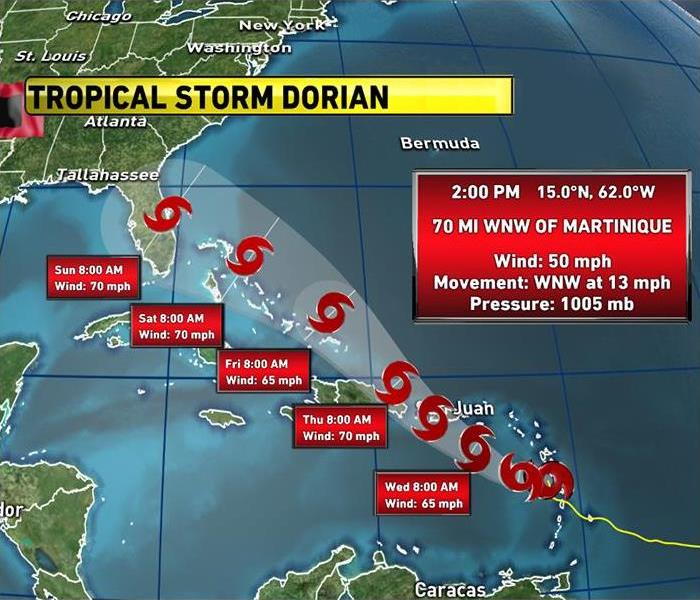Archived Blog Posts
Commercial Fire Damage in Winter Park, FL
6/13/2022 (Permalink)
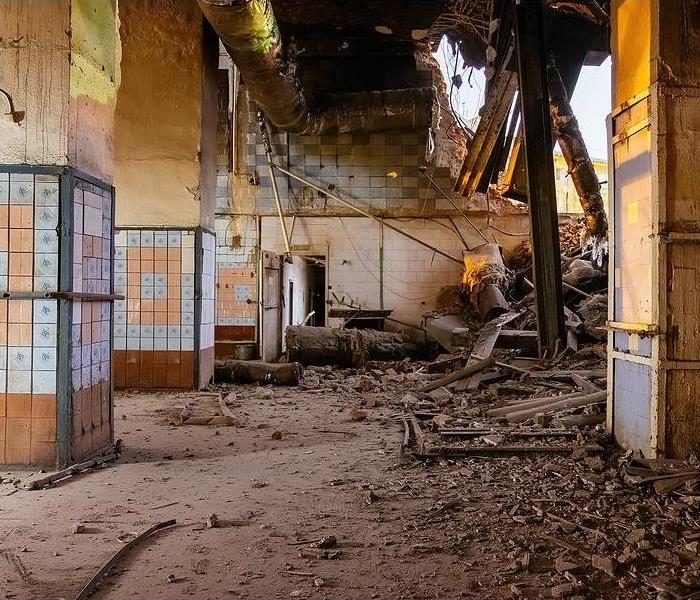 Here you can see the destruction caused by a large commercial fire. With this extent of damage, it is extremely important you hire an expert company.
Here you can see the destruction caused by a large commercial fire. With this extent of damage, it is extremely important you hire an expert company.
Commercial fire damage includes more than just the visible smoke, flames, and water that can be seen in the aftermath of a fire. It can also cover other unseen damages to commercial spaces. These include structural damages and hidden items like fingerprints, blood drops, chemical smears, and paint chips from mishandled materials. The time it takes for a fire to be extinguished and the extent of water damage depend on the type of fire. Here are the steps for fire restoration in Winter Park.
1. Assessment
You should be able to notice the extent of fire damage by examining the surrounding premises. This will help you in identifying what was burnt on an area covered with smoke, flames, and water. The location of the fire might also be noticed by looking at the marks left behind on walls and furnishings.
2. Safety Work
You should do fire damage restoration work so that it won’t cause additional injuries or damage. It is essential to use fire-safe materials while restoring the commercial space, especially those items that can easily catch fire. For instance, you should avoid cardboard. Instead, you should use a material like mineral wool or cellulose, which are fire-resistant. They help prevent fire from spreading around.
3. Water Removal
The removal of excess water can be a challenging task. It depends on the amount of water used to extinguish the fire and how long it took to extinguish it. If possible, let fire restoration services do this for you.
Whether you decide to do this by yourself or have professionals help you, make sure you use safety measures. This includes wearing protective equipment like rubber gloves and goggles. You should avoid the use of heavy machinery and harsh chemicals.
4. Soot and Smoke Removal
Once the fire is under control, you will be faced with getting rid of the soot, smoke, and chemicals used to extinguish the fire. You should do this manually as it is more time-consuming. This is when professional fire restoration services can help. The use of powerful vacuum cleaners and dehumidifiers can help remove these substances from your commercial spaces.
5. Cleanup
Get rid of any materials, furniture, appliances, and stains that might have been exposed in the fire. Use air movers to remove the soot and smoke from walls and skylights. Fill up all cracks and crevices with chemical foam to prevent staining and water damage in the future.
6. Restoration and Repair
After the cleanup, you can start with the restoration and repair process. Contact a fire damage restoration company in Winter Park to help you with this step. This will help restore your commercial spaces to their normal state before the fire.
As you can see, the restoration of commercial space is not just about the present state of the affected areas. It may also require planning and preparation before starting the cleaning and restoration process. It involves assessing your commercial spaces to determine what was damaged by fire, whether in-situ or out-of-place materials. In some cases, fire damage could be very severe, causing serious structural damage to buildings. In this case, you might require recovery services from SERVPRO in Winter Park, FL.
Water Damage Cleanup & Safety Tips
6/13/2022 (Permalink)
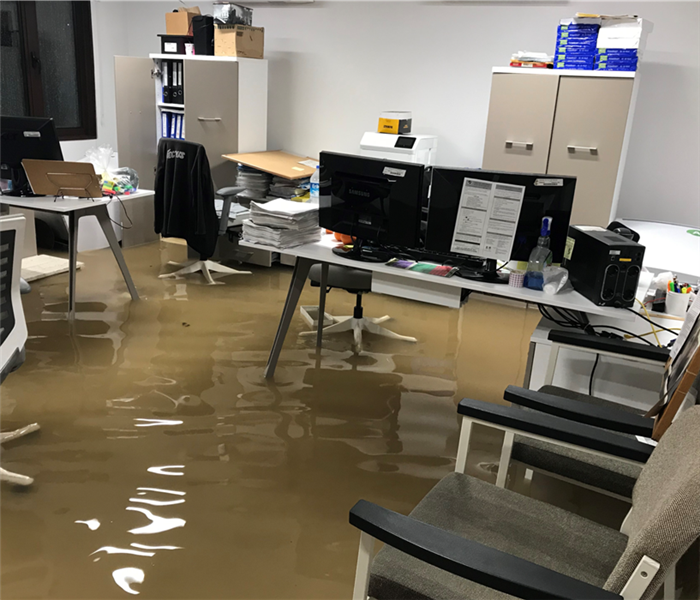 Standing water is a perfect breeding ground for bacteria and mold. Extracting this water and drying in a timely manner is essential for prevention.
Standing water is a perfect breeding ground for bacteria and mold. Extracting this water and drying in a timely manner is essential for prevention.
If a house has had a flood, ensure you confirm its safety before entering it. Check for structural damage and electrical hazards while using protective wear such as respirators, and gloves. After these, you can follow the following safety tips:
Act Fast
The seriousness of water damage rises fast as the water stays stagnant, and your house and its contents are soaked in water. Therefore, be quick on time. Molds grow in a short time, within 48 hours. To ensure you contain the flood damages, contact professionals like the SERVPRO of Winter Park to help remove and dry out the water before the molds begin to grow.
Ensure There Is Enough Circulation Of Air In The Affected Areas To Avoid Mold From Growing
Mold thrives in organic materials like particleboard or paper and moisture. To reduce or stop the damage, you can open windows and place fans in the rooms to allow air circulation and maintain average temperatures. When cleaning, work as you go towards the fan to reduce cross-contamination.
Check The Damage Water Has Made To Your Equipment
Assess the water type that has flooded your houses, such as contaminated river water, rainwater, sewage-filled with bacteria, or water from broken pipes. You can salvage your items in many ways. However, the decision to save the items will depend on the sentimental and dollar value of the item to the owner. Things like mattresses, pillows, pads, carpets, box springs, and dry walls may not be worth saving.
At the same time, things like leather couches, heirlooms, and Persian rugs may be worth saving. Wet household fabrics and clothing can be salvaged easily using a washing machine and soaking in hot water and detergent for approximately ten minutes. This will assist remove stains and contamination.
Uncover Pockets Of Saturation
Pockets of saturation, both concealed and hidden ones, must be exposed to be cleaned and dried. Building materials can hold layers of water between them that you will need to discover and dry.
Carry Out A Thorough Cleaning
Clean non-porous and semi-porous materials like hardwood flooring, vinyl products, studs, and joists with regular cleaning products. When cleaning, protect the areas not affected by the flood or mold. When you finish your thorough cleaning of the items you were able to save, apply a disinfectant solution in case they were in contact with harmful bacteria. The harmful bacteria may be from river water debris, stagnant water, or sewage.
Ensure Your House Is Dry Before Reconstruction
To avoid structural damage and dry root, it is essential not to reconstruct or cover with wood the wet areas. Therefore, ensure the site has adequately low moisture content. With the help of professionals, they can help you confirm if the house has sufficiently dried before reconstructing.
How to Eliminate Smoke Smell in Your Orlando Home
6/13/2022 (Permalink)
 Eliminating a smoke smell can be challenging because the smell is usually embedded in your furniture, walls, and other things that survived the fire.
Eliminating a smoke smell can be challenging because the smell is usually embedded in your furniture, walls, and other things that survived the fire.
A fire disaster in a home has immediate and long-lasting effects. Some immediate ones include loss of property or injuries to the people in the house. After cleaning, however, you will deal with the smoke smell for a longer time.
Eliminating the smell can be challenging because the smell is usually embedded in your furniture, walls, and other things that survived the fire. Some of the tips you can use to eliminate the smell include:
Air it out
This is the first and most crucial step when eliminating smoke in your Orlando home. Open all windows and doors, then turn on your fans to full blast. This will encourage fresh airflow into your home.
It would help if you also used positive pressure, which reduces the air pressure inside the house, encouraging more fresh air from outside to flow in. to use this method:
- Open your front door and place a fan outside facing the house
- Close all other doors and windows except one that acts as a ventilator
- Turn your fan on to full blast, let it run for 15 minutes, then close the open door and window
- Do this for every room until you can’t notice the difference between outside and inside air
Clean the home
Clean your walls, furniture, decks, windows, and other surfaces of your home with mild soap or other cleaning solutions. Ensure you also wash inside the closets, cabinets, and drawers.
Some of the things you can use to clean include:
- Baking soda- This is a natural odor-absorber that you should sprinkle on your carpet, floors, and furniture and use a brush to work it in the fabric. Leave it for a few hours or overnight, then vacuum it out. Do this as many times as you feel necessary.
- Vinegar- This is also a natural odor neutralizer you should use to wipe your washable walls, furniture, floors, and other surfaces. You can also have a jar of vinegar in the room and add some lavender if you don't like the smell of vinegar.
- Activated charcoal- Place a bowl of powdered activated charcoal in the house for a few days to help absorb the smell.
- Febreeze- This is an odor-reducing agent you can find in many shops. Spray a good amount of Febreeze around the room and leave it for a few days.
You should also clean all your clothes, bedding, curtains, and drapes. Add your regular cleaning detergent and a little vinegar to help eliminate the smell. Finally, have your HVAC unit and ducts cleaned to remove smoke residue and soot.
Call the professionals
While cleaning and airing your Orlando home will help remove the smell, sometimes you can't eliminate it completely, especially if the fire was extensive. For the best results, contact professionals who have different commercial cleaning products to thoroughly clean all surfaces and eliminate even the small traces of smoke.
When looking for an Orlando company, consider their experience, skills, credentials, customer service, plus reviews and ratings.
Conclusion
Eliminating the smell of smoke from your Orlando home after a fire disaster is challenging and traumatizing. You can try eliminating the odor by airing your home and cleaning the surfaces, but the best shot is to call the professionals. Calling the professionals will also save you money, time, and effort in the long run.
Water Damage in Vacant Buildings
5/31/2022 (Permalink)
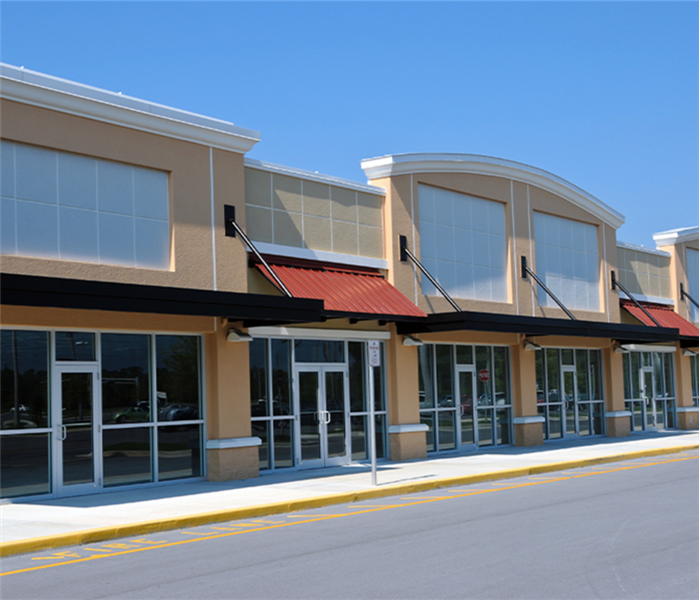 The worst thing about water damage in vacant buildings is that no one is around to notice the problem immediately after it occurs.
The worst thing about water damage in vacant buildings is that no one is around to notice the problem immediately after it occurs.
The worst thing about water damage in vacant buildings is that no one is around to notice the problem immediately after it occurs. The damage can start as a minor leak and later affect property worth hundreds or thousands of dollars. The water will then cause molds on the walls and floors, damaging the property further. If you have an unoccupied commercial property, you shouldn’t lock it up and stay for months without checking on it. Consider routine checks and maintenance to minimize or prevent property damage.
Causes of Water Damage in Vacant Commercial Property
1. Broken or Damaged Windows
Water damage in most commercial buildings happens because of windows with damaged seals. They allow moisture to get into the building and cause more problems such as warped wood and mold development. Property owners should reseal all windows regularly since the join-up can break down after some time.
2. Leaking Pipes
Several reasons can cause pipes breakages, such as damage to the water supply and drainage system, increase in pressure, and cold weather. Some of the signs of damaged pipes include having loose or cracking tiles, watermarks on the floors and walls, walls that have puffed out, and a stuffy smell. Since it may be difficult to detect leaking pipes, you should hire a specialist who will use a piece of special equipment to confirm the leakage.
3. Clogged Gutters
If you don’t clean gutters regularly, they may become clogged and cause water leakage into the building through the foundation or roof. One sign that can show the possibility of leakage in the foundation is wet frames and water puddles. Unfunctional drainage systems may also cause water damage to the foundation of your commercial property.
4. Leaking Roofs
A leaking roof can cause mold build-up, ceiling damage, and shortened electrical wires, which may cause fire, among others. Heavy rains and snowing and incorrect removal of ice are some causes of roof damage.
5. Problems with the HVAC System
After using the HVAC system for some time, its ducts become damaged due to wearing out and causing leakage. Hence, you should clean your HVAC system regularly and remove all the water left on the reservoirs to prevent damage.
6. Clogging in the Sewer System
Contact a water damage restoration expert to rectify the system if you notice sewer damage signs such as a trickling sound. That is because sewer water consists of bacteria that cause infections and illnesses.
7. Leaks in the Sprinkler System
The other cause of water damage in commercial properties is sprinkler system leakages. You can tell your sprinkler system is leaking by noticing wetness on surfaces, mold, and standing water. Ensure to inspect your sprinkler system regularly to check for leaks and moisture and repair whenever necessary.
Water damage in commercial buildings is a problem that property owners should address immediately to avoid further problems. The above are the main causes of water damage that you should be keen to check periodically. However, you can prevent water damage by having a flood monitoring system, ensuring your property is against flood damage, and conducting regular inspections and maintenance on your property.
How Hurricane Recovery Could Be Impacted by Lumber and Labor
5/31/2022 (Permalink)
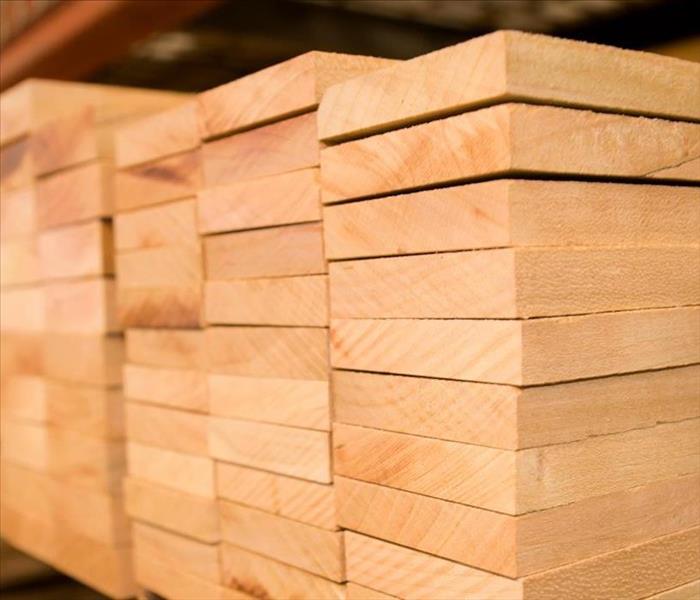 The cost of shipping lumber over long distances is difficult because of limited access to transport systems after a hurricane
The cost of shipping lumber over long distances is difficult because of limited access to transport systems after a hurricane
Hurricane recovery presents numerous challenges for the lumber and labor industry. Historically, lumber has been a vital component in many disaster areas as it is long-lasting and can be easily repaired when damaged. The industry has made significant efforts to ensure that wood materials are readily available in hurricane-affected areas during post-storm cleanup and reconstruction. In many cases, the cost of shipping these materials over long distances is difficult because of limited access to railroads or other transport systems after an event such as a hurricane.
How Hurricane Recovery Could Be Impacted by Lumber and Labor
1. High Prices for Materials Due to Outreach
Hurricane Michael was one of the costliest and most destructive hurricanes ever hit the United States. The most significant impact was along the Florida panhandle, which experienced high winds and torrential rains. Some estimates place the damage as high as $25 billion. This storm strengthened significantly before landfall, resulting in widespread devastation throughout a large geographic area.
2. Shortage of Lumber in Post-Storm Cleanup
During post-storm cleanup, lumber is used to repair damaged structures, and access is limited because many roads are impassable due to debris, fallen power lines, and flooding. Lumber is also used to construct temporary housing, set up shelters, and provide other necessities such as furniture and countertops. This limited supply of lumber must contend with high demand while being transported to help rebuild structures after a hurricane.
3. High Prices for Labor
Labor is required to rebuild structures, clear debris, and debris piles, repair infrastructure, and restore essential services such as electricity in the aftermath of a storm. Many disabled people need support during this period. Expanding the number of individuals employed in a wide range of age groups will help meet this labor demand.
4. Limited Population to Meet Demands
Many people affected by a hurricane are elderly or disabled, which means they cannot be relied upon to rebuild their homes and lives. Temporary housing is a temporary solution, which leads to the need for additional resources as the disaster area continues to rebuild services such as electricity.
5. Limited Availability of Labor Resources
Labor resources are usually located throughout the nation in professional debris removal and building trade companies. Unfortunately, many of these companies were destroyed in the hurricane and subsequent flooding. These companies may experience shortages of trained labor because many workers are now unable to work due to an inability to support themselves paycheck-to-paycheck due to demolished businesses or other factors affecting personal finances during the response period.
6. Logistics and Transportation
Trains and pipelines and roads and bridges may also be damaged after a hurricane. These road, rail, and water systems provide significant access to goods in disaster areas, resulting in the need for resources usually used to transport these goods. In extreme cases, transportation usually is delayed for several days before one can make repairs and goods can be transported.
Hurricane recovery is a critical period during which the lumber and labor industries play a significant role. Due to the economic impacts of past hurricanes, most consumers are willing to pay higher prices for materials and services to rebuild structures as soon as possible.
Reconstruction: Getting Back to Business
5/31/2022 (Permalink)
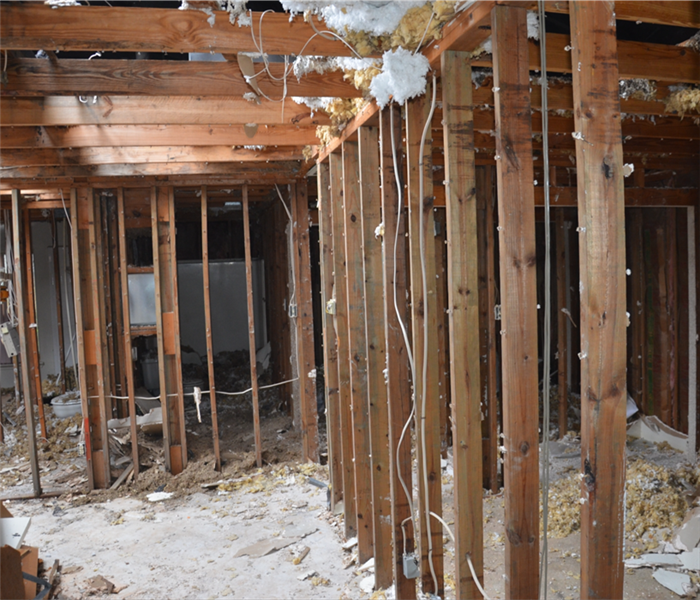 The SERVPRO team can offer assistance with rebuilding and re-equipping your facility.
The SERVPRO team can offer assistance with rebuilding and re-equipping your facility.
Many people believe that it is impossible to restore a business after fire, water, or mold damage. Rest assured that with the help of SERVPRO of Winter Park, you can have peace of mind knowing that they will restore your business to its original condition. SERVPRO is a nationally recognized leader in the restoration industry, helping customers as they return to normalcy. They are dedicated to helping you recover from the unexpected and return your business to normalcy as quickly as possible. Their team of industry professionals can handle any situation with speed and care while helping you minimize your losses.
7 Ways in which SERVPRO of Winter Park can Get a Business Back in Shape with Reconstruction Services
1. Inspect for Water Damage
SERVPRO can inspect your business for extensive water damage by putting a technician in a fish tank to protect them from mold and other airborne contaminants. The technicians will then assess the damage and implement a plan of action that suits your specific situation.
2. Remove Water and Other Contaminants
The SERVPRO team can remove standing water to help prevent further damage to your business or home with generators, pumps, and fans. They can also remove other harmful contaminants such as mildew, mold, and chemicals.
3. Repair Damaged Materials
SERVPRO can quickly and efficiently restore your business with efficient repairs to your facilities, systems, and property. Their technicians have the tools and experience to repair a range of materials, from drywall to electrical panels and appliances. They can also make temporary repairs until you hire a contractor for the proper restoration.
4. Clean and Sanitize
The SERVPRO team can clean your facilities for mold and bacteria, removing harmful germs from your food and other surfaces. It can help to prevent the chances of a reoccurrence of contaminants. SERVPRO can help you with these tasks and remove any items that may have been contaminated, such as any furniture or personal belongings that they may have used during the break-in.
5. Remove Debris
In the aftermath of a water, fire, or mold damage event, SERVPRO can help you with any debris removal. It can help clear your business and make it easier to get back on your feet. The debris may include bookshelves, cabinets, tables, and fixtures now damaged. SERVPRO technicians can safely remove the debris and bring it to a disposal site for proper disposal.
6. Rebuild and Re-equip
The SERVPRO team can offer assistance with rebuilding and re-equipping your facility. They can offer you a range of options, including new flooring, larger electrical panels, brand-new furniture, etc. They can also help you purchase replacement equipment so that your business can quickly bounce back.
7. Future Damage Prevention
The SERVPRO team can also help with future damage prevention by offering you preventative maintenance programs. This service will help protect your facilities, such as air conditioners, water treatment, and other systems that may be important to your business. They can also install security systems to help ensure the safety of both yourself and your business.
As you can see, SERVPRO of Winter Park has many services that they can offer in a water, fire, or mold damage event. In addition to the above services, they can help you with regular preventative maintenance programs that can help better protect your business. With their expertise and dedication to outstanding customer service, SERVPRO of Winter Park is the company you want to hire for your restoration needs.
Flood Danger: Types of Floods
5/31/2022 (Permalink)
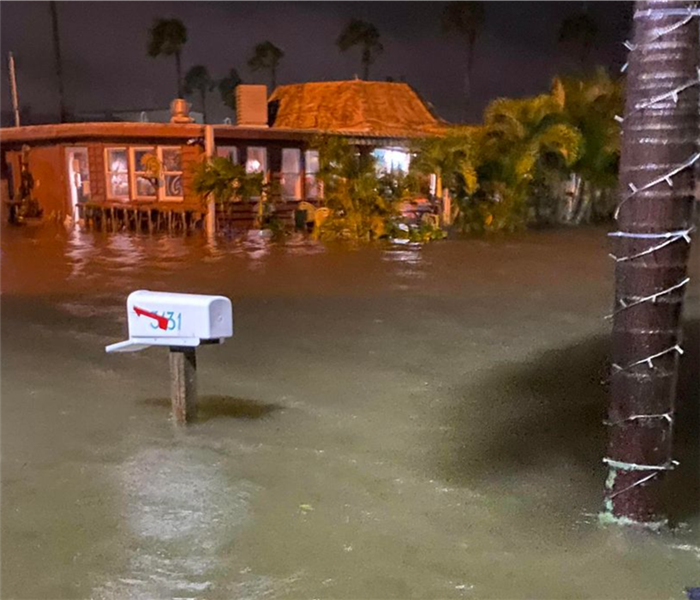 Floods continue to affect many people worldwide due to increasing populations and the destruction of wetlands and other natural barriers.
Floods continue to affect many people worldwide due to increasing populations and the destruction of wetlands and other natural barriers.
Flooding occurs when rainwater cannot drain quickly enough, causing floods to form on land and at sea. Floods continue to affect many people worldwide due to increasing populations and the destruction of wetlands and other natural barriers. Heavy rains are often the cause of flooding, but they may also be caused by other factors, such as melting snow.
5 Main Types Of Floods
1. Flashfloods
Most commonly known as 'whiplash' floods, sudden downpours of heavy rain cause flash floods. They usually occur in low-lying areas like river valleys and floodplains. Flash floods can be unpredictable - one moment, the ground is dry, and you can walk across; the next, a torrent of water rushes through, causing severe damage and drowning people who have been sight-seeing on foot. Flash floods can also be caused by heavy rainfall around or after rainfall has stopped.
2. Landslides
Landslides usually occur when the ground becomes saturated following heavy rainfall. When the rain ceases, the ground is left unsupported and begins to slide downhill. Landslides may occur on slope sides or in valleys but can also be triggered by ground-level heavy rainfall. Landslides are usually associated with rock, clay, and soil types that become slippery when wet.
3. Seepage
It is caused when surface water containing dissolved materials seeps into underground aquifers through cracks or fault lines. The water can then form into a saturated aquifer and start seeping up through the ground, through cracks and fissures in rock or faults. The ground can become unstable and cause landslides, floods, and earthquakes.
4. Tsunami
Tsunamis occur when a large volume of water piled in the sea causes a giant wave to break out over a wide area, generally around coastal areas. Tsunamis can travel at 600 km 373 miles an hour, destroying everything in their paths, including people, houses, and ships.
5. Storm surge
When a storm front passes over the sea from the ocean, it creates a wave that moves parallel to the coastline. If this is combined with high winds and waves already present in the seawater, the result can be storm tides known as storm surges. When they reach the coast, they cause widespread flooding on land around a country's coastline. In the UK, for example, storm surges can be caused by the extratropical cyclone created when warm air meets cold air over the sea.
A flood hazard map can show areas of risk and associated threat levels. The level of flooding varies from one flood to another in line with such factors as duration, intensity, frequency, and catchment area. Flooding in rivers occurs due to rainfall not being absorbed or held back by natural barriers such as wetlands and dams. When rainfall exceeds the capacity of natural barriers, water backs up. It can flood valley floors called flash floods or overflow into surrounding areas, often referred to as riverine flooding. A combination of flooding causes problems during extreme weather events. Landslides occur when saturated soil is loosened by rain or melting snow, and debris flows can follow heavy rainfall. Flood water then rushes down steep slopes in torrents causing rivers to burst their banks and inundate surrounding land.
What are Puff Back Fires and How Can They Happen?
5/31/2022 (Permalink)
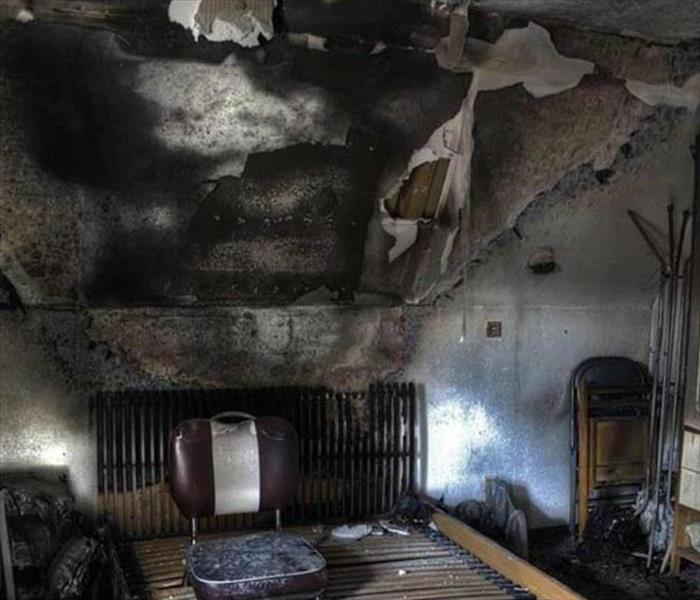 Puff back fires happen when your oil burner is running and the product of combustion, natural gas, is released into the air.
Puff back fires happen when your oil burner is running and the product of combustion, natural gas, is released into the air.
Puff back fires happen when your oil burner is running and the product of combustion, natural gas, is released into the air. It can occur when a burner's hot exhaust pipe comes into contact with combustible materials like dry leaves or even just water vapor that already exists in the air. The fire burns through these materials, releasing more heat and gases into the atmosphere and causing a massive explosion that disrupts your heating system.
Causes of a Puff Back Fires
There are several causes of puff backfires. The following are some of them:
Burner is clogged
The most common cause is a clogged burner. It's imperative to check your burners regularly, more than once a month, especially when it's cold outside. If your burner has formed a clog and you don't remove it, your system will not run as efficiently, and the chances of puff backfire increase.
Improper combustion
Another common cause of puff backfires is improper combustion. It occurs when there's not enough air or too much air is being fed into your burner. You must keep the burning process in a particular state to prevent the fire from overly combusting, which can cause a puff to backfire.
Chimney is clogged
There are many ways for a chimney to become clogged, but one of the most common is when too much ash builds up in the bottom. It is caused by an inefficient combustion process in your burner, which results in excessive ash being left over.
Low oxygen levels
Another cause of puff backfires is having too low oxygen levels in your air supply. When oxygen levels are too low, your combustion process cannot burn properly, and a puff will occur. Most boilers or furnaces have a mechanism that detects low oxygen levels and will shut off the device to prevent a fire, but you must check the levels yourself.
Gas leaks
Gas is not very compressible, and when it leaks into the air, it causes an increase in pressure which results in a puff backfire. It is most likely caused by the leak coming from your gas pipe. It could be the result of poor installation or poor maintenance.
Safety Measures
Proper installation and maintenance
You have to have a burner that is properly installed and maintained to avoid puff backfires. The best way to do this is to have a professional install your system because they are better trained. It will also reduce the chances that you have a gas leak or a clogged burner.
Reduce combustible materials
You should decrease the amount of combustible materials around your home. It would help keep your yard neat and tidy to avoid getting a puff to backfire from dry leaves and dead branches.
Proper ventilation
Another preventive measure is to have proper ventilation when using your fireplace or heating system. You should keep the windows open if you are in a room with an operating fireplace. It's also a good idea to keep an exhaust fan on while your system is running.
Use of safety shut-offs
You can also have a safety shut-off installed on your system. It will shut down the oil burner in case of low oxygen levels or a clogged chimney.
Puff back fires are very dangerous and can cause a lot of damage to your home. They are also preventable if you take the proper precautions. There are several reasonable safety measures that you can take, but it's best to have a professional come in and inspect your system if you have any doubts.
Winter Heating Safety in Florida
5/20/2022 (Permalink)
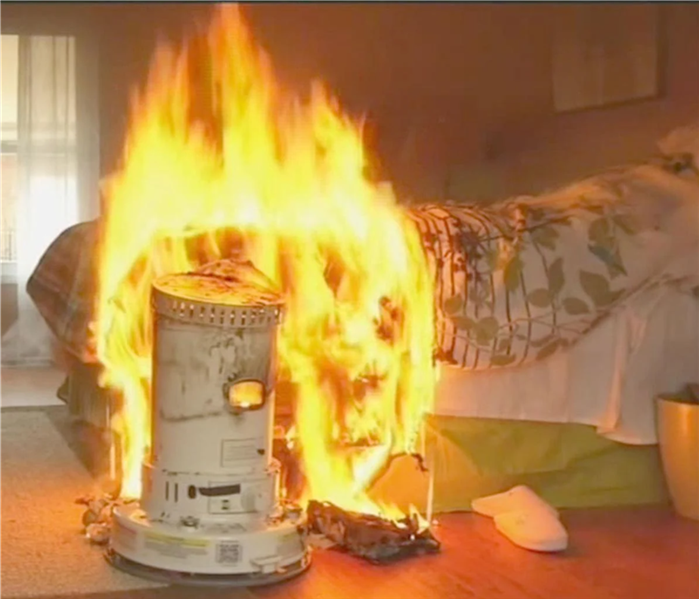 A space heater needs to be three feet away from everything else. It can burn up anything that is close to it.
A space heater needs to be three feet away from everything else. It can burn up anything that is close to it.
Staying Safe with Different Heating Systems
Although we are a ways off from being worried about staying warm here in Florida, we also believe in informing our readers ahead of time so they can be best prepared. That brings us to this post about home heating systems. There are several winter heating systems that can keep your home warm during the winter. However, safety is the most important thing that you have to keep in mind. You need to do the following in order to ensure that you safely heat your home.
Space Heater
People love space heaters because they are efficient and do not take up a lot of space. You will instantly feel the heat when you turn it on. However, there are a number of hazards that are associated with using a space heater.
You need to put your space heater in the right place. The space heater needs to be three feet away from everything else. It can burn up anything that is close to it. Keep in mind that some space heaters have temperatures that can exceed 100 degrees Fahrenheit.
You should not put a space heater on carpet. You should also avoid putting it somewhere that has heavy traffic. A space heater can easily start a fire if it is knocked over.
Open Ovens
Ovens are great for baking good food. Many people also use their ovens to warm their home. However, it is a bad idea for you to keep your oven if you plan on leaving the house. An oven cannot efficiently heat your entire home. It can only heat the surrounding area.
If you have children or pets, then leaving an oven open can cause them to get injured. Additionally, there is a possibility that your oven can cause carbon monoxide poisoning. That is why it is important for you to maintain your oven.
Carbon Monoxide Poisoning
According to the CDC, 50,000 people die each year due to carbon monoxide poisoning. Carbon monoxide poisoning is most likely to occur during the winter because of carbon monoxide poisoning. You can greatly reduce your chances of suffering carbon monoxide poisoning by getting your heating system maintained.
Not only can a professional maintain your heating system, but they can also tell the temperature that is best for you to set the thermostat on. Furthermore, a professional can clear the vents. This will allow your heating system to work efficiently and safely.
Fireplace Fires
A fireplace is one of the best things that you can do to keep your home warm. It also makes your home feel cozy. However, fireplaces are a major fire hazard. You have to make sure that your fireplace does not have any residual coals or ashes.
You should clean out your fireplace every time that you use it. Put the ashes and coal in a container that is at least 10 feet away from your home. Before you use your fireplace, you should put up a screen. This will prevent the ashes from coming out of the fireplace.
You should also clean and maintain your chimney. A chimney sweep can greatly reduce the chances of a fire.
Candles
Candles are something that many people use all year long. People like using them during the winter because they create an ambiance. Fires are not the only hazards that are associated with using candles. If your candles are made out of toxic products, then you can inhale those chemicals.
It is best for you to use beeswax candles. These are natural and clean candles. They can also help clean the air by neutralizing the negative ions.
You can minimize the chances of a candle fire by keeping them away from blankets, paper and bedding. You should also avoid putting them in a place where they can easily be knocked over. Furthermore, it is important to change the HVAC filter on a regular basis. Burning candles frequently can clog up your filter.
Water Damage Categories in Your Orlando Office
5/20/2022 (Permalink)
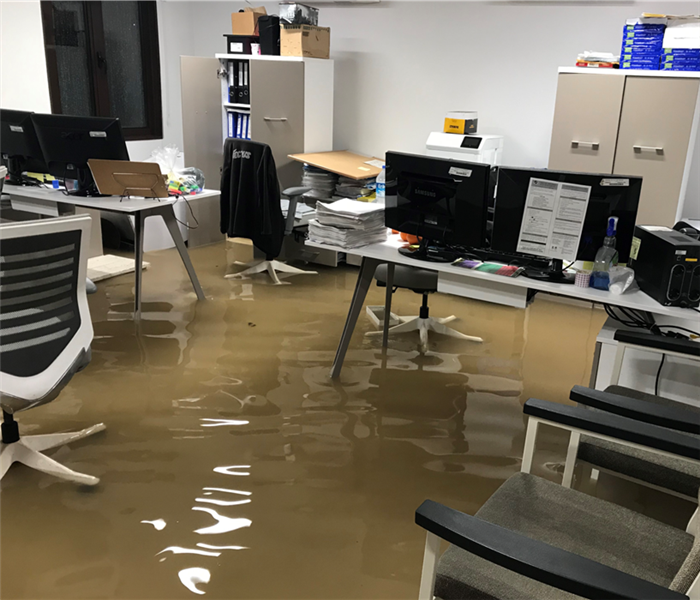 Blackwater describes sewage water, rising floodwater, seawater, and river and groundwater.
Blackwater describes sewage water, rising floodwater, seawater, and river and groundwater.
Water-Damage in Office Spaces
Water damage refers to the possibility of harming surfaces that are continually in touch with water. Clean water, greywater, and black water are the three types of water damage. Water damage is a significant threat that affects both homes and businesses, although it is a prevalent problem. To address this issue, company owners have formed repair firms that will assist you in cleaning up the mess before it becomes irreparable. This article seeks to provide information about water damage in office spaces, outlining probable causes and damages that occur and preventative suggestions and procedures to take in the case of a water-damage scenario.
When we talk about water damage in office spaces, it might seem impossible as these are spaces where people don’t typically encounter a lot of water use. However, this damage may occur in many ways, such as rain and flooding seeping into your office through leaks or cracks in the plumbing fixtures, pipes, foundation, and other malfunctioning appliances. Water damage in Orlando is common because most materials used in construction homes and commercial houses are absorbent.
When materials such as wood, insulation, floors, and drywall absorb water, it spreads through them, causing damage. In addition, the absorption of water by these materials causes them to swell, warp and discolor the materials causing weaknesses to the point that the absorption threatens the structural integrity of the building.
Once you have understood how water damage occurs in office spaces, the question that arises is what are the damages to expect? By understanding the three types of water damage, you can quickly identify the kind affecting your office space.
Clean Water Damage
In this category, professionals consider it the least severe of the three. Clean water damage includes damages such as broken pipes and water supply lines, overflowed sinks and bathtubs, and other water appliance issues. This type may be considered less severe since it is sewage and toxin-free, but it might start a more serious hazard.
Greywater Damage
The second water damage category involves water from appliances such as toilets, dishwashers, laundry machines, and sump pump backups. Consumption or any other form of contact with greywater may or may not cause harm to a human being. However, it is crucial to get rid of all affected items, and if any of them is reusable, they should be disinfected thoroughly.
Blackwater Damage
Blackwater damage is extreme and requires swift action to avoid potential health effects. Blackwater describes sewage water, rising floodwater, seawater, and river and groundwater. When this damage occurs, a series of water damage management must be observed, from removing the affected items to disinfecting the office area.
Water Damage Restoration in Office Spaces in Orlando
5/20/2022 (Permalink)
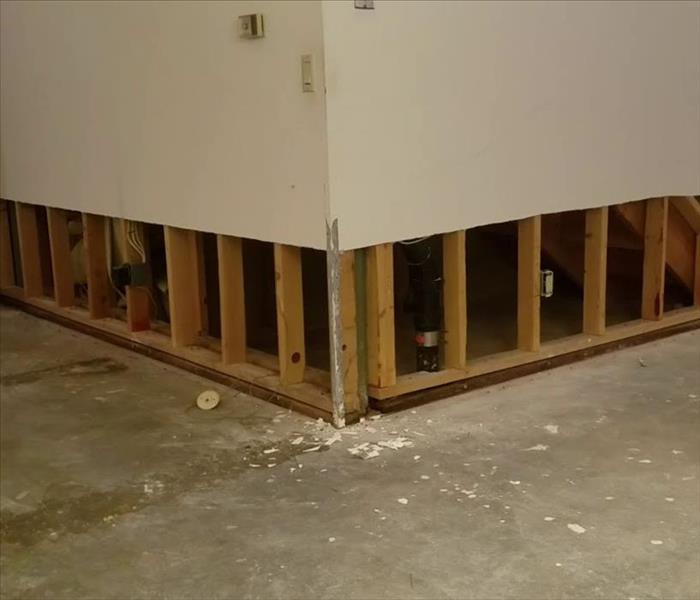 After a water damage event, many components may be discarded. Restoration is the process where these materials are replaced and repaired.
After a water damage event, many components may be discarded. Restoration is the process where these materials are replaced and repaired.
You would think that water-damage restoration and water-damage mitigation are the same things, but they are not. Water damage restoration is the process of repairing your workplace after it has been flooded, whereas water-damage mitigation is the process of preventing more damage. Water-damage restorations may restore your office's appearance from a shambles to its original state. Because water damage is a delicate process, it should be handled by trained specialists familiar with restoring a messed-up home to a livable, pre-damaged state.
While it's normal to be frightened when your house is flooded or inundated by another source of water, it's also important to realize that you must act quickly. The longer you wait, the greater the damage will become—and the amount of time it will take to clean up the water will grow. After reviewing the causes of water damage and their categories, it's also important to consider ways to prevent water damage in office environments.
Water-damage prevention should be considered as early as the foundation of a building or while designing the structure. Investing time is the most effective technique for minimizing costly water damage. On the other hand, regular inspections can aid in the prevention of leakage-related issues. Inspect various aspects of a corporate structure at different periods. One method for preventing office water damage is to set up a flood-monitoring system. Regardless of where your office building is located, having a flood warning system in place might be crucial in predicting floods. Internal plumbing failures, overflowing rivers, and melting snow are all possible flood sources.
2022 Hurricane Season Predictions
5/19/2022 (Permalink)
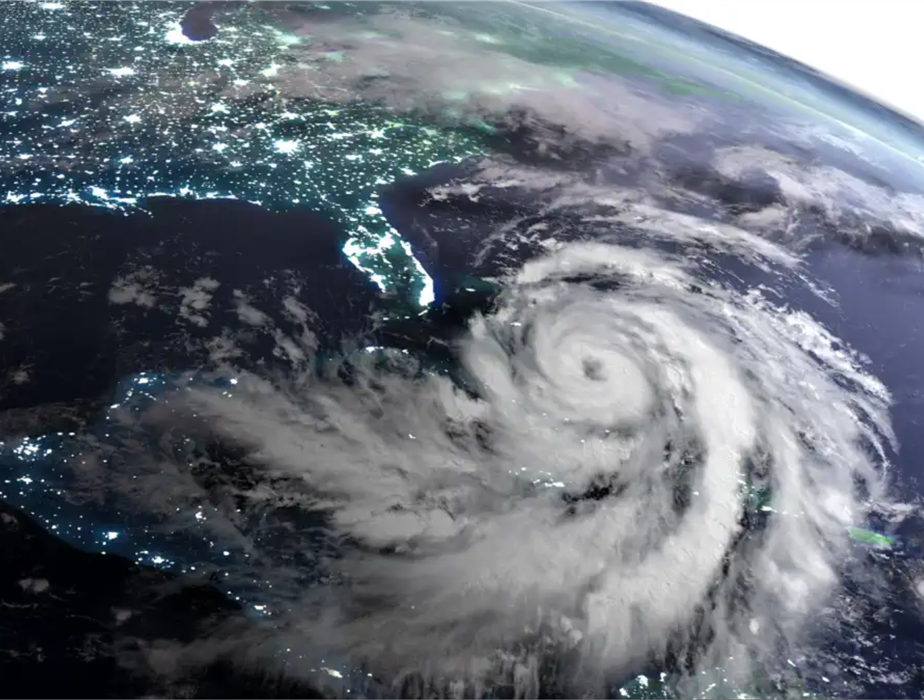 A major storm has not made landfall in Florida since 2018, however, experts predict a busier season this year.
A major storm has not made landfall in Florida since 2018, however, experts predict a busier season this year.
A hurricane is a severe tropical cyclone that forms over warm oceans. They're called hurricanes when included in the Atlantic and Eastern Pacific. In the Central and Western Pacific, they’re called typhoons. They’re known as cyclones in the Indian Ocean.
Hurricanes cause damage and destroy buildings by way of flooding and strong winds. These storms make them very difficult to predict and forecast, which causes problems for officials trying to prevent or prepare for hurricanes.
Forecasting difficulty
The difficulty of hurricanes comes from the fact that they form exceptionally quickly and can travel in very different ways. That’s why they sometimes cause mass destruction so suddenly.
Hurricanes are not predictable, especially regarding the size and speed with which they move. They do have a pattern of where they form in the ocean, but it is still not predictable. For example, you don’t know how far away pieces of the storm might be when it forms. If they’re far away, then they might help strengthen the storm.
The speed at which hurricanes travel is also unpredictable. They can move quickly over the water or come to a complete standstill. They usually speed up and travel faster than 80 miles (129 kilometers) per hour when headed to Florida.
Latest 2022 hurricane predictions in Florida
1. NOAA’s forecasts for the 2022 Atlantic hurricane season
NOAA (National Oceanic and Atmospheric Administration) has issued its outlook for the 2022 Atlantic hurricane season, predicting an above-normal storm season.
The anticipated increase in tropical cyclone activity is due to weak La Niña conditions observed over the equatorial eastern Pacific Ocean and favorable atmospheric conditions in the tropical Atlantic.
The Atlantic hurricane season is expected to have an above-normal number of named storms, with a 60% chance that there will be between 8 and 13 named storms (with winds reaching 39 mph or higher).
2. AccuWeather’s latest forecast for the 2022 hurricane season.
Accuweather has issued its outlook for the 2022 tropical cyclone season, predicting it to be an active one.
AccuWeather’s outlook for the season also indicates a 60% chance of between 8 and 13 named storms with winds reaching 39 mph or higher.
The seasonal outlook indicates a 30% chance that the season will have more named storms than expected, a 15% chance of having an equal number of named storms, and a 12% chance of having fewer named storms than usual.
3. The Florida Scientist’s forecast for the 2022 hurricane season.
The Florida Scientist has issued its outlook for the 2022 Atlantic hurricane season.
Theologist forecasters expect a below-average to near-normal 2018 Atlantic hurricane season, with a 50% chance that it will be above average and a 50% chance it will be similar to 2017. The outlook indicates an 80% chance that the season will have fewer named storms than usual and a 20% chance of having more named storms than average.
4. The Weather Company’s latest forecast for the 2022 hurricane season.
This season will be below average to near average in terms of the number of named storms and above average in the number of hurricanes.
Classic El Niño, or warm water conditions in the equatorial Pacific Ocean, were expected to affect atmospheric conditions over the western tropical Atlantic during the fall of 2018 into 2019, which could lead to an above-normal season this year.
According to the outlook, a 70% chance (range 50-90%) of 9 to 15 named storms, of which 4 to 8 are expected to become hurricanes (range 2-6), including 1-4 major hurricanes (category 3, 4 or 5; winds 111 miles per hour or more significant) this season. There was a 40% chance (range 30-50%) of an equal number of named storms and hurricanes.
Seasonal predictions
There are many different ways that experts predict the amount and strength of hurricanes this year. The most serious ones have indicated a declining trend in the number of storms every year. Hurricane season runs from June 1 through November 30.
There’s also an ongoing forecast for where these hurricanes will form in September, October and November. This is based on the predictions for El Niño, which is typically active during the summer months. The forecasts say fewer hurricanes will be formed in the Pacific Ocean this year.
Forecasters also use an official storm track to predict where these storms may form. This is based on weather patterns and ocean temperatures across the globe. It’s not something that can always be used since it is unpredictable, but they can predict where hurricanes will form and how they could affect Florida with this information.
Safety measures
There is something called hurricane shelters used for people to go to when a hurricane is coming. They are all underground so that the people who go there can safely ride out of the storm. This is where most of Florida’s population goes during hurricane season. The Federal Emergency Management Agency (FEMA) has a map online which shows precisely where these shelters are located within the state.
Sometimes, the National Guard will help clear storm debris and ensure that everyone in the area is safe. They are also the only entity in Florida that has the right to enforce a statewide curfew. They can do this when they have enough people available to implement it, and they will use it to make sure that everyone in Florida, including children, is safe.
Emergency water supplies are needed during hurricane season, so people should discuss what they need with their local authorities as soon as possible. This includes drinking, cooking, and cleaning supplies once a disaster occurs.
Many hospitals use generators during hurricane season to remain fully operational even when the power goes out. This is especially true in emergencies when they are needed to operate on many patients due to storm injuries.
During hurricane season, specific equipment is required for having electricity and communicating with the outside world. If a hurricane knocks out the power in Florida during hurricane season, everyone needs several days’ worth of batteries and flashlights in an emergency.
During Hurricane season, you should plan for emergencies that may occur and make sure that you have medical supplies on hand in case of an emergency during hurricane season.
Restoring a Hotel In Time for the Busy Holiday Season
5/19/2022 (Permalink)
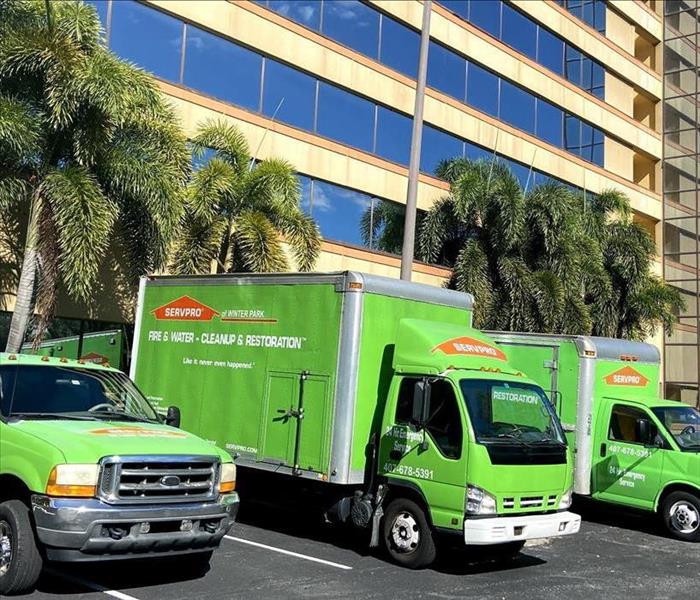 With lots of hard work and dedication, SERVPRO of Winter Park was able to bring this hotel back to operating standards just in time for the holiday se
With lots of hard work and dedication, SERVPRO of Winter Park was able to bring this hotel back to operating standards just in time for the holiday se
A Hotel Holiday Disaster
Hotels are always a busy place of business, especially around the holidays. Friends, family members, and many others come from all over to visit their loved ones during the holiday season. This is an important season for the hospitality industry. A majority of people that are traveling will need a place to stay and it is crucial that these housing facilities are properly maintained and prepared for the influx of people. Back in November of 2020, during the week of Thanksgiving, a pipe broke in the ceiling of a beautiful hotel. Water rushed everywhere and caused lots of damage to the facility and put many rooms out of commission. This quickly became a major problem as Thanksgiving was right around the corner and the hotel had a significantly smaller number of rooms that would be available to accommodate the customers. They needed to do something, and quickly. An unexpected disaster like this can always come with lots of stress, especially for a business owner.
The General Manager Made a Great Decision
The general manager decided to call SERVPRO of Winter Park, and he sure did make the right decision. The crew came out at 11 o’clock at night and got right to work. They cleaned up the debris that was caused by wet ceiling tiles collapsing. The crew also had lots of heavy equipment that was able to extract water that had been deeply soaked up by the carpet. They were able to clean up all the rooms that were affected by the water. Once everything was cleaned and the water was extracted, SERVPRO of Winter Park set up lots of drying equipment to dry out and restore the parts of the structure that had been damaged by the leak. They came back each day to monitor the drying process and remove any building materials that were not drying properly to ensure there would be no secondary damage in the facility.
What Happened After the Cleanup?
Once the whole process was completed in about 3 and a half days, SERVPRO of Winter Park’s reconstruction team reached out and got the hotel back to how it looked prior to the pipe breaking. With lots of hard work and dedication, SERVPRO of Winter Park was able to bring this hotel back to operating standards just in time for the holiday season again. The staff were delighted and overjoyed that the crew was able to get them back up and running in a short amount of time when originally they thought all hope was lost. They certainly made an unfortunate situation better and came in time of need. Words from the general manager were, “I was very pleased with the speed and execution, along with the courteous team who did an outstanding job to remediate the damage and restore my hotel back to normal.” SERVPRO of Winter Park definitely strived to do what they always do, and that is to make it, “Like it never even happened.”
Commercial Disaster Response: Water Shut Off
5/16/2022 (Permalink)
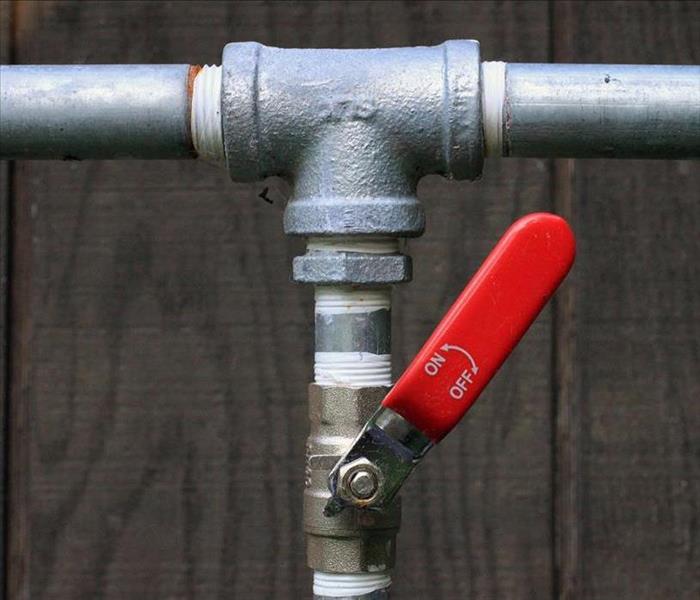 Water shut-off valves can prevent damage to your property by stopping the water supply immediately.
Water shut-off valves can prevent damage to your property by stopping the water supply immediately.
Most people in the United States are used to the conveniences of running water in their homes and places of work. It has become a mainstay of modern life and one of the many reasons we live healthier lives. That is, until disaster strikes. Commercial disaster response includes water shut-off services. Water loss can mean many things, including a disastrous event for your business if you don’t take the necessary steps to minimize the damage.
What is Water Shut Off?
Water Shut Off is an emergency service often offered by plumbers in your area during times of disaster. They will come to your business as soon as possible, usually within a few hours, and turn your water back on. It is important because many companies, especially restaurants, rely upon running water to stay in business. If you don’t have running water, you could suffer significant losses.
How Does Water Shut Off work?
The process of water shutting off is simple. A plumber provides you with the necessary tools and takes measurements of your system. Once these are done, they leave to make their initial call. The plumber will contact the utility companies and tell them that you have a water leak. If this happens at night, it can be challenging for your employees, so we recommend contacting your plumbers early in the morning to minimize disruption to your employees’ schedules.
Why Your Main Water Shut-Off Valve Is So Important
Many people are unaware that they have a main shut-off valve in their office or commercial space. It is usually located in the basement, on the water line itself. It is easy to identify and usually has a red handle marked with “Do not turn off” written on it. This valve can prevent damage to your property by stopping the water supply immediately.
This valve also serves as a way for you to stop the water for another reason. If you have a house built with an older sewer line, it may not have been updated yet. If this is the case, you may need to use the main shut-off valve on your house to prevent the sewer from backing up. It can be hazardous because it can flood areas of your property and cause severe damage. It is best to contact a plumber to help you determine if this is the problem.
How to Prevent Water Shut Off
The best way to handle water shut-off is always prevention. Make sure you have a plumber come by and check your system when you make changes in your building or just for annual maintenance. If disaster strikes, it will make things easier for everyone, and you naturally want the plumber working with the utility company on the problem. You can look online by searching "water shut off team near me" or "find a plumber" in your area, so they are ready to get started as soon as possible.
Water Shut Off is an essential service designed to prevent unnecessary damage to your business. If you don’t take these steps, you could be putting your property and your employees at risk.
Contact a Commercial Disaster Response to help you prevent water damage and help minimize any financial loss associated with it.
Commercial Disaster Response: Roof Leaks
5/16/2022 (Permalink)
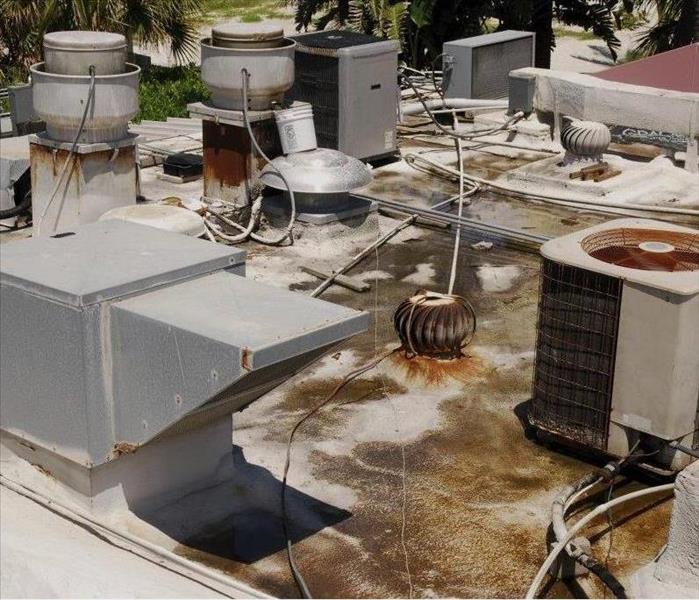 Some types of roofing are more durable than others, and some types of weather may cause the material to deteriorate more quickly than others.
Some types of roofing are more durable than others, and some types of weather may cause the material to deteriorate more quickly than others.
If you've ever been unfortunate enough to have a roof leak, you know how frustrating it can be. A roof leak can cause storm-related damage and damage to the property, but it also causes major issues with water buildup. Of course, if your roof is leaking due to an issue like heavy rain or ice accumulation, then your commercial buildings will likely collect this excess water in the form of puddles on the ground below. However, when you have a roof leak, the water will spill over the roof's edge and begin to pool beneath your commercial buildings. Usually, this means that there is too much water pressure within the structure, causing damage.
Here are some common causes of roof leaks that can lead to catastrophic water damage in your commercial buildings:
1. Leaky Gutters
Gutters are an important part of any roof system. They are designed to direct rainwater off the roof and into a gutter system. It is very common for gutters in commercial buildings to become damaged because of heavy rain. Due to heavy rain, a layer of leaves builds up on top of the gutter, and eventually, this accumulates into large clumps. To have your gutters properly cleaned out, it is best to have them inspected either by an experienced roofer or a professional roof cleaner. This will allow the gutters to be cleaned and maintained regularly not to accumulate debris that can damage them.
2. Unvented Chimneys
Several forces can damage a chimney, but even with regular cleaning and maintenance, a chimney can eventually fail. It is very common for chimney caps to develop cracks or holes due to corrosion. This can lead to water pooling inside the structure, which leads to leaks and damages caused by water. Once a chimney is damaged, the structure will need to be replaced.
3. Decaying Roofing
There are different types of roofing material for different weather conditions. Some types of roofing are more durable than others, and some types of weather may cause the material to deteriorate more quickly than others. Regardless of which type of roofing you have, it is very common to develop small cracks or leaks in the form of downed shingles or rotted areas in your building's roof. If you look at the condition of your roof during heavy rain or after the rain has stopped, you may notice that the shingles are bent and torn, or some areas appear to be older than other areas of your roof. This usually means that roofing is leaking and is causing damage to your commercial building.
4. Corroded Pipes
Pipes are very important to every structure to have running water and drainage. However, pipes can develop leaks over time due to corrosion and neglect by the property owner. One of the biggest leaks within a pipe system is from corroded faucets in sinks or showers. When pipes are corroded, they may become damaged and begin leaking contaminants through them.
Preventative Measures
There are a few ways to prevent roof leaks, but some of them may not be possible depending on the location and structure of your building. Here are preventive measures which can be taken to prevent leaking:
1. Installation of ridge vent
Roof vents are necessary to allow hot air to escape your roof during the summer season, but they can also cause issues with roof leaks. Water accumulation in the attic can cause shingles to develop cracks and leak. The water will likely pool on top of the ridge with a ridge vent instead of leaking into your building's structure.
2. Inspect your roofs regularly
If there are areas in which you notice developing leaks on your roof, schedule an appointment with your roofing contractor to have them fix these areas. A professional roofer will be able to inspect the roof and make recommendations on how to keep it from leaking again.
3. Adding a second layer of shingles
If a roof is old and has developed leaking issues, you may want to consider adding another layer of shingles to repair the roof. The first layer of shingles may have already developed some holes, causing water to leak into the roof. By adding another layer of shingles, you will increase the strength of your roof and make it less likely for water to get inside.
Conclusion
While the conditions of your roof are important, there are many ways to prevent roof leaks and water damage. If you live in an area that is prone to heavy rainfall or snowfall, you may need to inspect your commercial buildings regularly to make sure that your property is safe. An experienced professional can help you evaluate the condition of your commercial buildings and make recommendations on how best to repair or replace any damaged areas.
Smoke and Soot Restoration Process Guide
5/4/2022 (Permalink)
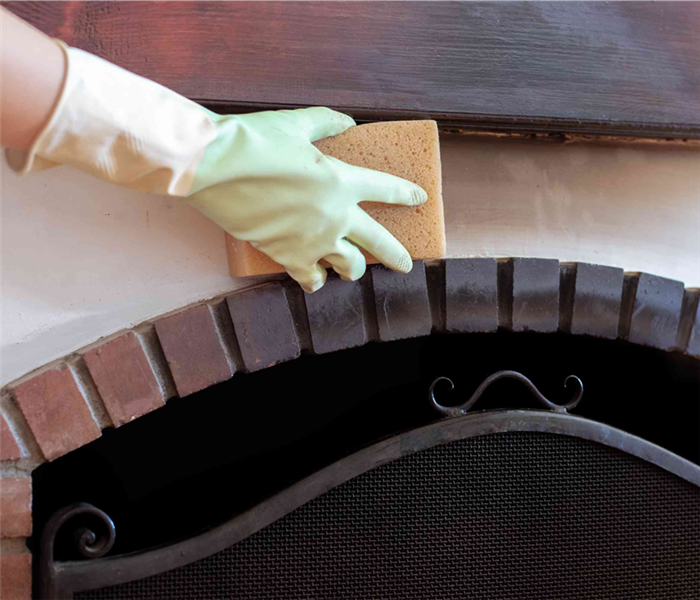 Restoration experts use dry sponges to scoop up sticky soot particles from the walls and ceilings.
Restoration experts use dry sponges to scoop up sticky soot particles from the walls and ceilings.
Fire breakouts can be tough on homeowners both emotionally and economically. The devastation after a fire outbreak can be difficult to handle, especially if there's salvageable property. The choking smoke odor and the thick layer of soot make restoration a challenging affair even for seasoned cleanup experts.
If you find yourself in this unfortunate situation, your best bet is to call a licensed fire damage cleanup company. A poor restoration process can create more residential or commercial property problems. Soot and smoke residues can further property deterioration and lower its overall salvage value. It weakens structural components and destroys electrical appliances such as HVACs. Engaging a professional fire cleanup company is the best way to ease stress and reduce further property damage.
Steps before the restoration process
A homeowner can do a few things before the cleanup team arrives at their premises.
Step 1: once the fire has died down and the premises is safe for entry, the homeowner should inspect all rooms to identify salvageable items.
Step 2: Sort out personal belongings and separate ruined items for easy disposal.
Step 3: Move the salvageable items to a safe location as you wait for the professional cleanup team's arrival.
Once the soot removal team arrives, they'll have an easier time inspecting the property for the extent of soot and smoke damage. Smoke and soot restoration
Soot and smoke restoration is a delicate exercise that's best left to experienced fire damage cleanup teams knowledgeable in handling fire disasters. These teams will carefully inspect each room to determine the extent of fire damage and what's salvageable. Some items may be damaged beyond repair and not worth the trouble of restoration. Restoration professionals can also help homeowners make accurate assessments when filing insurance claims.
Dealing with smoke damage
Even a few minutes of smoke exposure can leave large portions of your property clouded with soot. Prolonged smoke exposure can lead to permanent wall staining that is hard to reverse. Furthermore, the corrosive smoke particles can penetrate permeable structural components and weaken them.
• The smoke removal team begins the cleanup by inspecting smoke damage on ceilings, walls, and flooring.
• The team then opens all doors and windows to improve air circulation, which helps eliminate smoke odors.
• Dry cleaning may be necessary to remove smoke particles stuck on windows, ceilings, and wall surfaces.
• Next is a wet cleanup using professional cleaning products. Alternatively, you can use Vinegar, baking soda, and hot water solutions to neutralize the smoke odor.
• The restoration experts then apply a degreasing solution and scrape off stubborn smoke residues using soft-bristled brushes.
• The last step entails rinsing the surfaces with warm water.
Handling soot damage
Soot can be a major respiratory hazard, especially if some family members have preexisting respiratory complications. Poor vacuuming techniques can cause the soot to spread to unaffected surfaces.
• The cleanup team uses specialized vacuuming equipment and protective gear to soak up soot residues on the flooring.
• The restoration experts use dry sponges to scoop up sticky soot particles from the walls and ceilings. The professionals clean the soot using special overlapping techniques to prevent soot streaking.
• After the dry-sponge cleaning, the team applies a degreasing solution to eliminate soot particles from glass surfaces.
• The cleanup concludes with a baking soda and vinegar solution wipe down to neutralize residual odor.
Electronics damage
Soot and smoke particles pose a significant risk to electrical appliances. It's advisable to move quickly when dealing with soot residues if you have expensive electronics on your premises. Many electrical components contain hazardous materials that release toxins when exposed to heat or corrosive smoke particles.
When soot particles settle on electrical appliances, they reduce heat conductivity, raising the risk of overheating and a potential secondary fire breakout. It's essential to leave electrical soot cleanup to professionals to limit further component damage.
Coverwood restoration
Wood finishes tend to absorb smoke particles at a higher rate than many other materials. Coverwood restoration begins with an inspection to determine the best approach for tackling soot residues. Sometimes, applying a sealant is all that's required to neutralize smoke odor and restore the furniture.
In some cases, the restoration team may opt for sanding and refurnishing to remove the soot-coated outer layer. Wood sanding is particularly effective in restoring wooden surfaces to their original state.
Furniture & carpet cleaning
Fabric finishes are notorious for absorbing and retaining odor. While many DIY carpet cleaning options exist, sometimes it's best to go the professional route. With carpets, deep cleaning with a degreasing solution eliminates most of the odor. However, if the fire damage is too extensive or the items are low-value, you are better off replacing them than incurring the cost of salvaging the items.
Why you should hire fire damage experts
SERVPRO of Winter Park is an experienced restoration company specializing in property restoration after damaging fire outbreaks. Our cleanup teams employ sophisticated restoration techniques to lessen the emotional and financial loss of fire damage. Our professional cleanup unit uses specialized restoration equipment to get the job done swiftly and efficiently.
Below are the benefits of working with a certified fire salvage company:
• Specialized soot and smoke odor removal techniques
• Mold control using certified products
• Extensive reconstruction abilities
• Reliability in processing insurance claims
Free Commercial Inspection, What’s the Catch?
5/2/2022 (Permalink)
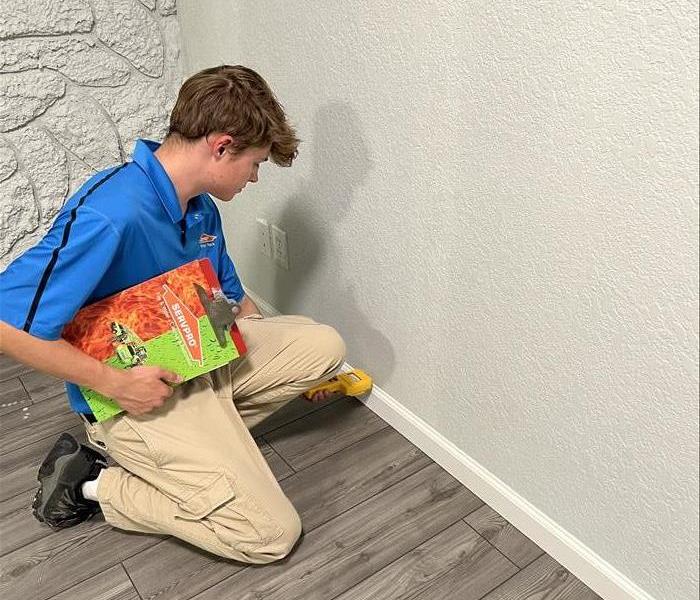 SERVPRO technician performing a moisture reading with a penetrating meter during a commercial inspection
SERVPRO technician performing a moisture reading with a penetrating meter during a commercial inspection
Do You Think You Have a Water or Mold Issue?
A property inspection by SERVPRO of Winter Park is a comprehensive check on commercial and residential properties to look for signs of water, fire, and mold damage or potential issues that may lead to these damages. It typically takes about 90 minutes to complete but the duration may vary based on the size of the facility. The inspection can either offer peace of mind that damage was not found or help to get the process started by preventing additional damage. The restoration specialist conducting your property inspection will be experienced in water, mold, and fire damage and will share their knowledge as well as outline the process for you should you need additional assistance with existing damages.
By this point, you may be thinking this all sounds great but there is always a catch, isn’t there?
So What’s the Catch?
Our franchise is fully transparent with our service charges and we can honestly say there is no catch!
As a restoration business, a free inspection helps us to prospect potential work when we find damages that would otherwise go unnoticed until they worsened. It is our foot in the door for new clients and job sites. We also place immense value on building trust with commercial property managers and becoming their preferred vendors based on the work we’ve done for them. If we inspect a commercial property and don’t find damages or the property owner is reluctant to address the issues found, the inspection remains free of charge. We make no money and the property owner is left knowing the damages and conditions of their building or facility.
If our inspector finds damages and the property owner enlists our help as a restoration business to address and remedy the situation, we then charge for the actual work that is done. Even in these cases, the majority of our bills get covered by insurance and we work with adjusters directly to ensure a smooth process.
What Happens During a SERVPRO Inspection?
A SERVPRO representative will walk through your property, sifting through the structure to pinpoint existing damages or issues that may eventually lead to damages.
As part of the inspection, your restoration specialist will look for:
- High moisture readings in drywall, baseboard, and cabinets. etc.
- Signs of discoloration, high humidity, building material deterioration, etc
- Floor defects like buckling, musky odors, ceiling wet spots
Reasons To Book a Free Commercial Inspection Today
- Simple and safe building procedure.
- It can potentially save you money in the long run. The free building inspection will allow you to fix any problems before they become worse and more expensive to repair, making sure that it is safe for use.
- It can help you towards making your commercial property safer for those working in it.
- You acquire an estimate for free that helps you know the amount you'll be spending so you can budget for it.
Prior Damages
Buildings and facilities may portray evidence of past damages from water or mold, especially if the property is aging. The evidence of these damages is sometimes subtle and requires a trained eye to detect. These damages may include but are not limited to the following;
- High moisture in structural areas
- Cracks and holes in walls
- Broken plumbing and leaking system
- Missing or broken windows and doors
- Rusty nails and screws
- Missing or damaged insulation
- Broken windows and door glasses
- Electrical and HVAC systems damage
- Bathroom, kitchen, and kitchen cabinets are leaking even after repair
- Water stains on ceiling, walls, or floors
How to Get Started
Ultimately, you have nothing to lose and everything to gain when it comes to requesting a free commercial building inspection from SERVPRO of Winter Park. If you are unsure or suspect you may have water, fire, or mold damage, give our office a call today at (407) 678-5391 and get your building or facility on our schedule!
When Do Homeowners Need A Restoration Company
11/26/2021 (Permalink)
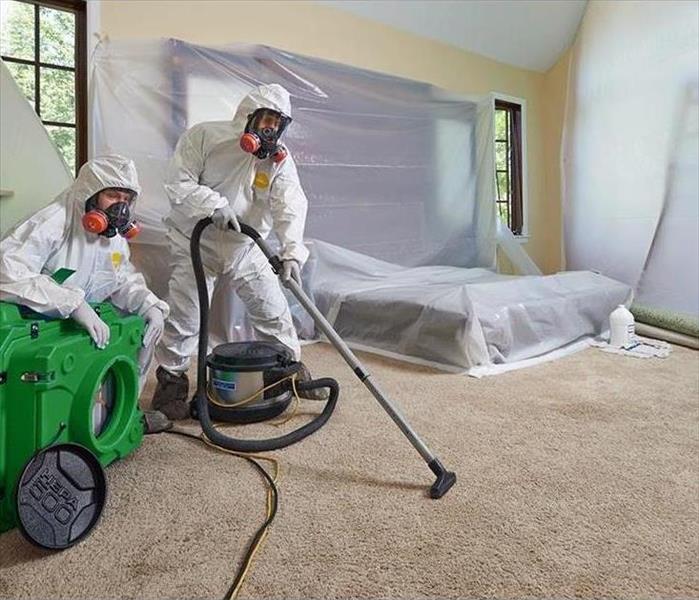 SERVPRO offers various services and has the experience to get the job done right with top-of-the-line equipment.
SERVPRO offers various services and has the experience to get the job done right with top-of-the-line equipment.
Regardless of how clean you keep your home and how much work you do to make your property its absolute best, there are some jobs where professionals need to get called in to perform. Not to discount the result of a handyman, but when there is specific damage to a home, homeowners need to call a restoration company. Please continue reading to discover what restoration companies do and some instances when homeowners need to call them in.
What Is A Restoration Company
As the name implies, these company's restore homes and buildings and some furnishings to the pre-damage state. Their emergency team will likely be the first to respond when disaster strikes, and there has been damage. They have specialized equipment, and in addition to cleaning up the mess, their job is also to prevent further damage to your property.
Before going into reasons a homeowner would need to hire a company to restore the insides of their home, homeowners want to ask a list of questions before signing a service contract. Be sure you are satisfied with their answers before hiring them.
Do your technicians have certifications?
Are your technicians available at all times 24/7?- Is your company insured?
- Will you work with our insurance company?
- Is your company licensed and bonded?
- How much restoration experience do you have?
- Do you guarantee your work and that there won't be further damage?
When Do Homeowners Need A Restoration Company
Fire Damage
It doesn't take long for a fire to spread and damage the insides of your home. There is damage from the fire and smoke, but there is likely water damage from putting the flames out. Hiring a restoration company for the fire damage to your home has several benefits. In addition to the soot and smoke odor removal, a company will sanitize, clean the property, deodorize, and restore whatever items they can.
Water Damage
Water is so serene yet can be so destructive when it comes to your property. Regardless of whether water was accidentally left on inside your home, a leak from the roof, a pipe burst, or there is natural disaster flooding from a storm, the damage from water can be severe if not treated rapidly. When left to intrude into crevices of a home, water can cause damage such as:
- Mold and bacteria grow in the home.
- Rusting of steel in the home.
- Swelling of composite woods in the home.
- De-laminating materials like plywood in the home.
- Destroy the electrical system in the home.
Many of the issues from water damage can cause health or safety hazards for the home occupants if not treated immediately. Therefore, calling in a restoration company for water damage is essential.
The company you hired for water damage will assess the outside of your property, checking for structural damage and if the house slops. They will look at the exterior door frames and windows, checking for any separation.
They will then move to the inside of your home, looking for watermarks, stains, and soft sagging within the walls. The company you hire will also look for warped tile, discoloration around the pipes, and of course, they will be sniffing for mold.
Mold Remediation
Small amounts of mold are found almost everywhere. Mold can cause health effects.
Mold can enter the home through the air, the ventilation system, open windows, and doorways. It comes as a spore but only needs oxygen, warmth, moisture, and darkness to grow.
Homeowners who hire professionals for mold remediation can expect them to test for mold, remove, demolition, sanitizing, containment, and eliminate the mold.
Sewage backup
Sewage backups are awful and create a mess as foul as it sounds. They happen when there is an obstruction of some damage that prevents the wastewater produced in your home from draining away from your house. The backup can create destruction to your property that needs a professional to respond to. In addition to fixing the sewage line, you'll have to have your home examined by a home service to determine the extent of the services you need.
Other Services
In addition to calling a professional restoration service into your home for the damages listed above, they also restore damage caused by wind and storm damage, vandalism cleaning, biohazard cleanup, crime scene cleaning, and more.
Conclusion
As you have read above, there are times when homeowners may need to call in the help of professionals when there is damage to their home. They will assess your home on the inside and out and determine what actions to take to restore your property in addition to some of your furnishings.
Hidden Roof Damage After Florida Storms
11/19/2021 (Permalink)
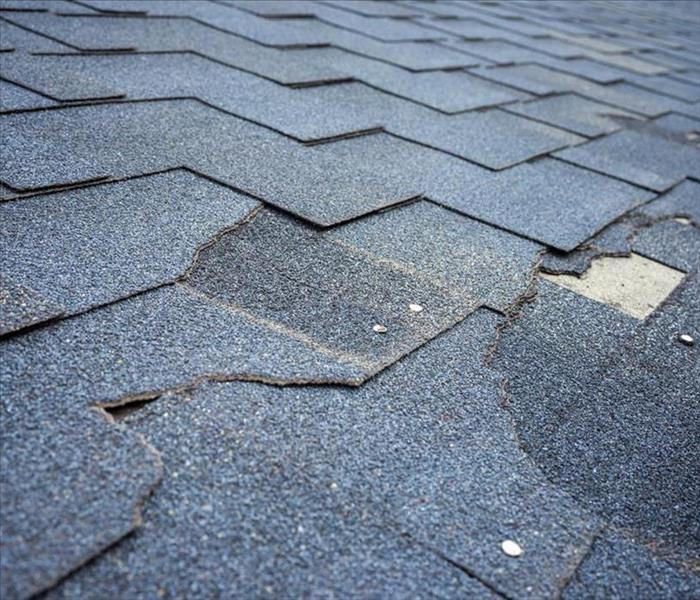 Roofing repair can be a complex task that involves expensive tools and repair methods.
Roofing repair can be a complex task that involves expensive tools and repair methods.
The Sunshine State is world-famous for having one of the best developed living environments and weather. However, it's also prone to various extreme weather issues, which can eventually have its toll on items such as your home.
Unfortunately, a portion of the damage that occurs to your property is sometimes difficult to detect. You have to be concise in your search for any hidden property damage to ensure the best results. However, there is more to searching for progressive storm damage on your property than you would expect.
The Potential for Hidden Roof Damage After Storms
Weather damage is highly likely in Florida. Instead of using a reactive approach when your property falls victim to such weather, use a proactive approach. Part of this approach is in being aware of the potential of storm damage and creating a suitable response plan for the same.
Florida might be one of the most serene states in the country, but extreme weather issues are sometimes rampant in the city. While snow blizzards are not likely to occur, the Sunshine State still experiences various other forms of poor weather.
Common occurrences include watersports, heavy rain showers, tornadoes, hurricanes, and more. The Sunshine state tends to experience humid and subtropical climates, making it the perfect environment for such weather conditions.
Modern weather planning and forecasting have made it easy to prepare for such events in the future. However, this is still not sufficient to ensure that your property is safe from hidden roof damage. You have to consider various other alternatives in your approach to preparing for storm damage.
The common alternatives you have to consider include insurance coverage and help from a reputable roofing repair service. You need a reputable service because roofing repair can be a complex task that involves expensive tools and repair methods. With a reputable service, you are sure of accessing such expertise at reasonable prices.
How Storm Insurance Works
Looking back on damage from hurricanes such as Michael or Andrew, Florida has experienced some of the most extreme weather in history. Each year, the possibility of an unusual weather event is a reality for all Florida residents. Since most high-quality roof repair procedures are costly, you need suitable insurance to cover your risk management needs.
As a responsible property owner, you must safeguard your property from such forms of extreme weather. Below are some helpful tips on things you need to know about storm insurance in Florida:
What is Storm Insurance?
Storm insurance can lead to two main types of damage, which can occur due to water or wind. You need to invest in the right storm insurance or a suitable policy that you can use to safeguard the welfare of your property.
Instead, consider a unique combination of insurance services that will cover any form of damage your property will face. Part of this insurance coverage will include roof damage after storms.
Your storm insurance might also include the specific details you had identified with your insurance agency. It's part of the process involved in creating custom coverage plans for properties based on their market value.
How Much Does Storm Insurance Cost?
It's not easy to determine the specific amount you require to safeguard your property against storm damage. The reasons why it's difficult to do so can include:
- Storm coverage often includes several insurance policies, each with a different pricing level.
- Prices can shift among different service providers.
- Some parts of Florida are more prone to storms than others.
- The value of a property has an impact on insurance coverage costs.
While there is no specific metric on the average cost of storm insurance in Florida, we can use other similar estimations to get a perspective. A good example would be that flood insurance averages at $700 and hurricane damage would be $2500.
Property and homeowners are also under the obligation to make up for specific insurance fees. The fees come from recommendations through the National Weather Services and include damage. The insurance coverage goes by the name Hurricane and Windstorm Deductibles.
The fee applies to up to 17 states in the city and specifically covers property damage from windstorms and hurricanes. Since storms are the leading cause of hurricanes, you may find this insurance type helpful.
Even if you have insurance coverage, you might also need the help of a lawyer in processing your claim. Doing this ensures you are safe from contract coverage and can receive all the compensation for the roof damage.
A good lawyer can help you to avoid malicious agencies that often give the following excuses:
- Delaying with your property damage compensation claims.
- Creating insufficient offers that don't address all the damage to your property.
- Inclining, you sign new agreements with unusual or adjustment claims.
- Claiming that hidden room damage is not part of your insurance coverage.
Using a Restoration Service for Damage
You will need a restoration service if your property has hidden roof damage. Below are some of the reasons why you need a restoration service:
Access to Trained Professionals
The first benefit of working with SERVPRO of Winter Park is gaining access to highly trained and experienced professionals. The company handpicks these professionals based on certain factors such as experience level, job qualifications, and personal values.
Doing this helps us ensure that we can assign your property to people who can give you valuable solutions. Our team can also provide customized property solutions for your unique roofing needs. We also ensure our professionals stay updated on modern roofing products that can be suitable for your property.
Satisfaction Guarantees
We provide several satisfaction guarantees for our clients because we know the importance of having a good roof over your property. These satisfaction guarantees come from the several hours we have worked to provide suitable solutions to consumers.
We even have access to information on the best insurance coverage offers that you should consider. Our team will help you choose high-quality and affordable coverage premiums that you can use. The satisfaction guarantees also include warranties for any damage that occurs due to our products or services.
While it's unlikely that you will dispute, we want you to be aware of the extent of our roofing service guarantees. So, our roofing repair procedures are only complete when you are pleased with the final result.
For Safety
Fixing a roof is no ordinary DIY task. You have to be thorough and safe in your approach to ensure the best results. That is why we have an extensive team of professionals available to help restore the property's value for safety purposes.
We have all the right resources to access the most remote parts of your roof remotely. Without a solid roof on your property, occupants are also prone to various problems such as poor weather and even wild animals.
Safety is one of the main reasons SERVPRO of Winter Park recommends you never work on hidden roof repair damage DIY. You need someone who can identify such damage in your property and orchestrate a suitable repair plan.
Access to Quality Roofing Solutions
Our team has worked on roofing solutions for many years. We have the right experience to tell you what works best for your property. Our in-field team is regularly interacting with these roofing products and defining customer needs.
Each solution we provide comes from hundreds of hours of in-field experience and consultation with industry experts. Aside from fixing your property, our team will also give you helpful advice on managing roofing damage issues in the future.
We can advise you on risk management, damage identification, DIY suggestions, and insight into cutting-edge roofing solutions. We also give free quotations to determine the scope of our services and prepare for the roofing repair project.
As you have seen, there is more to fixing and preparing for hidden room damage issues than you would expect. You need the help of a professional service provider and a reputable insurance agency. Using this approach will help provide the best roof damage repair benefits for your needs.
Florida Roofing Insurance Claims
11/19/2021 (Permalink)
 Fixing a roof or replacing one altogether is typically a large and expensive undertaking. Understanding how Florida roofing insurance works can help.
Fixing a roof or replacing one altogether is typically a large and expensive undertaking. Understanding how Florida roofing insurance works can help.
Insurance claims are often a contentious time, but there are ways to make the process easier. If you need to file an insurance claim for your roofing, here's what you can do to prepare. If you're filing an insurance claim for your Florida home or business, you must know how the process is going to work. Knowing what you can expect from your insurance company before they get there, or even while they're on the scene, will make sure that everything goes according to plan and no one gets surprised along the way.
In most cases, roofers will need to file a homeowner claim if their roof has been damaged by a storm. If the roof is beyond the scope of your homeowner’s policy, then it will need to be filed as a commercial claim. Florida has specific laws regarding insurance claims that vary from state to state, so this article will focus on general guidelines. Florida law requires property insurance companies to follow these guidelines:
1. Emergency Services
If you need to call a roofing contractor because of damages caused by a natural disaster or accident, have them on-site as soon as possible. Your insurer will expect the damage to be assessed and for a contractor to be called immediately and is required by law to reimburse you within 45-60 days. In addition to keeping good records for your insurance claim, you should also take pictures and videos of the damage and send them to your insurer right away.
If you need to make emergency repairs in order not to further damage your home or business, be sure that you get a contractor on-site as soon as possible. The contract must contain a provision authorizing emergency services which is written in plain language without legal jargon, and it should only apply if there was no opportunity to obtain such services from another source. If this condition is met, then the insurer can authorize necessary roofing repairs up to 10% above the policy deductible limit (Florida law requires this amount be paid within 15 days).
2. Documentation of Loss
Insurers will require a list of any damaged items and detailed documentation of the damages they've suffered. This includes estimates for repairs, pictures, or receipts for appliances that have been lost or damaged in the process. All documentation will need to include dates and times where possible. Furthermore, you must keep all invoices and documentation for at least five years after the repairs.
3. Minimal or No Pre-Existing Damage
If your roof has previously been damaged, even if it was repaired, then your insurer may not be required to pay for the new storm damage. This varies depending on the state and whether there was any chance of repair before the next storm struck. If there is damage due to previous storms that were unreported, insurers will only be responsible for current and/or future losses caused by hurricanes or other major natural disasters.
While taking photos of existing damage prior to filing an insurance claim is important, it can also help with determining if recent storms have caused additional damage as well. If you find damage that has been repaired, you'll need copies of the contractor's work order and copies of the payment receipts for your insurance claim.
4. Damage Appraisals
Florida law requires property insurers to provide a valuation of damages within 60 days after an appraisal has been completed by an independent company. If there are any disputes regarding the appraised value, then you can file mediation or arbitration which will be overseen by the state's public adjuster board. You must also receive written notice before filing with this board. When negotiating an insurance claim settlement, it is helpful to have roofers on-site as soon as possible to ensure that expensive repairs aren't being overlooked beneath layers of debris. They may even be able to prevent further damage from being caused by a leaky roof.
5. Disaster Fraud
Florida is one of the states that have been hit hardest by hurricanes in recent years. Hurricane Irma alone led to over three million insurance claims, many of which could end up being fraudulent. While it may be difficult for you to spot disaster fraud within your own insurance claim, there are some signs that indicate possibilities for false documentation or inflated claims:
• Damage seems inconsistent with previous damage from a similar storm
• Payments from multiple insurers were requested before work was even finished after a single event
• Bills show incorrect dates and times where possible
In cases like these, you will need an experienced property insurance lawyer who can carefully review all documentation provided for your claim and help enforce your rights to a fair insurance claim settlement.
6. The Claims Process
Your insurer will file a claim and an adjuster should arrive to inspect your damages soon after your initial call. They will start by assessing the damage, and if they need you to make any repairs or move items before they can do their inspection, they should let you know when you can expect them back.
Moreover, it's a good idea to ask questions as they come up, but waiting until the end of the process is not recommended. Once your insurer has received all necessary documentation and completed their inspection, you will either receive an offer if your damage was less than the policy deductible or be asked for final approval before repairs are made.
In some cases, insurance claims can go on for months or years without ever being resolved by your insurer because of fraudulent claims or incomplete paperwork. If this happens to you, don't hesitate to contact a lawyer who specializes in home insurance claims. Although hiring a lawyer may cost more money upfront, they can help ensure that you don't have to wait any longer than necessary.
7. Miscellaneous Costs
If there is no deductible in your policy, then the insurance company will handle all costs related to your roofing repairs above and beyond what is covered in your policy up to $10,000 without requiring a signed agreement. If there's a deductible in place, the amount paid out to cover miscellaneous expenses may be reduced accordingly.
However, these miscellaneous expenses are not restricted to things like moving services, board-ups, or emergency repairs. They also often include costs associated with rental properties or hotels if you need to be moved somewhere else for an extended period of time during the roofing repair process.
If you do have a deductible in place, then it is your responsibility to cover all of these extra expenses unless they're the result of negligence by the insurance company. Your insurer may make you pay a higher premium next year if they've had to pay out too much money on your behalf because of a poorly documented claim.
8. Communicating with Insurers
Keeping your insurer up to date with any changes in the amount and type of damage done by a storm is critical. Any changes that you need to file before they arrive should be communicated as soon as possible and no later than 2 business days after you've had an inspection.
This communication may include:
• Damage assessments
• Estimates for repairs
• Replacement items; such as appliances or flooring
• Construction plans
9. Your Rights
During the claims process, it's important to know what rights you do and don't have under Florida law.
These rights include:
• The right not to be discriminated against because of your disability or religion
• The right to receive prompt payment when applicable
• The right not to pay a deductible more than once per claim
• The right not to receive less than the actual cash value of damaged goods
Conclusion
Roof insurance claims can get extremely complicated very fast, so if you need help from an insurance attorney to file a claim it's vital that you contact one as soon as possible. Any roofing insurance claim in Florida is subject to the same laws and regulations and should be processed in a timely manner (generally within 45-90 days). It's important not to wait until your claim has been denied before seeking help from an attorney, as this could result in further complications.
A roofing contractor can help prevent further damage from being caused, but you need legal assistance when filing an insurance claim in Florida in order to ensure that the damages documented are covered under your policy and your insurer is not required to pay more than what was originally offered. In conclusion, you should consider hiring a lawyer if your insurer fails to recognize damages caused by the storm.
Hazards to Your Children's Health in the Aftermath of a Flood
11/16/2021 (Permalink)
 Taking steps to clean up properly after a disaster can significantly impact the health of your children
Taking steps to clean up properly after a disaster can significantly impact the health of your children
The immediate potential impacts of flooding, including drowning, landslides, debris, and structural damage, can be dangerous for children and adults alike. You need to be careful when dealing with the aftermath of a flood. Contaminated water and mold growth are two health-related issues that are common after such a disaster.
Proper flood cleanup can limit some of the health issues posed by flooding, especially when it comes to mold. Moisture may remain in drywall or tile grout and allow mold to thrive. Once it takes hold, the mold will continue to grow until it gets removed.
Mold expands its reach by releasing spores, which travel through the air and create new colonies when they land on moist spots. These airborne spores can also cause an allergic reaction.
Being aware of the hidden dangers of flood damage and taking steps to clean up properly after a disaster can significantly impact the health of your children. Here is what you need to know.
Health Risks Associated With Flooding
Floods can lead to water damage, which can cause a mold infestation without proper cleanup.
A post-flood cleaning and disinfecting strategy are essential, but it is only part of the overall effort to keep your children safe in the aftermath of a flood. In addition to avoiding direct dangers from floodwaters, downed power lines, or hazardous debris, parents need to consider contaminated items and water and the increased threat of carbon monoxide poisoning.
Carbon Monoxide
Gas-powered generators are a source of power after a natural disaster. These tools provide necessary electricity, but they also release carbon monoxide. Generators inside or near an enclosed space can cause this dangerous gas to build up.
Carbon monoxide poisoning can cause fatigue, headache, dizziness, confusion, and vomiting. Breathing large amounts of the gas can be fatal.
You can install a carbon monoxide detector in your home to detect this unseen gas. Since carbon monoxide poisoning is possible anytime exhaust is present, this detector is a good safety tool to have in your home at all times.
Furthermore, after a flood, do not operate a portable generator inside. Consumer Reports suggests keeping the motor at least 20 feet away from your home to avoid any possible contamination.
Contaminated Water
Floodwaters can contain pathogens, so it is best to keep children away from standing water until it subsides. Also, a flood might contaminate your water source. This can make it unsafe to use tap water for drinking, washing, or bathing.
According to the EPA, children may experience severe gastrointestinal problems because their immune systems are not fully developed. In addition to immediate health issues, the long-term effects of exposure to contaminants can include developmental and neurological problems. In addition to illnesses caused by microbes like E. coli and Giardia, chemicals in contaminated water can cause health issues.
After a flood, give your children bottled water to drink. Any water you use for bathing or washing anything needs to be boiled or purified with iodine, chlorine, or a filter.
Contaminated Items
Floodwaters may also contaminate household items. Microbes can cling to surfaces on children's toys and kitchen utensils. The illness-causing substances could then transfer to your children when they use these items.
Thoroughly wash everything with soap and water and dry completely in the open air. Using a substance such as chlorine bleach during cleaning can kill bacteria and microbes contained in the floodwaters.
Unfortunately, you will probably need to throw away any wooden items or soft or absorbent toys. Any baby bottles or pacifiers should also be removed from the home because it is impossible to decontaminate these items.
How To Treat Mold in Your Home
After a flood, you need to start the water damage restoration process. This effort involves returning everything in the home to its pre-flood condition and removing any dangerous substances the waters brought into the house.
Mold remediation and removal are vital steps in this process because mold can cause health effects.
Here are some tips on how you can clean up molds from your house after a flood.
- Clean up standing water and remove all wet items from the house. The first step is to stop the buildup of moisture. If necessary, you should call in an expert to handle the job. You can also use equipment such as dehumidifiers to remove moisture from walls.
- Open up your home to fresh air. This step can help the drying process (especially if the outside humidity levels are low), and it may limit dangers from carbon monoxide or other airborne contaminants.
- Clean mold from hard surfaces. You can use natural solutions or detergents to clean mold from hard surfaces. You will need to pay special attention to corners and crevices during this process. Calling in a professional or using chemicals such as chlorine bleach may be necessary to ensure complete removal.
- Remove porous or absorbent materials. Carpeting, wood, and cloth that came into contact with floodwaters will need to be removed because of the danger of mold and contaminants. It is impossible to remove mold from porous surfaces.
- Get a professional inspection to ensure complete removal. Mold can grow in walls and corners and remain unseen for years. If you do not rely on a pro for removal and remediation, you can still enlist the help of an expert to ensure that you did everything correctly to limit the chances of mold growing in the future.
Removing the source of mold is essential, but you can also get a HEPA air filter for your HVAC or filtration system. This can remove most mold spores from the air.
How Data Can Predict Building Fires
11/2/2021 (Permalink)
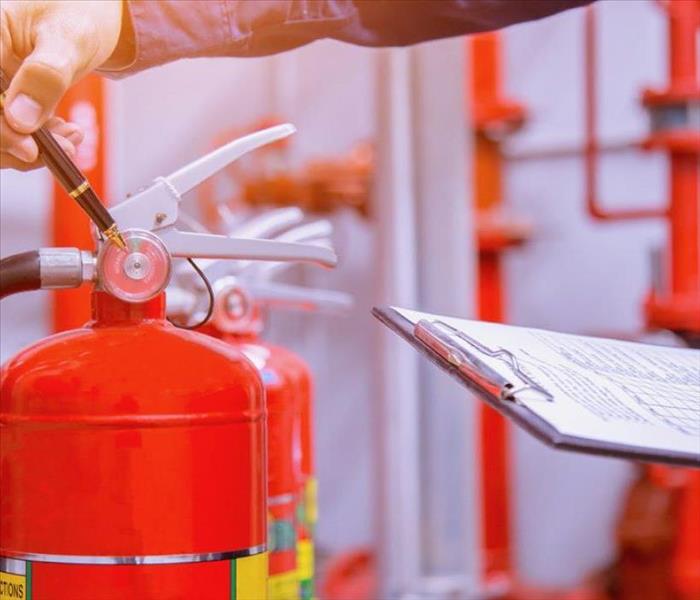 A proper evaluation of the building or structure must take place for an accurate assessment of the fire risk level.
A proper evaluation of the building or structure must take place for an accurate assessment of the fire risk level.
A fire can have a devastating impact on any building –– commercial or residential. Thus, the ability to predict building fires is more critical than ever. Fortunately, technological developments in fire research, data collection, artificial intelligence (AI), and advanced analytics have provided essential information to many industries and fields to help ensure safety.
Furthermore, data analytics not only assess fire risk but can now predict fires. This blog will explore exactly how data can help predict building fires and what fire risk assessments entail when managing fire risks for your building.
What is a Fire Risk Assessment?
A fire risk assessment is an evaluation of the different hazards that exist within a building. These risks are then prioritized based on their impact and likelihood to create hazardous conditions for occupants, visitors, or others who work in the building.
To conduct this type of analysis, you must consider multiple factors (for example, combustible materials, electrical equipment) and elements related to how fires spread, such as ventilation.
In addition to these considerations, a proper evaluation of the building or structure must take place for an accurate assessment of fire risk level and appropriate countermeasures to be put into practice.
Why is it Important for Businesses and Cities?
A fire risk assessment and analysis can help a business and city minimize the risk of fire. Moreover, if cities have various buildings with a significant risk for fire, they can take the necessary steps to correct this issue and prevent fires from occurring.
Otherwise, buildings left unprotected due to poor risk analysis can result in a major catastrophe. Surrounding businesses may even suffer damages as a result of the fire spreading. In turn, all those affected must undergo extensive repair and restoration efforts.
Business recovery after a natural disaster is often tricky and time-consuming. Thus, it's critical to ensure your facility is in good working order and free of hazards. The less opportunity you allow for danger, the better.
Data Sources in Predicting Building Fires
When it comes to predicting fire, data is the key. How can you predict building fires without understanding how these hazards form? Fortunately, various types of technological advances allow for real-time risk assessment and prediction.
Experts may use thermal cameras to detect hot spots on a structure's exterior. Additionally, since heat rises and materials can emit infrared radiation, these sensors can identify potential fire risks before they occur.
As a result, this data provides companies with vital information in managing fire prevention. The typical metrics looked at when predicting fires can include:
- Property assessments –– These assessments are necessary to understand the onsite materials and how combustible your building is. How much damage can a fire cause? How long does it take for a fire to cause significant damage?
- Fire department incident data –– Incident data is vital to understand how often fires occur in your area. How many other structures are there that could impact the environment around you? How close is a fire station? All vital information to know.
- Census data –– Census data helps better understand fire risk by looking at the demographics in your area. The data prepare fire departments for higher-risk areas and determines how prepared they are in an emergency.
- Building fire flow calculations –– These calculations show how fast a fire will travel from one point to another. Additionally, it shows how long it takes for firefighters to get there and how much time they have to contain the fire before it reaches a certain point.
- Land/building use –– How is the land being used? How much space is there between buildings? How close to fuel sources are you located? All important questions that need answers when assessing fire risk.
- Zoning –– Zoning tells risk assessors how much exposure a building has. This includes how far the fire can spread, how close it is to other facilities, how many escape routes there are, and more.
- Crime –– Fire risk assessors look at crime to determine the risk for fire from arson.
Managing Fire Risks for Your Building
Managing fire risks in your building is relatively simple yet crucial. There are several strategies you can use to keep your business and employees safe, including:
- Properly install fire alarms –– Proper installment of fire alarms is key. The number of detectors, their placement, and testing frequency will all have an impact on your level of safety and security.
- Install sprinklers –– Sprinkler systems should be installed on every level of a building. Additionally, the alarms need to be tested regularly to ensure that each is working correctly.
- Eliminate fire hazards –– Be sure to eliminate all potential fire hazards. This includes items that are combustible or have the ability to start fires.
- Have an evacuation strategy –– The best way to stay safe is by forming a fire evacuation plan effectively and efficiently ahead of time. Make a note of how many people can escape, fire exits available, and the time it will take to evacuate everyone. These are important to know as they can save lives.
- Maintain fire safety equipment –– Maintaining fire safety equipment is of the utmost importance. It ensures that fire alarms are working correctly, sprinkler systems work when needed, and allow maximum protection in an emergency. Additionally, in the event of a fire, it's crucial to have the equipment and tools used for fire restoration to help quickly clean up the contaminated scene.
- Train your employees –– Train employees on how to handle an emergency. For example, how will they evacuate, where will they go, and the best way to stay safe? You can never be too prepared when it comes to emergencies.
- Conduct routine fire drills –– Your employees and clients should be required to conduct a fire drill regularly. How often will depend largely on the size of your building, but drills should happen at least once a month. This will help your employees know how to react during an emergency, and it provides you with the opportunity to review evacuation plans and fire safety equipment.
- Post clear exits and escape routes –– Make sure there are clear signs of where to go and what rooms can be used as exits. This will help ensure that everyone can get out of the building safely.
- Schedule routine equipment maintenance –– Make sure that all fire safety equipment is always up to date. How often you need maintenance will depend on the type of equipment, but it should be done regularly.
Despite your best efforts, emergencies and accidents can still happen. It’s critical to have fire clean-up assistance for your belongings, should you ever experience fire damage. With the help of fire and smoke damage restoration experts, your building can be back to its original state in no time.
Fire risk assessment is an integral part of protecting your building or business from potential fires. With the help of data, fire risk assessors can determine how to better protect your building and keep everyone safe.
Relocation Checklist for Moving Your Office
11/2/2021 (Permalink)
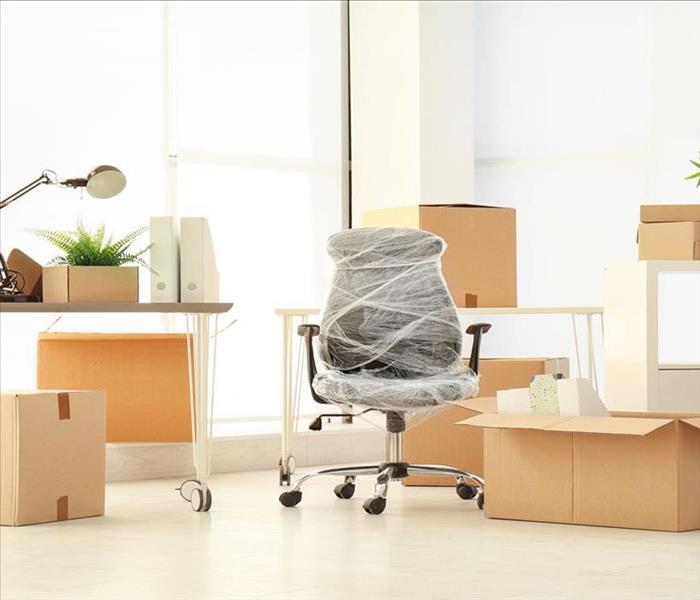 It's important to ensure that nothing gets damaged and that everything is correctly accounted for when moving begins.
It's important to ensure that nothing gets damaged and that everything is correctly accounted for when moving begins.
Office moves can be challenging, but they don't have to be stressful. With an office moving checklist, you will know what needs to happen (and when) before the big day.
A checklist will help you understand whether your office needs a deep clean before you relocate and how long it will take if the cleaning is left until after moving. Even with thoughtful planning, accidents can happen that cause a mess or, worst case, damage, that requires more than a simple deep clean. In this case, professional restoration services are available to help restore the damage done during the move.
It can be hard to know where to start, but this office move checklist will help walk you through the process to help your relocation goes as smoothly as possible.
Before You Move
Before your move, have an office move checklist so that you don't forget anything. If you are hiring movers, write down everything they promise or ask of you, so there aren't any miscommunications on moving day.
You’ll also want to think about:
- Setting a budget – Moving an office can be expensive, so it's best to set a budget before you start planning your move. This way, you'll know all the costs you need to factor into your move so you won't have any unexpected expenses later on.
- Reviewing the lease – If you are in a lease for your office, make sure to go over the terms with your landlord. You will want to check whether or not there is any penalty fee if you end up breaking it early. This way, once everything is out, and the new location is ready, moving won't be an expensive hassle.
- Shopping for moving companies – Before you pick a mover, it's best to do your research. Get quotes from multiple companies so that you can compare prices and make sure the company matches up with what is promised on the quote.
- Setting a moving date – One of the most essential pieces of advice is to select a moving date. You want to give yourself enough time for packing and cleaning.
- Notifying employees, landlords, clients, and shareholders – Create business relocation letters for employee shareholders, clients, and your landlord ahead of time. This will allow them to make preparations for when you move out and how they can contact you during this transitional period.
- Reviewing inventory – Before you start packing, go over the inventory and ensure that everything is accounted for. You will want to photograph each item so that there aren't any losses during transportation.
- Setting up utilities – This includes electricity, gas, and water. You want to ensure that these transfer over before you move so that your office remains functional.
- Initiating access cards, keys, and parking passes – Make sure that you’re able to get employees the access they need before your first day in the new space. It’s also wise to test to make sure that all access devices are working accordingly.
- Planning for storage – If you plan on storing any of your office equipment or furniture, make sure to have a location in mind, and a plan for getting the items safely to the space.
During Your Move
It's important to ensure that nothing gets damaged and that everything is correctly accounted for when moving begins. Here are a few steps to take during your office move:
- First, do a walkthrough and assess any damage – Go through the office, check for any damage, and ensure all of the dirtiest places in the office are clean. The benefits of a clean work environment cannot be underrated and will make the space feel that much more comfortable.
- Set up the offices and layout – Set up the layout and ensure there is enough room to walk around. Get a feel for how you want the office to flow. Be sure it's comfortable yet organized.
- Unpack and take inventory – Unpack all your items and compare them with the inventory list you made before the move. Intentionally give everything a place as you unpack.
- Make sure utilities work – Test all the electrical outlets and plumbing systems. Make a note of any issues.
If any damages or repairs are needed, make sure to contact the landlord as soon as possible, and keep a record (both written and photographed) of any issues you’ve found and addressed.
After You Move
After your move, you need to ensure that everything runs smoothly and your new office is ready for work. You’ll want to make sure that you:
- Confirm the termination of the old lease – If you had a lease, it's essential to confirm that the old one has been terminated and processed accordingly.
- Submit a change of address – Update your mailing address, business cards, printouts, and social media accounts. Make sure to do this as soon as possible, so your customers and clients know where to find you.
- Notify clients and shareholders – Notifying clients and shareholders of your new office address is crucial. You don't want to lose any business or have difficulty communicating with them because they are confused about your location. Make sure to update company websites and any citations that your business has online as well.
- Clean up the old office – Ensure that the old office has been thoroughly cleaned before you turn over your keys to the landlord or management company.
When you’re cleaning out your old office space, you’ll want to especially keep an eye out for water damage, mold, or fire damage, all of which will benefit from professional help to clear and clean up.
If you find extensive water damage in the space you’re leaving, you'll need water damage repair and restoration services to help you make sure the space is properly remedied. If your water damage has prompted molding, you'll need the assistance of mold remediation and restoration services to help clear out all infected areas. Additionally, if you've discovered any fire damage, it's critical that you contact a professional fire and smoke damage repair and restoration services to get the office back to normal.
Rescuing Your Wet Carpet and Drywall
11/2/2021 (Permalink)
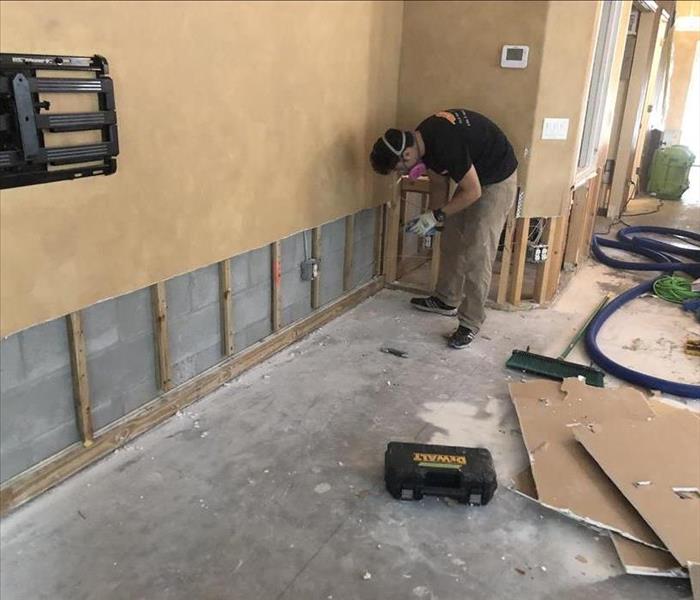 You do not have to replace the entire drywall if it isn’t all damaged. Flood cuts are made removing the drywall up to a certain height where the
You do not have to replace the entire drywall if it isn’t all damaged. Flood cuts are made removing the drywall up to a certain height where the
Whether it’s caused by a broken pipe, storm, or septic overflow, water damage of any kind can cause a great deal of stress. Fortunately, the severity of the disaster will determine the severity of damage done. Smaller floods made by leaking faucets may leave less damage, whereas larger ones made by burst pipes or storms can be more destructive.
Regardless of the flood’s cause or size, there is sure to be some amount of damage done to your home. You may be able to save some drywall and flooring by bringing in professional water cleanup and restoration services as soon as possible. Unfortunately, others may be beyond repair and/or create a hazardous environment if the affected areas weren’t adequately cleaned and restored right away.
To learn how to choose between restoration and replacement, let’s take a look at how and when to repair your carpet and drywall after suffering water damage.
What Happens When Carpet Gets Wet?
Spilling a glass of water on your carpet and letting it set is one thing. Letting water sit after a flood is another. If you fail to remove the water from the carpet promptly, then you’re putting yourself and your carpet at risk of further damage. This includes, but isn’t limited to, mold exposure and damage to the carpet padding.
Depending on how long the water is left for plays into the amount of damage. The longer the water sits, the more mold, bacteria, and structural damage can be done to your home. The sooner you’re able to intervene to stop the water damage, prevent it from spreading, and begin drying and addressing the damage, the better.
Should Wet Carpet Get Replaced?
In some instances, your carpet can be saved. If your carpet was minimally damaged by clean, clear water — like from a water spill or faucet leak — and can be thoroughly dried, then chances are it can be saved.
However, carpeting that has suffered more severe water damage will need to be replaced. Signs your carpet needs to be replaced after a flood includes:
- Damaged carpet padding and/or subflooring;
- Lingering stench;
- Signs of mold and mildew;
- Significant stains.
You can always speak to a restoration professional to get a second opinion on whether or not your carpet should be replaced.
What Happens When Drywall Gets Wet?
Unfortunately, some people are all too familiar with dealing with damaged drywall as a result of water damage. No matter if it’s a result of a flood, burst pipe, or storm, wet drywall can be a hassle to tend to if left for too long.
Even areas with high humidity levels like Florida and Louisiana are all too familiar with drywall damage due to an abundance of moisture.
Similar to a water-damaged carpet, water-damaged drywall must be treated right away. If left without being repaired, chances of mold, mildew and structural damage will increase. Signs of water damage in drywall include:
- Flaking/peeling paint;
- Mold;
- Musty smell;
- Soft spots;
- Warping;
- Water stains.
Be sure to contact your local water cleanup and restoration company if you see any of the above signs in your home.
Should Wet Drywall Get Replaced?
If your drywall only has a few stains, then you should be able to remove the damaged areas, paint over them, and keep the structural integrity. If it received more intense damage like warping or molding, then it will need to be replaced as soon as possible. The damage will only get worse if left unattended for too long.
You do not have to replace the entire drywall if it isn’t all damaged; rather, you only have to replace the affected areas. An example of this is flood cuts — cuts that are made removing the drywall up to a certain height where the flood water damage has occurred, to strategically expose the material and allow it to dry without destroying the entire area.
How To Dry Out Wet Carpet
For the carpet that you were able to salvage, it is crucial to ensure it is completely dry before reinstalling it. Listed below are a few tips and tricks on how to dry out wet carpet:
It is crucial to ensure your carpet is 100% dry before reinstallment. Failure to do so can result in mold or mildew.
How to Dry Out Wet Drywall
One of the first things to do when drying out your drywall is to remove any moisture from the surface using an absorbent towel. From there, you will want to assess whether or not it is salvageable or needs to be repaired.
If no repairs are necessary, then you may want to consider the following tips on how to dry out wet drywall on your own:
- Invest in a dehumidifier or dehumidifying services;
- Open up windows and doors for a natural, recurring breeze;
- Point fans at the wet spot;
- Remove baseboards, wallpaper, and wall molding to prevent moisture build-up.
Remember, your walls must be completely dry before resetting and painting.
Getting Professional Help
For those tough cases where the water damage is just too much, don’t be afraid to throw in the towel and seek out professional help. As soon as you recognize a burst pipe or other water damage, call in local experts in water damage restoration and mold remediation who have a trained eye that allows them to identify signs of water damage and mold, repair any damage, and prevent water damage from happening in the future.
Why Every Florida Homeowners Needs a Restoration Company Saved to Their Contacts
10/7/2021 (Permalink)
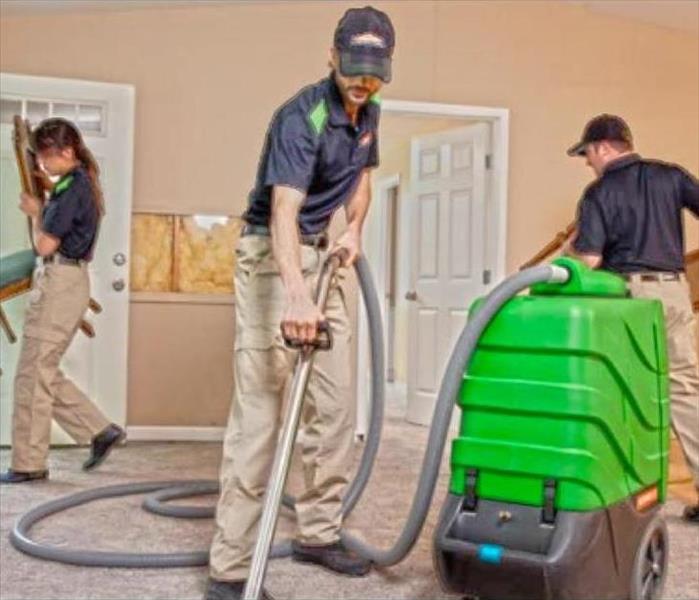 Services like water damage restoration require experience and the right equipment to tackle properly and prevent mold growth.
Services like water damage restoration require experience and the right equipment to tackle properly and prevent mold growth.
What Do Florida Restoration Companies Do?
Let's face it, most Central Florida homeowners don't know what a restoration company does and why it's important. The thing is, most people do not even know what goes into services like water mitigation, post-fire cleanup, or mold remediation until they actually need them. In this article, we will cover the services we provide and, more importantly, why you should be prepared and knowledgeable about them before you actually need them.
1. Water Damage Restoration
Water damage is our most highly sought-after service. However, most of the calls we receive are from homeowners who do not know what to expect at all. Water damage can occur in a number of ways such as; pipe bursts, storm flooding, toilet overflows, roof damage, washing machine malfunctions, etc. When these events occur, they need to be addressed quickly to prevent further damage from the water itself or even mold growth.
There are also different categories of water damage based on whether the excess water is clean or contaminated such as sewage backups.
Aside from the need to have the water removed, you also need to make sure the affected materials of your home are thoroughly dried out. This can include your ceiling, walls, and various flooring types. Not taking the proper steps to do so can easily lead to mold in Florida homes.
How We Can Help
SERVPRO of Winter Park has the experience to determine the level of damage and address it properly in a timely manner to avoid further damage. We have the manpower, equipment, and experience to handle water damage extractions, structural drying, and disinfecting. If any affected materials are unsalvageable, we can facilitate their removal, discarding them, and replacing them through reconstruction.
Why You Should Save Our Contact
We are located just north of downtown Orlando giving us the fastest response time for most of Central Florida. Time is of the essence when you have a water disaster, so having our number ready will ensure you can quickly reach a reputable company you can trust.
Our office is reachable 24/7 at (407) 678-5391.
2. Mold Remediation
Another highly sought-after service in Florida is mold remediation which basically means mold treatment and removal. Mold growth in a Florida home most typically occurs after a water damage event has occurred. The humid climate in our area along with excess moisture creates the perfect environment for many different mold species to grow in. In some cases, you can identify what might be mold visually but most times it will be hidden from sight. You may also suspect a mold problem if you experience heightened allergies or smell a foul pungent odor. The only way to really determine whether you have mold is through sample collecting and lab testing.
How We Can Help
In the state of Florida, your mold tester and mold remediator cannot be the same company because of a conflict of interests. We can put you in touch with reputable mold assessors in your local area. They will collect surface samples where they can and air quality samples throughout the home along with a controlled air quality sample from outside of the home. These samples get sent to a lab to determine what species of mold are present and where the spore counts are highest in the air. The assessor will analyze the results and write a detailed protocol for treatment and removal.
Once this protocol is written, SERVPRO of Winter Park can step in as a remediator and eradicate the mold from the source. We use organic treatments for the mold that are safe for the homeowner and their family. We remove and reconstruct affected unsalvageable materials like drywall. We thoroughly clean materials that can be salvaged. Using a powerful, HEPA filtered air scrubber, the air is cleaned and filtered to remove as many mold spores as possible.
Most importantly, before remediation takes place we seal the affected areas to avoid mold spreading during the process. Once remediation is complete, the assessor will test again to verify the results and determine whether or not the remediation was successful.
Why You Should Save Our Contact
There is a ton of misinformation online. We are experts at mold so if you suspect anything in your home you can call us to get expert advice on what may be going on and what crucial next steps would be whether it is DIY or professional help you need. We have also worked with many assessors and can recommend companies that are thorough in their testing and reporting to make sure you are on the right track to ridding yourself of mold for good.
Our office is reachable 24/7 at (407) 678-5391.
3. Fire Damage Restoration
There aren't many situations in a homeowner's life that can match a fire event in terms of stress and confusion. This is a hard time for anyone. After the emergency responders have put out a fire, the journey does not end there, unfortunately. Getting back to how your home was before the fire takes a specialized type of service.
How We Can Help
A restoration company will take care of the cleanup involved after a fire. This consists of cleaning soot and smoke residue and even water damage cleanup from fire hoses. It is an extensive process but one we are accustomed to and well equipped to handle. We can also clean salvageable belongings and materials. We facilitate any demolition that needs to occur as well as reconstruction.
Why You Should Save Our Contact
Like water damage events, fires can occur at the spur of a moment. After calling the fire department, calling SERVPRO of Winter Park can get the process rolling for cleanup. Once the emergency responders have cleared the property for re-entry, we can work directly with your insurance adjuster to calculate the damages and shorten the drawn-out insurance process. This helps to make sure cleaning can happen quickly and further damage is more likely to be prevented.
Our office is reachable 24/7 at (407) 678-5391.
4. COVID-19 Cleaning
In the midst of the pandemic, SERVPRO of Winter Park has included COVID-19 cleaning services to help prevent the spread of the virus.
How We Can Help
We can do a deep cleaning and full disinfecting of your property. We use only CDC-approved disinfecting agents to combat the virus. Our experienced cleaning team will clean all surfaces with a high concentration of high traffic areas. We can also fog the area to disinfect the air as well giving you peace of mind.
Why You Should Save Our Contact
We know that this is a virus that can spread easily. In the event that you, a member of your household, or someone visiting you has contracted the virus, cleaning after a quarantine can help prevent others in your home from catching the virus as well. Holidays are also fast-approaching so having a thorough COVID-19 cleaning after a party or gathering can help keep the disease away from your home.
Our office is reachable 24/7 at (407) 678-5391.
5. Biohazard Cleaning
Biohazard cleanings are one of our lesser-known services but when they are needed they are necessary. Examples of this type of cleaning would be blood, vomit, other bodily fluids, animal feces, chemical spills, and any other hazardous materials that require special care in removal.
How We Can Help
SERVPRO of Winter Park is experienced in cleaning hazardous materials. We can safely remove the materials from your home and disinfect the affected areas. We are also able to properly discard the materials.
Why You Should Save Our Contact
To prevent harm to yourself and members of your household, it's important to have a biohazard cleanup done quickly by a professional. We have a short response time and can be anywhere in Central Florida within the hour.
Our office is reachable 24/7 at (407) 678-5391.
Why an Inspection for Mold is Crucial When You Suspect It
9/30/2021 (Permalink)
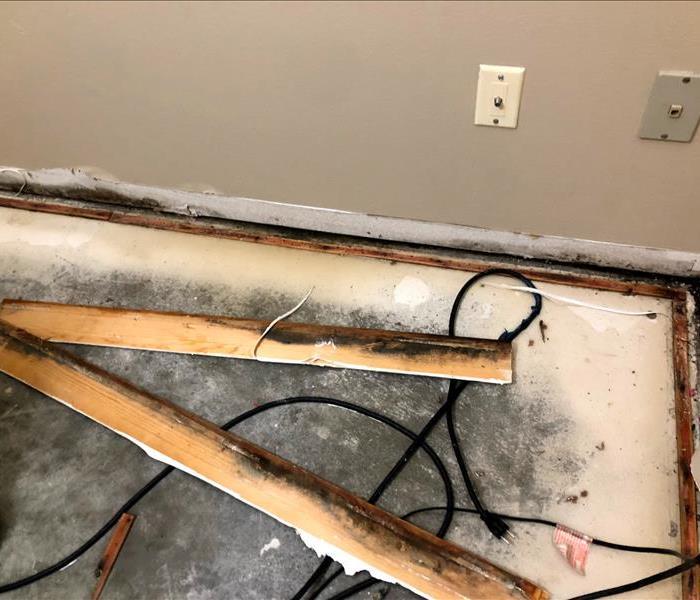 Many times, mold will remain hidden from the human eye. However, even when it is visible, an inspection for mold will tell you what your eyes cannot.
Many times, mold will remain hidden from the human eye. However, even when it is visible, an inspection for mold will tell you what your eyes cannot.
Contrary to popular belief, molds are a natural, helpful aspect of our environment!
Environmentally, certain molds can be quite helpful—for instance, blue cheese and penicillin. Some wood molds, such as Ophiostoma, are harmless to the building structures or their occupants. And so, a mold inspection for this form of mold would be unnecessary and costly.
Still, there are many more mold strains that can wreak havoc on your house and health. Some common examples include Aspergillus, which can affect people with severe allergy issues. Thus, if you're suspicious of mold, be sure to contact an expert mold remediation company as soon as possible. Your health and that of your friends, or family could be dependent on it.
Do you need an expert inspection for mold?
Fear of "black mold" infiltrating their houses and causing health and structural issues is quite common in Florida. Yet, we cannot deem all black mold "hazardous" based on its color.
Mold spores are always present in Florida homes; they are everywhere in Florida, and it's hard to keep them out. The issue comes when indoor air contains more mold spores than outdoor air.
You should call a mold inspector:
- If you have been suffering from severe allergies in your home or business.
- When there is no visible mold but a strange odor is present. Inspections for mold and mold tests can disclose whether or not mold is prevalent in this area.
- And lastly, if you've been experiencing plumbing or water damage concerns and suspect widespread mold behind the walls or in the air.
If you suspect mold in your Florida home, call a certified mold inspector right away to test the interior air quality and confirm the presence of mold.
How Inspectors Conduct the Mold Testing
Environmentalists specialize in performing IAQ (Indoor Air Quality) or MAS (Mold Air Sampling) tests. The purpose of this test is to identify irritants or probable mold strains present in your home or commercial building.
As we mentioned previously, despite its dark hue, not all mold is dangerous to black mold. A visual assessment alone cannot assess a mold growth's threat. Only mold testing can determine the mold strain in your home.
An inspection for mold will also look for historical mold growths that may reactivate or areas with signs of moisture that may contribute to future mold issues.
Then, the inspector will forward any samples taken during the inspection for molds or mold testing to a qualified lab for analysis and identification. In this manner, they can determine the exact nature of your mold issue.
One common technique employed in identification includes thermal imaging. It identifies water that could contribute to mold growth. If you have a musty odor but no recent water damage, thermal imaging can find a concealed leak behind your walls that generates mold growth.
A mold inspection usually follows precise guidelines to measure indoor air quality in Florida accurately. Reputable mold testing companies also write a written protocol that remediation companies like SERVPRO of Winter Park use for properly removing the mold.
Don't Get Tempted to Purchase A DIY Mold Test Kit
As you become more aware of the dangers of mold, you may get tempted to use a DIY mold test kit. Indeed, these kits are available over-the-counter and are gaining popularity due to their ease and perceived value. Sadly, many of them are rip-offs. Here's why you shouldn't buy them.
First, their results aren't as straightforward as you may think. Manufacturers of over-the-counter products want you to feel that their tests are simple. However, you still need an expert to interpret the results.
Secondly, the US Government mandates that only professionals should do the sampling. Professionals have the experience and understanding to develop and conduct mold sampling. Amateurs produce more false positives and negatives.
Thirdly, these kits are impractical when one cannot see the mold. One of the most common reasons to test for mold is when you can't see it but smell it. However, over-the-counter mold test kits only work if you have visible mold in your home — they can't detect if that musty scent is mold.
Further, these kits almost always identify mold, whether it's an issue or not. Millions of mold spores swarm the air, looking for a place to live and flourish. They will grow on a test kit petri dish whether or not it is an actual problem in your home. You can think you have a mold problem when you don't.
Lastly, DIYs don't tell you what caused the mold epidemic. A mold inspector must visually inspect the mold to ascertain its origin. Mold can form in your home due to leaking plumbing, lack of extraction vents, or drywall gaps. A mold test kit may indicate that you have mold in your house, but not why—a natural variety. You don't know if it's foundation or gutter concerns.
How Can SERVPRO Help?
Do you have a mold problem, or are you suspicious of one? Don't wait. Your health should be your priority. We have worked with many mold assessors in Central Florida and can put you in touch with a mold tester in your area. If testing shows a need for remediation, we have the experience and manpower to tackle the issue and help prevent it from coming back again.
Mold and Mildew Removal The Right Way
9/20/2021 (Permalink)
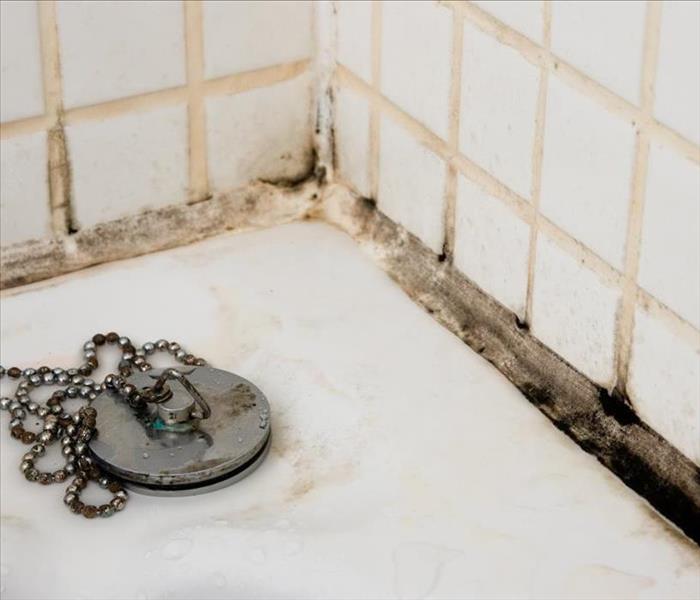 Mold and mildew on a non-porous surface such as tile can be cleaned with DIY methods. Deep spreading on porous surfaces requires a professional.
Mold and mildew on a non-porous surface such as tile can be cleaned with DIY methods. Deep spreading on porous surfaces requires a professional.
If you start seeing unsightly sots growing on your walls or smell musty odors, you might be dealing with a mold or mildew problem. To prevent mold issues, you need proper ventilation and avoid moisture by monitoring humidity indoors. But if it's too late and you already have a mold or mildew problem, you need to know how to clean. You can quickly get rid of mold or mildew on the affected areas, but it depends on how severe the effects are. Mold and mildew are basically the same; the only difference in the cleaning technique will be determined by the affected surfaces. Read on for mold and mildew removal essential tips.
When to Call a Professional
You are actually exposed to mold spores all the time, both outdoors and indoors, and that is mainly not a cause for concern. But when the right environment occurs and they start to grow and spread in your home, they may force you to call a professional. DIY is effective when the mold effects are not too severe. But there are instances when you need expert help with mold remediation. If you smell the mold but can't find the affected area, you may need to call a professional.
You also need to call a professional when you live with someone with severe allergies. Also, if the mold is creating structural problems that are way out of your skills, seek help. When you catch the mold early, you can use a cup of bleach, hydrogen peroxide, or baking soda to kill mold. But if it's a large colony of mold or mildew, you will need more aggressive chemicals and cleaning methods. That is when you should call a professional.
Mold and Mildew Removal on Different Surfaces
Cleaning non-porous and porous surfaces will have a slight difference. Learning how to remove mold on different surfaces will ensure your DIY cleaning is a success. You should always wear protective gloves, goggles, and a respirator.
Cleaning Mold off Grout and Tiles
The bathroom is very notorious when it comes to mold issues because of the humidity. For effective mildew removal, you need a solution of sixteen parts water and one part bleach. There are so many products in the market for cleaning, but water and chlorine bleach are equally effective.
After applying the solution to the affected surface, wait for fifteen to twenty minutes. You can then use a gentle bristled brush to scrub the place. Rinse the surface with clean water and dry it with a cloth. You should keep the area ventilated by opening the windows and allow to air dry.
Cleaning Mold off Fabric
You can wash mold away on washable fabric. If the clothing is still stained after washing, you will have to use oxygen, bleach, and hot water. Soak the cloth in a solution of oxygen bleach and water and leave it for several hours. If the fabric is dry clean only, you will have to take the material to professional cleaners. But first, brush the fabric to get rid of all the visible mold and mildew.
Cleaning Mold Off Wood
Wood surfaces, walls, or floors can be affected by mold and mildew. For easy mildew removal, you can start by vacuuming the area because it helps loosen the spores. Use warm water and mild liquid dish detergent to scrub the affected wooden area. You can use a bristled brush to scrub while constantly dipping it into the water and soap solution. This cleaning method will work best if the wood is painted or stained because the mold and mildew cannot penetrate the surface.
If the wood is not painted or stained, you will need vinegar. Mix equal parts of the warm water and vinegar and use a spray bottle to apply the solution to the affected wood surface. Let it sit for an hour before you wipe it off. Use a towel to ensure the wood is as dry as possible. Ensure you get rid of all the dirt to avoid mold stains. You can use borax when you don’t have vinegar.
Cleaning Mold off Furniture
Try to remove as much visible mold and mildew on the furniture’s surface as possible. Try using a damp cloth to wipe the surface before you start the cleaning. It will help you get rid of spores so that your work later becomes a little easier. Take dish soap or mild detergent soap and mix it with water. The water can be warm if you want; mix the solution until you have enough foam. You can use the solution to clean the furniture with a cloth or gentle brush.
It would be best to do furniture cleaning on a sunny day. Move your furniture outside and remove the mold and mildew outside. After cleaning, leave the furniture under the sun to dry, ensure it's completely dry before you move the furniture back inside. You can use a leather conditioner to treat the affected surfaces after cleaning. You may need to replace the furniture entirely if the mold is deeper into the cushions.
Cleaning Mold off Carpets
A substantial amount of mold and mildew on your wool or silk carpet may need professional cleaning. But if it's a small area that is affected, you can do it yourself. Every time you are using bleach to remove mildew, wear your protective gear. But if the carpet loses color, stay away from bleach. Isolate the carpet to ensure the mold will not spread to other parts. Use a vacuum or a stiff brush to remove visible mold spores.
Scrub the affected areas with cleaners and allow them to air dry. It may take a day or two for the carpet to dry completely. Once you are confident the affected area is not damp anymore, you can return the rug to where it was. To be safe, clean the floors thoroughly to avoid another mold issue with the carpet.
Cleaning Mold off Outdoor Surfaces
Patio stones, unpainted cement, and other outdoor surfaces can be affected by mold and mildew. When this happens, you will need a thorough scrubbing using chlorine bleach and water. Mix a gallon of water with at least one cup of bleach. Use a stiff brush because most of the outdoor surfaces are hard. You also need to be vigorous to avoid mold stain.
Chlorine bleach can harm your lawn, garden, or any plant. You have to be extra cautious when using bleach to clean outdoor surfaces. Cover any plants that may be affected before you clean the mold off. After scrubbing the surfaces with water and bleach, rinse them with clean water.
Conclusion
Mold and mildew issues can be very frustrating. You have to always keep an eye out if you want to win the war against mold. When you catch the issue early, you won't have to call a professional mold remover. Mold removal will be a breeze when you know how to handle different surfaces.
Orlando Apartment Grilling Rules and Safety Tips
9/9/2021 (Permalink)
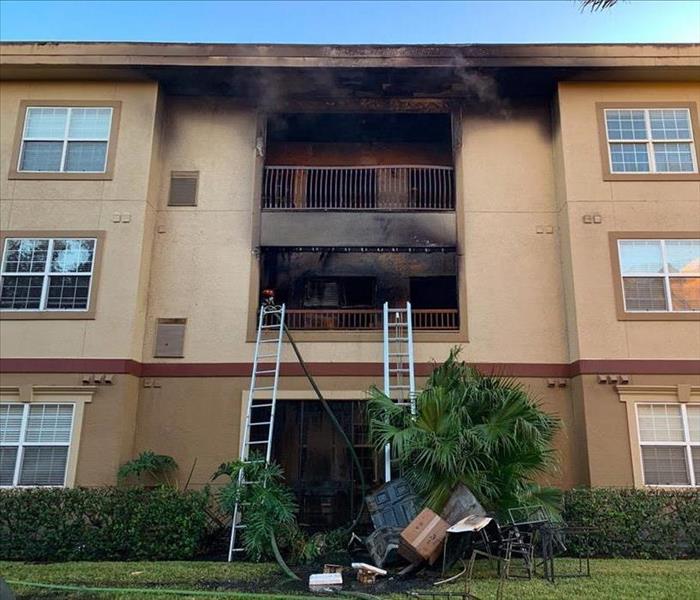 According to the Florida Fire Prevention Code, all apartment and condominium owners are prohibited from cooking on their balconies.
According to the Florida Fire Prevention Code, all apartment and condominium owners are prohibited from cooking on their balconies.
Rules and Safety Practices for Using a Grill for Orlando Apartment Owners
Grilling is a fun activity that will surely make the day for your family and friends. As a resident of Orlando, FL, grilling might be a hobby for you, and, likely, you can't get over the thought of having burgers and seasoned meats chops sizzling on your grill. However, you must exercise caution while grilling as it can also be dangerous.
According to data from the National Fire Protection Association, grilling activities were the cause of about 10,200 home fires annually between 2013 and 2017. The fire risk is heightened for apartment homeowners compared to single-family homeowners due to the limited space available for grilling. Here are some rules and safety practices for using a grill for apartment owners in Orlando, FL, that you should observe.
1. Cooking on Balconies
Apartments with balconies are highly sought after in Florida. This is because a balcony provides ample and much-desired outdoor space to a homeowner. The general rule of thumbs is that the larger the balcony, the better off you are. However, according to the Florida Fire Prevention Code, all apartment and condominium owners are prohibited from cooking on their balconies. The only exception granted is for those who wish to cook using electric appliances. As a grilling enthusiast, this means that you are not allowed to use a charcoal grill or a gas grill, and you can only use an electric grill.
2. Using Charcoal and Gas Grills
The fact that you are prohibited from using charcoal and gas grills doesn't mean that you can't grill as an apartment or condominium owner. The fire safety code outlines that you can grill on your charcoal or gas grill on the ground level at a distance of at least 15 feet from the apartment or condominium structure. Therefore, if your apartment has a large enough front or back utility area, you are free to grill from there using a charcoal or gas grill as long as you are set up at least 15 feet from the structure.
3. Storing Gas Grills and LPG Tanks
If you plan to set up your gas grill on the front or back utility area of your apartment, you should also be thinking of where you will be storing the gas grill and the LPG tank. This is because the Florida Fire Prevention Code also forbids keeping gas grills and LPG tanks that can hold quantities above 1 pound in apartments and condominiums beyond the first floor. Therefore you will have to arrange storage for your gas grill and LPG tanks on the ground or first floor.
What If You Fail to Comply with These Fire Prevention Codes?
It's best that you comply with the Florida Fire Prevention Code for your safety and that of your neighbors. Your home might be among your most valuable investments, and losing it in a preventable fire can be devastating. Beyond property damage, there is also the risk of loss of life. If you fail to comply with these fire prevention codes, you will likely face stiff legal punishments.
A. The law stipulates that the Florida Fire Prevention Code violators be prosecuted similarly to those who have committed misdemeanor offenses. If found guilty in the court of law, you will be liable to paying a $500 fine or serving imprisonment for a period not exceeding two months, or both.
B. Additionally, the state and county fire inspectors are authorized to issue civil citations to those who breach the Florida Fire Prevention Code. Each citation carries a penalty of $50 plus $8 court fees if it's not contested. If you decide to contest a citation and you lose, you will pay a penalty of $500 plus the related court costs for every violation.
C. If you contravene the Florida Fire Prevention Code and cause a fire that damages property and causes injury or death of persons, your will be facing much harsher punishment. This is because your violation just graduated from a misdemeanor to a felony crime that can carry years or decades of imprisonment if convicted.
Additional apartment grilling safety practices
4. Keep the Grill Clean
Whether you are using an electric grill on your balcony or a charcoal or gas grill 15 feet from your apartment structure, you should always keep your grill clean. Having a clean grill significantly reduced the risk of a fire occurring. This is because, in most cases, it's the leftover and grease build-up on a dirty grill that ignites to start a fire.
5. Set Your Grill on Stable Ground
Failing to set up your grill on stable ground is a dangerous undertaking that puts you at significant risk of starting a fire and causing bodily harm to yourself and others. This is because your grill might tumble over as you are doing your grilling. If you are using a charcoal grill, red-burning charcoal will be spilling all over. If you are using a gas grill, the gas connection will likely become undone, spilling flammable gas in the air and risking an explosion. On the other hand, the cords for an electrical grill can snap and short-circuit, causing a fire when it falls.
In the Event of a Fire
When grilling, it's wise always to have a fire extinguisher close. This would allow you to put out any fire as soon as it occurs before it has the opportunity to cause significant damage. If the fire becomes uncontainable, get everyone to safety and call the Orlando Fire Department. Once the fire has been put out, you will need to undertake fire damage clean-up. Call SERVPRO of Winter Park at (407) 678-5391 for professional fire damage clean-up in Orlando, Florida, and the surrounding areas.
What Are Flood Cuts and Why Are They Necessary?
8/20/2021 (Permalink)
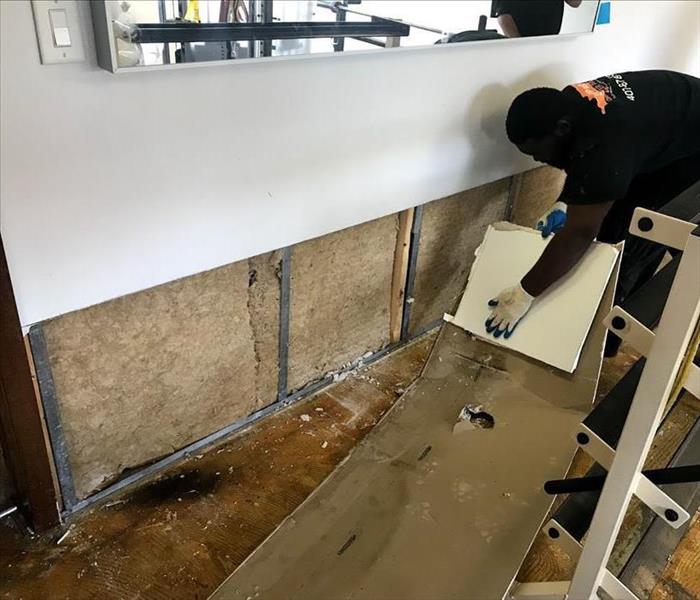 A flood cut is removing the drywall up to a certain height, especially in a flood-affected area.
A flood cut is removing the drywall up to a certain height, especially in a flood-affected area.
Floods are an environmental hazard. They destroy property and cause a lot of inconveniences. A flood may seem harmless since the water is colorless, but it contains ill-causing components such as bacteria and chemicals. Not to mention that it may cause significant financial losses in your home.
A flood cut will help tackle the issues related to flooding.
What are Flood Cuts?
A flood cut is removing the drywall up to a certain height, especially in a flood-affected area. Often, it is about 12-18 inches above the place the waters last marked.
Why Are Flood Cuts Necessary?
A flood cut prevents contaminated floodwater from finding its way into your pipes. After the excess water occupies your area, you may consume contaminated water, leading to illness for the whole family.
By cutting out a section of the drywall, flood cuts will ease access to the affected area. If you want to repair the areas damaged by the water, a flood cut will make it easier. You can treat the afflicted areas directly and more conveniently.
It also enhances the dry-out phase. Keep in mind that a moist wall may develop mold growth on it. You may get respiratory infections such as tonsillitis and pneumonia due to a damp wall. A wet room can also impact your immune system.
How Do I Make a Flood Cut?
Ensure that you have the following Apparatus
• Chalk Line
• Ruler
• Hammer
• Utility knife or jab saw
The following steps will then guide you:
• Create a straight line above the place where the water last touched. The line should be straight so, use a ruler.
• Use a utility knife to cut through the line. Be careful not to cut deep. (To avoid any injuries, wear protective gear)
• If you do not have a utility knife, then you can use a jab saw.
• In the cut section, poke a small hole using a hammer.
• Hold on to the puncture then, gently pull out the intended cut-out. Do not use too much torque to avoid damaging your drywall.
Remove all the insulation underneath the wall. However, if it is a plastic insulating material, you may leave it to dry out on its own.
Opt for dehumidifiers or highly efficient blowers to dry up the section. You can also open up the windows and doors for natural air circulation.
How Will I Restore It?
Know how much material you need in the first place by measuring the cut-out space. You will not end up wasting resources if you get an accurate measurement. Proceed with the detailed steps below:
• Put four drywall clips in the area surrounding the hole. (You should place them on all four corners of the cut area)
• On top of the clips put a drywall screw for support.
• Insert the drywall pieces onto the drywall clips.
• Carefully seal them with a drywall screw. Be careful not to over-tighten.
• To blend it in with the existing drywall, use a compound joint.
As soon as it dries up, you may paint it with mold-resistant paint.
Is It Always a Must to Flood Cut?
No, it isn't. If the water leak was from a clean source, there is no need to cut out your wall. You may use an injection system to wither the wall. A wall with no insulation also does not need a flood cut.
Make Sure You Consult First
Ensure to only practice home maintenance tips that you can handle to avoid incurring losses. Keep in mind that every home needs a specific type of care. So get a consultation from an expert first.
Dry Out After Water Damage
6/22/2021 (Permalink)
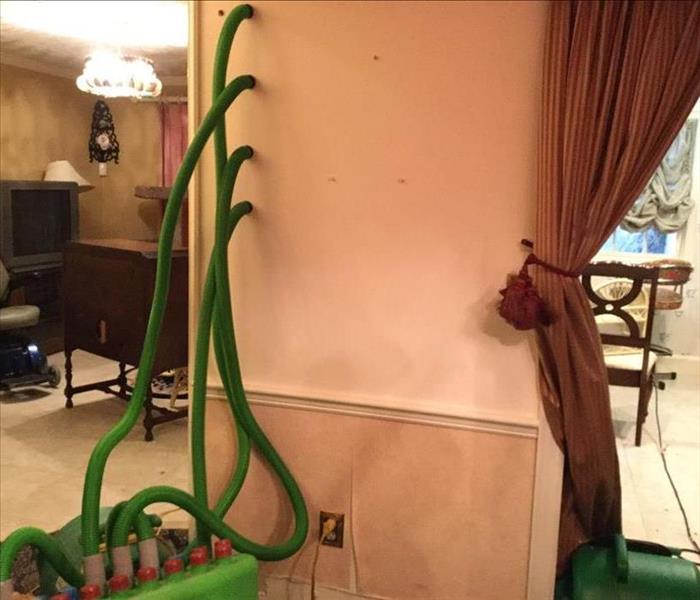 Aside from knowing how much equipment to place and where our technicians are trained in other drying methods to be as efficient as possible.
Aside from knowing how much equipment to place and where our technicians are trained in other drying methods to be as efficient as possible.
Water damage happens due to several factors like flooding, high humidity, or water leaks. This damage can cause problems in your home, and it can compromise your loved one's safety. Molds and dirt yield in moist and damp areas. You may need a company that repairs water damage suppose your place is prone to floods. You should call these experts to dry out your home as soon as floods occur.
These damp conditions might worsen if you do not use the right tools and tactics to dry your home. The damages might be expensive and cause health effects. That is why hiring SERVPRO of Winter Park is the best solution.
Why Hire Water Damage Companies?
Hiring a water restoration company is the best way to deal with floods in your house SERVPRO of Winter Park has the right skills to handle these issues. It is challenging to dry the home because you might leave out important parts like the basement. Also, it is hard to clean your house after water damage, especially if it is significant. However, SERVPRO of Winter Park will handle that for you.
Why Should You Dry with Our Equipment?
It would help if you did not try any DIY techniques when you flood your house because it can worsen the situation. However, drying out is the essential step when restoring your water. Experts from SERVPRO of Winter Park work hard to make sure your home is clean and dry. We use top-notch equipment, so do not worry about your home's safety.
These experts will examine your place and look out for important factors like moisture and humidity.
Types of Water Damage
Below are the main types of water damage:
1. Damaged pipes
Damaged or broken pipes can cause significant damage, and you should replace them as soon you notice them. You might need SERVPRO of Winter Park to achieve this. Most damaged pipes are included in the insurance policies, but damages that happen from neglect are not included. Some warranties cater to bills caused by faulty water heaters.
2. Structural damage
Water damage might cause a structural issue at your place, and this makes the area inhospitable. This water seepage in the basement or on the floor might make the home structure week and later collapse.
3. Cleanups at the sewage
Cleanup happens when you back up toilets or sinks. Black or greywater seepage is the main result of sewage spills. Cleaning up your sewage is a nasty part of the restoration procedure, and it can cause health effects. It would be great to conduct this activity with the help of SERVPRO of Winter Park.
Causes of Water Damage
Several factors cause water damage, like damaged pipes, gutters, faulty roofs, among others. In addition, homes that lack proper aeration are more likely to get mold, especially in neglected places.
It is hard to prevent water destruction because some natural factors also cause it, like storms. But you can avoid extra damage by knowing its causes.
1. Leaky roofing system
Faulty roofs will let the water reach your home, causing massive damage. You might also see water deteriorate if you have old and damaged roofs. You might think that your old roof is okay until a heavy downpour occurs. In most cases, the harm occurs, and homeowners might not notice it for a long time.
2. A faulty pipe
Damaged pipes can destroy your home by a slow leak. Plumbing problems occur, but their intensity depends on the water amount. Broken pipes cause damage, especially if the hoses in the washing machines burst.
Damaged pipes also cause issues that develop, like when water starts dripping from damaged parts.
3. Condensation
This is one of the most common causes of water contamination in many homes, but most people overlook it. This condensation happens when there is a leak or when the pipes do not drain well. With time, the condensation goes through walls and floors, causing mold.
Risks of Water Damage
There are many dangers of water damage to homeowners, both financial and emotional. Here are some risks:
1. It destroys property
One of the most common effects of water damage to your house is jeopardizing your property's safety. It is hard to rebuild most of these items destroyed by this damage. Water damage might destroy your crucial documents, clothing, and electronics, among others. This damage might also destroy essential structures in your house.
2. It may cause health effects
Water damage has a long-lasting effect on your health. Mold multiplies in moist areas, and they can cause health effects. They also attract pests and lower the air quality. Therefore, this means you should repair any water damage when you notice it.
3. Increases pest infestation
Most pests and bugs love moist areas. Unaddressed water collections also bring these critters to your place and cause further damage. Pests like cockroaches and centipedes bring moisture to your home, so you should avoid this by repairing any damage.
How to Dry Water from Damage
You can do the following things to dry out water:
- Knowing where the leak is and repairing it
- Repairing damaged walls
- Look out for mold
- Seek help from an expert
Water damage is familiar to most of us, and it happens due to reasons like faulty pipes and a leaky roof. It would be great to repair these faults to make sure they do not escalate. In addition, repairing these faults will keep your loved ones free from danger.
Why SERVPRO: Certified SERVPRO Cleaned
6/22/2021 (Permalink)
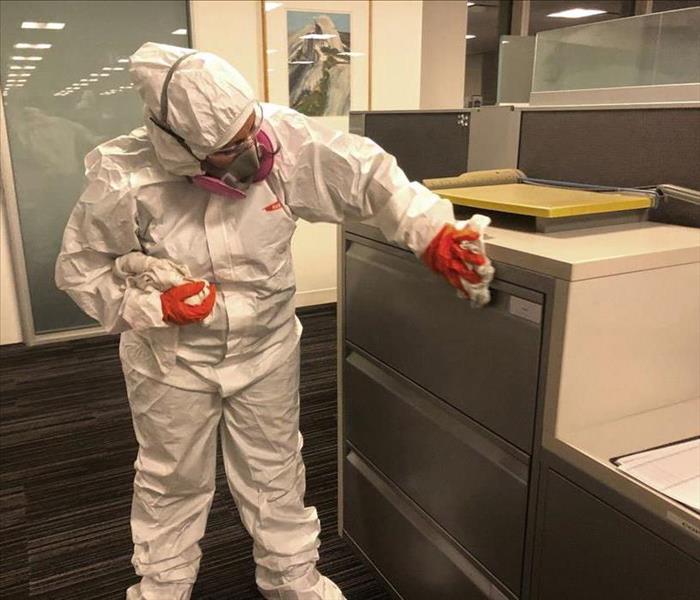 Our team uses CDC-approved products to sanitize and fight the COVID-19 virus.
Our team uses CDC-approved products to sanitize and fight the COVID-19 virus.
SERVPRO of Winter Park is offering Certified: SERVPRO Cleaned services. We have helped many businesses during the Covid-19 Pandemic. This type of cleaning can give business owners and their customers peace of mind. When businesses decide to be SERVPRO Cleaned Certified, they are showing the world that they care about deep cleaning services that will help to keep everyone safe.
CDC-Approved Cleaning
CDC-Approved cleaning is an investment in your business. We use CDC-approved disinfecting products and cleaning procedures. We will bring a higher standard of care to the cleaning process to help keep our comunities safe and your business running smoothly.
Safe
When you choose SERVPRO Certified Cleaning Services, you can be sure that your business will be as safe as possible. Our team of professionals has been trained in biohazard decontamination. We know how to clean business in the best and fastest way possible. When you cannot afford to take chances, our company is there to provide reliable services. We deliver results and peace of mind.
Custom Cleaning
Our expert cleaning technicians will give you a custom cleaning job. We want to make sure that all of your cleaning needs are met so that your business can be a safe place. We use state-of-the-art tools and only the best cleaning supplies available. We use EPA-approved hospital-grade cleaning supplies that are CDC-approved. We take cleaning seriously so that you can focus on other parts of running your business.
Security
When your business has been cleaned by us, you will have a Cleaned by SERVPRO shield placed on your front window for everyone to see. You will also receive digital emblems and different types of collateral. This will help your community know that your business has been cleaned by a company that is committed to providing high-quality cleaning services. We want to give you, your employees, your customers, and everyone in your community a feeling of security. When we clean your business, you can be confident that the job is done by professionals.
Equipment and Tools Used for Fire Restoration
6/15/2021 (Permalink)
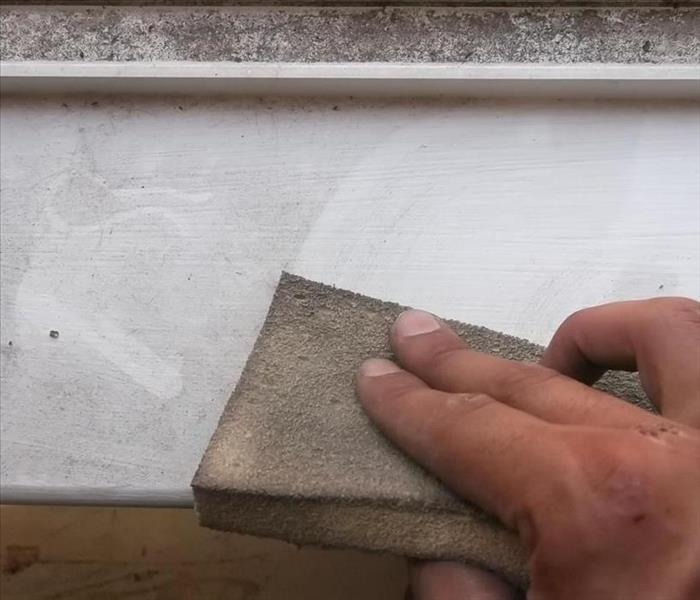 A dry cleaning soot sponge is effective for removing soot from smoke-covered surfaces. It is used to soot from surfaces you do not want to get wet.
A dry cleaning soot sponge is effective for removing soot from smoke-covered surfaces. It is used to soot from surfaces you do not want to get wet.
A fire is a disaster that can severely damage and even destroy property. There are many equipment and tools used in fire restoration, such as fire extinguishers, fire hoses, thermal imaging cameras, and more.
This article will discuss the most common of these tools - what they do, how they work to control or stop fires - so you know what to expect when you encounter them on your own property.
Tools Used For Fire Damage Restoration
HEPA Filtered Air Movers
A HEPA filtered air mover works by sucking contaminated air into one end of the machine, where a filter then catches any type of particulates such as dust or ash that would be present in either smoke or general debris from fire damage before they're expelled back out again through vents on the opposite side for immediate use with minimal risk of re-contamination. The filters inside these machines need to be cleaned or replaced every few months to keep them working at the highest efficiency level.
HEPA Filtered Vacuum Cleaners
A HEPA filtered vacuum cleaner is similar in function to a HEPA filtered air mover. Still, instead of sucking up contaminants with an intake on one side, it vacuums any debris and dust into its bag where all particulates are caught inside before being expelled out again on the other end for use without risking re-contamination from dirty filters or vents. These machines need regular maintenance like filter changes or cleanings as well.
Soot Sponges
Soot sponges are one of the most versatile tools used for fire restoration. They can be squeezed, twisted, and kneaded to let water seep into pores in a soot sponge where heat from an intense oil-based fire will dissolve it away or break these oils down while releasing particles that pose no risk to people when they touch them as well.
Debris Pads
Highly absorbent polyester debris pads help reduce the size of large debris by sucking up liquid and trapping any smaller particulates before they can spread out too far. These mats also need regular care, like removing dust and dirt off their outer surface between uses - especially if they'll be reused on site after being left outside for a while.
Buckets
Fire restoration often requires buckets - both small and large ones that can be used during firefighting operations and general cleanup afterward when the water has been used to put out the fire.
Tools Used for Putting Out Fires
Fire Hoses
A basic tool in any restoration effort is a fire hose for flooding an area with water and putting out fires. Often, it's just barely enough pressure to extinguish smaller flames. Still, they're more useful as a backup measure against larger blazes that need copious amounts of water or other types of liquids like foam-based suppressants. These hoses must be stored properly so they don't develop leaks or kinks over time which will cause them to lose their effectiveness when needed most because minor dents can become enlarged under continued use.
Foam Salt Dispenser
Often found in restaurants and food service facilities, this system uses salt mixed with soap which generates foam to suppress fires where there is a lot of grease or oil. This type of suppression can be used in any space with heavy metals like lead which would otherwise hamper the effectiveness of water-based firefighting methods.
Salt Water Sprinkler
This sprinkler system connects to your local municipal water supply. It injects saltwater into an area, suppressing flames by lowering their temperature and interfering with the chemical reactions that create them. They are effective for smaller spaces and larger ones because they work on liquid fuel sources, not just solid materials like wood or other organic substances susceptible to thermal oxidation (burning). The only downside is that it takes longer before the flame goes out, so this method isn't recommended when evacuation timeframes are tight.
Dry Chemical Sprinkler
This sprinkler system releases chemicals into the air that are heavier than air and will settle on surfaces with a high surface area to volume ratio. This makes them especially effective at fighting fires because they can reach up over 20 feet (about six meters). They also have a much broader spray pattern, which is why they're used for quick knockdown or point suppression when you want to get rid of the fire quickly before it spreads.
The downside here is that these systems only work well in small areas since as soon as the dry chemical gets wet from water pouring down onto it, its effectiveness disappears. It's also not safe if there are too many people inside an enclosed space like a room and needs to be evacuated.
The good news is that the dry chemical systems have a much better safety record than water-based fire extinguishers and can be used for large fires or small ones. They also work well on Class A, B, C, and D fires but not as well with E-type fuels like oil or gas because they need to come into contact with these types of materials to put them out.
All in all, though, there are many advantages to using this system over others when fighting a fire, so it's worth considering what equipment you want at your disposal if a disaster happens at home!
Going to a Shelter in the Event of a Hurricane
6/15/2021 (Permalink)
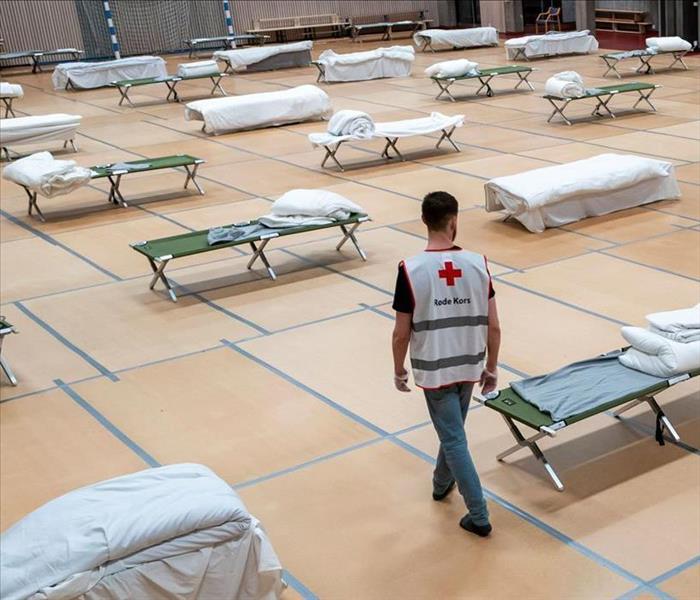 Hurricane shelters are taking the current pandemic into consideration when setting up in the event of a hurricane.
Hurricane shelters are taking the current pandemic into consideration when setting up in the event of a hurricane.
Going through an emergency situation, such as a hurricane, that requires you to evacuate your home can be very scary. Fortunately, proper preparation makes the process easier for everyone involved. While many steps in the replacement process may seem common knowledge, in the heat of the moment, there are things that can be forgotten. The following guide walks you through tips to use if you need to evacuate your home to go to a shelter during a hurricane.
Reduce the Risk of Catching COVID-19
One of the most important things you can do to prepare for potential relocation during a hurricane is to get the COVID-19 vaccine in advance. When you’re in a storm shelter, there are often many people in a confined space. This means the transmission of the virus will be much higher than if you were merely out and about doing your normal daily activities. The COVID-19 vaccine is taken in two separate doses and requires a brief window between the two doses, so getting started with the vaccine process as quickly as possible is essential.
Determine Where the Closest Shelter is Located
When evacuations occur, many people become frantic because there are so many things they need to do to prepare for their shelter stay. Taking the time to find out where your closest shelter is before any hurricanes arrive can take away some of the stress that comes during this hectic time. It’s a good idea to determine a safe route of travel in advance too. You want to be sure you don't have to travel through any roads that could potentially flood during a hurricane. This ensures you and your family can get to safety as quickly as possible.
Don’t Forget About Your Pets
Many shelters restrict pets from being able to stay on the premises for their safety and the safety of others on site. It’s important to make arrangements for your pets in advance so you have a safe place to take them if you do need to evacuate your home in the future. There are many kennels that house pets during emergency situations, but they often have limited capacity available. Making arrangements ahead of time betters your chances of being able to get them to a safe place during an emergency.
Talk to Your Family about a Potential Evacuation
The evacuation process can be scary for children so talking to them about what to expect before a hurricane hits can make the transition easier for them and for you. Explain the process that will take place and what they can expect at the shelter. Explain that there will be a lot of people in the facility and they need to stay with the family at all times. Explain how important it is to wash their hands frequently to prevent the transmission of any illness, including COVID-19. Explain that there will be very limited things for them to do to stay occupied so they need to determine what items they want to bring with them for entertainment.
Create a Checklist
It’s a good idea to create a checklist for the things that need to be brought to the shelter. A few things to consider bringing are:
- Water: While emergency shelters often have water available, the quantity may be limited and it could take a few days for emergency supplies to arrive. Packing water for your family ensures everyone can stay hydrated during the stay.
- Food: If anyone has dietary restrictions, bringing food with you ensures they get the specific foods they need. It’s a good idea to bring foods that are precooked and easily eaten without needing to be heated. It’s also a good idea to pack a few comfort foods, such as snacks, cookies, or fruit so everyone can feel as comfortable as possible.
- Medications: When staying in the shelter, you won’t have access to a pharmacy and thus need to bring any medications your family needs with you. Be sure to bring ice packs and a cooler for any medications that need to be refrigerated and refrigeration may be limited.
- Clothing: Clothing needs to be brought with you to the shelter as you may not be able to return to your home for a few days. It’s best to try to pack clothes in the most compact way possible as the amount of space designated for your family will be limited.
- Sleeping Bags: The number of cots available to shelter attendees will be limited. Bringing sleeping bags with you to the shelter ensures everyone in your family has a warm place to rest.
- Crucial Paperwork: Bring all important documentation with you when you evacuate. If something happens to your home during the hurricane, you can rest assured the important documents your family needs do not get damaged or destroyed.
- Entertainment: Staying in a shelter can become boring over time. Bringing card games, books or other forms of entertainment can help keep boredom away. It’s important to not rely solely on electronic devices for entertainment. Access to electricity may be limited and make it difficult to charge devices when needed.
Local storm shelters in central Florida can be found in Orange County at Barnett Park Community Center, in Seminole County at Northland Church, in Volusia at Ocean Center, and in Osceola County, the listings are provided when an emergency occurs. If a hurricane does damage your home, SERVPRO is ready and willing to get your home back in order so your family can return to normal life as quickly as possible.
How Business Interruption Insurance Can Help Your Business
5/26/2021 (Permalink)
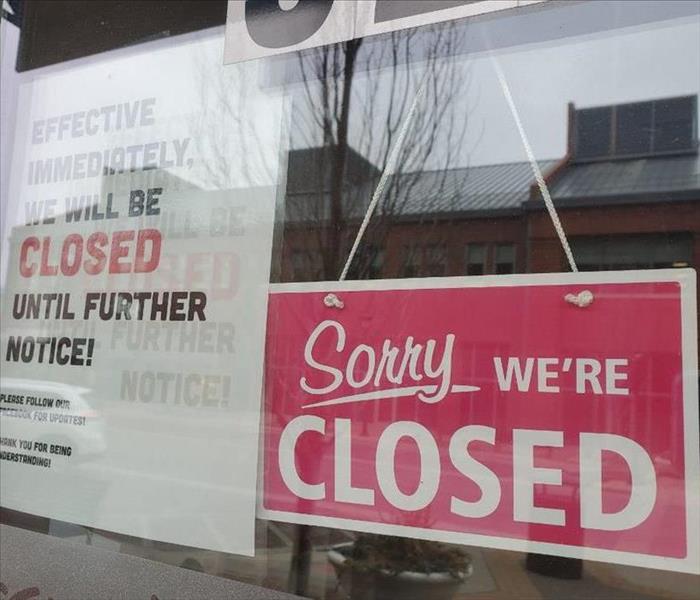 Unexpectedly having to shut down your business operations can have a serious effect on your business. Preparing for the unknown can be detrimental.
Unexpectedly having to shut down your business operations can have a serious effect on your business. Preparing for the unknown can be detrimental.
Downtime Protection for Your Business
Business interruption insurance can protect your business from the financial risks associated with unexpected events, such as natural disasters and fires.
As an owner of a small business, you might not have the funds to invest in this type of coverage on your own. One way to obtain protection for your business is through a group policy offered by various trade associations.
However, many employers find it difficult to keep up with rising premiums and increase deductibles due to their high-risk occupations.
If you're one of these people who feels stuck between making ends meet or providing for their family's future security, then consider investing in this type of coverage on your own instead!
Business Interruption Insurance: What Is It?
Business interruption insurance is commercial insurance that protects against losses sustained when a business is temporarily shut down because of an event such as fire, theft, or natural disaster.
Why Is Business Interruption Insurance Important?
Business interruption insurance not only covers your lost profits but also protects the value of future sales and ensures continued operation. This may help prevent financial problems from increasing in severity if you're unable to access other types of coverage, like life insurance, for example!
Benefits Of Buying The Coverage On Your Own:
- You can control how much coverage you have with the amount you pay out-of-pocket
- A company doesn't dictate what coverages are available or offer solutions tailored to your individual needs
- You get coverage that's tailored to your needs
- If you do need business interruption insurance, there are a few things to keep in mind:
- Be sure that the insurance policy provides adequate coverage for lost profits and overhead expenses.
- Get as many quotes as possible from various providers before deciding who best meets your individual needs. Doing this will help ensure you're not overpaying or buying more than you need!
How Does Business Interruption Insurance Work?
Business interruption insurance coverage works for business owners worried about the potential for an interruption with your company.
Businesses reliant on a fixed income from regular customers or sales, such as retail stores and restaurants, stand to lose significant amounts of money during these periods of uncertainty.
How Businesses Can Help Their Employees Using This Insurance Coverage
Employees who may have been counting on their days off to get caught up in other areas of work could be left scrambling when it comes time to go back out into the field.
In addition, if employees need to leave time because they've lost their job due to reduced business hours caused by an interruption, this can lead them down a tough road financially without adequate coverage benefits through government programs.
Not only does business interruption insurance provide coverage against lost income and wages, but it also covers lost revenue that you may have incurred as a result of the interruption.
Business Interruption Insurance Coverage
Businesses should be cautious about including enough coverage for their company to avoid negative financial impact from this type of situation or one like it in the future.
If your business relies on consistent customers, sales, work hours, or employees, then there are many ways that disruption could negatively affect your operations without appropriate insurance protection.
When considering how much coverage you need for these types of scenarios, remember what's at stake with an interruption: more than just money. You're taking away time-sensitive opportunities to get back into the field, potentially having to pay workers overtime (or provide unpaid leave) to cover the unfilled hours, and, of course, your company's long-term reputation.
Business Interruption Insurance
In post-disaster reconstruction...
Protecting against such an event is crucial because it could take months or even years before a business can be returned to normal levels - if ever.
It's common for insurance companies to offer commercial property coverage that will help recover from a disaster but not the damage caused by loss of sales during this period.
Business interruption insurance offers protection when business may have been disrupted due to the catastrophe (such as no electricity), preventing any potential losses incurred while the business is out of commission.
What Types of Coverage Are Included?
The types of coverage available to business owners include the following:
- Coverage for the shrinking of business as a result of natural disasters or other unforeseen circumstances.
- Insurance to cover additional costs incurred while starting up in another location after disaster strikes (such as rent, utility bills, and telephone charges).
- Insurance that will cover financial losses if disabled employees are unable to work during this time.
- Protection against lawsuits filed by customers who may have been injured from the event or property damage caused by it.
Business interruption insurance is an important type of coverage to consider for your business because you can't control what happens outside your premises, but you can protect yourself with coverage like this.
Business Interruption Insurance: What Isn't Covered?
- The business's most valuable assets, such as inventory and equipment.
- Business expenses that would be incurred after the new location is opened. You will need separate insurance for those costs.
Is the Cost Worth It for Your Company's Future Security?
Business interruption insurance premiums generally range from $600 to $2400 per year. The cost is worth it for the company's future security to maintain liquidity and stability during a difficult time.
An interruption of business can happen suddenly without any warning whatsoever. Still, there are many ways that your company could prevent such a disruption from happening by purchasing this type of insurance policy in advance.
How Dehumidifiers Work and Their Importance in Restoration
5/26/2021 (Permalink)
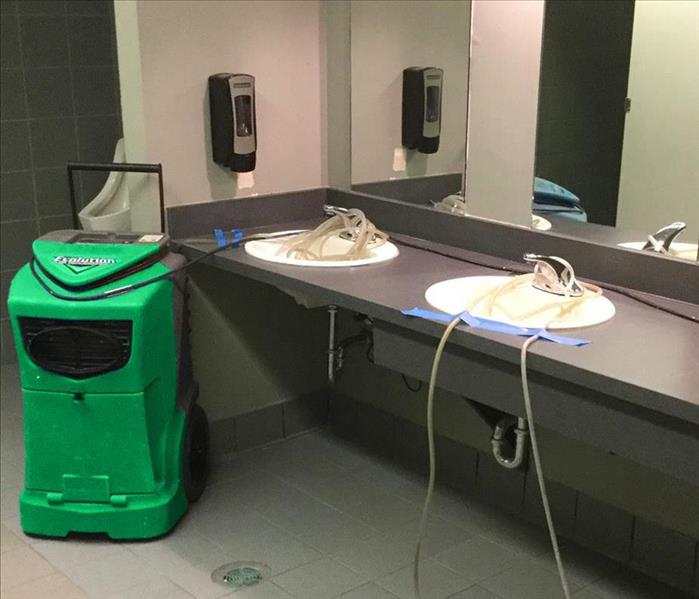 A dehumidifier removes moisture from the air and helps prevent the creation of an environment for mold growth to thrive in.
A dehumidifier removes moisture from the air and helps prevent the creation of an environment for mold growth to thrive in.
What Is a Dehumidifier and What Does It Do?
A dehumidifier is an electrical machine used to extract excess humidity or foul smells from the air. It is also great for mold prevention. Moisture levels in a building come from several things. Improper room ventilation while cooking and drying laundry makes house walls sweat. A room filled with strange odors, humidity, and particles is agonizing for people suffering from asthma or allergies.
Relief from Water Damage and Mold
Busted pipes, leaky roofs, or flooding challenges attracts potentially dangerous mold. If mold spores come in contact with damp or wet spaces, it grows and can potentially become toxic.
Homeowners and Business owners must stay abreast of any water leakages or flooding on the inside of the structure. Renovations due to excess water damage and mold can be costly. A dehumidifier is the best choice if your goal is to put a stop to mold. Mold lurks in damp environments.
A dehumidifier draws in the moist, humid air through an evaporator coil then through a condenser coil. This procedure transforms the previous moist, damp air into warm air. Once the air is warmed, it is then released back into the room while at the same time lowering the humidity within the building.
A significant issue that can occur within a business or housing complex is mold growth. However, when discovered right away, the risk is reduced to minimal. The key to preventing mold is finding where the issue occurred and extracting excess water as soon as possible. Once you locate the leak source, use water removal instruments to dry up the excess water.
The Functions, Pros, and Cons: Dehumidifiers and an Air Exchangers
A dehumidifier is similar to an air conditioner. Air coolers are for circulating cool air into a specific area of a structure. Keep in mind that ideal air circulation calls for fans and windows. It is also good to know that different types of wood or materials react differently to water.
An air conditioner cools the air down but can make for a humid, moist environment. In contrast, a dehumidifier dries the air, making it warmer, plus decreasing the humidity. Conventional AC units remove the moisture by cooling the air.
The size of the unit is essential to ensure the room cools quickly and efficiently. For instance, using a tiny air unit to cool a large area is a waste of energy and will empty your wallet. Switching to an air inverter conditioning system is an energy-efficient alternative to conventional air exchangers.
Window-mounted air exchange units do not always vent adequately. Because air exchangers are typically either on the outside fully or partially, the air travels through a wall vent, then through the evaporator. Finally, in the condenser coil, the warm air shoots outside the structure. Obstructions in a wall-mounted air unit reduce airflow, and the air conditioner unit gets overheated.
Cleaning up the Mess
Some water cleanups and restorations may require pumps and professional drying systems to dry excess water from walls, carpets, and ceilings. Also, be aware that materials do not react the same when they come in contact with water. Warning, if you do not know how to extract excess water from a structure, please call a professional. It is imperative to use the right tools and protective equipment.
A professional will extract and mitigate (remove damaged materials) from the site. A professional uses precision moisture meters and thermal devices to pinpoint where the problem lies. It is crucial to keep in mind that water extractions can run you into thousands of dollars. Professionals require various types of tools for professional water damage restoration.
Air coolers maintain constant humidity levels, therefore preventing mold from forming. Air movers also blast out stuffy smells from a room. Lastly, wall or window-mounted air conditioners are easy to operate. The downside of running an AC unit around the clock, however, is enormous energy consumption.
Water extraction is necessary for massive floods such as busted pipes or natural disasters. However, for a do-it-yourself cleanup, a dehumidifier is an excellent device to get started. Even better, a dehumidifier teamed up with a commercial air mover (fan or air conditioner) works for restoring a severely damaged wet area.
Humidifiers and Air Coolers Working Together
Merging these devices is a quicker and more effective means of restoration. This method ensures that mold will not creep in at a later time. Joining an air mover with a dehumidifier reduces future damages to the structure. When it comes to decreasing moisture levels, air coolers alone cannot measure up to a dehumidifier.
An energy-efficient inverter air system can save about 70% on the next power bill. Note, however, that dehumidifiers use only a tenth of your electric power. Dehumidifiers come with built-in sensors that regulate the fan speed within the defrost system. Like other types of technology, machine technology is ever-changing.
Air conditioners alone eliminate about 18 gallons of water. Excess water causes potentially dangerous mold. Preventing mold is a primary reason people choose this duel system. Whether you choose a conventional, large, or compact dehumidifier depends on the size of the task.
An air conditioner teamed up with a dehumidifier is effective and removes moisture quicker. The main factors in getting efficient air are good circulation, dehumidification, and air purification. For specific spaces, portable AC modifiers have condenser evaporators that pull heat out of an area. These mobile units go where they are needed.
Avoiding Smoke and Fire Damage in Your Business
5/19/2021 (Permalink)
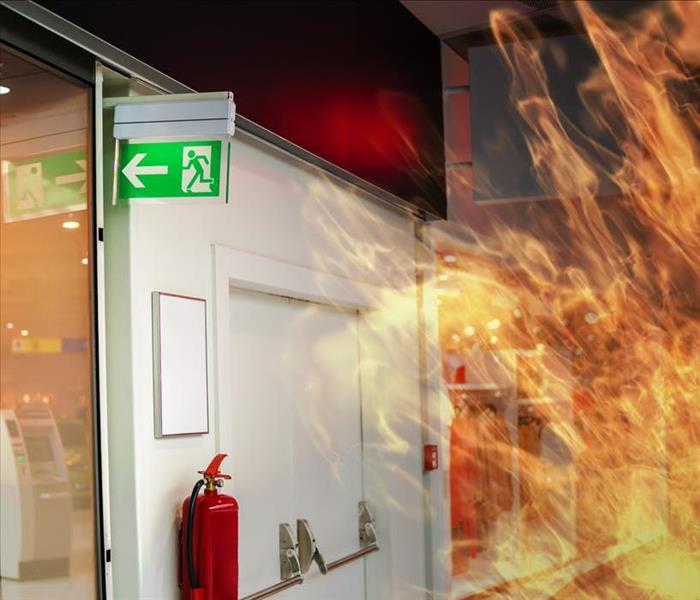 Having fire extinguishers in convenient and designated areas of your business can be crucial in minimizes fire and smoke damage.
Having fire extinguishers in convenient and designated areas of your business can be crucial in minimizes fire and smoke damage.
Smoke and fire alarms are necessary for any business that deals with or is near to a source of the fire. The smoke from a fire can easily be blown away by blowing air, making it harder to contain. A fire alarm system will alert you and your staff immediately, as well as notifying the proper authorities so that you can put off the fire and protect other people's lives.
Fire Safety
Avoiding smoke and fire damage in your business may seem simple enough, but fire safety is an important issue that must not be taken lightly. Your insurance will likely cover some of the costs associated with fire, but you'll still have to pay for the damages to your building. If you can avoid smoke and fire damage in your business, you can save yourself a bundle on your annual insurance premiums. Here are a few of the ways you can avoid damage caused by fires:
When Choosing a Business Location
When choosing a location for your business, you must consider the potential fire hazards your building may have. Many businesses are located near other businesses that have more potential fire hazards. For example, if you're planning to open a hair salon, make sure you avoid a building that's close to a beauty salon. This doesn't mean you can't set up shop somewhere else; it just means that you need to think about the fire hazards of your potential location carefully before you commit to it.
Make the Necessary Preparations
Make sure your building is smoke-free before you allow anyone inside. Any time you're entertaining company, you should keep a fire extinguisher on hand. It might seem easy to keep the extinguisher on a hidden shelf, but too often, small fires can go unnoticed because they're so small. In addition to keeping the extinguisher on hand, make sure any flammable items are out of reach of your guests. This includes anything flammable you might be storing near your business.
Active Fire Alarm System
Of course, the most important step you can take when it comes to avoiding smoke and fire damage in your business is to make sure you have your fire alarm system up and running. If you have an alarm for each room, you will know when the fire alarm is triggered, which means you can get out as soon as possible. If you're unsure which rooms your fire alarms should be placed in, you should consult with a professional fire safety expert. He or she will give you advice about the best place to put the fire alarms.
Avoiding smoke and fire damage in your business can be difficult. No matter how much money you spend on safety equipment, you might still end up with losses. The most effective way to avoid losses is to ensure that every room is equipped with a smoke alarm and fire extinguisher. You should also make sure that everyone knows where the fire exits are to leave the building in an emergency easily. A fire safety sign is another excellent way to minimize losses, as this will alert anyone in the building to evacuate in a hurry should there be a fire.
The Bottom Line
Remember that prevention is always better than cure. Avoiding fire and smoke is only half the battle. It would help if you also learned about fire prevention in your business to know what steps you should take should a fire break out. Many businesses overlook the most basic fire prevention practices, so many fires are caused because no one knows about them. Fire prevention training should be included in your regular training sessions for staff so that you can ensure that all of your employees know how to avoid any fire risks.
How Tropical Storms Can Cause Property Damage
5/19/2021 (Permalink)
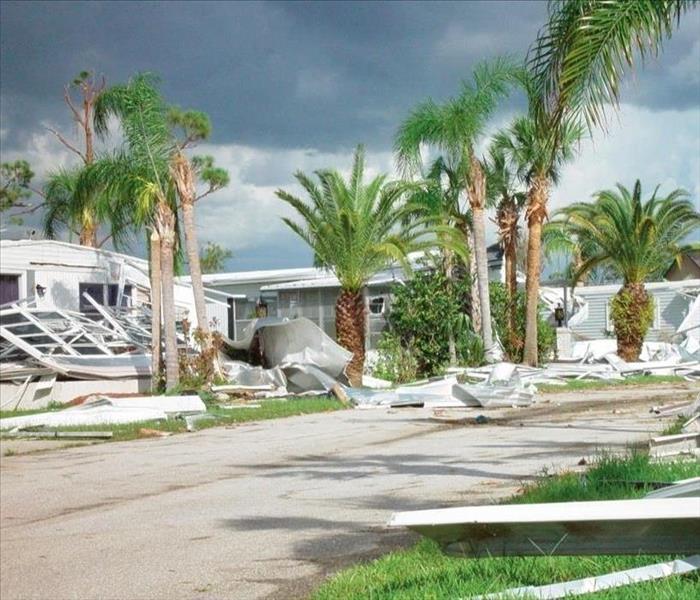 Although not as strong as a hurricane, tropical storms still have the potential to cause extensive property damage.
Although not as strong as a hurricane, tropical storms still have the potential to cause extensive property damage.
Many people across the country watch the news of tropical storms battering Florida. They wonder what the big deal is, because it's just a lot of rain and wind, right?
They've forgotten the damages from the rain and wind of a tornado or other severe storms in their area. Let's examine what property damages are possible from a tropical storm in central Florida.
Property Damages From Rain
Tropical storms deliver rather impressive but torrential rainfall. Rain of over six inches could cause destructive flooding. Flooding of inland properties both commercial and residential is the first big result of tropical storms.
Roof shingles and tiles are not only infiltrated but torn off. This causes ceiling damages in the rooms beneath. Windows could possibly leak with torrential rains. Foundations can be harmed and basements flooded.
Chimneys could take on water. The floor of the room in which the fireplace is located would flood. Gutters could fail under so much rain. This would mean water damages to the walls, resulting in mold and mildew.
Property Damages From High Winds
There's a reason central Florida cities get the evacuations done before the high winds of a tropical storm begin blowing. Persons caught outdoors are urged to get inside before the storm starts. Here's why:
- Flying objects. Anything not tied down or brought inside morphs into a projectile hurled as if by angry gods. Fence rails, lawn furnishings, rakes, shovels, toys, and decorative stones could all crash through the walls of a house.
- Parking barriers, anything in the bed of a truck, and road signs could pierce the walls of a commercial enterprise. It takes a lot for clean-up crews to gather the projectiles and for repairmen to repair the damages done by tropical storms playing catch with commercial and residential buildings.
- Building materials. High winds snatch at things. We've seen fences picked up out of the ground by high winds. Roof tiles, ripped siding, even stone veneers can be snatched out of their resting places and tossed around in the wind.
- Blown away. The higher a building is, the more delight tropical storm winds take in putting their shoulders into it. High buildings can topple. Homes and lower-built commercial buildings have been known to be moved off their foundations by capricious tropical storm winds.
Property Damages From Storm Surge
The record for a storm surge during a tropical storm was in Australia in 1899. The surge traveled 13 miles inland, wreaking havoc along its path. Storm surges can travel up to 30 miles inland.
The problem with storm surges is that it eats away at both the land and buildings on it. Erosion happens to both land and highways. It can undercut the foundations of buildings as well as cause rising waters from local rivers and lakes. As high winds drive deadly rushes of water inland, it's a wise idea to run.
Property Damages From Tornadoes
The fury of movement inside a tropical storm spawns tornadoes. Also furiously moving, tornadoes wreak just as much damage as tropical storm winds and rain. Tornadoes, however, are capricious in the extreme. There's no telling which way they'll turn, how much damage they'll feel like doing, or when they'll exit stage left.
Tornadoes have been known to stomp houses into the ground, pick up mobile homes and deposit them miles away, collapse commercial buildings, snatch up trees and toss them into someone's house or store, take cars out for a spin, and make boats completely disappear.
All this is bad news to those living on houseboats, beach houses, and cabins on the lake. These places aren't only located on coasts battered by tropical storms; they're located inland on lakes and rivers. While there are warning systems in place all over Florida to alert people to the approach of a tropical storm, not everyone wants to give up control of their property to winds and rain.
Final Thoughts
The death toll following these awful storms is worse than the property they damaged. We can replace a house or a store, buy another boat or car, but we can't replace those who died trying to protect their property.
There are companies like SERVPRO of Winter Park that clean up after such a storm. The property can be put back together in time. The most important thing is to preserve the lives of the people owning the property. Heed the warning calls, and then call on the pros to fix everything afterward.
Can Smoke Damaged Clothing Be Cleaned?
5/17/2021 (Permalink)
 Depending on the severity of the damage, there are a few tricks you can apply to remove smoke odor from clothes.
Depending on the severity of the damage, there are a few tricks you can apply to remove smoke odor from clothes.
Can Smoke Damaged Clothing Be Cleaned?
Fire is among the biggest threats to an individual’s property. Its occurrence can damage prized possessions and reduce your house to ashes. In severe cases, victims may be forced to start from scratch. Having comprehensive homeowner’s insurance will not sort you out immediately. The process takes time, and you will need to figure out how to salvage some of your belongings. It will help you save costs while on temporary housing.
The smoke and soot during a fire event can damage your textile. It does not mean that everything will end up in the dumpster. You do not have to get rid of your favorite outfits since there are ways to salvage them. Here are critical tips for cleaning your clothing to rescue your wardrobe during such kind of trauma:
1. Sort out your clothes. The initial thing to do is to sort out what can be repaired from what cannot. Clothes with burn holes will be challenging to salvage; therefore, you will have to do away with them. Once you have identified what can be salvaged, sort them out in terms of fabric and washing instructions. Ensure to keep an eye on clothing accessories like beadwork, buttons, or metal fittings. In case of any damages, replace them with new ones.
2. The following action to take is to consult your insurance provider as soon as you can. It is because the process usually takes a while before you can be fully compensated. Nonetheless, starting early gives you a better chance of receiving your partial payout early, which can help cover basics as you wait to repair your house or permanent replacement.
3. When it comes to cleaning the clothes, get rid of excessive soot from the clothing. Shake off the soot without beating the clothes. Avoid using a brush since its bristles may force the soot deeper into your clothing, making it harder to remove. Instead, use a narrow, high-suction tip vacuum cleaner to get rid of the soot.
4. Once done with the soot, you can start cleaning your clothes. Make sure your dry-clean clothes are handled with professional dry cleaners with experience in smoke-damaged clothing. When handling polyester or cotton, ensure to wash them several times in warm water without any bleaching agent. For the bleach-safe clothing, make sure that you wash them several times in heavy detergent to remove the smoke odor. It is advisable to hand-wash the fire-damaged clothing for the first few washes to avoid your new load of laundry acquiring the smoke odor.
5. If the smoke odor persists, after several washes with household deodorizers, you will need to seek an expert’s assistance. Look for a company that provides quality ozone treatment service to help remove the stubborn smoke odor.
6. Finally, it would be best to contact highly experienced fire-restoration experts like SERVPRO of Winter Park for further advice. You can learn more tips on how to clean fire-damaged clothing and it can save you substantially. They have the appropriate training for restoring fire-damaged clothing and can guide you in doing the right thing.
Condensation on Your Walls and What it Means
5/17/2021 (Permalink)
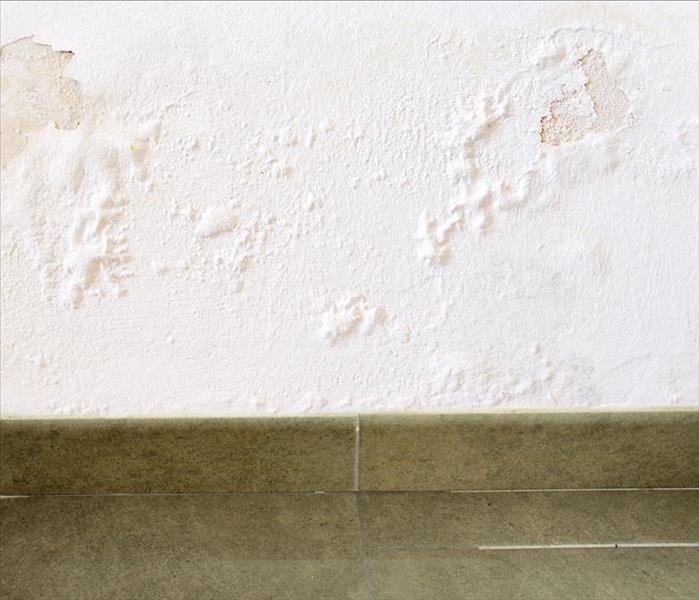 Condensation and moisture on your wall can lead to paint damage, sheetrock damage, and in many cases, mold growth.
Condensation and moisture on your wall can lead to paint damage, sheetrock damage, and in many cases, mold growth.
If there is condensation on your walls, you should do something about it. It may look harmless, but it is dangerous in the long run. Wet walls are a suitable habitat for mold and mildew, which can cause health effects. In addition to that, your walls may get too weak and collapse with time.
Signs of Wet Walls
There are various things you will spot if your walls are damp. For instance, you may encounter some damp, musty odor every time you walk into a room, and yet there is nothing damp in the room. There may also be dark marks on a wall, and the plaster looks discolored. Additionally, you may notice that your wallpaper or paint is peeling off.
Causes
The leading cause of wet walls is condensation. Other causes are leaks and drainage, and damp issues. Below is a breakdown of the causes and what to do about each of them.
Condensation
Condensation appears on your wall when excessive hot air in the house settles on the cold walls and cools, thus turning into water. Excessive air often results from cooking or the shower.
You can employ the following remedies for condensation:
Have An Exhaust System
Install an exhaust system in your kitchen and bathroom to suck out the steam instead of having it waft around the house. You can also ensure you close the door and keep the windows open while showering or cooking. Ensure you cover the pots and pans as the food cooks to prevent too much steam from escaping in the kitchen.
Have A Proper Ventilation System
You need to ensure that there is as much breathing space as possible in your house. This can be as simple as committing to open the windows as often as possible so that hot air goes outside instead of settling on the walls.
Invest In a Dehumidifier
This is a machine that sucks excess moisture out of an enclosed area. It will be a great addition to your home to aid in fighting condensation.
Keep Your House Warm
Try as much as possible to ensure your house is warm. This way, the walls won’t turn cold, and there will be no place for air to condense. Turn on your heating system at regular intervals and keep the fireplace burning if possible.
Hang Your Clothes Outside
When you do your laundry and put it to dry in the house, they release the moisture into the house, and it will inevitably land on the walls. Air it outside instead. If that is not possible, get a tumble dryer or place a humidifier close to the clothes to absorb the moisture. Note that if you choose to get a tumble dryer, you will need to install an external ventilator or get one that is self-condensing.
Leaks
Apart from condensation, leaks can also make your walls wet. These leaks can result from faulty pipes, either due to wear and tear or poor installation. The leaks can also be from the roof because of broken tiles. The water from these places slowly seeps into the wall. Gradually, you will start noticing the signs of dampness on the wall.
The best way to deal with this is to schedule an inspection to identify the source of the leak. Once you figure that out, contact a professional to fix the issue as soon as possible. It is advisable always to inspect your roof for leaks at least twice a year to avoid the risk of water damage. When you ignore leaks, they may cause damage that will cost you more than you would have spent on repair.
Rising and Penetrating Damp
Rising damp is where water seeps into a wall from the bottom. Penetrating damp, on the other hand, is where it seeps into a wall from any source. This can even be a result of a leak. For rising damp, the most effective solution is to fix your drainage system so that water does not come into contact with your walls. You also need to repair the damages brought about by the damp and work on your ventilation.
More Helpful Tips
To prevent condensation, you can also ensure your gutter and downspout system is in perfect condition. Apart from that, if you have lots of houseplants, consider taking a few of them outside. Plants also release moist air, and too much of it may exacerbate your condensation issue.
If the condensation on your walls has already caused molds to grow, get rid of the molds by using mold spray, wiping them down with a wet cloth, or one steeped in diluted bleach. Before you repaint or install new wallpaper, ensure you have completely gotten rid of the wetness on your wall.
Always engage a qualified professional to help you determine the extent of your problem and suggest the best course of action to take.
Conclusion
Because wet walls can result from many different things, be sure to establish the cause before choosing a remedy. Otherwise, you run the risk of fixing the wrong thing, and the problem will keep recurring. Note that it is always best to prevent something than to fix it. So even if you aren’t dealing with condensation yet, you can always put in measures to ensure it does not come up. For more information on condensation and how to deal with it contact SERVPRO of Winter Park.
Why SERVPRO? Our Team Makes The Difference
5/17/2021 (Permalink)
 Aside from services we perform, our team are active member of the community and regularly participate in events like Hurricane Preparedness.
Aside from services we perform, our team are active member of the community and regularly participate in events like Hurricane Preparedness.
When it comes to disaster recovery, we may not be the only restoration company in town, but there’s a reason why so many homeowners and businesses choose SERVPRO of Winter Park to recover from water, fire, mold, or flood damage. The difference is our people!
We invest in our employees
SERVPRO invests in having the best employees in the business. We have always put a high priority on educating our team. That need is more important than ever today. SERVPRO of Winter Park is an IICRC certified firm with certified technicians, which means customers can expect the very highest in standards and protocol to be used in their home or business when disaster strikes.
IICRC training and certification
The Institute of Inspection Cleaning and Restoration Certification (IICRC) certifies and sets the standards for the cleaning and restoration industries and those standards are high. Our SERVPRO professionals study IICRC standards and best practices in water restoration, fire restoration, mold remediation, carpet and upholstery cleaning, and other cleaning and restoration courses so they are well-prepared to handle any disaster in any situation and know how to approach the restoration process quickly and effectively.
Employee certification training
The Employee Certification Training by SERVPRO is a voluntary, self-paced program designed for SERVPRO franchise employees to further their knowledge and training. Certification is awarded after successful completion of course materials and an examination. Modules for training include:
- Crew Training
- Fire Restoration
- Water Restoration
- Advanced Structural Drying
Ongoing, comprehensive training for our crew
Our training program doesn’t stop at just IICRC and Employee Certification Training. We also offer:
- Initial Franchise Training
- e-Learnings
- Continuing Education Classes
From initial and ongoing training at SERVPRO’s Corporate Training Facility to regular IICRC industry certifications, rest assured our staff is equipped with the knowledge to restore your property. If your property suffers water, flood, storm, fire, or mold damage, know that you’re in great hands with the professional SERVPRO of Winter Park team. Our employees make the difference! Contact us 24/7 for restoration assistance at 407-678-5391.
The 2021 Atlantic Hurricane Season Is Upon Us
5/6/2021 (Permalink)
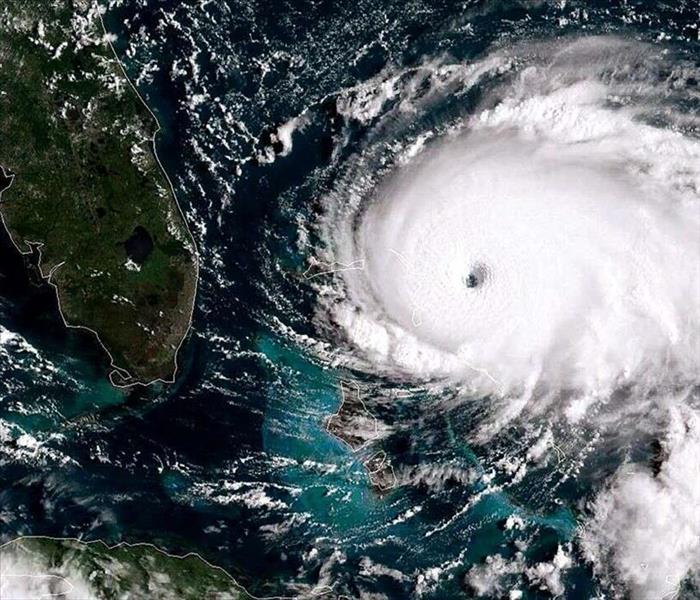 A recent forecast anticipates an above-average probability for major hurricanes to make landfall along the United States coastline.
A recent forecast anticipates an above-average probability for major hurricanes to make landfall along the United States coastline.
2021 Atlantic Hurricane Season Forecast
Predictions so far forecast a milder season than last year, but still a very active one. Reading these predictions for 2021 will give you the ability to prepare.
2020 Hurricane Season
The 2020 Atlantic hurricane season was one of the worst on record. There were 30 named storms, the highest number ever recorded. Meteorologists switched to Greek after exhausting the 21 letters of the English alphabet that are used in naming hurricanes. Also battering the coast that year were an extraordinary 13 hurricanes, with 6 that fell above a category 3.
For context, the average year has 12 named storms, six hurricanes, and three major hurricanes. A storm considered a major hurricane, higher than a category three, will have recorded winds at 115 miles per hour or higher. Category five hurricanes have wind recorded at 157 mph or higher. Comparatively, tropical storms have sustained winds of 73 mph, and regular hurricanes will have sustained winds of 74. The 2021 hurricane season starts on June 1st and lasts all the way until November, and the typical month with the most hurricanes is September--but the strongest ones usually occur in July and August.
Why Are Hurricanes Seasons More Active In Recent Years?
One of the reasons for more active seasons in recent years is global warming. A hurricane is created when high-pressure air combines with low-pressure air over warm waters, heating the moisture in the air. That warm low-pressure air then warms the high-pressure air, and the air begins to rise. As this air rises, it cools off. So in order for a hurricane to form, you need low air pressure, warm, humid ocean air, and wind. This creates the large storm clouds and front characteristics of a hurricane and gives it the steam to continue to build as it moves through warm waters. Hurricanes cool off as the water gets colder, which is why most hurricanes stay in tropical waters.
However, due to global warming, the greenhouse effect is warming waters further still, essentially sending a blast of energy through these hurricanes. Global warming causes not only warmer waters around the equator but increased precipitation and stronger winds.
What To Expect This Year
Various meteorological agencies have already released their forecasts, with NOAA's being the highest at 13-20 named storms and an average of 6-10 hurricanes with 3-5 of them being strong hurricanes of a category 3 or higher. Colorado State also made some predictions, forecasting 17 named storms, eight hurricanes, and four major hurricanes. That would make 2021 the sixth consecutive above-average hurricane season.
Florida
The Sunshine State is always in the spotlight during the Atlantic hurricane season, as the gulf maintains typically warm waters and the panhandle is usually right in the center of the projected paths of storms formed at the equator. Colorado State projects a 45% chance that a hurricane will hit the eastern US coast this season, including the Florida panhandle. The average chance of this in any given hurricane season is 31%, a significant difference. They also project a 69% chance of a hurricane hitting any part of the US coast (average 52%) and a 44% chance of a hit anywhere from the Florida panhandle to the Texas coast (average 30%).
So there is a higher-than-average chance that some part of Florida will see hurricane action this year. In order to understand the probability of where the hurricanes might hit, we can look at the historical records of where hurricanes have hit Florida in the past.
Northwest Florida, situated on the state's panhandle has suffered a total of 66 hurricanes, including 14 over a category 3. Because this region is technically outside the tropical zone, temperatures are lower, which creates that contrast in pressure that fuels warm-weather storms. It is interesting to note that all of the category 4-5 hurricanes that hit northwest Florida occurred after 2018; between 1815 and 2017, all of northwest Florida's major hurricanes were category 3.
The second-most hit region of Florida is the southeast with 44 hurricanes on record. This area of Florida has endured seven category 4 hurricanes, as many as the entire state of Texas.
Northeast Florida has had 26 total hurricanes, making it third on the list. The safest areas in Florida are the most inland because hurricanes nearly always lose steam and energy when they hit land, and the more inland an area is, the more time the hurricane has to cool off. This is why coastal areas typically suffer the most damage.
As you can see from these statistics and predictions, elevated hurricane seasons are not likely to calm down--although we may see a less turbulent season than that of last year. Northwest Florida is likely to see the most action, with the Southeast second-most likely. Depending on where you live, these statistics can help you prepare for this year's hurricane season.
2021 Hurricane Names
5/6/2021 (Permalink)
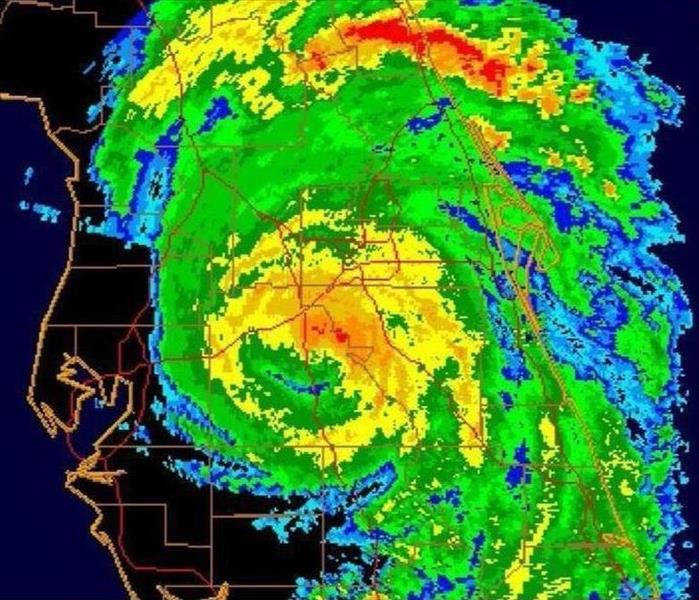 Some hurricanes have their names remembered much longer like Hurricane Charlie that ravaged Florida in 2004.
Some hurricanes have their names remembered much longer like Hurricane Charlie that ravaged Florida in 2004.
Hurricane Names for the 2021 Season
Although a hurricane or tropical storm isn't confined to certain dates on the calendar, June 1 through November 30 is considered Atlantic hurricane season. In advance of this season each year, the World Meteorological Organization releases the list of names to be used on tropical storms and hurricanes that year. This list goes in alphabetical order and alternates between male and female names. The lists feature 21 names, with the other five letters of the alphabet being skipped for a lack of available names associated with those letters. Each of the lists is used on a rotating basis every six years to simplify the naming process. This means that the list used for the 2021 season is the same as that used in the 2015 season.
The only changes made to the list are retired names. Storm names are occasionally retired when a tropical storm or hurricane is especially costly to an area or deadly, as using the name again is considered insensitive. For example, Hurricane Joaquin slammed the Bahamas in 2015, causing 34 deaths while Tropical Storm Erika rolled over the Antilles and caused 31 fatalities. These two names were retired from the list in 2015. Other notable names that have been retired over the years include Katrina, Harvey, Irma, Ivan, and Stan. The letter I leads the list in the number of names retired from the list at 11, followed by nine each for C and F.
During a particularly active tropical season, this list of names may be all used up, in which case an extra list is used for backup. This backup list used to be based on the Greek alphabet but is now simply another 21-name list following the same male and female rotation.
The list for 2021 features the following names:
1. Ana
2. Bill
3. Claudette
4. Danny
5. Elsa
6. Fred
7. Grace
8. Henri
9. Ida
10. Julian
11. Kate
12. Larry
13. Mindy
14. Nicholas
15. Odette
16. Peter
17. Rose
18. Sam
19. Teresa
20. Victor
21. Wanda
Cupping, Peaking, and Buckling Wood Floors
5/6/2021 (Permalink)
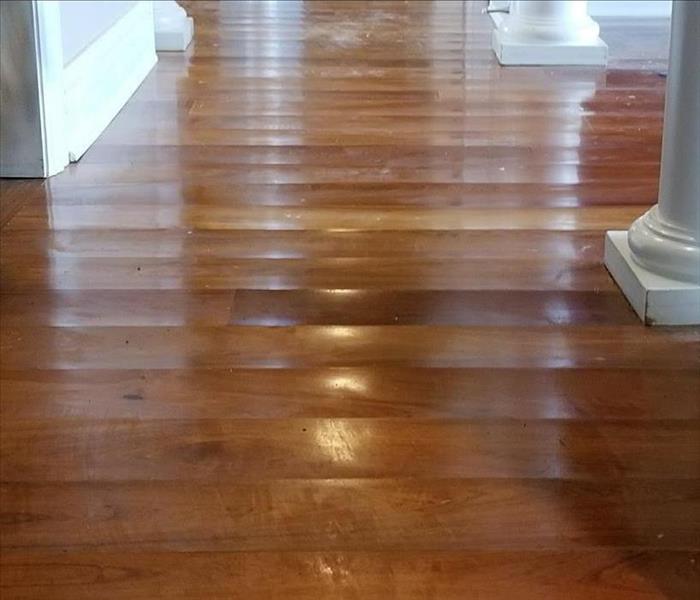 Cupping is the result of an increased moisture content that saturates the bottom of the boards.
Cupping is the result of an increased moisture content that saturates the bottom of the boards.
Wood Damage from Water, Age, or Installation
Having wooden floors or engineered hardwood flooring can be a challenge even when things are going well. It is strongly advised people who want this type of flooring have a professional install them. Wooden floors and engineered hardwood flooring can develop issues that may alter the appearance and shape of the wood. There are more things to be concerned with in addition to water damage when caring for wood floors and engineered hardwood flooring. The most common problems are buckling, peaking, and cupping.
Moisture Damage
Even if someone's floors experience moisture damage, there won't be any need to replace the entire floor. Buckling, crowing, and cupping is used to describe the warping as well as damage experienced by engineered hardwood flooring and wood floors. These conditions are caused by changes in humidity, moisture, groundwater, and more.
Humidity And Moisture
People want wood floors and engineered hardwood flooring because of the improved appearance they provide in any space where they are placed. They are also known for being sensitive and delicate. Warping and disfigurement can occur from humidity and moisture. It may be possible to control the humidity of a home. Moisture can still become an issue even if a home has no problems with flooding or leaking pipes.
Relative Humidity
The air in any space inside an enclosed area will have humidity. There will always be water vapor in the air unless it measures zero. Over time, the wood in a home such as the doors, walls, and floors will adjust to the humidity levels. It will reach equilibrium. This is why it is common to hear a house settle. The floorboards will creak when experiencing weather that disturbs the equilibrium. When a home experiences extreme changes in the moisture, it will cause the floorboards to warp.
Buckling
This can happen when floorboards aren't given the opportunity to adjust to the climate in a home. This will occur when a person notices floorboards pulling away from the sub-floor. The floorboards bow inward. They may also come right off of the floor. This could also be the result of poor installation. The newly installed wood has to have room to contract and expand and adjust to changing humidity levels and temperatures. If the floorboards don't have enough space, they will buckle.
Peaking
This is an expansion issue. The main reason this happens is problems with the installation. Wooden floors are regularly contracting and expanding based on the humidity level in a home. The weather and temperature also play a role. This should be a consideration during the installation process. It is important for there to be the proper space between each floorboard as well as space between the flooring and the walls. If this isn't done, the wood won't be able to properly expand. There won't be any room for the wood swelling. This will result in peaking.
Cupping
This occurs when excessive moisture impacts the underside of floorboards. The surface of the boards will seem to be cupping and have a concave shape. The side of the boards will be higher than the middle of the boards. They will bow inward. Engineered hardwood flooring and wood floors can experience cupping. This is different from other types of damage because of the location of the moisture damage. The bottom of the boards becomes saturated with moisture. This situation can occur over a few days. The reason for it is probably underlying water damage. This could be part of a serious problem like leakage and groundwater. It is something to be resolved by a professional plumber. It is also possible for boards to cup because of too much water vapor in the air. The boards will then warp much slower. This is a challenge to detect since there will be no immediate changes.
Repairing Common Issues
When it comes to cupping, it is possible to repair it by sanding the floor. This will make the boards even. Before sanding the floor, it needs to have enough time for the moisture content to return to normal. Should this not be done, it can cause peaking. When the boards are bent upward, sanding shouldn't be done. It is possible to spot treat places that buckle or peak. The boards that have been affected can be removed and given time to dry and then replaced.
People don't have any real control over unexpected moisture issues. Damage can result from unexpected flooding as well as leaking pipes. It's also not possible to do anything about the moisture or humidity in the air. The floorboards of wooden floors or engineered hardwood flooring can be protected by covering them with a sealant product. It is also recommended to have a dehumidifier running in rooms where hardwood floors or engineered hardwood flooring is located. This will take out the dampness or high humidity that is present.
10 Dirtiest Places in the Office and How to Clean Them
5/5/2021 (Permalink)
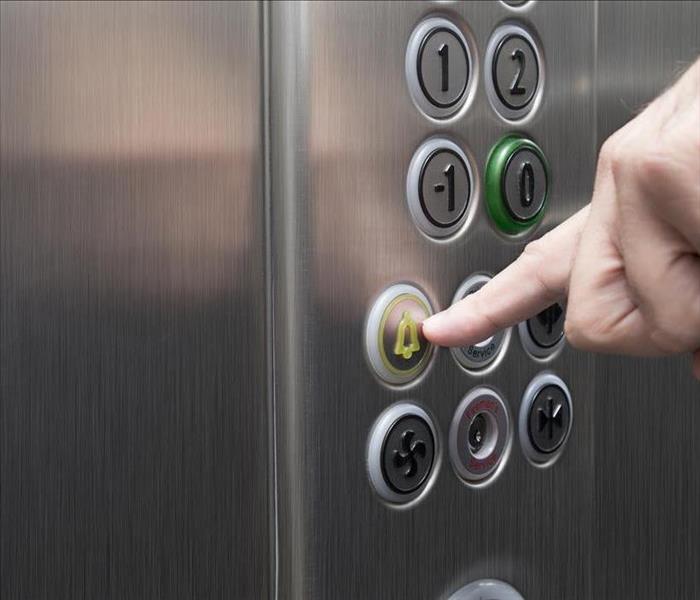 Research shows the average elevator button has 40 times as many bacteria as a public toilet seat.
Research shows the average elevator button has 40 times as many bacteria as a public toilet seat.
The COVID-19 pandemic has many business owners and building managers reassessing the cleanliness of workplaces and making changes to create cleaner, more sanitary spaces. Although research indicates that the coronavirus that causes COVID-19 isn’t transmitted via surfaces, that doesn’t mean there aren’t other dangers lurking in offices that need to be addressed.
Certain areas of any workplace are dirtier than others. Even when they look clean, many of these spots harbor harmful bacteria, viruses, and fungi that can cause health effects — not to mention attract pests and contribute to lost productivity.
Employees bear some responsibility for keeping their work areas clean and sanitary, but management also needs to address the bigger picture of sanitation and cleanliness in shared commercial spaces.
The Dirtiest Spots in Any Office
As more employees return to work during the COVID-19 pandemic, keeping the following often-dirty areas clean and disinfected needs to be a priority.
1. Elevator Buttons
How many people use the elevator in your building every day? Every one of them touches several buttons in the process, calling the elevator, choosing a floor, and opening or closing the door. With so many fingers touching the buttons throughout the day, it’s no wonder they make the list of the germiest surfaces in the office. Research shows the average elevator button has 40 times as many bacteria as a public toilet seat, including E. coli, Staphylococcus aureus, and methicillin-resistant Staphylococcus aureus (MRSA).
Wiping the buttons after every ride is impractical, but they should be cleaned and disinfected at the end of every day. Encourage people to wash their hands or use hand sanitizer after pushing the buttons as well.
2. Desktops
The average desktop has 400 times as much bacteria as a toilet seat. Every square inch can contain more than 20,000 viruses, bacteria, and fungi. Not all of the germs on your desk are harmful, but not cleaning and disinfecting your desk can encourage infectious germs to spread.
Keeping your desktop sanitary starts with washing your hands throughout the day, especially after touching shared surfaces. Coughing or sneezing into your elbow and throwing away used tissues or napkins also stops the spread. Before you leave for the night, wipe down your desktop, including your keyboard and computer mouse, to kill any germs and start the next day with a clean slate.
3. Electronics
Both shared and personal electronics can harbor germs that spread illness. You touch your phone and computer keyboard more than any other surface in your office. Your phone is the second most germ-filled spot on your desk, after your coffee cup, simply because you touch it so many times a day and it collects saliva while you talk. And your keyboard? That contains about 700 germs per square inch.
Shared equipment like photocopiers, fax machines, and printers also collect germs from multiple users throughout the day. Just think about how many times the “copy” button is pressed during a typical day. Unfortunately, shared electronics are often neglected when it comes to cleaning, making them a common source of illness outbreaks.
Wiping down your computer with electronics-friendly disinfecting wipes can reduce the germs in your workspace. Keeping some near shared equipment may encourage others to clean buttons and surfaces as well. Asking your cleaning service to pay attention to those shared items when cleaning can also help keep spaces sanitary.
4. Kitchen/Break Room
All surfaces in the shared kitchen should be disinfected daily. However, employees should also be responsible for cleaning up after themselves. Food waste should be properly disposed of to prevent pests, crumbs, and spills wiped off of counters and tables, and dishes washed or put in the dishwasher. At the end of the day, run the dishwasher on the sanitize cycle to ensure any shared dishes or utensils are cleaned.
Sponges should also be replaced often, ideally weekly. The moist environment allows harmful bacteria like E.coli and salmonella to grow, and when dirty sponges are used to clean other surfaces, that bacteria can spread. The garbage can might also harbor bacteria from food waste, which increases odors, so daily bag replacements and weekly deep cleaning are necessary.
5. The Coffee Maker
The coffee maker is one item in the kitchen that deserves special attention since it’s likely to be the most touched surface in the entire office. The pot handle is most likely to collect germs, but the pot and maker should also be cleaned to eliminate bacteria.
Coffee makers are common culprits for spreading harmful bacteria because they provide a warm, moist environment that supports bacterial growth. A 2011 National Sanitation Foundation study found that 50% of coffee makers contain mold or yeast, which can cause health effects. Although many models are self-cleaning, a weekly cleaning with vinegar gets the coffee maker squeaky-clean and germ-free.
6. Bathrooms
Just like at home, bathrooms at the office are germ hotspots. Multiple people touch toilet and sink faucet handles, the door, and other surfaces, and not everyone washes their hands properly after using the toilet. Daily cleaning and disinfecting are a must for restrooms.
So many people using the same bathrooms also increases the risk for clogs and backups. A sewage backup causes serious contamination that should only be cleaned up by professionals who have the correct equipment for doing so. Sewage is full of bacteria like E.coli that can cause serious illness, and unless they have the proper safety gear, employees should be restricted from the area until it’s fully cleaned.
7. Door Handles
Like elevator buttons, door handles are touched by multiple people throughout the day and collect germs in the process. Encourage people to wash their hands or use hand sanitizer after touching door handles, and wipe them down with disinfecting wipes at least once a day. Your cleaning company should also make cleaning all door handles a priority, especially entrance and exit doors and bathroom doors.
8. Water Cooler
The water cooler might be a popular gathering place, but the handle and spigot can harbor germs that are more harmful than any company gossip. Employees often fill their personal glasses or water bottles at the cooler without washing them in between uses, which spreads germs, and touch the handle several times a day.
Providing disposable cups for water can reduce some of the germs, but water coolers should be cleaned and disinfected with wipes daily to reduce spread. During cold and flu season, encourage employees to get water from the faucet or bring bottled water from home instead of refilling at the cooler to limit the spread of illness.
9. Vents and Ducts
HVAC vents and ducts collect all manner of dust, allergens, and debris as air flows through. Although well-maintained HVAC systems typically don’t have too many problems, over time, the ducts and vents can collect contaminants that affect air quality. Dirty air can lead to a host of problems for employees, from headaches and fatigue to respiratory conditions, so regular professional vent cleaning is necessary.
10. Curtains & Blinds
Window coverings like curtains and blinds can gather dust, as well as harbor bacteria and viruses that spread through the air. If they aren’t cleaned, these contaminants can affect indoor air quality and contribute to respiratory issues, especially for those with allergies or asthma. Window treatments can also collect odors, keeping your office from smelling fresh.
Having blinds and curtains professionally cleaned regularly can help keep this from happening. A thorough cleaning typically involves removing the window coverings, accessing hard-to-reach areas, and the curtains themselves may need to be dry cleaned or laundered — that’s why this is a job best left to the pros. However, the payoff is clean, fresh-smelling air.
Why Is a Clean Office Space Important?
Maintaining a clean and sanitary office is important to your business for multiple reasons. These include:
- Improved appearance and first impressions from customers and vendors.
- A safer environment for workers with reduced risk of accidents or injuries.
- Improved productivity.
- Fewer sick days due to illnesses spreading between employees.
- Improved air quality.
- Improved employee morale.
Although employees play an important role in keeping their workplace clean, they shouldn’t be responsible for overall building maintenance. For deeper cleaning and disinfecting, as well as significant cleanup jobs involving major damage, working with a professional cleaning company is a must.
Why Industrial Hygiene Is Important for Your Business and Employees
5/5/2021 (Permalink)
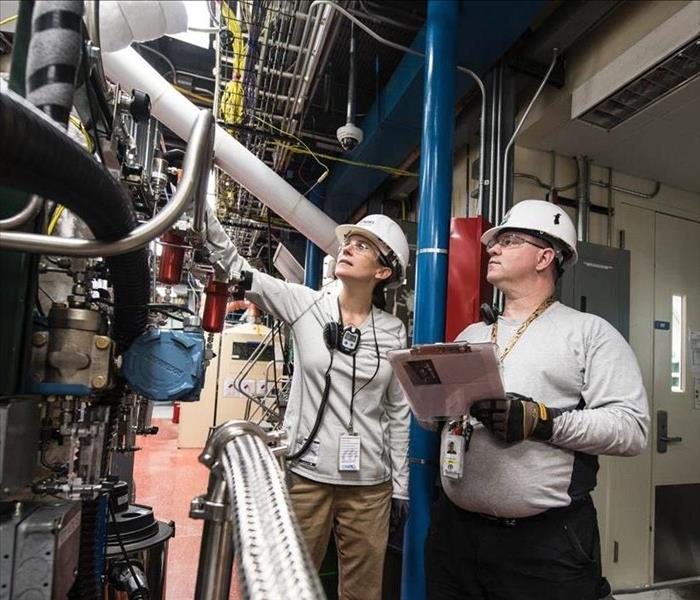 Localized ventilation systems can remove air contaminants before they can compromise workplace air quality.
Localized ventilation systems can remove air contaminants before they can compromise workplace air quality.
No matter your business or place of work, industrial hygiene — the protection of all employees’ health and safety from chemical, physical, and biological threats — is critical for short- and long-term corporate success.
To ensure that employers are taking necessary steps to defend employee health and wellness, industrial hygiene is regulated by The Occupational Health and Safety Administration (OSHA), a U.S. government body dedicated to perpetuating workplace safety. OSHA industrial hygienists make up more than 40% of all OSHA compliance officers, helping to enforce hygiene standards in evaluating jobs and places of business for a wide range of health hazards.
Benefits of Good Industrial Hygiene
Industrial hygiene standards are put into place to ultimately protect workers and their communities. Businesses that implement positive industrial hygiene can receive a wide array of associated benefits.
These benefits can include:
- Healtheir employees;
- Fewer substantiated healthcare costs to be covered by employers;
- Enhanced in-office task efficiency;
- Educated workers who now help to independently eliminate hygiene risks;
- Reduced employee absenteeism — which can cost employers $3,600 per year, per employee;
- Improved morale across the workplace.
Workplaces can directly impact the health and the output of the workers who frequent them. Both employers and employees can stand to benefit from correctly-implemented industrial hygiene practices, positively influencing productivity and overall wellness.
Major Industrial Health Hazards
A risk-free workplace can benefit employee competence and morale alike. Just as easily, a workplace characterized by even one preventable industrial hazard can quickly compromise a worker’s ability to perform tasks to the best of their ability.
Given the strong influence of a workplace on its employees, it's critically important that workplace hazards are correctly identified and quickly minimized. Consult the individual hygiene aspects below, alongside examples of real-life threats to workplace safety and steps all employees can take to minimize them.
Air Contaminants
Common air pollutants and contaminants are often one of the biggest culprits for poor overall air quality. Whether criteria pollutants, air toxins, or biological pollutants, air contaminants like carbon monoxide and lead represent one of the largest threats to immediate employee safety in the workplace.
According to the Environmental Protection Agency (EPA), air contaminants can even change the way the body works, potentially compromising organ functionality as they make their way through the skin, bloodstream, and digestive system. Over time, extended exposure to air contaminants in the workplace can also lead to accelerated lung aging, damaged respiratory system cells, and the development of diseases like asthma, bronchitis, and cancer.
Fortunately, the prevention of air contaminants in the workplace is made easier when you schedule regular air duct and HVAC cleaning. Keeping ducts clean can extend equipment life, and can have a very real, positive effect on the quality of the air that employees breathe every day.
Chemical Hazards
Industrial hygienists examine workplaces for a wide range of potential chemical hazards, given how quickly chemical misuse or negligence can lead to serious risk. From exposed flames and exhaust, potential explosives, and decaying organic material to smaller issues like battery corrosion, chemical hazards are often unnoticed before yielding serious issues for all employees.
As expected, even short or occasional exposure to chemical hazards can result in negative health consequences. These can include impaired physical development, permanent organ damage, pregnancy complications, and difficulty breathing after accidental chemical ingestion.
If a chemical spill is threatening industrial hygiene at your place of business, a reputed chemical cleanup service often represents the fastest, most secure solution. Seek help from chemical cleanup specialists trained in decontamination protocol and federally-mandated safety standards.
Biological Hazards
Sometimes, removal of biological hazards is as simple as effective mold remediation. Other times, your workplace situation may call for a full-scale virus response. Whether you’re facing a bacteria outbreak, mold, or even exposure to potentially contaminated animals, biological hazards are often overlooked before jeopardizing industrial hygiene.
The serious nature of many biological hazards often means calling in professionals. Fortunately, biohazard cleanup and restoration services can help expedite the cleaning, sanitizing, and disinfecting stages in the biological hazard removal process, returning employees to work as soon as the workplace — and its highly-used items like doorknobs, keyboards, and light switches — are sterilized and confirmed as safe.
Physical Hazards
A physical hazard is present any time an employee’s environment can harm the body, even without contact. Physical threats can include radiation, extreme temperatures, and noise. Fortunately, employees can often perceive the risk of physical hazards when near, and can always take steps to remove themselves from potentially risky situations.
In extreme cases, fire can also represent an uncontained threat to industrial hygiene and immediate safety. If a fire has devastated your place of business, fire damage restoration services can help restore your space and eliminate any remaining threats to industrial hygiene.
Ergonomic Hazards
At work, repetitive or strenuous movement can represent a serious threat to overall safety. Ergonomic hazards can include improper lifting techniques, sudden or awkward movements, and poor posture when sitting or standing.
Widely regarded as the most difficult type of industrial hygiene violation to identify in the workplace, ergonomic hazards can yield everything from sore muscles to long-term ligament damage and illness.
OSHA has even taken steps to distribute an ergonomic hazards workbook to employees — one that outlines risk factors like a musculoskeletal disorder — to promote education and action while protecting the body at work.
Recognizing and Controlling Hazards
The promotion of industrial hygiene standards at work begins when employers take steps to reduce employee exposure to occupational hazards. Businesses are responsible for the safety and well-being of all employees during work hours, and should adopt practices that prioritize safety over output.
Reference the below strategies available to any employer, to help them recognize and control potential hazards in the workplace.
Engineering Controls
One way to effectively control hazards in the workplace is to design the solution into the workplace itself. Known as engineering controls, these strategies are designed to minimize industrial hygiene issues through the proper design, creation, and use of company property.
Engineering controls are also implemented when employers and employees alike take steps to put barriers between themselves and potential hazards. For example, localized ventilation systems can remove air contaminants before they can compromise workplace air quality. Despite higher initial costs, engineering controls can help eliminate potential industrial hygiene issues before they even exist.
Work Practice Controls
Another way to reduce potential industry hygiene issues is by changing the way that tasks are performed. Work practice controls are especially useful when current practices place employees, employers, or their workplace at risk for potential hazards.
To implement work practice controls, employers should review and revise workplace habits and standard operating procedures for maximum risk aversion. This can mean eliminating workplace smoking, upgrading your commercial cleaning provider, and mandating sufficient handwashing practices before employees return to work. Quality building and reconstruction services can help businesses considering larger-scale work practice controls.
Administrative Controls
Shifts in official policy, employee training, or other high-level procedures are considered administrative controls, to reduce occasions where employees meet industrial hygiene risks in the workplace.
Many businesses regularly refresh employee manuals and update policies, which will make implementing administrative controls easier to achieve. These controls come directly from business administration, and involve policies that help employees avoid toxic hazards, potentially harmful repetitive motions, excessive temperatures, and other potentially dangerous workplace situations.
7 Benefits to a Clean Work Environment
5/5/2021 (Permalink)
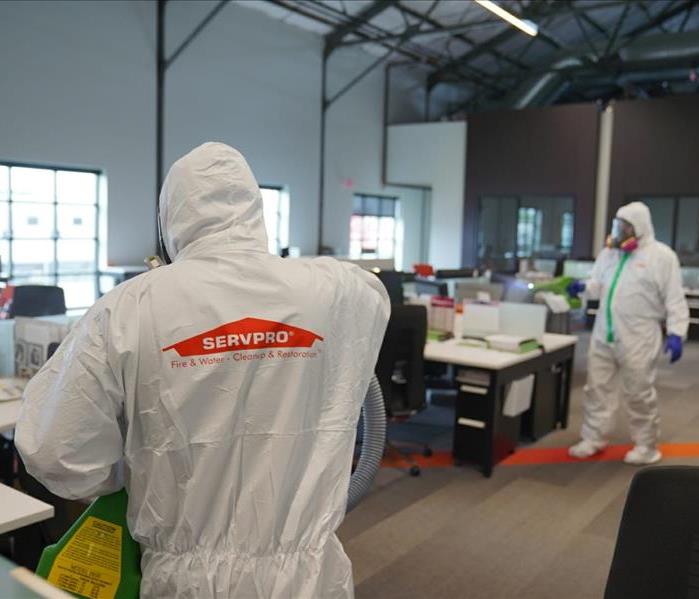 As a result of the COVID-19 pandemic, the need to keep workspaces and offices clean has become a significant priority.
As a result of the COVID-19 pandemic, the need to keep workspaces and offices clean has become a significant priority.
The Importance of a Clean Office
The COVID-19 pandemic has changed many aspects of everyday life; one of the most noticeable is the renewed focus on hygiene and cleanliness. With everyone focused on washing their hands and sanitizing surfaces, the need to keep workspaces and offices clean has become a significant priority.
The Worldwide Cleaning Industry Association (ISSA) estimates the cost of unclean workspaces is well over $200 billion annually, in large part due to lost productivity caused by illness and accidents. Investing in professional cleaning and developing employee policies and procedures related to cleanliness can go a long way toward the success of your company and the overall wellness of your workers.
Consider these benefits of a clean work environment when creating your plans.
1. Fewer Sick Days
Many employee illnesses can be directly linked to the conditions in their workplace. In one study, researchers investigated how quickly a virus spreads in a workplace. They inoculated several workers with a benign virus, and within four hours of the start of the workday, found the virus on more than half of the surfaces in the office. Also, half of the previously uninfected employees tested positive as carriers. Other research has shown that the average desk carries more bacteria and viruses than a toilet seat and that bacteria can easily spread to shared surfaces including doorknobs, elevator buttons, coffee makers, and office equipment.
Although not all viruses and bacteria carry illness, enough do that keeping surfaces clean needs to be a priority for preventing the spread of illness throughout the office.
There’s a pretty obvious correlation between illness and sick days — in fact, the Integrated Benefits Institute reports that the average employee takes 2.9 sick days per year. In a business with 100 employees, that amounts to nearly 300 days of lost employee productivity. While keeping the office clean may not prevent all employee illness, reducing the presence of harmful germs will undoubtedly help.
2. Improved Air Quality
Air quality is often overlooked when evaluating the cleanliness of a workspace, but it’s a vital component in employee comfort and overall health. Poor indoor air quality is closely tied to a host of issues, including issues with concentration and focus, headaches, and fatigue. Dirty air can also cause eye, nose, and throat irritation, and is linked to increased symptoms of respiratory conditions like asthma.
The Occupational Health and Safety Administration (OSHA) notes that poor indoor air quality has several potential causes, including poor ventilation and HVAC issues that limit fresh air intake. Cleanliness inside the building can also have an impact. Dust and allergens in carpeting or on surfaces or hidden mold can affect the air quality and cause health effects.
Investing in deep cleaning or mold remediation can lead to measurable improvements in air quality, increasing your employee’s well-being, reducing sick days, and increasing productivity. And while OSHA doesn’t have specific standards regarding air quality, it does have regulations relating to specific contaminants. Making cleaning a priority ensures compliance with these standards, reducing the risk of sanctions or liability.
3. Increased Productivity
A clean workplace doesn’t just keep employees at work; it actually helps them be more productive. Studies show the average person wastes 2.5 days per year looking for lost items. From pens to files, a messy workspace makes it difficult to find what you need when you need it. It also increases the chance of damage to important items: A spilled cup of day-old coffee can wreak havoc on electronics or important paperwork.
Spending a few minutes to straighten up and organize a work area reduces this lost time and protects important equipment and information. It also allows for surfaces to be cleaned and disinfected instead of allowing germs to spread, keeping everyone healthy.
4. Safer Workplace
Compared to dangerous jobs like logging or commercial fishing, working in an office is relatively safe. Still, thousands of people are injured at presumably “safe” jobs every year, often due to messy workplaces.
Many workplace injuries are slip or trip and fall accidents. Workers slip on wet floors or trip over hazards like cords or items left on the floor. Other common injuries include getting hit by objects falling off of shelves or tables, or injuries due to poorly maintained furniture.
Keeping workspaces clean and neat can prevent many of these accidents. Employees should be expected to wipe up or report spills and correct any hazards that may lead to injuries. Professional cleaning also helps ensure floors remain in good condition, reducing the risk of hazards that can cause a fall.
5. Makes a Good First Impression
Visitors may assume the condition of your business reflects the quality of your products or work. In fact, business cleanliness is a significant factor in customer preference, spending, and likelihood to return. ISSA reports that 94% of customers wouldn’t return to a restaurant if the bathrooms were dirty, and that cleanliness is the leading factor for customers when deciding where to shop. A clean environment also encourages customers to buy more: 60% of survey respondents noted that they buy more when a store is clean, well-lit, and pleasant.
6. Happier Staff and Visitors
Making a good first impression is only the first step. Keeping customers and staff happy also matters. Clutter and dirty spaces can have a detrimental effect on mental health; studies show that messy and overflowing spaces can create feelings of being out of control and anxiety, and can disrupt focus.
A dirty workplace may also cause tensions when employees are worried about germs or getting sick. Keeping the office clean can help these negative feelings and help employees feel more comfortable.
7. Relieves Stress
Coming to work and seeing a desk overflowing with papers, empty coffee cups, and other mess may contribute to feelings of stress or anxiety. And that cluttered and dirty environment can make it challenging to focus.
Researchers have found that a mess — whether a sink full of dirty dishes, a dirty floor, or just too much “stuff” piled around — interferes with our brain’s neural processing abilities. In short, your brain is so clogged by excess stimulation that short-term memory suffers, and it becomes more challenging to process information. This contributes to overwhelming feelings of stress, which can be prevented with a clean and tidy space.
Office Cleaning Tips
Keeping the office clean doesn’t have to take a great deal of time and effort. If everyone contributes to the effort, it’s possible to keep the space clean and healthy. These tips can make the process even easier.
- Invest in a professional cleaning service. A commercial cleaning service is a worthwhile investment. Even if cleaners only come in on a weekly or monthly basis, they can tackle big jobs or areas that employees can’t do daily. Professionals have the correct equipment and methods to thoroughly clean and disinfect surfaces and floors, and to ensure that often-overlooked areas like ceilings and walls are sparkling clean.
- Keep cleaning supplies handy. Make it easy for employees to manage small cleaning jobs by making supplies like disinfecting wipes, paper towels, and dish soap accessible. Even if you have a cleaning service, a broom and small vacuum allow workers to clean up minor spills right away before they become hazards.
- Discourage employees from eating at their desks. There are many reasons eating at your desk is a bad idea, and cleanliness is one of them. Encourage people to eat in the break area or outdoors instead, to prevent spills and leftover food that create messes. Leftover food or food in personal wastebaskets can cause odors, and attract pests, creating additional hazards.
- Assign daily cleanup tasks. Employees should be expected to keep their own work areas clean, but common areas are everyone’s responsibility. Develop a rotating schedule for everyone to contribute to cleaning shared spaces like conference rooms, waiting areas, and the break room. A list of tasks that can be checked off helps keep everyone accountable and the space clean.
- Allow time for cleaning. Some businesses schedule time for tidying and cleaning at the end of the day to ensure it gets done. Encourage your team to build 10-15 minutes into their schedule at the end of the workday to spend putting work away, wiping surfaces, and taking out the garbage.
7 Restaurant Health Code Violations and How to Avoid Them
5/5/2021 (Permalink)
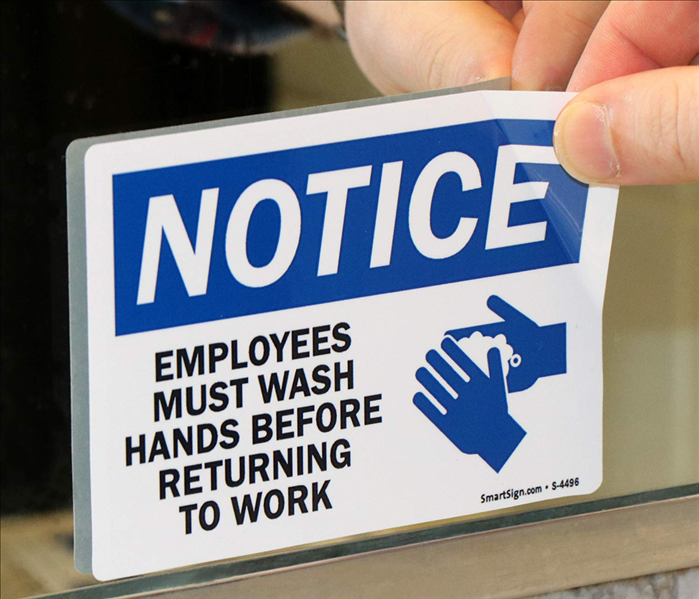 Restaurants are encouraged to maintain quality personal hygiene. Insufficient hand-washing is a common cause of health code violations.
Restaurants are encouraged to maintain quality personal hygiene. Insufficient hand-washing is a common cause of health code violations.
Any business or organization responsible for foodservice is subject to regular inspection. Health code inspections ensure that state and federal food-management guidelines are met, to keep restaurant employees and guests safe.
Restaurants found to be in violation may face penalties until problems are resolved. Some issues can be fixed by restaurant owners or managers on the spot, while other, more serious violations require a follow-up inspection to confirm changes have been made in adherence with regulations.
In most circumstances, restaurants are also subject to penalties of a varying degree, depending on the severity of the infraction. Reference some of the most common restaurant health code violations below, alongside suggestions for how to avoid each.
1. Poor Personal Hygiene
Restaurants are encouraged to maintain quality personal hygiene, behaviors that can help eliminate the spread of potential disease and keep food and surfaces clean for use. Following personal hygiene standards established by the U.S. Food & Drug Administration is important for the protection of all restaurant guests and employees. When restaurants fail to accommodate these standards, they risk incurring a health code violation and further penalties.
Common Mistakes:
- Insufficient hand-washing techniques;
- Wearing intrusive jewelry, like rings or watches, while at work
- Use of the wrong sink for personal cleansing;
- Missing hairnets from restaurant staff members on food lines;
- Exposed employee meals in places of work.
How to Avoid a Personal Hygiene Violation
Restaurants that foster proactive habits in staff members can work to avoid personal hygiene health code violations. Specifically, restaurant owners and managers should regularly update staff members on the newest sanitation best practices, and gauge feedback on how well the restaurants accommodate current cleanliness standards.
Providing staff members with a straightforward personal hygiene checklist — including basic tasks that include wearing a hairnet, hand washing, and cleanliness checks — can go a long way toward preventing personal hygiene violations as a team.
2. Poor Kitchen Sanitation
As far as the general cleanliness of the kitchen goes, kitchen sanitation includes the washing of all commonly-used kitchen areas, surfaces, tables, and other areas frequented by guests or restaurant staff members. Without adequate kitchen sanitation, dirty areas become ripe for mold and other infectious agents, making attention to detail important when it comes to cleaning.
Following standard kitchen sanitation practices can help your restaurant reach long-term success. Just as easily, poor kitchen sanitation can lead to violations, fines, and the eventual closure of your business.
Common Mistakes:
- Collections of mold, mildew, or residue in the corners or along the bottom of food storage containers, ice bins, and other receptacles;
- Unaddressed grease on commonly-used utilities;
- Sticky or neglected soda fountain machines, particularly nozzles;
- Adopting incorrect mold remediation practices, that can make your situation worse;
- Incorrect, or incomplete, sanitation of utensils or dishware;
- Rotting food.
How to Avoid a Kitchen Sanitation Violation
One of the first steps in avoiding a kitchen sanitation health code violation is securing regular mold remediation services from a quality provider. You’ll be provided personalized advice regarding any upcoming local or state health examinations, alongside all the resources you need to guarantee complete mold removal. And if flooding has potentially compromised building structure, or you’re worried that mold or other issues remain after waters receded, water damage restoration can ease concerns and help align your restaurant with current kitchen sanitation codes.
A checklist is often key when it comes to avoiding kitchen sanitation violations. Since staff is likely responsible for a majority of the food handling and immediate operations, taking steps to educate employees on proper kitchen sanitation strategies can help guard against slimy ice bins, greasy oven burners, and moldy refrigerator interiors.
3. Time and Temperature Control
Commonly referred to as “TTC,” time and temperature control means storing foods at correct temperatures, and paying attention to storage durations. Whether your food is cooked or raw, time and temperature control helps restaurant managers and owners avoid spoiled ingredients and unsafe meals.
Failure to adhere to proper time and temperature control parameters can quickly compromise the success of any restaurant. That’s why health inspectors will take the time during routine health inspections to test for the proper time and temperature control practices, also checking the temperatures at which foods are stored and prepared.
Common Mistakes:
- Lack of time and temperature-specific labeling on foods;
- Neglected foods left out for unidentified or excessive amounts of time;
- Frozen, time-sensitive foods left to thaw or decay on shared surfaces;
- Improper temperatures set for food storage, that can allow for stagnant moisture and black mold growth;
- Use of dysfunctional or non-validated thermometers.
How to Avoid a Time and Temperature Control Violation
Avoiding time and temperature infractions is made easier once restaurant owners create and implement a HACCP (Hazard Analysis and Critical Control Points) plan. No matter your restaurant’s size or income, every restaurateur can benefit from a solid HACCP plan that ensures time and temperature control health codes are followed.
In addition to hazard analysis steps, time and temperature control can also be established when restaurant owners take steps to thoroughly train employees on the use of all temperature-related instruments — including meat thermometers. All staff should also follow a consistent food labeling system, that identifies, at minimum, contained foods and anticipated expiration dates.
4. Improper Food Storage
The improper storage of food items can quickly mean health code infractions for your restaurant. In general, any food items not actively in use should be properly stored to prevent food from spoiling, spilling, or contaminating other ingredients.
When searching for improper food storage violations, health code inspectors look not only for adequate container use at proper temperatures but also for a present and consistent labeling system. Foods stored in refrigerators must also be arranged by storage order. The order, from top to bottom, is: foods ready to consume, seafood, raw beef and pork, ground meat and poultry, then raw and ground poultry.
Common Mistakes:
- Inconsistent, incomplete, or missing food labeling practices;
- Use of containers not approved for food;
- Storage of food in unsealed containers;
- Storage of food containers in incorrect locations;
- Refrigerator storage of food containers in an incorrect order.
How to Avoid a Food Storage Violation
Proper staff training can help you altogether eliminate the possibility of improper food storage. Adoption of a consistent food labeling process eliminates the possibility of label-based misunderstandings, and daily checks on stored foods can help prevent spoiled foods from counting toward health code violations.
5. Chemical Use and Storage
The use of chemicals around the kitchen is hardly new. Oftentimes, the process of cleaning a large kitchen involves the use of high-grade cleaning chemicals to sterilize and prepare surfaces, utensils, dishware, and other items for future use.
The chemical-use-and-storage component of a restaurant health inspection deals mainly with the proper employment of chemicals around food. Whether it’s an out-of-place spray bottle, an unlabeled container of disinfectant, or even a misplaced mop, chemical use and storage violations can mean serious fines, and the possibility of chemically contaminated foods.
Common Mistakes:
- Unlabeled or mislabeled chemicals;
- Improperly stored chemicals;
- Outdated safety data sheets and chemical information;
- Storage of chemicals in excessive proximity to foods;
- The incorrect concentration of liquid cleaning supplies.
How to Avoid a Chemical Use and Storage Violation
The potential for food contamination from misplaced chemicals calls for careful avoidance of chemical use and storage violations. Safety data sheets — simple-to-use tables that allow staff to identify characteristics of each chemical — keep chemicals properly labeled, stored, and accounted for.
If chemicals in your restaurant have spilled, or you need to properly dispose of used chemicals, biohazard cleaning services can help restore your restaurant to code and help you remove chemicals from your business in a safe, efficient manner. Restaurant staff should also learn to recognize suspect odors, to identify potential biohazards that might be maturing.
6. Improper Tool and Utensil Storage
After a restaurant’s tools and utensils are used, washed, and otherwise prepared again for use, it’s important that they are correctly stored. Health inspectors searching for violations in a restaurant setting can impose penalties if any tool or utensil is left in an incorrect location, or if it has been stored incorrectly.
Proper tool and utensil storage are important for a restaurant’s success. Items that are left out can risk contact with foods, surfaces, and other kitchen resources, increasing the risk of cross-contamination.
Common Mistakes:
- Storing used utensils in dipper wells without the required running water;
- Drying utensils with a towel, instead of an air-drying process;
- Stacking cutting boards, instead of storing them vertically;
- Stowing clean knives together, instead of in a knife holder;
- Storing utensils in convenient locations, instead of in designated spaces.
How to Avoid an Improper Tool and Utensil Storage Violation
Staff awareness is critical for any restaurant owners or managers looking to avoid improper tool and utensil storage violations. No matter the size of your kitchen, make sure that all utensils have nominated locations, where they should be returned after use. All staff should be aware of these storage locations.
7. Cross-Contamination
Cross-contamination takes place whenever bacteria or other harmful microorganisms are accidentally transferred from one location to another. In kitchens, this can mean the unintentional transfer of food particles, chemical contaminants, or simply bacteria from unwashed hands. Whenever food is prepared, handled, served, or stored, cross-contamination is a legitimate risk.
Whether it’s the cross-contamination of pathogens or harmful glass particles, this type of contamination can immediately harm guests in many ways. As one of the most important facets of food handling and safety protocol, cross-contamination is a major focus for any restaurant health inspector.
Common Mistakes:
- Shared cutting board use without sufficient washing between different types of raw ingredients;
- The use of miscellaneous containers to scoop ice;
- Unsafe handling of dishware without gloves or other protection;
- Reuse of soiled towels;
- Reuse of unclean utensils without proper washing and drying.
How to Avoid a Cross-Contamination Violation
Restaurant owners must take steps to avoid cross-contamination violations. Employees are taught how to avoid cross-contamination if they participate in a food handler’s certification course. Even if you don’t require employees to complete some sort of food safety course, walking staff through the basics of the correct cutting board and knife usage can go a long way toward necessary cross-contamination prevention.
Staying Ahead of Inspection Violations
Restaurant owners and managers need to remain vigilant in their adherence to health codes, to protect both restaurant guests and employees.
These continued sanitation awareness efforts could include:
- Teaching restaurant staff correct sanitation practices;
- Requiring all utensils and cleaning supplies to be returned to designated locations before nightly closing;
- Daily checks to all food and chemical labels, to gauge the safety of continued use;
- Regular commercial restaurant cleaning services to help you guard against all kinds of biological contaminants;
- Integration of a regular cleaning schedule, for both kitchen and seating areas;
- Keeping contact information for reputed 24-hour emergency restoration services accessible in the kitchen, in case of urgent health code risks.
- Dedicated time to deep-clean all restaurant bathrooms, and allow them time to air dry.
4 Telltale Signs of Mold in Your Home
4/26/2021 (Permalink)
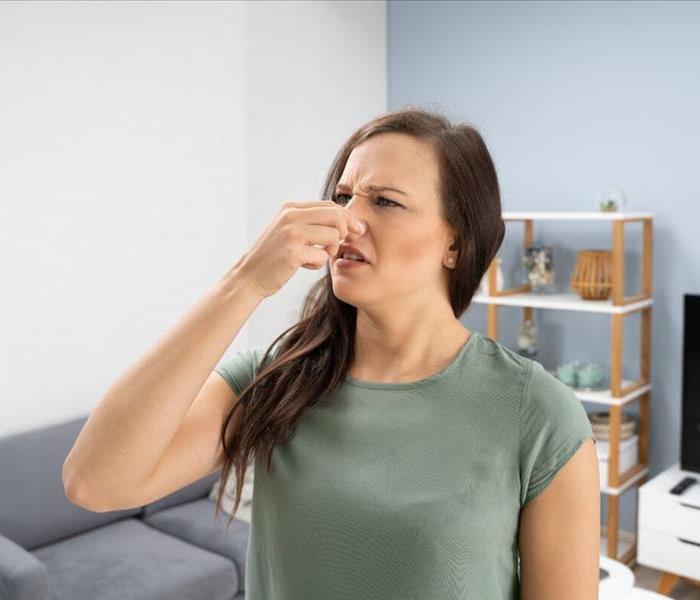 Aside from visible signs of mold in a property, there are non-visible signs such as foul and pungent odors.
Aside from visible signs of mold in a property, there are non-visible signs such as foul and pungent odors.
Mold isn’t always easy to pinpoint; its source can be hard to locate, and even more difficult to remove. What’s more, the presence of mold in a home is also linked to various health effects. Mold can be especially dangerous to children and adults alike. prolonged exposure can lead to short and long-term health effects. Dampness and mold together reduce air quality — especially indoors — and can damage the structural integrity of a home.
What Is Mold?
Mold is a fungal species that forms in damp or moist areas of a home, especially if a room or area has little natural light. Depending on your home, areas like ceiling tiles, basements, underneath sinks, wooden beams, and pipes can all carry mold species. Mold is typically noticeable by its fuzzy appearance — and often an unpleasant odor — spread by the dissemination of mold spores as the fungus matures.
Mold will spread simply by breaking down plant and animal materials in your home. It can be first introduced to a residential environment on shoes, clothing, family pets, or when the home contains a damp setting conducive for mold growth.
Types of mold
Certain types of mold are generally more likely to be found in homes. Consult the below information for some of the most common mold types, potentially affecting your house:
- Aspergillus mold is fairly common around the home, found most frequently in homes, on foods, and in air ventilation systems. Typically black on top with white or yellow hues underneath, this type of mold is rarely an issue for individuals with healthy immune systems.
- Cladosporium mold generally appears black or green — with a “pepper-like” texture — that can grow on toilets and other bathroom surfaces.
- Stachybotrys chartarum, commonly referred to as “black mold,” is toxic and can cause more serious effects. Recognizable by its dark green or blackish color, black mold can form in areas that maintain a damp or wet state for more extended periods. This often includes basements, window wells, flooded rooms, and dated wood.
- Trichoderma mold is identifiable by its white body and green patches and can grow quickly on wet surfaces like carpet, wallpaper, or neglected countertops. Over time, Trichoderma can break down even large-scale building materials and can yield more serious health effects.
Many types are mild and can be easily removed with common cleaning supplies. However, individuals who identify black mold in the home should take steps to immediately remove it before more serious health effects arise.
Warning Signs of Mold in Your House
Residents can identify several different types of mold around the house. While some types of mold are instantly visible and recognizable, others may require a review of your house’s history — and perhaps an assessment of how the mold has affected your physical health — before a professional can help identify it.
1. Smelling a Mold Odor
Often, mold’s presence in the home is identifiable by its distinct odor. If residents begin to identify a smell of decay — often described as “musty” or “meaty” — it’s a good indication that mold is nearby. In cases where a mold odor is more prevalent, professional odor removal and deodorization services can help you identify and eradicate the source of the smell.
2. Visible Mold Growth
Evident mold growth is also an obvious sign that there is an issue worth addressing. Keep in mind that mold won’t typically grow in well-lit areas of the home, where airflow and regular cleaning could limit its growth. Instead, mold is likely to grow in darker areas, like the regions behind or underneath furniture or stairs perfect for damp air. Even if you only identify slight mold growth, visible mold should be removed before the situation escalates further.
3. Water Issues
Water issues can also work to compound the mold situation you’re facing. Whether it’s signs of a past or present water concern — like a leak or active bubbling — water may mean that the growth of mold is not far behind.
From slight water stains, discoloration, or cracking, to fully flooded homes without sufficient aeration, water issues can yield mold far after leaks are addressed and floodwaters recede. Even if there are only trace signs of water present, homes without regular mold removal services can serve as a perfect breeding ground for mold to thrive in.
Homes subjected to flooding without subsequent water damage repair and restoration are also at risk for mold growth. To limit mold and other damage after residential flooding, remove vulnerable items from floors after mopping up excess water, and leave utilities and other electronics off until emergency help arrives to facilitate the water damage restoration process.
4. Mold Exposure
Mold exposure can lead to a wide variety of potential health effects. Many are mild, though certain mold types — or extended exposure to mold in the home — can yield more serious health effects.
How You Can Get Rid of Mold in Your House
Adopting a proactive approach to mold removal in your home can help limit the damage that mold has both to your house and to your health. Mold can be difficult to remove; leaving only a little mold in an isolated corner or behind a toilet can allow it to quickly grow back and resume its damage.
Residents should take steps to protect health during the mold removal process. Don’t disturb or blow on the mold, to prevent spores from spreading. If you have identified the growth of mild mold types in your home, they can usually be safely removed by applying a combination of water and one-quarter tablespoon of baking soda. Lemons — a natural antiseptic — can also be juiced and poured over the moldy area. After five minutes, aggressive scrubbing can remove both the lemon juice and the mold.
Especially for larger mold growths — and in cases of black mold — removal is often better left to the professionals. Don’t ignore the mold; instead, seek professional mold removal help for complete home restoration without any risk to your health, or the well-being of your family.
Tips for Preventing Mold
It’s not enough to successfully remove mold from your home; residents should take steps to actively prevent mold growth in the house, especially in potentially dark or damp locations where mold is most likely to grow.
Keeping mold from returning to your home is easier with the following tips:
- Ventilate the home properly, especially in rooms where mold is likely to grow.
- Keep spaces dry, and mop up thoroughly after cleaning surfaces with wet sanitation supplies.
- Periodically hire mold removal and remediation services for a full-scale home inspection that protects your house from mold invasion.
- Clean shower curtains and other areas where water gathers.
- Heat your home to prevent condensation from collecting on walls, doors, windows, counters, or other surfaces.
Allocating even a few minutes a day toward proactive mold prevention can help prevent serious future mold growth while protecting the health of all residents in the house.
The SERVPRO Water Damage Restoration Process
4/26/2021 (Permalink)
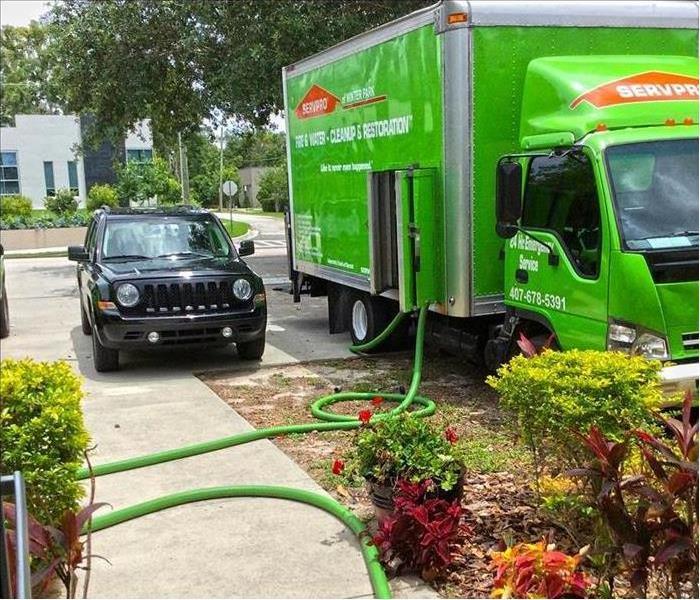 Excess water is extracted from a property using tools like an extraction wand that sucks up water and feeds it through to one of our truck mounts.
Excess water is extracted from a property using tools like an extraction wand that sucks up water and feeds it through to one of our truck mounts.
SERVPRO of Winter Park has the expertise and equipment to quickly restore your property to pre-water damage conditions. We use a scientific approach to water removal and water cleanup that emphasizes monitoring and documenting the drying process from beginning to end.
Have Water Damage?
Call Today (407) 678-5391
Every water damage event is a little different and requires a unique solution, but the general process stays the same. You can click on any of the steps below to learn more about that process.
When you call, our specialist will guide you through several questions that will help our team respond to your water emergency more quickly and efficiently. This initial contact is an important part of a fast, effective restoration.
They carefully inspect your property’s water damage, determining the type of water damage and the areas affected. This is a crucial step to creating an effective plan of action that will result in a successful restoration.
Typically, hundreds to thousands of gallons of water are removed using our powerful pumps and vacuums during the water removal process. The SERVPRO of Winter Park starts this process as soon as possible to minimize further damage and to help prevent mold growth.
After the bulk of the water has been removed, SERVPRO of Winter Park uses specialized equipment to target the water that’s harder to access. They use less intrusive, scientific drying methods to draw the remaining water and moisture from your property with air movers and dehumidifiers.
Water damage also affects your belongings, like furniture, clothing, and personal items. SERVPRO of Winter Park Professionals can clean restorable items using a number of specialized cleaning techniques. They also sanitize with antimicrobial treatments and remove odors using industrial air scrubbers and fogging equipment.
The last step is restoring your home or business back to its pre-water damage condition. The restoration step can be relatively minor, such as replacing a few drywall panels or could include major reconstruction, such as rebuilding entire rooms of a home or business.
What Should Commercial Business Look for When Hiring A Restoration Company?
3/4/2021 (Permalink)
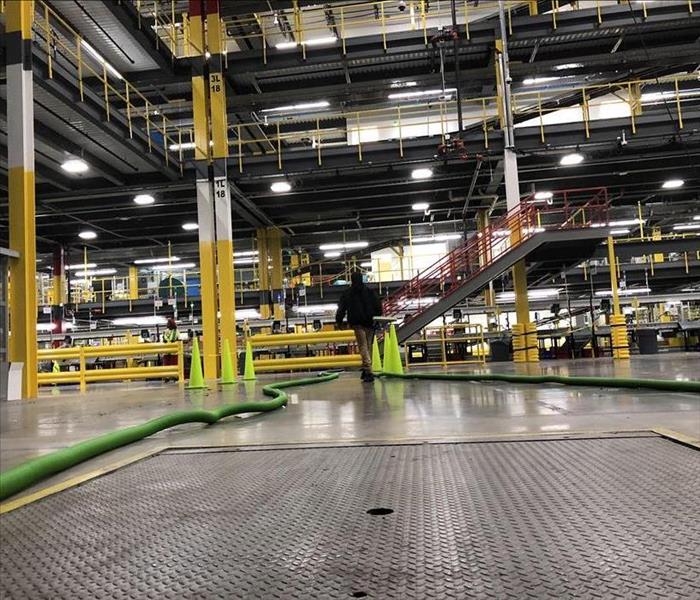 Many commercial properties experience damage on a larger scale and need the help of a restoration company with more manpower and equipment.
Many commercial properties experience damage on a larger scale and need the help of a restoration company with more manpower and equipment.
Understanding What To Look For In A Restoration Company
When fire and water damages stall businesses, it is essential to look for a renowned commercial restoration company to restore the property quickly because every minute spent in the business restoration means lost productivity and revenue.
At our restoration company, we value entrepreneurs’' time, which is why we have the proper employees with high training, skills, and equipment to restore the property within the required time or faster.
We offer commercial water and fire damage restoration, commercial cleaning services, commercial mold remediation, and commercial storm and big events.
There are things that business owners should put into consideration before hiring commercial restoration companies.
1. Certifications
Certifications show that the company is genuine, and they are ready to take accountability for anything that goes wrong in the cause of the job. Business owners should ensure that the restoration company is certified by the Institute of Inspection, Cleaning, and Restoration Certification (IICRC).
The IICRC ensures that the company adheres to the highest restoration process standards and ethics. It is also important to enquire about other certifications that the company may have within specific restoration fields like fire restoration or mold remediation.
2. Experience And Competency
Consider how competent the employees are and the skill level. Also, consider the experience and for how long the company has been operational. Companies that have been alive for a long time deliver more quality services because of the knowledge and skills gained in the course of their work.
3. Their Services And Prices
Ensure that the commercial restoration can handle all restoration aspects and within the required time. Also, look at their prices. While cheaper is not always better, ensure that their services are worth the money. Also, check if they give discounts or if they charge per service or in packages.
4. Emergency Services
Sometimes, damages occur when they are not expected, and it may be past working hours. Check if the restoration company has 24/7 services. Companies with 24/7 services can be trusted to handle any type and size of a job whenever and wherever.
It also means that the company is serious about meeting the customers' needs and is convenient and reliable. Our services are available 24/7, and so are our customer service lines.
5. Response Time
Anytime damages occur, they get worse with time without the needed attention. Business owners must consider restoration companies that respond fast to their calls, get to the site in good time, examine the damage, and quickly give expert recommendations.
Also, consider how much the company’s customer care takes to respond to questions and concerns. Companies that respond to concerns fast are serious about customers and are committed to quality services.
6. Restoration Timeline
Every minute spent on restoring the business premises means that the business loses. Some companies may need the restoration done within a set timeline.
While not all constructors deliver quality work in a rush, some will accommodate the customers' needs and do what needs to be done to complete it in a reasonable time and deliver quality results.
7. Read Reviews
All businesses advertise themselves as outstanding and delivering high-quality services. However, the customers never lie and give their honest reviews about the services offered.
Business owners should read those reviews to better understand the company's quality of services, advantages, and disadvantages. That saves them a lot of time and money and makes it easier to choose a restoration company.
8. Check Their Website
With technology evolving every day, many people are posing to be quality service providers with fake websites. To determine if a website is genuine, check if there is a link to the company’s services.
Things To Avoid
• Companies that ask for large amounts of money at once. It is understandable when a company asks for a deposit before services are delivered and the rest to be paid after. Companies should layout payment terms before the work begins.
• Companies that want to start working without a contract. A contract binds the customers and the restoration company, which means that the company can be held liable for anything that goes wrong. It also means that the client and company agree on the pricing and payment method, and timeline.
• A company that advertises itself and claims that customers get what they paid for. Business owners should ensure that customer reviews guide them.
Common Causes of Mold in Orlando Hotels and Resorts
3/4/2021 (Permalink)
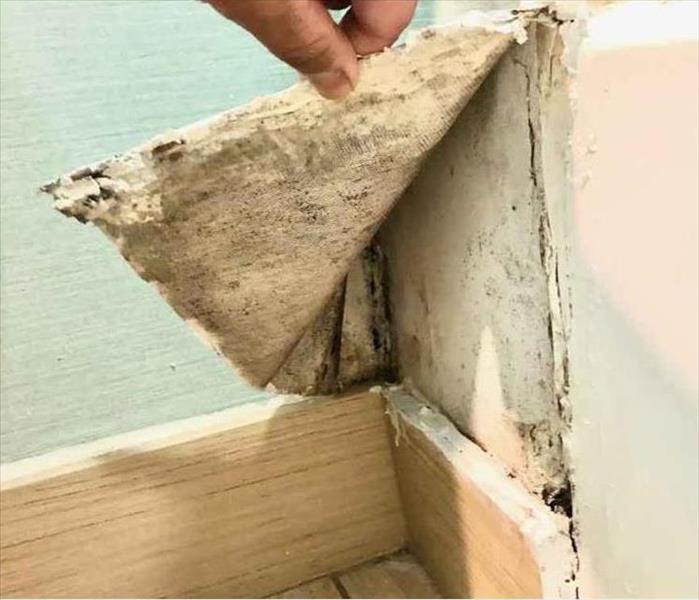 Wallpapers in hotels block the wall from breathing and modifying its temperature which can lead to mold growth.
Wallpapers in hotels block the wall from breathing and modifying its temperature which can lead to mold growth.
Mold in Hotels and Resorts
Mold usually comes with a strange and damp smell that you can easily know. If you enter a hotel or resort in Orlando and notice a musty odor, mold could be the issue. Biological contaminants can affect all hotels, including the five-star ones. Here are the root causes of mold in such establishments.
Water Damage
The primary root cause of mold in Orlando hotels and resorts is water damage. Typically, moist thrives in a moist indoor environment. The damage emanates from roof leaks, flooding, pipe bursts, and window leaks. Silent water leaks in the building lead to massive mold growth. Pools of water can reach the carpet where the spores will develop with sheer simplicity. Hurricane aftermaths are also the reason why hotels have a moldy smell.
Mold needs a wet place for 24 hours before it proliferates. If the hotel isn't cleaned within that time, the damages become irreversible. The good news is that you can contact us for restoration. We use specialized equipment to dry out the whole place. We will check for any leaking pipes and roofs for immediate repairs.
Condensation Build-up
Condensation results from drastic temperature changes in the room. For example, if someone gets to the room and leaves the AC on, it will become cold. Another occupant will turn off the unit leading to a different temperature setting. Condensation will occur, attracting mold in the rooms.
Similarly, during the winter, condensation happens on cold surfaces due to temperature inconsistencies. Wood, drywall, tiles, and bricks are prone to the issue. As a result, biological spores will grow since the specific zones are the perfect environment to flourish.
Poor Ventilation
Poorly-ventilated Orlando hotels and resorts are magnets for mold growth. Lack of ventilation also spreads the spores to other areas in the room with sheer simplicity. When the management asks the staff to turn the air conditioner off, there is poor air circulation. The whole place becomes humid, especially during the summer. It is crucial to save on energy bills, but turning off an AC is the worst idea.
The unit needs to be on so that the dehumidifier can get rid of excess moisture in the air. Steamed baths and cooking appliances in hotels contribute to humidity that needs elimination through ventilation.
Wet and Damp Clothes
Wet towels, bathing suits, and clothes lead to mold development in hotels and resorts. Some employees take the clothing out of the washing machine and set them aside to hang the clothes later. The bad news is that they will forget them, and the damp clothes will sit for 24 hours or more. The time-lapse alone will attract mold and spread them to other zones.
When customers check out of hotels, they leave wet towels on the bed. Failure to clean the rooms and pick the towels leads to instant biological contaminants after one day. Spring and summer aggravate mold issues since the air is already humid.
Wallpapers
Wallpapers decorate the hotel rooms, but they contribute to mold. Usually, walls go through temperature changes as the outdoor environment shifts. Wallpapers block the wall from breathing and modifying temperature as well. This way, condensation occurs between the wallpaper and drywall. Peeling the wallpaper will show you the extent of mold growth.
Using glue as an adhesive makes matters worse since it has nutrients that bolster mold growth and spread. We will look for areas with wallpapers and carry out mold remediation with immediate action.
Leaking AC System
A faulty air conditioner leads to mold due to leaking refrigerant or water. A leaking AC causes mucor, which is an allergenic mold, to thrive due to the condensation. It comes with white patches and circulates quickly if the air filter isn't in excellent condition. Moisture build-up comes from damaged ducts and inadequate piping as well. The environment will be ideal for mold to grow and move to other areas in the hotel.
Non-insulated Water Pipes
Water pipes that don't have insulation lure mold development. The primary reason is that they sweat, leading to moisture in the surrounding walls. If the insulation on the pipe has worn off, the problem could happen as well. You might notice that paint on the walls is peeling, indicating mold presence. Typically, the insulation traps the moisture so that it can't seep through the walls and damage them.
If you have any mold issues, contact us for remediation and restoration. We will locate the moisture or water sources for a lasting solution.
Commercial COVID-19 Cleaning in the Orlando Area
3/4/2021 (Permalink)
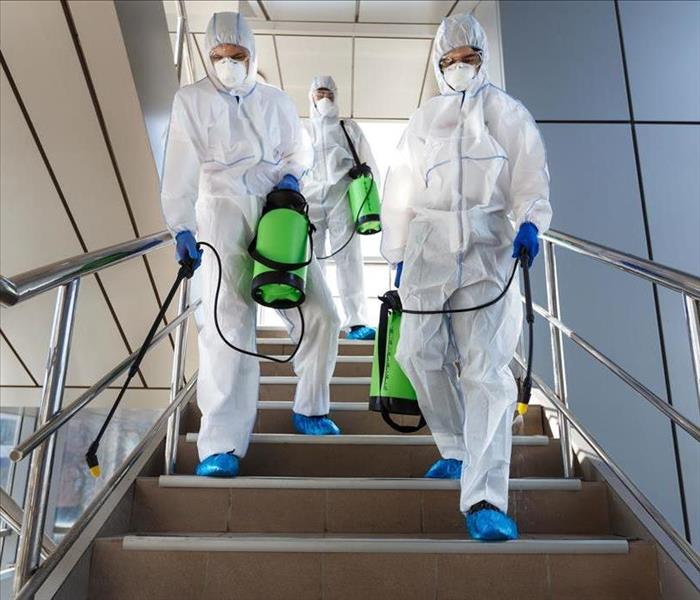 SERVPRO of Winter Park cleans and disinfects all corners of your operation areas with a powerful CDC-approved disinfectant such as Benefect Decon30
SERVPRO of Winter Park cleans and disinfects all corners of your operation areas with a powerful CDC-approved disinfectant such as Benefect Decon30
How are Cleaning Companies Adjusting to COVID-19?
The COVID-19 pandemic has greatly impacted businesses and livelihoods around the world. The highly-infectious disease has brought about challenges never experienced before. Millions of people have been infected and hundreds of thousands killed across the globe.
In order to minimize the spread of the disease, the federal and state governments have issued a raft of health measures that both individuals, institutions, and businesses should adhere to before commencing their operations.
Most of these guidelines have to do with cleanliness. It is believed that coronavirus spreads through the air and on surfaces.
As such, cleaning companies have had to adjust to the new COVID-19 cleaning requirements. As businesses and learning institutions start to reopen in Orlando and other parts of the country, one industry will be in the spotlight – cleaning.
Cleaning for COVID-19 is beyond basic janitorial work. It calls for a company that has adequate experience in biohazard cleaning to ensure that your office or workplace is free from any contaminants and ready to be used by workers and the general public.
For several years now, SERVPRO has specialized in biohazard cleaning in Orlando and other parts of the country. Our objective is to ensure that homes and commercial facilities are safe for use for those who live there.
Since the coronavirus pandemic broke out, we have stepped up our game to meet the demands of clients in various parts of Orlando.
We understand the seriousness of the virus and the threat that it poses to the public. That’s why we use high-quality and CDC-approved products such as Benefect Decon30 in our cleaning and disinfection operations.
Is COVID-19 cleaning necessary?
According to information from the Centers for Disease Control and Prevention, coronavirus has the ability to survive on different surfaces, although this is not primarily how it spreads. It is still not clear for how long the virus can survive in the air and on surfaces.
A big percentage of people who get infected don’t show any signs or symptoms until after two weeks. That’s why taking early precautions is very important. You don’t know who is infected or which part of your commercial facility has been contaminated.
The only way to minimize the spread and allay fears from workers and the public is to hire an experienced company for your COVID-19 cleaning services.
It doesn’t matter whether you are operating a restaurant, a daycare, commercial office, retail store, or warehouse, it is your responsibility to ensure that anyone who works or visits these places is safe.
As mentioned earlier, basic cleaning is important but it won’t kill the germs and prevent the spread of the disease. It needs both cleaning and disinfecting all corners of your operation areas with a powerful disinfectant such as Benefect Decon30.
At SERVPRO, we have created cleaning and disinfecting protocols for COVID-19 aimed at helping companies and businesses that believe their workplaces or operational areas have been exposed to the dangerous virus. We have a high-trained team of experts who are actively involved in the daily operations across Orlando.
How we clean and disinfect surfaces for coronavirus
Cleaning surfaces for coronavirus requires a lot of attention and focus on details. First and foremost, we have specialized products and equipment dedicated to our work. Unlike regular cleaning operations, COVID-19 cleaning requires a lot of planning.
We basically focus on cleaning and disinfecting all surfaces in the building. The first step involves our team of experts visiting your commercial facility to carry out an assessment. If you suspect that your building or office has already been exposed, we will use our coronavirus cleaning protocol to ensure that the place is disinfected accordingly.
You don’t have to worry about occupying the place after the cleaning and disinfection exercise because all our products are purely organic and safe. We ensure that every product we use has been approved by the Environmental Protection Agency (EPA) as well as the Centers for Diseases Prevention and Control (CDC).
Some of the areas of focus for our cleaning and disinfection exercise include desks, touch screens, door handles, seating areas, handrails, shopping carts, keyboards, hallways, and many more. The nature of cleaning will also depend on the type of your commercial facility.
For example, if you are operating a spacious warehouse, we can use aerosolized disinfectants to ensure that the whole place is decontaminated. Our biotech experts use personal protective equipment (PPE) like gloves, gowns, and face masks to protect themselves during the disinfection process.
By the time we are done, you can be assured that your office, restaurant, or warehouse is safe for use. We will also ensure that all the materials used are properly disposed of as biohazardous waste. Our company also has customized cleaning for clients who contact us in advance for such services.
What should you expect during cleaning and disinfecting of a facility that has been exposed to the virus?
• All the areas used by a person suspected to have the virus are closed off
• Leave outside windows and doors open and increase air circulation using fans
• Cleaning and disinfecting workspaces used by an infected person
• Vacuuming the space, if necessary
• The area can be opened for use after a thorough cleaning and disinfection exercise
Bottom line
The threat of COVID-19 is real. Over two million people have already died and others are still lying in hospitals. It is important to take the virus with the seriousness that it deserves.
As the owner of a business or commercial facility, you have a duty to protect your workers and the public by hiring an experienced COVID-19 cleaning company.
Fire Insurance for Owners of Rental Properties
3/4/2021 (Permalink)
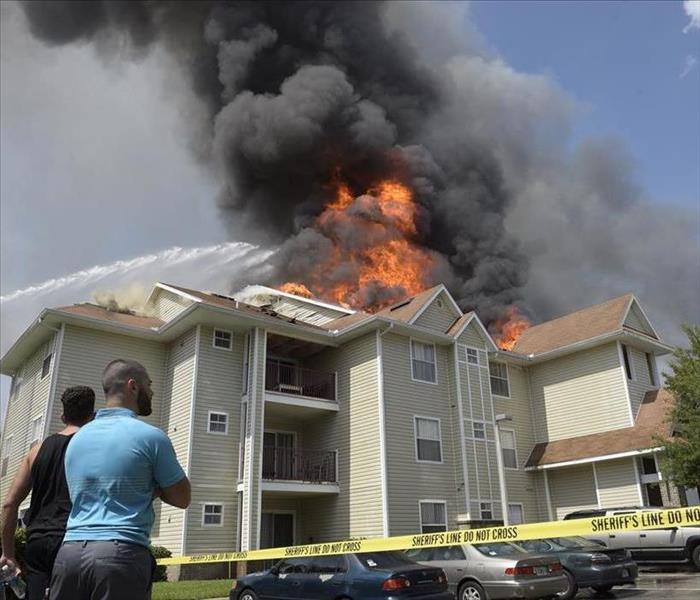 Coverage varies with fire insurance policies and it is important for property owners to select the right policy for their property.
Coverage varies with fire insurance policies and it is important for property owners to select the right policy for their property.
Dwelling Fire Insurance Dwelling fire insurance coverage offers a narrower type of coverage when compared to a standard homeowners policy. It is fire insurance designed to be focused on property damage. These policies can provide coverage for structures a person owns other than their home.
Flexibility
Property owners have a wide variety of coverage options with dwelling fire insurance. It's not limited to damage that is related to fire and smoke. Many policies provide coverage similar to a standard homeowners insurance policy. They can provide protection against hazards associated with weather such as lightning, and wind, explosions, vandalism, and more. Dwelling fire insurance will only cover specific perils listed in the policy.
Benefits
This fire insurance coverage is designed to protect the entire dwelling as well as structures on the property. It may cover personal belongings depending on if the policy is basic or broad. A policy could reimburse in the form of cash value or replacement cost. With cash-value coverage, a policyholder will get cash reimbursements for the repair-cost from a partial loss or a total loss. With replacement cost, the property will be replaced with a like-kind property at the current market price.
Dwelling Fire Coverage
- There are certain situations where dwelling fire coverage is the best option.
- Those who own a home that does not have much cash value. This could be an older home, manufactured home, or mobile home.
- Landlords who want to insure a building they own, but not the possessions inside of them.
- Individuals who own properties that aren't occupied full time. This could be a second home, seasonal home, rental property, and more.
- Individuals who own property that is being renovated or is under construction.
Extended Coverage
With dwelling fire coverage there is extended coverage. It would cover more things than are in the basic coverage.
- Volcanic eruptions
- Hail or windstorms
- Smoke
- Other explosions
- Aircraft or vehicles
- Riot/civil commotions
Fair Rental Value/Additional Living Expenses
This is a combined coverage. It will cover a policyholder for the loss of use of a dwelling as well as the loss of rental income due. Should a building that is rented be unable to be occupied, this coverage will provide protection for the loss of rental income. It will extend up to the limit of the policy. If a property can't be rented because the owner is forced to use the house, they will be reimbursed for the additional living costs associated with being unable to live in their own home. This is covered under additional living expenses.
Most Comprehensive
The most comprehensive policy is an all-risk or open perils policy. This means real property, such as dwellings and other structures, will be covered for all types of damage. The exception will be any exclusions specifically named in the policy. The damage to personal property, the items inside a dwelling, and other structures are usually covered on a named perils basis. There are some common exclusions.
- Earth movement such as an earthquake
- War
- Certain types of water damage
- Laws and ordinances
- Rot, mold, rust, and other gradual losses
- Neglect
Liability
Coverage for personal liability will pay for any legal damages awarded to a third party should the policyholder be found liable for damage as well as bodily injuries. It is also able to help pay for attorney fees and the court costs associated with a covered loss.
An insurance professional can help determine the best deductible for a policy that addresses a property owners' individual situation. This is the out-of-pocket expense a policyholder is responsible for paying before their coverage starts. It is possible to have a lower premium by increasing a policy's deductible. Fire insurance is usually part of a property owner's desire to minimize their risk. An insurance professional can also help identify the risk associated with a property and recommend the best possible insurance coverage.
What is Fire Insurance and What Does it Cover?
3/4/2021 (Permalink)
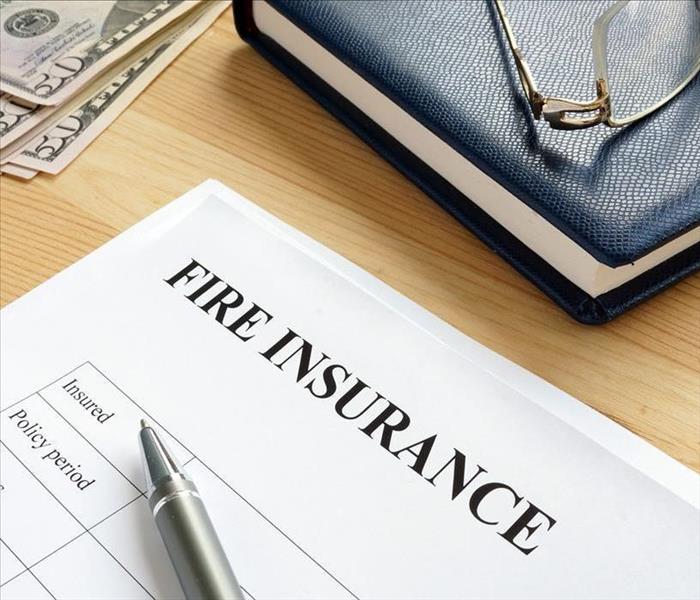 It is a good idea to check your policy carefully to see what's excluded or limited.
It is a good idea to check your policy carefully to see what's excluded or limited.
Finding the Right Fire Insurance Coverage
If you live in an area where there are constant fires cooked up by mother nature, you may need extra fire insurance protection for your home. It is a good idea to check your homeowner's policy to determine whether you have adequate coverage.
In this guide, you will discover what fire insurance is and what it covers. Some of the exclusions will also be presented. Finally, you'll be able to take the information presented here to make an informed decision bout your individual insurance needs.
What is Fire Insurance?
A typical homeowner's policy has fire coverage built into it. Most mortgage lenders won't give you a loan unless you have insurance that includes fire protection. You can also purchase additional coverage if you feel that your current homeowner's policy may be inadequate.
What does it cover?
Fire insurance covers the homeowner against total loss or damage from a wide range of sources. These sources include:
- Lightning strikes
- Faulty electrical wiring
- Natural disasters
- Appliance malfunctions
- Careless smokers
- Gas explosions
- Other accidents
Arson is normally covered. However, if someone who regularly lives in the home, like a family member, intentionally sets the house on fire, it is not covered.
These are the types of properties covered by fire insurance
Dwelling coverage.
If your home is considered a total loss due to fire, your homeowner's policy will kick in and provide the funds to rebuild your home. It will also cover any costs to remove debris from your property and haul off the remains of your charred house. It is calculated based on either the actual cash value of the house or the replacement cost. It is also based on your coverage limits.
This presents two problems:
1. Your coverage limits may not be enough to cover the costs to rebuild your house in today's market.
2. Your homeowner's policy is often based on actual cash value and not replacement cost. The difference is, the replacement cost model will provide funds to rebuild your home in today's market. On the other hand, actual cash value policies only cover your home's depreciated value.
So, let's say you bought your home ten years ago and it recently suffered a total loss due to fire damage. With an actual cash value policy, you would only get enough to cover what the house was valued at ten years ago, not what it would cost today to replace it. By having an additional fire insurance policy, you can increase coverage limits to include what the house would cost to build in today's market.
Other types of property covered
Other structures on the property. Any structure that is not attached to the home is usually covered by fire insurance. Here are a few examples of the types of structures covered:
- Toolshed
- Barn
- Detached garage
- Fences
Personal property.
These items consist mostly of your belongings that were inside the house during the time of the fire. Here are just a few examples:
- Clothing
- Furniture
- Electronic devices like TVs and computers
Your insurance company may set some limitations on covering the personal property. For example, if you own luxury items such as fine clothing, jewelry, or antique furniture, there may be additional limits to those particular items. It is a good idea to check your policy carefully to see what's excluded or limited.
Other "loss of use" coverage.
If you have no place to live while your home is being repaired or rebuilt due to fire damage, you are covered for the costs of staying in a hotel or other living accommodations.
The costs of feeding yourself and your family are also taken care of, up to certain limits. Even the costs associated with pet care and boarding may also be covered. It's best to check with your insurance advisor concerning all those important details.
What Is Not Covered?
Cars and other vehicles.
Usually, comprehensive auto insurance will be enough to cover fire damage or loss to your vehicle.
The home was vacant for more than 30 days during the time of the fire.
Vacant home insurance is available to cover these and other events.
Nuclear radiation or war.
These and other conditions like them are usually spelled out pretty plainly in the policy.
Reasons for denial of coverage
When everything has settled after a fire in a home, the fire department will usually investigate the cause and report it to the insurance company. Sometimes the insurance company will conduct their own investigation. The data is then compiled to determine whether they will cover the damages or deny your claim.
Here are some of the most common reasons why you may be denied:
Illegal activity
If, after your house burns down, the fire investigator discovers you or someone living in your home was making illegal drugs anywhere on the property, you will not be covered.
Illegal modifications to the home
An insurance company may deny your claim if they find any unpermitted work done to the structure. For example, if the previous owner added on to the home and there were no permits involved, that could complicate things. Your claim would probably be denied, especially if the fire came from that addition.
Documentation errors
Sometimes it's just a matter of getting everything right with the paperwork. Most of the time, it's no big deal, unless there's fraud involved. In most cases, if you have been truthful about what items were in the home during the fire, and there is no criminal activity involved, you should be able to get your claim processed quickly.
Orlando Water damage is a big disaster for your home
3/4/2021 (Permalink)
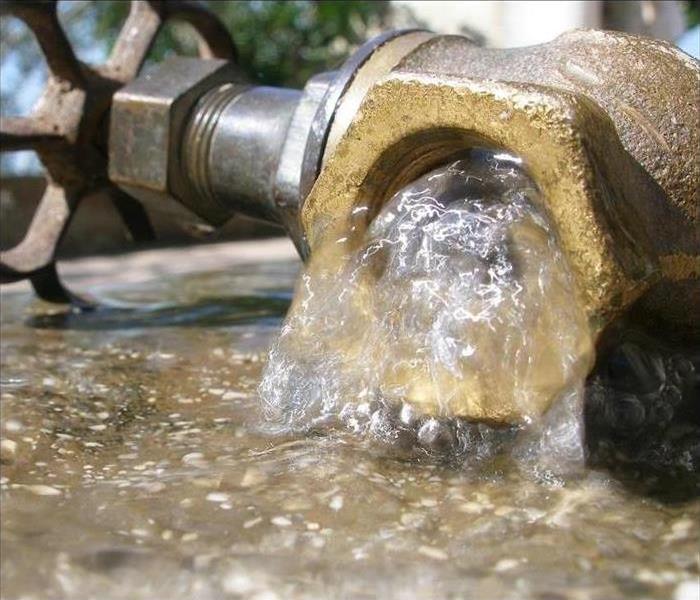 If a pipe bursts in your Orlando home and floods the house, insurance should cover it.
If a pipe bursts in your Orlando home and floods the house, insurance should cover it.
It's devastating when you find out that your insurance doesn't cover your Winter Park damage.
Orlando Water damage from a flood or a burst pipe in your home can be devastating, and the damage can linger for months or years in different forms. What can make the disaster even more devastating is finding out that your insurance doesn't cover it.
A good rule of thumb, when thinking about sudden water damage to your home is that if it comes from inside or above, you generally are covered. If it comes from the ground or below ground, you generally aren't.
For example, homeowner's insurance policies, as a general rule, do not cover damage from flooding. This includes a flash flood, where tremendous rain causes large amounts of water to flood into your home. It also includes a smaller event where water might seep up through your basement floor or cracks in your foundation to flood your home. Another type of event your homeowner's policy generally won't cover a backup of the sewer system, because that water comes from below ground. To cover damage from flooding, you need a separate flood insurance policy.
When the water comes from inside your home or above, your homeowner's policy is likely to cover it. For example, if a pipe bursts in your home and floods the house, insurance should cover it. If your washing machine or a toilet overflows and floods a room, insurance should cover it. Homeowners insurance also will cover rain damage from a storm if rain water got into your home because of damage caused by the storm. For example, if a tornado tore a hole in your roof, allowing rain to come pouring in, any water damage should be covered. On the other hand, if rain leaked through your roof because it was old and needed to be replaced, insurance may not cover it.
The best thing you can do is to examine your insurance policy and talk to your agent to make sure you understand what types of damage from water are and aren't covered. If you need to, there are riders you can add to cover other incidents that may not be covered under your original policy.
Keep in mind, too, that while your policy will cover some damage caused by sudden water infiltration, it will hardly ever cover damage caused over time, such as a leaky toilet that destroys a floor.
SERVPRO of Winter Park's professionals provide fire and water damage restoration services. We are available 24 hours/7 days a week and are ready to restore damage to your home or commercial structure caused by:
Saving Your Electronics After a Fire
11/12/2020 (Permalink)
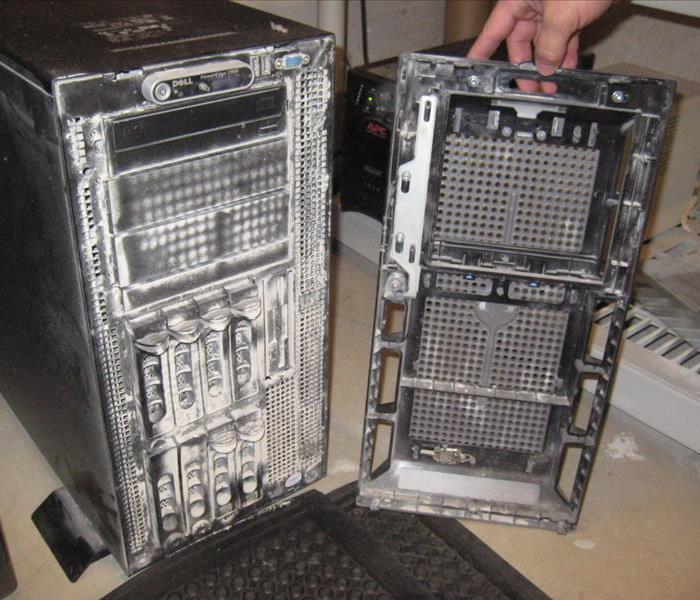 Electronic equipment affected by smoke damage from a fire can usually be restored by using the correct cleaning methods.
Electronic equipment affected by smoke damage from a fire can usually be restored by using the correct cleaning methods.
Can Your Electronics Be Saved After A Fire?
Given how important electronics have become to daily life, losing and having to replace them after a home or office fire can be a major inconvenience. So, other than having your equipment replaced by your fire insurance policy, can your equipment actually be saved? A fire does not always mean you will always be at a complete loss. In many cases, electronic equipment can actually be cleaned and restored.
When a fire breaks out, the heat will cause the plastics and metals most electronics are comprised of to produce toxins that damage them. Trying to use them while they are damaged can cause additional problems; also, if or when water is used to extinguish the fire, trying to use them before they are completely dry will quite likely ruin them.
Before a fire is extinguished, smoke can enter into the components of your electronics and leave a thin, black film. This film insulates electronics, causing them to be more likely to overheat and ruin. Short-circuiting can also happen because the film is magnetically charged, which could cause an additional fire.
Smoke from a fire also carries with it soot (material that did not ignite). Soot covers the outside of the electronics and can also be found inside them. This is acidic, which makes it dangerous and discolors them as well as shortens their lifespan.
Cleaning and Restoring Your Electronics
Although having fire and soot damage to your electronics is certainly a terrible thing, they can be cleaned and restored. First, disconnect them from their power sources by unplugging them and removing batteries. Next, use a rag to wipe down their exteriors while making sure to clean any soot marks. Thirdly, you will need to use an air compressor to clean out outlets, ports, and air vents.
Damage or dirtiness from a fire can be beyond what most people are able to deal with; in such a case, seeking professional help is needed. Also, home insurance policies can cover your electronics.
Computers and Hard Drives
A computer is one of the most valuable electronics anyone can have in terms of productivity. So you definitely want to make sure a fire cannot cost you your data. Therefore, cleaning and restoring it, or at least the hard drive where all of your data is stored, should be your top priority. Even if you have to get another computer, being able to connect your hard drive means you will have lost none of the data and will be able to continue on just as if you did not have to buy a new computer. Remove it from the fire-damaged computer first and have a SATA to USB adaptor.
Being able to store the information of your hard drive elsewhere (such as cloud storage) is recommended as well because if the hard drive is too damaged from a fire and a new one is needed, you will be able to download everything, meaning you lose nothing. Also, replace the battery in a computer as well to prevent the old one from igniting.
Why SERVPRO is Your Best Restoration Option
11/2/2020 (Permalink)
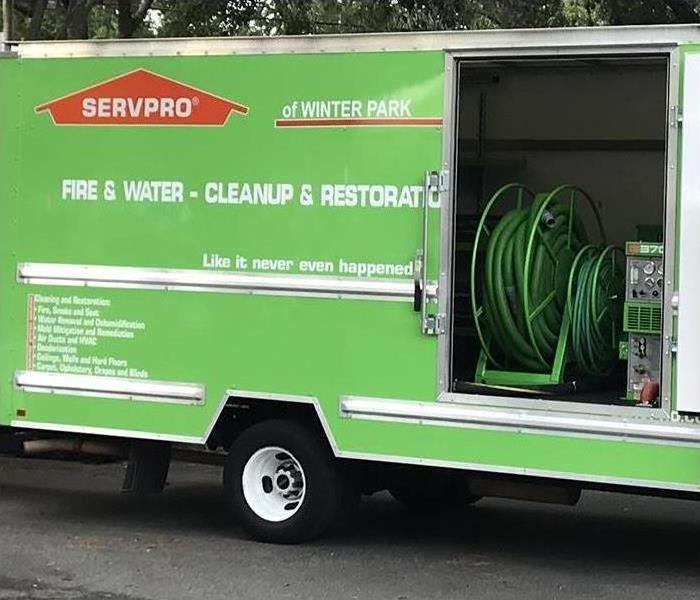 SERVPRO of Winter Park has a fleet of trucks designed for large scale water extraction
SERVPRO of Winter Park has a fleet of trucks designed for large scale water extraction
Why Choose SERVPRO Of Winter Park?
Unfortunately, a home or business establishment can be damaged by any number of unforeseen natural and accidental occurrences. Eve4nts such as fire, various weather phenomena, and structural issues like leaking windows and pipes or failing appliances could result in incalculable harm.
Fortunately, however, restoration services exist to help those impacted by such happenings recover, clean up, and restore their home and property to its original glory. One such establishment serving the central Florida region is SERVPRO of Winter Park. We invite the residents of Orlando and surrounding regions to continue reading this article suggesting why our restoration services are considered top quality.
SERVPRO of Winter Park is a privately owned and operated establishment that has garnered significantly favorable ratings from our customer base for the following reasons:
Variety Of Services Offered
The restoration professionals employed at SERVPRO of Winter Park offer prospective customers more services than do many restoration entities. In addition to the prototypical water removal, we offer cleanups for fires, crime scenes, commercial entities and organizations, biohazards, and mold development.
Additionally, we perform thorough Covid-19 cleansing. This is a unique type of remedial effort designed to meet the standards set by health watchdog agencies like the Centers for Disease Control and involves the use of specialized cleaning agents geared towards eliminating dangerous viral pathogens.
More Than Cleanup
We believe that cleanup is only the first stage of the restoration process. Therefore, the team of SERVPRO Winter Park participates in build-back projects. Should a customer wish, we will help them completely rebuild their property or establishment after safely completing the original restoration efforts.
Centralized Location
A restoration company does its customers little good if they cannot immediately respond to an emergency. Fortunately, SERVPRO Winter Park's headquarters are situated near downtown Orlando. This centralized location enables us to promptly dispatch a response team and arrive at most areas situated within the city, its limits, and surrounding regions in short order.
A Large Staff
We employ a large staff of highly-trained and experienced technicians. In accommodation, we also possess a large fleet of equipped trucks. This ensures our employees always have access to the materials needed to perform any type of cleanup and respond as quickly as possible.
Ample Storage
We own a large storage warehouse. This facility allows our customers to house their possessions until their home or business is considered safe and healthy enough to return to.
Certified Mold Remediation
Water damage often leads to the development of a potentially health-threatening substance known as mold. Fortunately, the team at SERVPRO of Winter Park has obtained the Institute of Inspection Cleaning and Restoration Certification, also commonly abbreviated as IICRC approval. This organization sets standards for how certain hazardous substances, most notably mold should be remediated.
Effective Communication
Not only do our team members possess extensive skill and experience but are polite, professional, and effective communicators. We are committed to keeping our customers informed and will clearly and succinctly explain every step of the restoration process.
Favored By Major Insurance Companies
We enjoy positive professional relationships with several well-known insurance companies. Many home and business policy providers recommend us to their customers. In many instances, we deal with their adjusters directly.
Numerous Satisfied Customers
Those who conduct online searches about our company will find countless positive reviews about our level of competence and commitment to customer service.
Contact Us
Experiencing a traumatic event like a flood, fire, or any other type of property-damaging occurrence can be emotionally-draining and leave those impacted not knowing what to do next.
Fortunately, those living in or conducting business in the Orlando area are can count on SERVPRO of Winter Park. Our experienced team of professionals looks forward to helping our customers quickly clean up, recover, and rebound from such happenings.
Business Recovery After a Natural Disaster
10/20/2020 (Permalink)
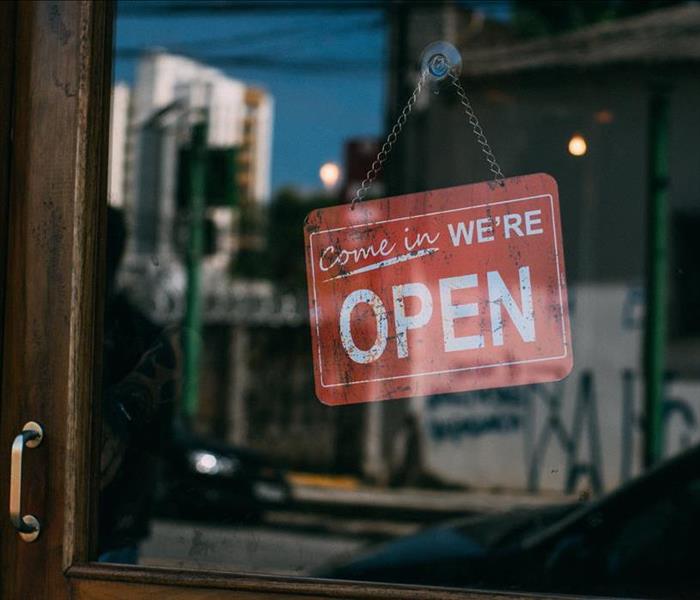 A natural disaster has the potential to cripple a business. Preparing yourself adequately before one can ensure your business has minimal downtime.
A natural disaster has the potential to cripple a business. Preparing yourself adequately before one can ensure your business has minimal downtime.
Reopening a Business After a Natural Disaster
The U.S. has sustained 279 natural and weather-related disasters since 1980, with damage repairs costing in excess of $1 billion, according to the National Centers for Environmental Information. Only about 40% to 60% of small businesses that are affected by a natural disaster reopen their doors, according to the Federal Emergency Management Agency (FEMA).
Some natural disasters, such as a hurricane, are predictable and allow business owners the time they need to prepare. However, many natural disasters, such as wildfires, may occur without warning, leaving no time to ensure a business is safe and prepared.
As a small business owner, creating a disaster preparation plan and ensuring you’re ready for any type of devastating event is key to your business’s survival. Review the information below to learn how to reopen your business successfully after a natural disaster.
Emergency Plans
Your emergency plan is a crucial part of your business’s survival and your employees’ safety, both during and after a natural disaster. While you may feel you’ve created a comprehensive continuity plan that thoroughly addresses every aspect of your business, natural disasters can be unpredictable. The aftermath of a weather-related event may pose problems you didn’t foresee that haven’t been addressed in your general operational plans.
When you create an emergency plan, consider how to keep your equipment, environment, and staff safe in different scenarios. You should:
- Analyze potential threats related to precedented, regional, and seasonal natural disasters.
- Consider how to deal with business interruptions.
- Create a work plan for employees and vendors.
- Choose a professional cleanup and restoration company that will help your business estimate the costs of repairs or even remediation to help increase the resilience of your permanent locations.
Consider all aspects of the natural disasters that may threaten your business at any point in time and create a plan that addresses these potential scenarios. Once your emergency plan is in place, implement the steps when it’s safe to do so. When you follow your plan, major issues and barriers are easier to tackle because you’re better organized and prepared.
Documentation and Insurance
Once a natural disaster occurs, it’s crucial to document the damages and losses your business suffers. Keep track of receipts and purchases you made to mitigate damages. Document your business’s current physical state with photos and videos.
Before providing compensation for mold remediation services or other aid, your insurance company may ask to see proof of damages. If you need smoke or fire remediation, the insurance company may request photos of the damage to your equipment and building first. Documentation of your property before disaster strikes can help you make your case and potentially expedite the aid you need to get back up and running. Likewise, retain any receipts for expenses incurred after the disaster, as your insurance company may not compensate you without a clear record of expenditures.
Constant Communication
Open lines of communication are the key to getting your business back on track and fully recovered from a natural disaster. Be sure your employees are aware of your recovery plan and their roles in each step. To keep the recovery process running smoothly, you may need to maintain constant communication with:
- Your insurance adjuster.
- Lenders and creditors.
- Lawyers or consultants.
- Suppliers and other businesses within your supply chain.
- Your employees and vendors.
- Customers and prospective clients.
Consistently checking in on everyone involved in the situation ensures you’re all on the same page with the mitigation process.
Safety and Infrastructure
After a natural disaster, it’s crucial to analyze all the risks associated with the damage. The damage that fire, smoke, water, or wind cause can be hazardous to you and your employees. Your work environment may not be safe for a period of time until the damages are repaired.
If you don’t feel the work environment is safe, have an alternative plan in place to ensure your staff can perform their jobs without the potential for injury or health issues. Remediation work is best left to professionals because they can safely and effectively clear debris and mitigate damage.
For example, if your business sustained flooding damage from a storm, you may need to hire a professional remediation company to help. Completing the cleanup process thoroughly and correctly ensures mold spores don’t begin to grow and cause future health effects for employees.
Seek and Provide Support and Assistance
Even if you have a detailed emergency plan, you may not be financially prepared for a natural disaster. If you have the proper insurance in place, seek financial assistance with remediation through your insurance coverage.
Your employees may also feel the negative financial effects of business interruption. Encourage your employees to take advantage of natural disaster relief programs they may qualify for. These programs can help them remain financially stable while you work to get your business back up and running.
There are also several federally or locally funded programs that provide support and assistance to small business owners and their employees after a disaster. These organizations include the following:
- Chambers of Commerce and Economic Development: Your local chamber of commerce may have a grant or other type of financial assistance program available to help you get back on your feet. If you’re a member of your local chamber, ask about assistance programs your small business may qualify for.
- Community Support Organizations: Most communities have their own support organizations that are designed to assist small businesses when they need help. Your city or town may have programs available that provide financial assistance during natural disasters to ensure your business can remain intact and continue to thrive after recovery.
- The Small Business Administration (SBA): The SBA is a national organization that provides resources and assistance to small businesses. For example, during the COVID-19 pandemic, the SBA provided many small businesses with forgivable loans so they could continue operating with limited capacity and under other guidelines enforced by federal and state governments.
- Federal Emergency Management Agency (FEMA): FEMA is a federal government agency that focuses solely on assisting individuals and businesses after emergencies and natural disasters. Once a natural disaster strikes, FEMA generally implements several federally funded programs to financially assist businesses during the recovery process. Contact FEMA directly to inquire about programs your business may qualify for after a disaster.
- Tax Relief in Disaster Situations (IRS): After tornadoes, earthquakes, or hurricanes, the IRS usually implements tax relief for citizens and business owners who were affected. Since business is often interrupted for a period of time during recovery, the organization may allow for additional credits or relief at the end of the year. When you file your taxes, review the tax relief programs available and utilize the credits that your business qualifies for to decrease your tax liability.
Exploring these financial aid options after a natural disaster may be helpful if you’re struggling to repair damages, pay your staff, and replace equipment.
Natural disasters can derail your business and or be expensive to recover from. When you have a thorough emergency plan, keep open lines of communication, and seek out financial support, you can work to get back up and running quickly and safely.
Creating and Writing a Business Continuity Plan
10/20/2020 (Permalink)
 Keep your doors open by having a business continuity plan to prepare you for natural disasters.
Keep your doors open by having a business continuity plan to prepare you for natural disasters.
Prepare for the Future With a Business Continuity Plan
As a small business owner, it’s important to be aware of the ways in which a disaster could affect your business. From a cyber attack to a hurricane, preparation for any type of disaster is the key to keeping your business running. One of the best ways to prepare is to create a business continuity plan well before a disaster strikes.
With a solid continuity plan in place, you can rest assured your business will continue humming along, even as you repair and rebuild. Learn how to create a business continuity plan for any incident to ensure you’re adequately prepared to continue operating as usual, no matter what disaster you’re dealing with.
What Is a Business Continuity Plan?
A business continuity plan is a plan that outlines how your business will continue functioning after any disruption of normal operations. The plan outlines the systems and procedures you’ll activate and put in place after an emergency, natural disaster, or another disruption (including cyberattacks) occurs.
When you follow your business continuity plan, your business and employees should be able to continue working while you repair and rebuild. With a plan in place, you ensure you can continue selling and servicing customers with the same ease, accuracy, and timeline your business provided before the disaster occurred.
What Is the Primary Goal of Business Continuity Planning?
When you create a business continuity plan, your main goal should be to ensure your business can continue running at optimal performance after a disaster has occurred. Your plan should include detailed instructions, procedures, and processes that you and your staff can follow to keep working, even after an emergency.
The business continuity procedures you’ll need to implement may vary, depending on the disaster or disruption you experience. Common occurrences that could negatively impact your business include the following:
- Cyberattacks.
- Pandemics.
- Natural disasters.
- Utility outages.
When you have a thorough business continuity plan in place that addresses these occurrences, you’ll keep your staff working and your customers happy as you address the damages.
What Does a Business Continuity Plan Typically Include?
The elements included in your business continuity plan depend on the type of business you have and the specific processes and actions that keep it running smoothly and successfully. A useful continuity plan should be realistic and easy to follow. It should provide detailed steps that outline how to continue working during a disaster.
Since the effects of a disaster aren’t easily predicted, the business continuity plan should also be adaptable and easily edited as needed. Your plan should include several back-up options or alternative procedures to address different scenarios. A reliable business continuity plan provides efficient and convenient ways for the business to remain productive after a disaster.
How to Write a Business Continuity Plan
To create your own business continuity plan, you’ll need to analyze your current business practices. Following the steps detailed below will ensure your continuity plan is comprehensive and easy to implement when needed.
Identify the Scope and Goals of the Plan
Consider how your business currently functions and what processes could be negatively affected by a disaster. List the employees, systems, and procedures that keep your business running, employees working, and customers satisfied.
If you think these procedures may be affected by a disaster, you’ll need to target them in your plan and provide alternative ways to ensure they can still be followed. Outline the goals of your business continuity plan, such as ensuring you can fulfill orders or continue producing goods. Be sure the procedures you include in the plan thoroughly address how to achieve these goals during a disaster.
Create an Emergency Preparedness Team
If you’re busy working with insurance adjusters and commercial restoration professionals after a disaster, you may not have time to improvise and troubleshoot around every challenge or consideration your business faces. Before a disaster occurs, designate a few reliable employees within your business to help.
Train these employees on how to deal with emergencies and go over the business continuity plan with them to ensure they understand how to implement it. With an emergency preparedness team, you won’t be the only person who can delegate the implementation of your continuity plan and adjust it as needed, which frees up your time to deal with repairs and other issues.
Identify Key Business Areas and Perform Risk and Impact Assessments
In some cases, you may not have ways to modify the way you do business after a disaster. If you have to eliminate certain services or procedures, your business continuity plan should address these issues.
Perform a risk and impact assessment with your team to identify the tasks that may be neglected after a disaster. Consider how you’ll address these issues and how you could potentially modify services to lessen the impact. For example, if you’re dealing with water damage in your storefront and can’t allow customers into your retail space, consider sidewalk sales until the flooding damage is remediated.
Identify Critical Business Functions and Prepare a Plan For Each
Chances are the success of your business relies on several functions, such as marketing, accounting, and administration. Identify all the critical functions within your business and create a plan to ensure they’ll continue to thrive, even after a disaster. You may need to rely on outside vendors or online processes to ensure your business continues to function.
Create a Plan to Maintain Operations
Keeping your business operations running smoothly during a disaster is the only way to maintain customer satisfaction and continue attracting prospective clients. Consider all the operations you need to continue performing so you can serve customers seamlessly, such as shipping and communication.
Then, address each operation and implement an alternative plan to ensure you can still provide these services adequately. You may need to involve subcontractors, switch your suppliers, or use different shipping options.
Train Staff and Stakeholders
Review the business continuity plan with your staff and stakeholders for feedback. Train your staff on the alternative procedures that may need to be put in place in the case of a disaster. With training on how to implement these new processes, your staff can seamlessly follow the steps in your business continuity plan without incident.
Update the Plan as Needed
When you perform trial runs with your staff, be open to changing your plan if specific steps aren’t efficient. Disasters are unpredictable and additional issues may arise when you’re dealing with an emergency.
Remain flexible and ready to update your business continuity plan with each situation. For example, if a disaster caused water damage and you need to close the office for professional mold removal, you may need to revise your continuity plan to include work-from-home procedures for your staff.
Technological and natural disasters can bring your business to its knees. However, with a comprehensive, realistic, and flexible business continuity plan in place, you’ll ensure your customers are satisfied and your employees are productive, even after a disaster.
Prepping Your Home Before a Natural Disaster
10/20/2020 (Permalink)
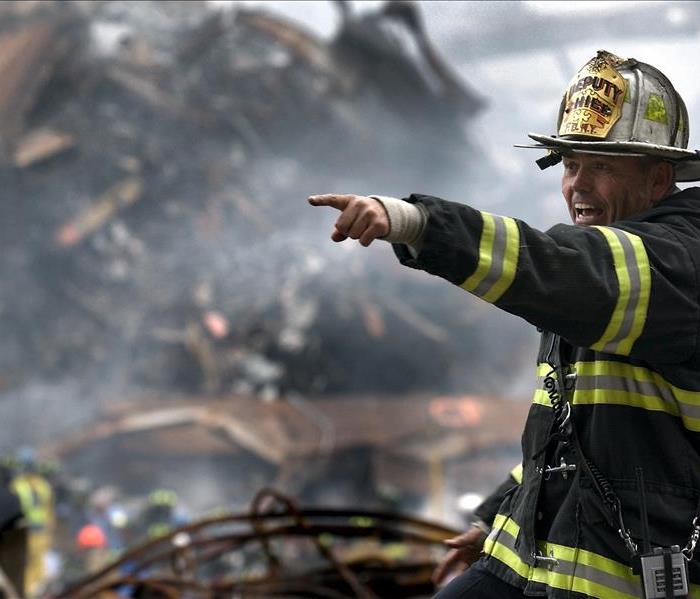 When you’re prepared for a natural disaster, you can help keep your family safe and possibly prevent damage to your home.
When you’re prepared for a natural disaster, you can help keep your family safe and possibly prevent damage to your home.
How to Prepare a Home for a Natural Disaster
In 2019, the U.S. experienced a total of 90 natural disasters, according to Statistica. Severe thunderstorm damage alone caused economic losses of $27 billion in the U.S. throughout the year. No matter where you live, you’re not immune to some type of dangerous natural disaster.
While you can’t stop a natural disaster from heading straight towards you, you can prepare yourself and your home for the event. Review this article to learn more about the effects of disasters and what preventative actions you should take to get ready for an event in your area.
Types of Natural Disasters
Before you can prepare for a natural disaster, it’s important to understand the types of events you could experience in your area. Learn more about your location and the specific natural disasters your community is prone to experiencing. Sign up for emergency text, phone call, or email alerts through FEMA, the Red Cross, or a local disaster agency in your area.
You can also review a natural disaster risk map to better understand the risks in your current environment. The Natural Center for Disaster Preparedness provides an online natural hazard risk map that allows you to learn more about the events that may occur in your area. Different hazards require different preventative measures, so it’s crucial to identify the natural disasters you may be susceptible to first.
Earthquakes
An earthquake occurs when two areas of the Earth’s tectonic plates slide past and grind against one another, causing the ground to shake. Earthquakes can occur in any state in the U.S., as long as a fault line is present. Before an earthquake, it’s important to secure large furniture and repair any cracks in your home’s walls or foundation.
Wildfire
Wildfires generally begin when wooded areas are exposed to flames from humans or lightning strikes. With dry conditions and wind, these small fires can spread and become uncontrollable, threatening nearby homes. Prepare your home for potential wildfires by clearing dry brush from around the exterior and clearing dry leaves from your rain gutters.
Flood
Floods occur when too much water is present in one area, either via rain, tsunami, hurricane, or another natural disaster. Homes and livelihoods are threatened when local waterways can’t handle the excess water. Storm flooding restoration can be extensive, depending on the damage. To prepare your home for a flood, ensure your electrical system isn’t on the ground level, and consider purchasing flood insurance.
Tornado
Severe thunderstorms cause tornadoes to form without much warning. These funnel-like clouds extend from the storm to the ground and produce powerful and damaging winds. Identify your safe room in the middle of your home and use a weather radio for updates on a tornado’s location. If you live in a mobile home, evacuate at the first signs of a tornado.
Storms and Hurricanes
While severe storms can pop up in any region, hurricanes are mainly experienced in coastal states. A hurricane may bring high wind, storm surges, and heavy rainfall but you should have plenty of warning before the storm hits your area. To prepare, board your windows, and remove or secure debris around your home.
Make a Plan
An emergency or natural disaster may induce panic and irrational thinking. However, if you have a plan in place for an emergency, you’ll be able to think more clearly and prevent or reduce damage or injury.
Emergency Action Plan
When there’s an imminent threat in your area, implement your emergency action plan. Your plan should provide an outline of the steps you need to take to prepare for the event. To create your own emergency action plan, you should:
- Know your evacuation route.
- Identify shelters in your area that meet your family’s needs.
- Have a clearly defined communication strategy with your family and neighbors.
- Learn how and when to shut off utilities to your home, if needed.
- Make an evacuation and care plan for your pets.
Disaster Recovery Plan
After a natural disaster, you may need to begin the repair and rebuilding process. Since this process can be overwhelming, it’s important to create a disaster recovery plan that includes steps to get your home back in order. This plan should include:
- Emergency contact information.
- Help and resource contact information.
- Your insurance policies and company contact information.
- Steps for cleaning your home.
- Contact information for a professional restoration company.
Depending on the disaster that occurred, you may need assistance remediating smoke and fire damage in your home. Water damage from flooding should be professionally addressed right away. If this damage isn’t repaired, you may need to hire a mold remediation specialist to clear out unhealthy mold spores from your home.
Preventative Infrastructure and Practices
Once you've identified the natural disasters that your area is prone to experiencing, implement preventive practices to prepare your property and family for these events. When you apply preventive infrastructures and practices, you can prevent damage and injury if a natural disaster occurs.
Depending on the events that are likely to occur in your area, you should consider:
- Creating retaining walls.
- Installing hurricane-resistant windows.
- Planting fire-resistant landscaping.
- Bolting down and securing heavy objects or outdoor furniture.
- Sealing cracks in your foundation.
- Removing debris from around your home.
Finances, Insurance, and Important Documents
One of the best ways to prepare for a natural disaster is to review your insurance policy. Ensure it provides coverage for the events that are likely to occur in your area. You may need to increase coverage or purchase additional policies, such as a flood insurance policy, to ensure you’re properly covered.
Create an emergency fund that you can use if a natural disaster occurs. With this fund, you can pay for unexpected expenses, such as food, shelter, or repairs that aren’t covered under your insurance. Your important documents, such as your insurance policy, identification documents, and bank account information, should be stored in a safe location and taken with you in the event of an emergency.
Build an Emergency Kit
During an emergency, you may need to evacuate your home quickly. If you stay home, you may lose power and access to a local grocery store or other conveniences.
Build an emergency kit before a disaster occurs so you’re prepared for this scenario. The items you stock in your kit should depend on your needs and the event that you think will occur but may include:
- Non-perishable food items.
- A weather radio.
- Extra batteries.
- Important documents.
- A first-aid kit.
- Supplies for children and/or pets.
Store your items in a bag or kit that’s easy to grab if you’re in a hurry to evacuate your home.
Some natural disasters are unpredictable, which is why it’s so important to prepare for emergencies ahead of time. When you create emergency action and disaster recovery plans and prepare your property for natural disasters, you can prevent severe damages and keep your family safe.
Water-Saving Tips for Commercial Buildings
10/20/2020 (Permalink)
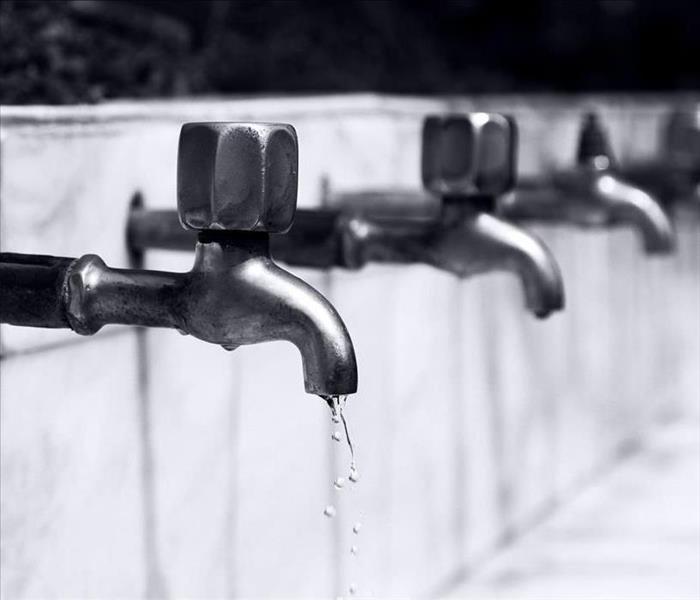 As a business owner, you can save money and increase sustainability with water-saving technology.
As a business owner, you can save money and increase sustainability with water-saving technology.
How to Reduce the Water Consumption of Your Business
As a business owner, you’re always on the hunt for ways to save money and increase sustainability. Your commercial building’s water consumption may not be the first thing you think of when contemplating money-saving strategies. However, when you integrate water-saving technology with your daily business operations, you’ll experience several benefits, including:
- Making your business more efficient and sustainable.
- Lowering utility bills.
- Finding it easier to prepare for natural disasters.
- Lowering your risk for water damage or mold.
Offices use about 9% of the total water utilized by commercial and institutional buildings, according to the Environmental Protection Agency. Most of the water in offices is used for heating and cooling, landscaping, and restrooms.
For the sustainability of the world’s water supply, it’s crucial that commercial building owners address water consumption issues and implement water-saving technology. Review the information below to learn more about the technology you can invest in to make your business more water-efficient.
Invest in Commercial Water-Saving Technology
Commercial buildings are known for using a lot of water, but there are several technologies and ways to make them more efficient. Implementing one or more of the following technologies will help your business use less water.
Commercial Water-Saving Devices and Technology
When you install a sensor that keeps track of water usage, you’ll have a better idea of when and where your building is consuming the most water. A water pressure regulator is also helpful because it records the current water pressure within your plumbing system.
High water pressure wastes water and can damage your pipes. A burst pipe may result in flooding, which requires the assistance of a commercial restoration company. If it’s not addressed properly, dangerous mold may grow, requiring mold removal services. Ensuring your pressure is correct and efficient saves you from these threats and reduces your utility bill. Additionally, even a step as simple as installing low-flow faucets and toilets can cut water use in half, or even more.
Landscaping irrigation is usually the culprit for much of the water usage in commercial buildings — as much as half of all irrigation water may be wasted due to evaporation, runoff, or inefficient watering practices. Timed irrigation systems can be set to turn on at night when the sun won’t evaporate the water off the grass.
You should also consider installing a rain sensor in your irrigation system. If the system senses that it recently rained, it’ll skip a watering cycle since the grass already received the moisture it needed.
Grey Water Systems for Commercial Buildings
Clean water pumps into a commercial building and after it’s used, it’s released into the sewage system. The water that’s released is classified as black water, which is considered unsanitary and could be toxic without treatment.
Greywater is the wastewater used in sinks, showers, or washing machines. It’s also usually released to a water treatment plant after use and although it’s not technically sanitary, it carries less risk of being toxic or contaminated. Since greywater isn’t as unhealthy or dangerous, commercial buildings may adapt their own greywater recycling systems that allow them to reclaim the water so it can be used again.
When a greywater system is installed, it separates this water from black water. Then, it uses a thorough treatment and filtering system that may include sand filters, aeration, and pressure filtration. The clean water is placed in a storage tank and released for usage.
You must consult with an engineer and your local water authority before installing a greywater system. While this system is an expensive investment, reclaiming greywater is an efficient way to save money and reduce water consumption substantially over time.
Water-Saving Plumbing
If you’re focused on reducing water consumption, there are several water-saving plumbing options available. Be sure you’re paying close attention to plumbing leaks and repairing damages promptly. This alleviates the costs of repair, such as mold remediation after sustaining water damages. You could also consider:
- Plumbing insulation: Pipes that aren’t insulated can take a while to heat water. When a user turns on the hot water tap, they’ll need to let the water run until it finally reaches the desired temperature. With insulation, the time you wait for the water to get hot is sufficiently reduced, which also reduces needless water waste.
- Low-flow plumbing fixtures: You can install low-flow plumbing fixtures to sinks and toilets without installing an entirely new plumbing system in the building. With low-flow fixtures, less water flows through the fixtures when they’re turned on, cutting down on consumption and making workers more mindful of water usage.
- Energy Star appliances: If you have a dishwasher, washer, or other appliances, consider replacing them with upgraded Energy Star models. These appliances are rated to use less water during operation without sacrificing performance.
Additionally, consider replacing your aerators or installing water-free urinals to reduce water consumption in your commercial building.
Harvesting Rainwater
Most of the time, stormwater causes damage because it is associated with flooding. However, if you have the capacity to install a rainwater harvesting system, you can use this stormwater as landscape irrigation. Consult with an engineer and your local water authority to decide if the costs of system implementation are worth the collection in your area.
Depending on the size and layout of your commercial building, you may be able to install large barrels that collect rainwater. The water usually needs to be filtered for oils before it can be used for irrigation or other purposes. Plant low-water plants so your system effectively uses the rainwater that’s been collected.
Boiler Blowdowns and Cooling Towers
During the boiler blowdown process, water is removed from the boiler to minimize corrosion and scale. With automated blowdown controls, the system slows down the rate of blowdown to ensure water isn’t wasted. An automated blowdown process also prevents fluctuations in the frequency of blowdowns so the amount of water used is better controlled.
A cooling tower removes heat from a commercial building’s air conditioning unit by evaporating condenser water. To prevent your cooling tower from wasting water, consider installing a tower that uses stormwater instead of freshwater. Ensure your cooling tower is well-maintained and in good condition so it doesn’t needlessly wastewater throughout the process.
Although commercial buildings are synonymous with high water consumption, there are ways to ensure your business isn’t wasting this precious resource. When you implement one or more of these water-saving technologies, you’ll save money and invest in the sustainability of your building.
Tips for Cleaning and Disinfecting Your Home
10/20/2020 (Permalink)
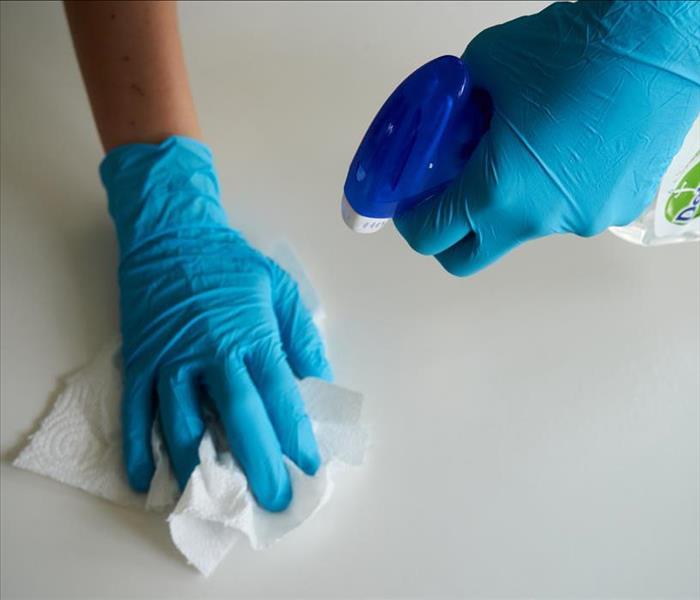 When you use a disinfectant, you remove and kill both bacteria and germs.
When you use a disinfectant, you remove and kill both bacteria and germs.
Tips for Cleaning and Disinfecting Your Home
On an average day, 85% of women and 71% of men spent at least some time at home doing household activities, according to the Bureau of Labor Statistics. You eat, sleep, relax, and entertain in your home, so its cleanliness is key to your health and enjoyment.
A study published in the Journal of Environmental Health analyzed 22 average households for mold, bacteria, and dirt. The study found countless bacteria present in seemingly clean homes, including Escherichia Coli and Staphylococcus Aureus. Learning how to properly clean and disinfect your home is important to the health and safety of your household.
Cleaning vs Disinfecting
While many people use the terms “cleaning” and “disinfecting” interchangeably, there are differences between the two terms. When you clean surfaces in your home, you’re reducing the number of germs and bacteria present.
When you disinfect your home’s surfaces, you’re removing and killing the germs and bacteria. Sanitizing is another word that’s frequently used when it comes to killing germs. Some products are labeled as “sanitizers” instead of disinfectants.
When you use these products properly, they help reduce and eliminate bacteria on the surfaces in your home. However, disinfectants are generally more effective at killing mold, bacteria, and germs so it’s important to choose the proper cleaner.
Read the Label
To ensure your disinfectant does its job effectively, follow the instructions on the label. Not only do these instructions make sure that the product functions properly, but they also save your home surfaces from potential damage. Some products may advise you to dilute them with water before use.
There are many disinfectants on the market so choosing the right product may seem overwhelming. The Environmental Protection Agency (EPA) offers a list of approved home disinfectants that are known for their effectiveness and safety. When you choose a registered disinfectant, you know the product is proven to work and safe for your home.
Using Home Disinfectants
The disinfectant dilution process can be dangerous if you're not careful. When diluting your cleaning product, follow the instructions on the label and be sure to:
- Wear protective gloves and eyewear.
- Complete the process in a room with adequate ventilation.
- Only use the amount of product listed on the label.
- Label your new diluted solution clearly.
- Avoid mixing other products or chemicals together.
- Use room-temperature water, unless otherwise specified.
- Keep your cleaning products out of reach of children and pets.
If a household member has asthma or is particularly vulnerable to chemicals, only dilute disinfectants when they’re not close by.
Tips for Disinfecting Different Rooms
Different rooms, surfaces, and sections in your home may require unique attention to be sufficiently disinfected. Before addressing the areas in your home you plan to disinfect, it’s important to acquire the proper supplies.
Consider what’s the most convenient for you, your cleaning goals, and the surfaces you’re disinfecting when choosing supplies. You may need wipes, sponges, paper towels, or hand towels. You may need different supplies or disinfectants for each area of your home.
Kitchen
You generally use your kitchen several times every day to prepare food. Since food can carry harmful bacteria, such as salmonella, it’s crucial to keep frequently-touched surfaces clean.
Disinfecting wipes are an easy way to clean your kitchen since you can wipe down areas, then throw out the wipes. It’s important to wipe cabinet handles and drawer handles to kill bacteria and viruses. Glassware and dishes should also be cleaned thoroughly after every use.
Living Room
Your living room is full of soft surfaces, such as your couch and pillows. Most hard-surface disinfectants can harm these materials so you’ll need cleaning products designed for soft surfaces instead.
Other surfaces, such as your coffee table and light switches, should also be disinfected regularly. Read the label on your disinfectant to ensure it’s safe to use on these surfaces and follow the directions carefully.
Bathroom
Since the bathroom is exposed to bodily fluids on a daily basis, it must be properly disinfected. Use a disinfectant on the sink, faucet handles, shower, toilet, and tub. Clean frequently-touched surfaces, such as the light switches and toilet handle.
Inspect your bathroom for water damage, which may occur if the tub or toilet isn’t sealed properly. If left untreated, water damage can lead to dangerous mold growth, which may require professional restoration services to remove harmful spores and more established mold growth that cannot be managed with routine surface treatment.
Bedroom
You may need a special disinfecting spray to address soft surfaces, such as your mattress and pillows. Clean and disinfect your bedroom furniture, paying close attention to drawer pulls and other frequently-touched surfaces. You likely walk around in your bedroom barefoot, so it’s also important to disinfect the floor.
HVAC, Ventilation, Filtration
Your HVAC system circulates air inside your home so it’s important that it’s clean. If your home ever experienced a fire and had smoke damage, have the ducts remediated, and cleaned thoroughly.
Change out your HVAC filters regularly and consider purchasing the highest-rated filter that’s recommended for your system. This reduces your exposure to allergens and airborne bacteria.
Tips for Disinfecting Household Items
Different types of surfaces in your home also require different treatments for adequate disinfection. It’s important to use cleaners that are safe for these surfaces but that are also effective at killing bacteria and viruses.
Soft Surfaces, Washable, and Non-Washable Fabrics
If your soft surfaces are safe for the washing machine, such as sheets and pillowcases, complete the cleaning cycle with warm water and dry the items thoroughly. Read the label on your disinfectant and if it’s safe for soft surfaces, such as carpet, consider spraying it on, letting it sit, then vacuuming. You can also use soap and water if the disinfectant isn’t recommended for those surfaces.
Electronics
The buttons on electronics are touched frequently, so properly disinfecting them is crucial. Consider installing a plastic cover on your tablet, remote, or keyboard, so you can easily wipe it down with disinfectant.
Disinfectant sprays with at least 70% alcohol are generally effective at killing bacteria on electronics. However, it’s important to review the manufacturer’s label to ensure the spray won't damage your items.
Laundry
When you wash your clothes, towels, or linens, use the warmest setting that’s still safe for your items. Dry your laundry thoroughly to prevent bacteria from growing. Wipe down your clothes hamper with a safe disinfectant regularly.
Using the proper disinfectants ensures you kill the bacteria, germs, and viruses that can cause illness. When you keep your home disinfected, you and your family members can enjoy a healthy, safe, and clean environment.
Cast Iron Pipe Water Damage and Lawsuits
10/19/2020 (Permalink)
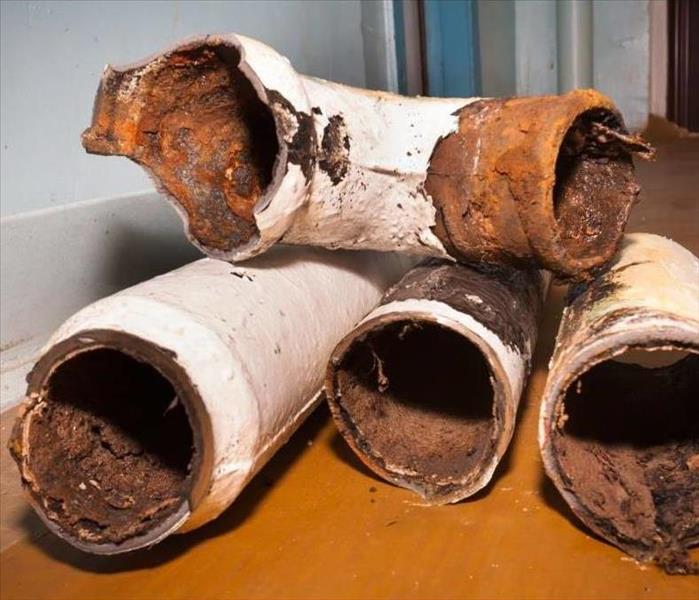 Iron pipes could have corrosion on the inside that can reduce water quality and slow the flow of water.
Iron pipes could have corrosion on the inside that can reduce water quality and slow the flow of water.
In Florida, there are increasing numbers of homeowners filing a lawsuit related to cast-iron plumbing in their homes that have failed, leading to water damage, leaking sewage, drain clogs, and even pest infestations. These are homes that were built before 1975 with cast iron pipes that have since deteriorated. Unfortunately, many homeowners who have filed claims with their insurance company are being denied coverage or receiving far less than the damage caused because the company claims the problem was “normal wear and tear” or that damage caused by water is not covered under the policy.
The Problem with Cast Iron Plumbing
Today, homes are built with PVC piping which are pipes made of a hard plastic material known as polyvinyl chloride. However, before 1975, Florida homes were built using cast iron plumbing, which was supposed to have a lifespan of up to 75 years. When these pipes were installed, builders did not take into account the extreme humidity in Florida which has led the pipes to fail much sooner than they should have. Humidity speeds corrosion and leads to damaged pipes. In fact, homeowners began having problems with the cast iron plumbing within 25 years, half the expected lifespan of the plumbing. It is estimated that over two million homes in Florida have this type of piping and all of them will need to have the cast iron pipes replaced in the near future.
Signs Your Pipes are Failing
There are telltale signs that will let you know if your pipes are failing. You may notice that your sinks or tubs drain slower than normal or that your plumbing has developed leaks. If water backs up in your toilet or drains, your pipes may be starting to fail. Broken, cracked, discolored, or raised floor tiles are also a sign that you may have a leak due to faulty piping. Water stains on your carpet or pest infestations are also symptoms of pipe problems. If you notice foul smells in your home, you may want to have your piping checked as well.
Pest Infestations
Many homeowners are unaware that there are pests that can access your plumbing which can result in an infestation in your home. If your pipes are leaking, standing water can accumulate and become a breeding ground for mosquitoes, flies, and dragonflies. Standing water is also a great place for parasites and bacteria to thrive. Hidden plumbing leaks can create a perfect environment for other types of pests as well. Rodents and bugs like dark, damp spaces which means a plumbing leak under your home could provide them with the perfect place to lay eggs or build a nest. Termites are attracted to damp wood and could cause tremendous damage. Cockroaches are also attracted to water as well as organic debris. They have been known to actually clog sink traps by getting into the plumbing system. Rodents like squirrels, gophers, rats, and mice can enter your home through vents in the roof, your sewer system, or gaps in your crawl space. Once they are inside, they can easily climb plumbing pipes and leave debris inside, leading to clogs. A rodent can also die inside a pipe, leading to a serious backup and expensive repairs. If your pipes are failing, gaps and leaks provide access to your plumbing system by all types of pests.
Cast Iron Pipe Issues
The average homeowner understands that they are required to perform regular maintenance on their home. For most, this means cleaning gutters regularly, replacing HVAC filters, repairing visible damage, and replacing roof shingles. However, when it comes to a cast-iron plumbing failure, the average homeowner may have no idea that the pipe even has a problem. Because the majority of a home’s plumbing fixtures are hidden, you may have no idea that you have cast iron pipe in your home. In addition, being able to see the outside of the pipe may not be enough. Iron pipes could have corrosion on the inside that can reduce water quality and slow the flow of water.
Insurance Company Denials
One of the reasons homeowners are filing lawsuits is because their insurance companies are denying claims related to cast-iron pipes. Water damage is a tricky subject for insurance companies. Most will cover damage caused by a water problem that could not be foreseen, such as a broken toilet or washer hose. They usually do not cover damage that can be related to homeowner negligence or water that seeps for a significant period. That means a pipe that bursts in your home suddenly may be covered but not one that failed simply because it was old. Insurance policies often do not cover flood damage, like when a river overflows and they usually do not cover sewage backups or water seeping into your basement from the ground. You want to read your homeowners policy to see what clauses exist. If yours states that it will not cover “losses due to wear and tear on pipes,” they will more than likely not cover damage caused by a faulty cast iron pipe and you may need to talk to a lawyer about a lawsuit. However, there is a chance your policy may have a loophole that will work in your favor, but it may take an attorney to find that loophole or the threat of a lawsuit to get the insurance company to cover the damage.
How to Deal with Water Damage
If you suffer water damage, you need to take immediate action. First, try to remove excess water by mopping and blotting. Unplug and remove all electrical appliances, such as lamps. Remove furnishings and prop cushions in a dry location. Turn on ceiling fans, unless the ceiling is wet, and, if you have them, window or floor fans, making sure to keep them away from standing water. You do not want to leave the wet fabric in place, you need to remove it to a dry area as quickly as possible, Books, magazines, and colored rugs should also be removed. Never use your household vacuum to remove water. If you have a wet-dry vacuum, you may use that to remove excess water. Do not enter rooms if the ceiling is sagging from water damage. It is critical to get the water cleaned as fast as possible in order to minimize the damage and reduce the costs of repair.
Water damage can be devastating. A water leak on your second floor could result in damaged ceilings on lower levels as well as damaged floors on the level where the leak occurred. If your home was built before 1975, it is possible that the leak was caused by a faulty cast iron pipe. If your insurance company denies your claim, you should contact an attorney to discuss the possibility of a lawsuit. You may also want to reach out to a company that will help you deal with the aftermath of a water leak. SERVPRO of Winter Park offers 24/7 emergency service and can get a technician out to minimize your damage as much as possible. We use advanced equipment and techniques designed to dry your property. Not only will we address your water damage quickly, but we will also deodorize and sanitize the area as well. Contact us today by calling or visiting us online to learn more about the many services we offer, including water damage, sewage backup cleanup as well as mold remediation.
How to Stop Damage from a Window Leak in Orlando
6/12/2020 (Permalink)
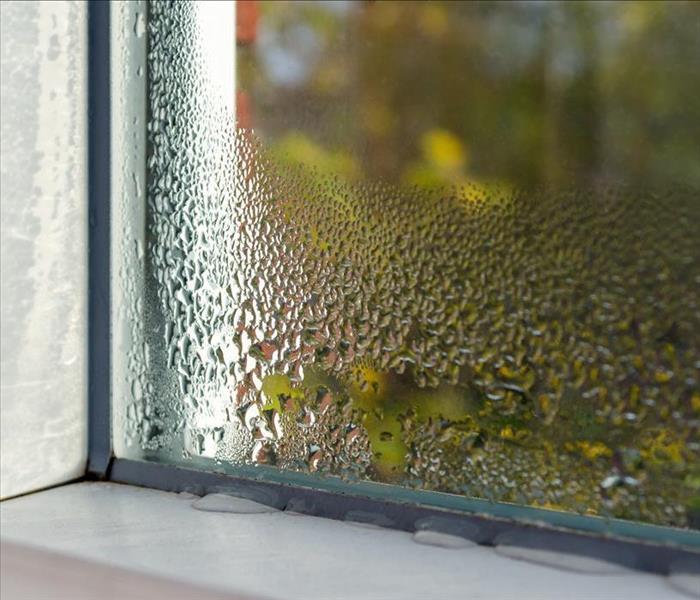 SERVPRO Has the Devices and Equipment to Keep Your House Dry
SERVPRO Has the Devices and Equipment to Keep Your House Dry
Water Damage Can Escalate Fast - Orlando Can Count SERVPRO
If you have identified a leak in one of your windows, it can lead to water damage in Orlando. Take steps to fix it quickly. If left to deteriorate, the problem will turn into something much more difficult to repair. It is very easy for invading water to cause additional damage and wood rot, so waste no time and call in an expert water damage team, if necessary.
Identify the Source
The first step is always to try and uncover the spot where the water is making its way inside. While this might sound simple, it can be very tricky. Just because you find water pooling in a particular spot on the sill or around the drywall, this does not mean that this area is the point of intrusion. Water will run with gravity, often quite far from its source. Take a close look at the whole window, focusing mainly on the frame, sash, and the edges of the glass. Carefully examine the caulking around the perimeter, because degradation of this material is a common cause of leaks.
A lot of windows only show signs of leakage if the rain outside is bad or there is a storm, so you may have trouble finding the source in dry conditions. You can, however, ask a helper to step outside and spray the window with water (from a bucket, hose, etc.), so that you have a better chance of discovering the water damaged problem area. SERVPRO can check with a moisture meter for hidden wet areas within the window area or adjoining walls and ceiling. Dehumidifiers and air movers can be placed to pull out moisture and increase evaporation.
Fix the Leak for Good
The only way to tell if you can repair the leak alone is to identify its source and assess how serious it is. If the water is entering in the flashing, above the window, it will need to be removed and upgraded. Or, you may need to replace the caulking around the window. If you are not confident about the outcome, call in a professional to do the repairs.
Water damage can appear in many forms. If water wicks into porous material like drywall or ceiling tiles, it usually has to be discarded. We recommend hiring a leak detector or plumber to find and stop the leak from the source. For any amount of standing water and/or moisture, it may be wise to call in SERVPRO for an assessment of the problem and suggestions for remediation. Don't allow a small quantity of water to cascade into a major, expensive water damaging event. We can restore water damage "Like it never even happened."
Highly-Trained Water Restoration Specialists
We are water damage specialists. SERVPRO of Winter Park gets your property in College Park, Orlando, and Baldwin dry and back to pre-water damage condition. We are ready 24/7 to help. (407) 678-5391
Smoke Damage Restoration in Winter Park
6/12/2020 (Permalink)
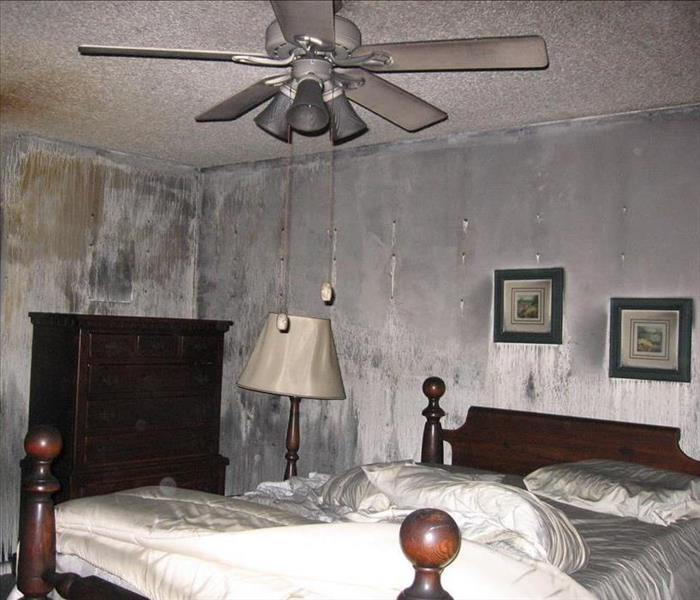 After a fire strikes your residential property, there are a plethora of tasks that you must complete to expedite the remediation process.
After a fire strikes your residential property, there are a plethora of tasks that you must complete to expedite the remediation process.
Brief Overview
After a fire strikes your residential property, there are a plethora of tasks that you must complete to expedite the remediation process. One of the most crucial tasks that you will need to attend to is Winter Park smoke damage restoration. Often, homeowners believe that completing a do-it-yourself project is advisable because it will save them time and money. However, this is almost never the case. In fact, hiring a professional smoke damage restoration company is the best route to take because these individuals possess the experience and equipment necessary to optimize the remediation process. Learn more about smoke damage restoration and the importance of hiring a professional company by reviewing the following data:
Performing The Fire Damage Assessment
One of the most significant components of the Winter Park smoke damage remediation process is completing a fire damage assessment on your property. This work will help determine the extent of the damage done by smoke and fire. The best way to get the process started is to contact your insurance company and a smoke damage restoration company. These individuals will be able to inspect your property and provide you with a cost estimate for the cleanup and repair processes. If you can obtain a referral to a restoration company by your insurance company, the two companies will likely be able to work together to create a fair settlement. If this happens, you will probably pay less money out of pocket for remediation services.
Cleaning Your Home
After completing a detailed assessment, professional restoration companies will start cleaning up the fire damage in your residential property. Dehumidifiers will help absorb excess water. Smoke damage restoration experts will also utilize cleaners and deodorizers to remove soot and smoke from your property.
Contact SERVPRO Today
Winter Park smoke damage restoration is a complex, complicated process that should be left to the professionals. When you start looking for a team of trained experts to assist you, trust the talented technicians of SERVPRO. We offer round the clock emergency services and work with speed and skill to resolve all smoke issues as quickly as possible. Call us immediately at (407) 678-5391 to attain the excellent, expedient smoke damage restoration services you deserve.
Locally Owned Company with National Resources
As a locally owned and operated business, SERVPRO of Winter Park is strategically located to respond quickly to your smoke or fire damage event. When a major fire or disaster event occurs, we can call upon our national network of 1,650 SERVPRO Franchises and special Disaster Recovery Teams if we need additional resources or personnel.
We are here in Winter Park and are ready to help you. Just call us. (407) 678-5391
Downtown Orlando Commercial Fire Damage Advice
6/12/2020 (Permalink)
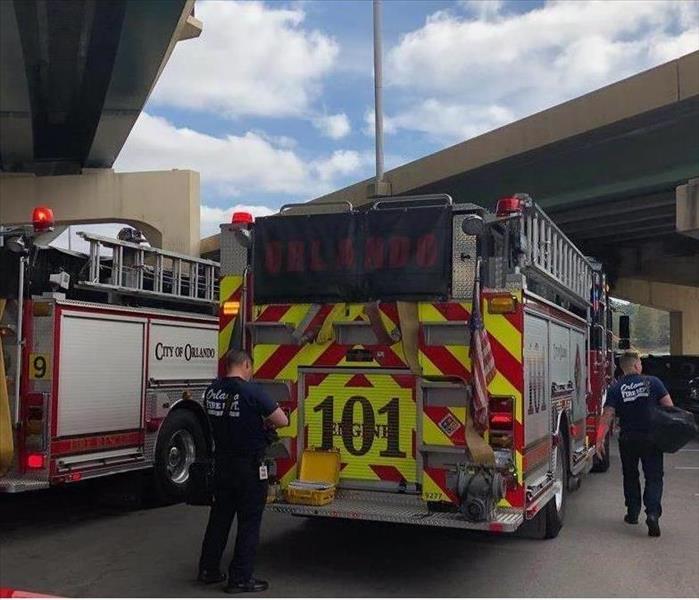 There are steps you can take to make sure your downtown Orlando business is as safe as possible from the threat of a fire.
There are steps you can take to make sure your downtown Orlando business is as safe as possible from the threat of a fire.
SERVPRO Offers Fire Damage Preventative Tips For A Downtown Orlando Business
Fire damage to a commercial enterprise can be catastrophic on the property damage issue and of closing the doors to clients and customers. A commercial property owner, having to deal with this unexpected extreme event, needs all the help he can get. The fact that the fire can force a business owner to stop temporarily operating or even shut down permanently can result in deep financial consequences. However, learning more about business fire prevention and what steps to handle them can limit business owners from experiencing substantial financial loss, stress, and the complete destruction of their property. Discover more about these important issues by referring to the quick reference guide provided for you below compliments of SERVPRO.
What Causes Business Fires? A wide range of factors can cause business fires.
- fire from an adjoining commercial property or suite
- an electrical fire, or commercial kitchen flare-up
- lightning strike, very prevalent in the Orlando area
- natural disasters like earthquakes, more likely a sinkhole
Business Interruption Insurance
Typically, companies who are not able to survive following a fire fail to do so because they did not have business interruption insurance. While companies who do purchase this insurance may find it challenging to recover fully, it is still easier for them to get back to business. Thus, although the insurance typically costs 10% more than a business owner's standard premium, the investment is considered to be a prudent and practical one. And SERVPRO is usually at the top of the list of preferred vendors for many insurance and property management companies. We can coordinate a restoration plan with your insurance adjuster and help manage the insurance claim, reducing your stress.
Fire Prevention Strategies
In addition to investing in business interruption insurance, business owners should implement the following fire prevention strategies:
- Do not store flammable items in an open spot. Keep an organized stockroom and inventory storage area to prevent damage from fire.
- Check quarterly that your smoke alarms are functioning properly, and if installed, working fire-suppressant sprinkler system.
- Develop and implement a thorough, effective fire evacuation plan, have lighted exit signs, and no blockage of emergency exit doors.
- Make sure that your appliances, electronics, and machinery are shut off when closed, if possible.
- Ensure that all fire extinguishers and emergency directions are in viewable and accessible locations, emergency phone numbers visible
- Make sure that your backup drives and critical paperwork are kept in a fireproof safe or cloud storage.
Call SERVPRO Today
Unfortunately, even extensive planning cannot prevent your commercial property from possible fire damage in Downtown Orlando. A lot can happen in this thriving environment. However, if disaster strikes, the professionals of SERVPRO can provide you with the fire damage restoration services that get your property and business back into operation. Our IICRC-certified technicians offer a fast response. And we can mitigate the water, smoke and fire damage and handle the restoration project, saving you money. From start to completion, our goal is to get your doors reopened in minimal time and cost. "Like it never even happened."
Commercial Restoration Presents Unique Challenges
SERVPRO of Winter Park has the equipment, experience, and training to handle large commercial fire damage emergencies in Downtown Orlando, a big box fire in Winter Park, or even a small motel in College Park. Because we are faster to any disaster, we respond 24/7 to all calls. 407 678-5391
Storm Damage Experts in Winter Park
6/12/2020 (Permalink)
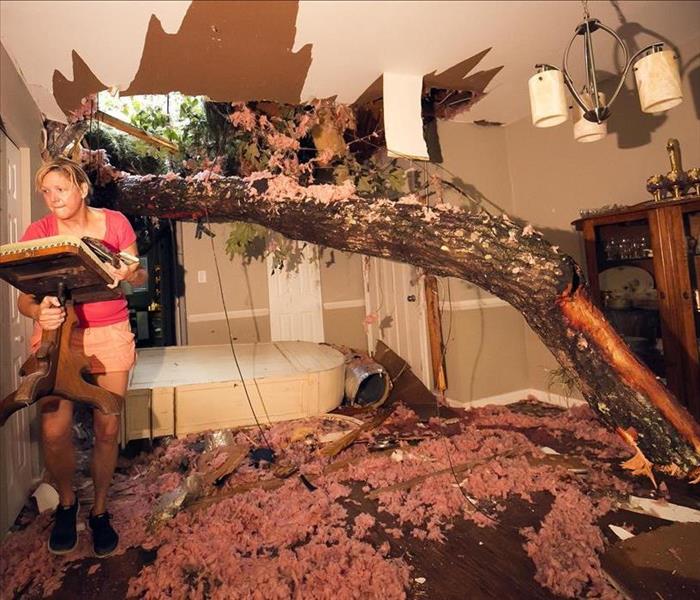 SERVPRO is ready to deal with any size storm damage. Call today!
SERVPRO is ready to deal with any size storm damage. Call today!
Quick Response and High Standards Will Leave you Satisfied after Remediation
When heavy rains and high winds hit hard, property destruction and loss can be devastating to you as a homeowner. Structural damage to the exterior of your home is followed by interior devastation from water and winds. Storm damage is rarely isolated to just a few buildings in an area adding the challenge of finding a restoration company that can respond swiftly to your needs to an already anxiety-provoking situation. SERVPRO delivers the help you need swiftly even when a local disaster is widespread as we are able to call upon a network of over 1,650 franchises nationwide to respond if the need is great.
Storm damage in Orlando can feel overwhelming, but your fear and panic will disappear when our team of professionals responds to your water, wind, and flooding repair and restoration needs. Your particular situation is of paramount importance to us, and you need not worry that your repairs and restoration will take a back seat even when many in your area are struggling to recover from the same issues you face. Choosing our company puts in motion a vast support system, but our local ownership means you will receive a personalized approach to your particular situation, efficiently returning your home back to its pre-storm condition just “Like it never even happened.”
Placing your trust in SERVPRO for your storm damage needs will reap you benefits that less qualified companies simply cannot deliver. We use state of the art equipment to clean, repair, and restore your home and in the process, we also restore your and your family’s peace of mind. Our technicians are highly trained and qualified, current in the Institute of Inspection Cleaning and Restoration Certification (IICRC) for any procedure needed to bring your home back to the comfortable and comforting refuge you deserve. We also work closely with your insurance company, ensuring that all the work necessary is approved and compensated according to the terms of your policy. Our high standards and relentless drive to do the job on time while meeting local specifications means you and your family will quickly return to the quiet enjoyment of your house and neighborhood. We are not satisfied until you are happily back in your restored dwelling.
Once you make sure that your family is safe after a major storm, your first call should be to SERVPRO of Winter Park. Dial (407) 678-5391 24/7 and begin the road to recovery by scheduling an inspection with our storm damage experts.
Why Insurance Adjusters Should Use and Recommend SERVPRO
6/12/2020 (Permalink)
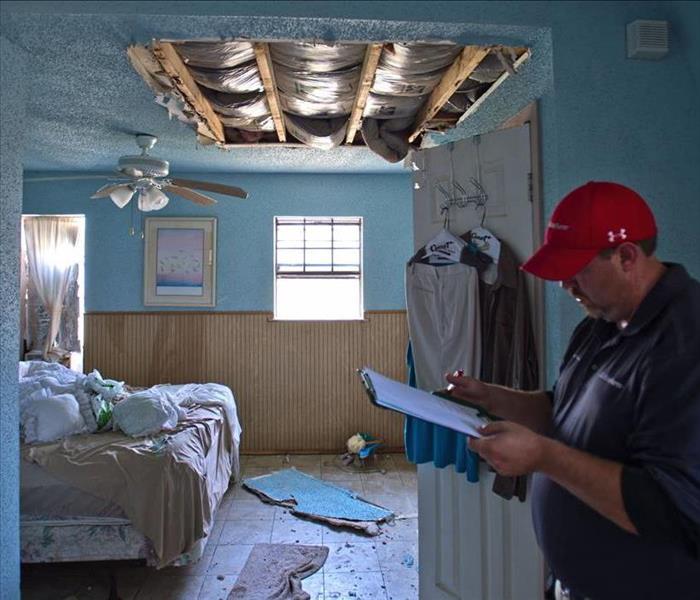 Get your insurance client the best help available by using SERVPRO and taking advantage of trained and certified technicians.
Get your insurance client the best help available by using SERVPRO and taking advantage of trained and certified technicians.
When homes are damaged in natural and other disasters, it is always in an insurance company's best interest to make sure that any damage is fixed properly the first time. When flood or water damage does not receive proper remediation, it can lead to much more severe and long-term damage. When insurance adjusters recommend companies that address damage properly and appropriately, they not only help protect the homeowner's property and save their company from having to pay even more expensive claims down the road but they also help strengthen and build stronger relationships with their clients. Here are three reasons why insurance adjusters should use and recommend SERVPRO to all of their insurance clients.
1. Locally Owned and Operated, Nationally Known
SERVPRO is a chain of locally owned and operated franchises that make up a network of over 1,700 operators across the US and Canada. That means we all benefit from understanding the unique needs of the communities and geographical areas we serve as well as having access to a wealth of information and experience from other franchise owners across the country. With that many franchise owners all working together, you can rest assured that the needs of your clients will be handled quickly and professionally.
2. Workers Ready and Waiting
Unlike other types of structural damage, water damage must be addressed immediately to have the best outcomes. When hurricane season hits or other natural disasters strike, other companies can be overrun with requests and it can take several days or even weeks to get teams out to help mitigate the damage. This leaves anxious homeowners susceptible to being taken advantage of by a number of scam artists that quickly move into the area in the wake of any natural disaster. SERVPRO, on the other hand, can call upon any number of regional franchises to get additional help in place whenever and wherever it is needed, so your clients get the high level of expertise they deserve.
3. Start to Finish Service
We understand that it's not enough to just simply do a great job restoring the homes of your customers. It is also important to keep costs low, provide a clear paper trail of all work performed and even save you the headache of dealing with multiple vendors. We offer a National Call Center that is open 24 hours a day, 365 days a year to help you promptly handle all claims. We also pre-screen all vendors to ensure they are fully qualified, insured and licensed when necessary. Our Claims Information Center maintains a complete electronic job file, which we can provide to you at any time and within hours of any claim. The file includes a detailed estimate, digital loss photos as well as a "First Notice of Loss" and scanned forms and paperwork which can be delivered either by email or hard copy. We don't just provide a superior level of service to your clients, we also offer that same superior level of service to claims adjusters as well.
We understand that to be the best in the business, we can't just offer superior restoration service. We also have to offer superior service to insurance companies to help you gain a competitive advantage. All franchisees are trained to IICRC standards in Fire and Water Cleanup and Restoration as well as offering continuing education classes to both Franchise Professionals and Insurance Clients at our state of the art IICRC Approved Training Facility. Our performance standards are both measured and well-documented, which can help provide increased value to you, your shareholders, managers, and customers.
Preparing a High-Rise Building For Water Damage in Orlando
5/27/2020 (Permalink)
 Water damage can compromise the structural integrity of your property. This makes damage prevention especially important for high rise buildings.
Water damage can compromise the structural integrity of your property. This makes damage prevention especially important for high rise buildings.
How To Prepare Your Orlando Business For Water Damage
One of the most challenging experiences an Orlando business owner can undergo is water damage. In addition to interrupting your daily operations, water damage can compromise the structural integrity of your property. However, learning how to prepare for this type of damage can prevent you from losing your emotional and economic equilibrium. Learn more about how to handle water damage by reviewing the steps and strategies outlined below:
Create an Emergency Plan
One of the fundamental things you should do to prepare your Orlando business is to create an emergency plan. This system will function as a guide for action if you are not present. Your contingency plan should include information regarding where all of the locations of emergency exits and fire extinguishers. It should also include the phone numbers of important people and businesses, including your insurance agent, the fire department, and your local SERVPRO.
Never Complete A DIY Project
In many cases, business owners want to start the cleanup process immediately after they experience water damage. However, this course of action is not prudent. In fact, there is a vast range of hidden dangers that water damage can cause on your property. Because most company owners are aware of these hazards, they can make themselves susceptible to both injury and illness by attempting to complete the remediation process on their own. Additionally, commercial property owners typically do not have the specialized equipment necessary to complete the restoration process with speed and skill. For this reason, it's important that you leave the remediation project to the professionals.
Selecting a Water Damage Restoration Company
Once you recognize that attaining professional water damage restoration services is important, you may be wondering how to find the ideal service provider. To ensure that you can get the best commercial water damage remediation services on the block, be sure to look for the following qualities in a company, like SERVPRO:
• 24/7 emergency services
• Excellent Better Business Bureau (BBB) rating
• Great online reviews
• Stellar customer service
• Satisfaction guarantee
• Established reputation
Call SERVPRO For Excellent Commercial Water Damage Services
When you find that your business property has been subjected to water damage, there's only one company to call for fast, friendly service: SERVPRO of Winter Park. All of our IICRC-certified technicians will offer you the detailed care necessary to restore your property quickly and correctly. We're ready to get your commercial property back in a pristine condition immediately, so call us today.
Locally Owned Company with National Resources
As a locally owned and operated business, SERVPRO of Winter Park is strategically located to respond quickly to your Orlando water damage and any emergency water event. Call us today! (407) 678-5391
Who to Call After Your Orlando Home Has Sustained Water Damage
5/27/2020 (Permalink)
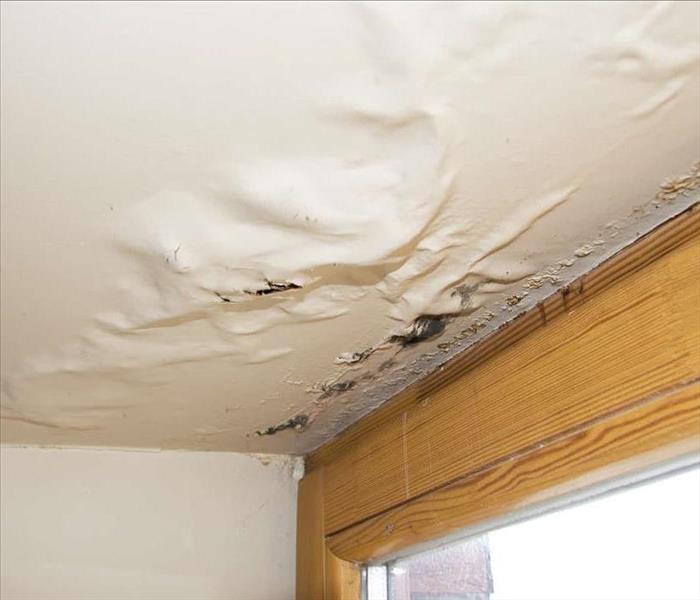 Having a professional at your property quickly following a water damage event can prevent further damage such as mold growth.
Having a professional at your property quickly following a water damage event can prevent further damage such as mold growth.
The Importance of Having Your Orlando Home Quickly Cleaned, Repaired and Restored After a Water Damage Event
As many homeowners know in the Orlando area, residential property subjected to water damage is susceptible to a large number of problems. In addition to possibly destroying your electrical system and the physical structure of your property, water damage can pose a plethora of health risks. And then the water flows along and leaves your personal possessions in ruins, more water damage! Despite these potential outcomes, help is a phone call away. A water repair and restoration company like SERVPRO can mitigate many of these events from ever getting out of hand by offering customized cleaning and restoration services. The key is to contact your insurance company and SERVPRO. Learn more about some of the steps that will be taken by this water removal company to restore your home to its previous condition.
Repairing Structural Damage
Another service that a water restoration company provides is the repair of structural damage your Orlando home may have sustained during the flood or fire. Unfortunately, water can cause substantial damage to the structure of your home. This repair and restore process can only start after the cleanup has been completed. The repair can then commence on damaged ceilings, wet drywall, and substructure work to any electrical and plumbing issues. Water can also adversely affect the sturdiness of the foundation and weaken the structure's framing. Water can make your home unsafe to enter.
Conclusion
If your home has been adversely affected by a flood or has incurred water damage due to the effects of a fire, it's important to know that a professional water removal company can assist you. These experts can help prevent secondary water damage and ensure that your home is safe and sanitary. Your search for immediate help should stop with SERVPRO. Our company's professionals are precise and passionate about offering the services necessary to get your home back to its original condition.
Locally Owned and Operated
SERVPRO of Winter Park is locally owned and operated so we are part of this community too. When you have a flooding or water emergency, we’re already nearby and ready to help. We take pride in being a part of the Orlando community and want to do our part in making our community the best it can be.
We are water removal experts and are ready to service your Orlando home. We're Faster to Any Disaster. (407) 678-5391
Tropical Storms Can Damage Your Home
5/20/2020 (Permalink)
 Strong winds from Tropical Storms can damage your home.
Strong winds from Tropical Storms can damage your home.
Damages from Tropical Storms
Tropical storms carry winds from 39 to 73 mph. They can also spawn destructive tornadoes. When wind speeds are lower, then storms are labeled tropical depressions. When wind speeds are over 73 mph, then they are called hurricanes, typhoons, or cyclones, depending on where they form. The biggest danger in a tropical storm front is its massive rainfall, causing severe flooding. The winds from tropical storms often lessen as they cross over land because the storms need warm water for fuel. However, they can continue to cause damage as they move inland. Tropical storms slow down as they move over cooler ocean waters.
Tropical storms now carry names like hurricanes and other damaging weather conditions. In the early 1900's, an Australian weatherman began naming their damaging tropical storms after people he did not like. In 1953, the U.S. also started naming tropical storms after women. Since 1979, both male and female names have been used by the World Meteorological Organization. In other parts of the world, like Asia, tropical storms are named for flowers, animals, people, and other things. In the U.S., there are no storms that start with Q, U, X, Y, or Z. If storms outnumber names, then they are named after letters of the Greek alphabet, such as Alpha or Beta.
It does not make any difference if damage to your home or business occurs from a tropical storm or a hurricane. Damages are usually the same for lives and properties. Even though a hurricane produces heavier rains, winds, and flooding, a building is still subjected to substantial damage. A tropical storm's damages include wind, rain, storm surge, mud, debris, etc. Every insurance policy is different, therefore, if you are not sure what types of damages are covered under your plan, speak with your insurance agent to make sure that you have coverage for damages that a tropical storm can cause.
When your home or business is gravely affected by a tropical storm, call us, your trusted leader in restorations and repairs – SERVPRO of Winter Park! We make our customers, our primary concern so that getting your lives and property back to its pre-damaged state is less stressful. After a tropical storm, you need help right away. Since we are near your community, we offer immediate response times. Our Disaster Recovery teams of certified experts are available 24 hours a day, seven days a week. We will also help you with processing claims to your insurance company. All of our skilled workers will perform to your complete satisfaction!
Avoid Smoke and Fire Damage UCF With These Tips by SERVPRO
5/20/2020 (Permalink)
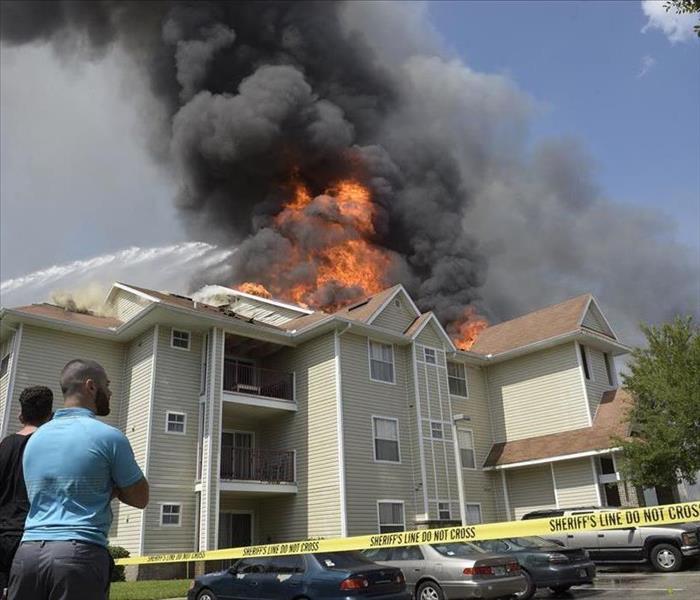 Having an escape plan will minimize your risk of injury or worse in the event of a fire
Having an escape plan will minimize your risk of injury or worse in the event of a fire
A vigilant approach is the best way to avoid a house fire. By taking the proper precautions listed by SERVPRO, homeowners can protect their house from smoke and fire damage.
Creating an Escape Plan
A National Fire Protection Association survey revealed many homeowners overestimate the time they have to escape their house during a fire. Since a home fire is an unexpected, high-stress event, it is imperative to create an escape plan. The ideal plan has an exit strategy. A minimum of two ways to exit each room when possible, and ensure windows and doors can be easily opened. Nobody should reenter the house to retrieve pets or belongings after escaping the fire.
Following Safe Electrical Guidelines
According to the U.S. Fire Administration, 280 people die, and 1,000 more people are injured in America every year due to electrical fires, many of which are preventable. Homeowners should:
- Matchlight bulbs to each light fixture and lamp's recommended wattage.
- Plug all major appliances into an outlet instead of a power strip or extension cord.
- Talk to an electrician about installing AFCIs or arc fault circuit interrupters, to shut off electricity in the event of a dangerous arcing fault.
- Use a single heat-producing appliance in each outlet at one time.
Installing Smoke Alarms
When it comes to fire prevention, smoke alarms are an essential preventive tool a homeowner can use. Statistics from the American Red Cross show that 65 percent of deaths from home fires occurred in houses that did not have an operable smoke alarm. All smoke alarms should be interconnected, so they sound off when smoke is detected, and alarms should be replaced every 10 years even though they still work. Homeowners should also make sure to install detectors in the basement, in every bedroom, outside each bedroom door, on every level of the home and ten feet or more away from cooking appliances.
Practicing Cooking Safety
Fire damage caused by cooking accidents costs homeowners $1 billion according to the National Fire Protection Association. Because cooking is a common home activity, it carries serious safety risks. SERVPRO recommends that homeowners:
- Never leave cooking food unattended.
- Store flammable materials in a location away from the stove and oven.
- Use a timer while cooking to prevent them from falling asleep or forgetting about the cooking food.
SERVPRO vs. the Other Guys
5/6/2020 (Permalink)
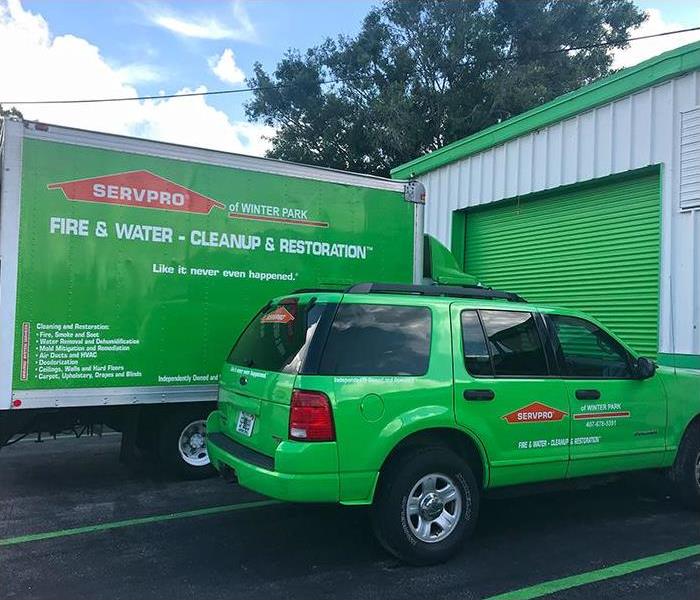 Choosing SERVPRO means that you have chosen a team of experts with the knowledge, experience, and capabilities of getting the job done right!
Choosing SERVPRO means that you have chosen a team of experts with the knowledge, experience, and capabilities of getting the job done right!
When disaster strikes in your home or property, you are faced with a choice between many restoration companies in your area. There are many important factors you should consider before making a final decision. Most instances of water damage, fire damage, and mold remediation are stressful from the beginning and your choice of a company to remedy the issues can determine how stressful your situation will be moving forward. Here are some key factors that should be considered.
1. How Long Has the Company Been in Business?
New restoration companies come along quite often. There is a benefit to using a company that has been around for years and established an extensive amount of experience performing jobs in your specific area. Since 2011, our locally owned and independently operated franchise has been servicing and building amazing relationships in Orlando, Winter Park, College Park, Baldwin Park, and Maitland. Going with a company with years of experience usually means that there is a greater chance of reviews being available as well.
2. How Are the Company’s Reviews Online?
Reading reviews before deciding on a company is a great way to get foresight on how well services will be provided for you. Aside from looking for good reviews, also check to see how many reviews the company is getting. It is easy, even for a bad company, to get a few good reviews. However, having a high overall review rating with a large number of reviews usually shows that customers tend to have a positive experience with that company’s reviews. Even the best company can have a few bad reviews. In these cases, see if the company has responded to the review and offered any reasonable solutions. If bad reviews are common for the company, it may be best to find an alternative. Some good places to search for reviews include Google, Facebook, and Yelp
3. Does the Company Have Certifications?
Make sure the company you choose is certified and trained to handle the task at hand. For example, at SERVPRO of Winter Park, our technicians are IICRC certified and trained to handle mold situations correctly, keeping the client’s and their own safety a priority. Part of this training is knowing to keep an area contaminated with mold completely sealed off and contained so that non-affected areas remain so.
4. How Fast Can They Mobilize?
Hiring a restoration company that can quickly arrive when needed should be a huge factor in your decision. The extent of water damage to your property can increase dramatically the longer you have standing water present. SERVPRO of Winter Park can be at your home fully equipped to extract and begin drying in an hour or less.
2020 Hurricane Season Safety Tips
5/1/2020 (Permalink)
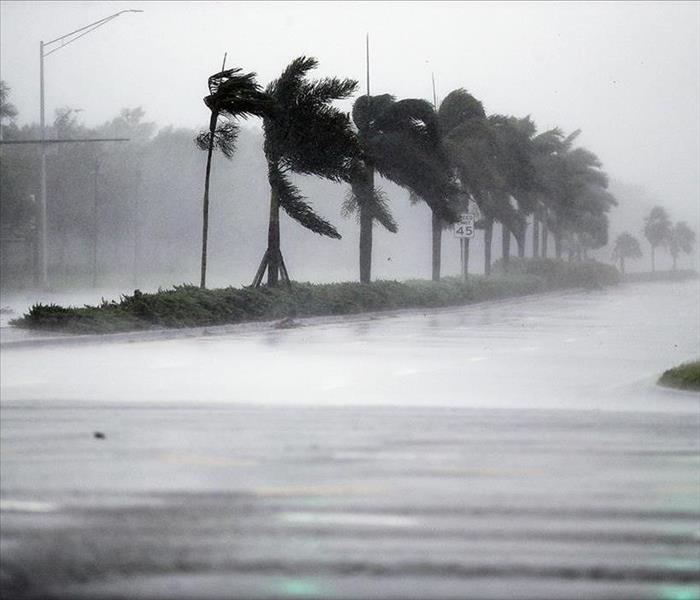 The 2020 Hurricane Season is predicted to have stronger hurricanes than is typical making it important for Florida residents to put safety first
The 2020 Hurricane Season is predicted to have stronger hurricanes than is typical making it important for Florida residents to put safety first
Hurricanes can be terrifying. Even a minor storm often leads to a trail of destruction stretching for miles once the storm passes. While hurricanes are dangerous, the good news is that it is possible to prepare for them. As hurricane season creeps up, hurricane safety needs to be a priority. All those living in hurricane-prone areas should and must make hurricane safety one of their primary concerns. The good news is that it is possible to mitigate the worst effects of any storm. Advanced preparation and careful attention to detail are the keys to coping with any hurricane season.
Evacuation Plans
In many instances, it is apparent where a hurricane is headed. Weather forecasters can often see the potential path of any hurricane at least several days in advance. Now is the time to think about what is going to happen should you be in the path of that storm. It's a good idea to look for local resources. Many communities are well aware of the possibility that hurricane season may have a huge impact on their area. They take advance steps to ensure that all residents have a safe place to stay or a way out no matter the strength of the storm.
For those with special needs, hurricane safety is especially important. Seniors may need medications as well as wheelchair accessible shelters. If you have a baby, they may need a formula or a safe area to prepare it. This goes true for other supplies. A supply of diapers and changes of clothing should ideally be readily available. Pets also need special care during a storm. Some shelters want to make sure people with allergies can come there so they don't allow any pets. Find out which shelters nearby let you bring your pets with you so they can stay safe.
Food and Supplies
Food and other supplies may be at a premium in the period before, during, and after the storm. As the season begins, now is the time to create a list of things you're likely to need. If you're taking daily medications, you need to know where they are and make sure you have at least a week's supply on hand. Create a bag with your supplies in easy reach. If you're staying, you should have food that won't spoil and water that is safe to drink. Items that don't need to be refrigerated like nuts and snack foods can fit in nicely in any packed bag.
Other items should also be in easy reach. Power may be off temporarily for an extended period. Flashlights with plenty of spare batteries are essential. Make sure you know where they are before the storm season starts. Banks can be out of cash. Credit card machines may not be working. Keep a certain amount of cash in a safe and easy to reach the place before the season begins. A cell phone is also a must. Chargers should be available so you can use them at home and on the road.
Insurance Policies
Many people carry insurance against hurricane damage. Know what those policies cover before the season starts. You may need to access your policy number. Keep insurance policies and other important documents with you or nearby. It's a good idea to examine all of your rooms before the season starts. Take detailed pictures of your belongings. This way, once the storm hits, you'll have the documentation you need to prove to your insurance company exactly what was lost. Detailed personal records can also help you get things back as you want once the storm is done.
Fire Damage Repair Process
4/23/2020 (Permalink)
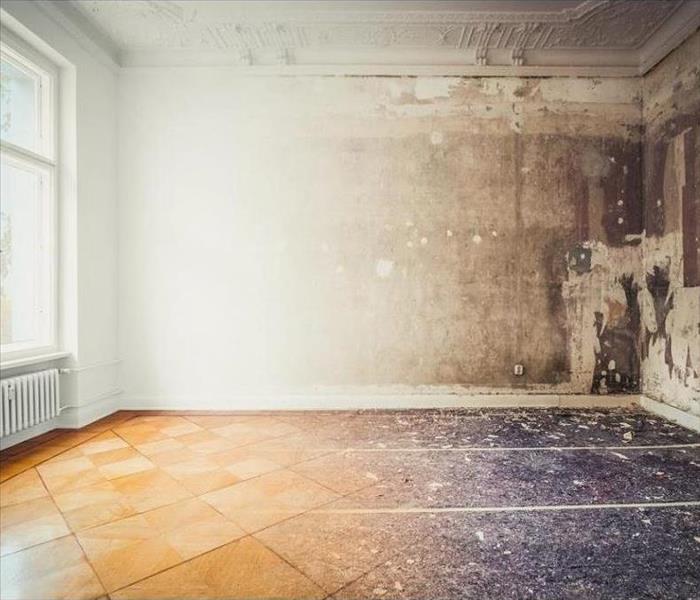 Only professional fire restoration experts are equipped to properly return your property to its previous state following a fire!
Only professional fire restoration experts are equipped to properly return your property to its previous state following a fire!
How Do You Restore Fire Damage?
Fire is incredibly dangerous. Even a small fire can cause massive harm to any structure. If your home has been damaged by fire, you'll want that fire damage restoration process to begin immediately. The good news? The process is highly detailed and includes all areas of your home. When you work with a fire damage restoration company, you're working with experts. They know exactly how to get rid of the damage. They'll rid your home of all fire-related problems and make it easy to move back in.
A Complete Assessment
The first part of the process consists of a complete examination of the entire area. Fire damage can be very subtle. Even areas that seem just fine may have issues that are hard to spot. An expert can see weakened floorboards and support beams that may have suffered stress when touched by smoke. They'll make sure these problems are remedied before they become much greater and possibly cause even more structural problems.
Dangerous Areas
Another crucial part of creating a space in the aftermath of a fire is making sure the place is safe. Both fire and the water and/or chemicals that are used to put it out give off unsafe fumes. These fumes can linger in the air even after the fire stops burning. Part of the process of removing damage caused by a fire is ensuring that areas that are not safe are discovered and then blocked off. It also means making sure such areas are not further damaged when exposed to outside elements.
Water Problems
When water is used to put out a fire, water can pool in the house. Water used this way needs to be removed as soon as possible. Fast-drying means the water can't stay there and lead to mold or even insect infestation.
Smoke and Soot
Soot can be in the air the aftermath of a fire. Fine particles from a fire can coat surfaces and cherished items. During an effective fire damage restoration, the company fully removes any existing soot from every possible surface. It also means getting the smell of smoke from the home. Modern air scrubbing technology means no more smoke odor.
Cleaning and Damaged Items
Once the initial restoration process is underway, it's time for a more thorough look. Items that are totally unsalvageable must be hauled away and discarded using all necessary safety procedures. The remaining surfaces can then be completely cleaned.
Finishing Up
Determining damage and cleaning up areas hurt by soot and smoke are the first part of the process. The second is repairing it all. Walls that need new drywall can be redone. Areas in need of painting can be painted again by professionals. Other issues such as carpets and flooring that are hit badly by smoke will also be restored to their desired condition.
It can feel bewildering and scary in the aftermath of a fire. Contacting professional restoration experts is the best way to move past such damage and come home.
How Coronavirus Can Affect the 2020 Hurricane Season in Florida
4/22/2020 (Permalink)
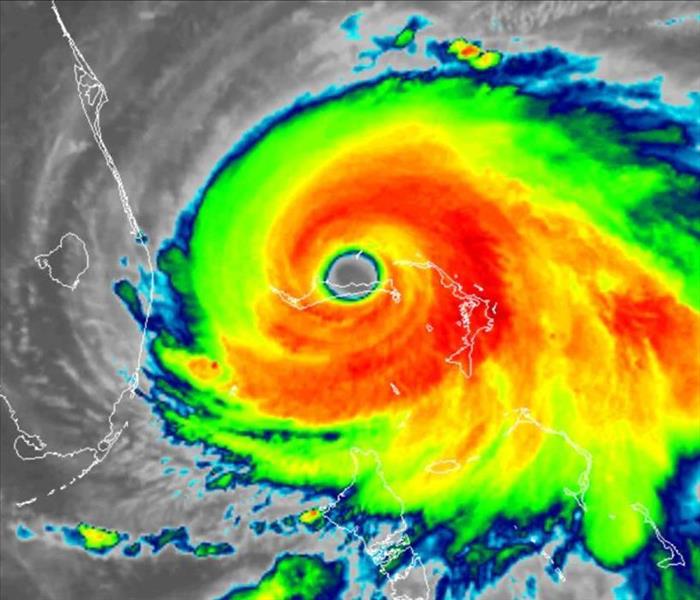 2020 hurricane predictions are showing a potential increase in activity this season
2020 hurricane predictions are showing a potential increase in activity this season
Hurricanes are a fact of life. In the southeast, people have learned to prepare for hurricane season. Hurricanes typically strike this part of the country between June 1st and November 1st. During this time, people can expect more hurricanes to strike the coast and head inland. This year, hurricane season poses a particular challenge. In the face of the ongoing COVID-19 pandemic, people from all walks of life are wondering exactly how to respond. Weathermen, epidemiologists, and all those involved in speaking to the public are trying to figure out the best way to proceed as they head into this season.
The Impact of COVID-19 on Hurricane Season
One thing is for certain. The Coronavirus has already had an impact on the way people think about the summer and the impact that hurricanes will undoubtedly have on travel plans and for residents of places that are highly affected by these storms. As March falls into April, this is when many people in Florida start to hear messages about what they should do to make plans. Instead of working towards a comprehensive plan to cope with expected issues related to hurricanes, officials have focused their attention largely on efforts related to the Coronavirus crisis. Two hugely important conferences related to early preparations, the Florida Governor’s Hurricane Conference, and the National Hurricane Conference have actually been canceled. In doing so, first responders and other officials have lost out on opportunities to learn about new developments that might make for more efficient responses based on recent data.
Several Plans Are in Place
Florida is going to be hit hard by COVID-19. Officials do not expect to hit peak until early May. Thirty-six deaths are expected daily when hurricane season hits. In addition, it is also possible that the region may experience later waves of infections in the fall. As that is the height of the season when storms are traditionally at their strongest, it is clear that officials must figure out new ways to ensure that all those are safe even when a storm is about to make landfall.
With that goal in mind, certain guidelines are being developed by experts. One question becomes if those who are infected with the virus should be sent to separate shelters. Guidelines in place already limit how many people can be in one place at one time right now. Local governments may need to create more shelters and spread them out further in order to keep people safe from the virus and from the hurricane at the same time.
Some people have special medical needs. They may need to have room for attendants on hand who can assist them with basic tasks in the middle of a hurricane. Those who are suffering as a result of the virus will need to be moved carefully if a medical center is threatened with a massive storm. Given the issues with the pandemic, it is also likely that even those who are healthy may be worried about moving into a shelter for fear of being infected.
An Active Season
Weather forecasters believe the coming year will probably be an active season for hurricanes. This means a busy season when at least several hurricanes will head to land. Floridians need to take special care from August to October. Certain areas are especially vulnerable. Areas such as the Keys are dependent on tourism for much of their income. That leads to increased unemployment and decreased funding for locals. Other areas along the coast are also hard hit because of prior issues such as heavy rainfall. The question becomes if officials at health and other organizations can cope with the new problems.
While this is all scary for many locals and public officials, those at FEMA are confident they have what it takes to manage a pandemic and any hurricane at the same time. Other officials are also hopeful the worst of the pandemic will pass them by before the really bad hurricanes begin. They believe that deaths and infections will likely begin to taper off by that time. They also believe they have the financial resources to cope with it all. It is clear that procedures are in place to combat the storms and the pandemic.
Water Damage Services Available Through COVID-19 Pandemic
4/22/2020 (Permalink)
 Our employees will practice social distance and wear safety equipment to protect themselves and our clients during COVID-19
Our employees will practice social distance and wear safety equipment to protect themselves and our clients during COVID-19
Our Valued Customers
As the coronavirus (COVID-19) continues to disrupt daily life, SERVPRO of Winter Park wants to assure homeowners and business customers that we are taking steps to help our employees and customers stay safe and healthy.
Aside from offering services to help sanitize and prevent the further spread of the virus, we are remaining available to the public 24/7 in the event of water damage emergencies. We understand that water disasters can happen at any time, without warning, and with or without a global pandemic.
Changes in the Process?
The majority of our Water Damage Restoration process will remain the same. The work that needs to be done to ensure proper water removal, structural drying, and mold growth prevention does not change. However, we will be taking extra precautionary measures to ensure the safety of both our employees and you, the customer.
We ask that social distancing be applied during water damage jobs and are instructing our water technicians to keep a distance of 6 feet from anyone within the home or business.
Our technicians are also provided with extra safety equipment to safeguard them from the invisible Coronavirus which can spread so easily. Although the water job may be simple and does not require it itself, our technicians will operate with safety as a first priority and will be equipped with masks and gloves for each and every job.
Our goal is to continue providing necessary emergency services to our community without also being a part of the issue. We will continue to operate with the best interest and health of all parties in mind. We ask that our clients notify us if anyone in their home or business has shown any symptoms of this virus prior to beginning work. Most importantly, we want our clients and the Central Florida community to know we are here for them and will do our part to get through this pandemic together!
Water Damage Services in Downtown Orlando
2/25/2020 (Permalink)
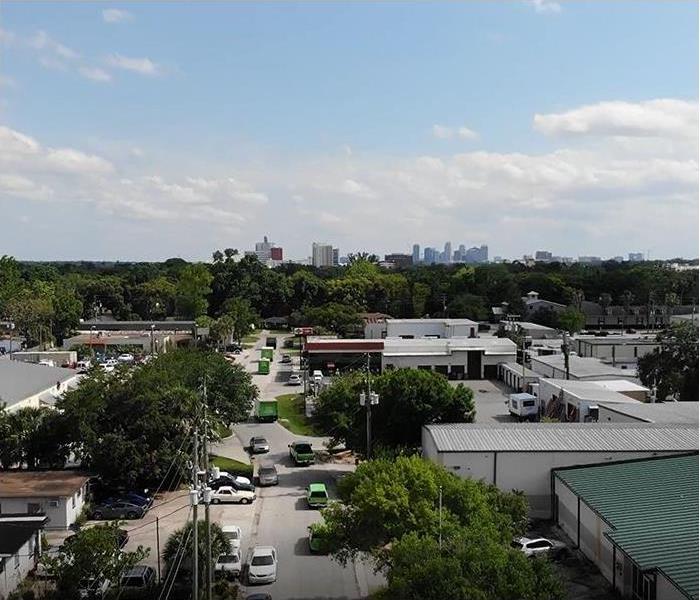 An aerial view above our warehouse shows just how close we are located to downtown Orlando
An aerial view above our warehouse shows just how close we are located to downtown Orlando
Water disasters come in many forms such as pipe bursts, water heater malfunctions, sink or toilet overflows, damaged ice maker lines, overflowing drip pans in air conditioning units and weather-induced flooding, just to name a few. With the near-endless opportunities for damage, it is important to know how to effectively deal with a disaster if it is your turn to experience one. A quick search on the internet will show that there are plenty of restoration companies servicing the downtown Orlando area. Among those companies, SERVPRO of Winter Park is the safest choice.
Why Should You Choose Our SERVPRO?
Distance from Downtown Orlando
Whether you own a nightclub, manage an office space, run a restaurant, live in a skyrise apartment, or own property in downtown Orlando, one thing is for certain. If you have water damage you need help fast. Many other restoration companies serve ads and also appear in online searches for water services in the downtown area, however, that does not necessarily mean that they have the fastest response time for the area, regardless of what they claim. SERVPRO of Winter Park has the fastest response time because we are physically located just north of downtown. The main image on the upper right side of this blog post captures an aerial view above our warehouse showing just how close we are.
Commercial-Scale Capability
SERVPRO franchises come in all sizes and our Winter Park location is one franchise that has the equipment and manpower to handle large commercial-scale water jobs. We have a large fleet of trucks that are equipped with mounts to hold an excessive amount of water. When we mobilize and arrive at a commercial water disaster, we can remove water from the property at an accelerated rate. SERVPRO of Winter Park also has two large warehouses nearby, enabling us to both keep a large quantity of equipment ready and store furniture and belongings offsite for clients.
Trained Water Damage Technicians
In today’s world, which is very pro DIY, handling a water situation incorrectly can lead to even more damage. When you choose to use our company to help your disaster, you can rest assured knowing that your property is under the care of experienced professionals that have been trained, tested and are equipped with the knowledge to handle various situations. Our experts on the ground will be able to walk you through the process every step of the way.
Discreet Services Available
Our franchise has a ton of experience in working with clients that require a more discreet approach such as theme parks or businesses that do not want to interrupt the flow of business by having big green SERVPRO trucks near their entrance or storefront. We completely understand this and consider every client’s needs before beginning work. We also respect company brands and make sure that logos or locations are not posted on social media channels.
Direct to Insurance Billing
Dealing with insurance can be a hassle with any claim and property damage from water is no different. Fortunately, SERVPRO is a preferred vendor for many of the large insurance companies and we are extremely capable and used to dealing with adjusters directly. This includes working closely with your adjuster to write estimates, determine line items covered, and finalize a bill. Our hands-on approach with your insurance takes extra pressure off of our clients and allows them to focus on their actual property. We can even bill your insurance directly in most cases.
What is the Water Damage Process Like?
The severity of a water damage situation can differ greatly and add new components to the process needed to effectively remedy the issue. All variables have to be considered before we begin. For example, a heavily saturated carpet may be salvaged but the padding underneath will have to be removed. Likewise, a water disaster resulting from a sewage backup will require additional cleaning and sanitization. However, regardless of the situation at hand, the base of the overall process stays the same for the most part. Here is what you can expect when giving us a call:
- Our office staff will answer your call and record all the information necessary to mobilize our technicians with the right amount of equipment for your specific situation. If an insurance claim was made, they will also take your claim number and insurance company name to work with your adjuster.
- Upon arrival, our technician will assess the damage to determine the amount of equipment needed as well as record the necessary information needed to begin building a damage estimate.
- If standing water is present, we will remove baseboards and immediately begin extracting the water from the property removing as much moisture as possible.
- Drying equipment such as high-powered fans and dehumidifiers will be strategically placed to dry affected areas as quickly as possible.
- Non-salvageable components of affected areas such as carpet padding and drywall, which acts like a sponge and can draw water up past the flood line, will be removed and discarded.
- Our general contractor will replace and restore items that were discarded during the water loss.
- SERVPRO of Winter Park will provide you with a bill or invoice your insurance company directly if a claim was established.
Have You Experienced Water Damage in Downtown Orlando?
There are many companies to choose from to help you with water damage in downtown Orlando. However, if you are looking for the fastest service without having to sacrifice quality, SERVPRO of Winter Park is the logical choice in your area. Give us a call today at (407) 678-5391 and remove that water from your property!
Forming a Fire Evacuation Plan Effectively
1/29/2020 (Permalink)
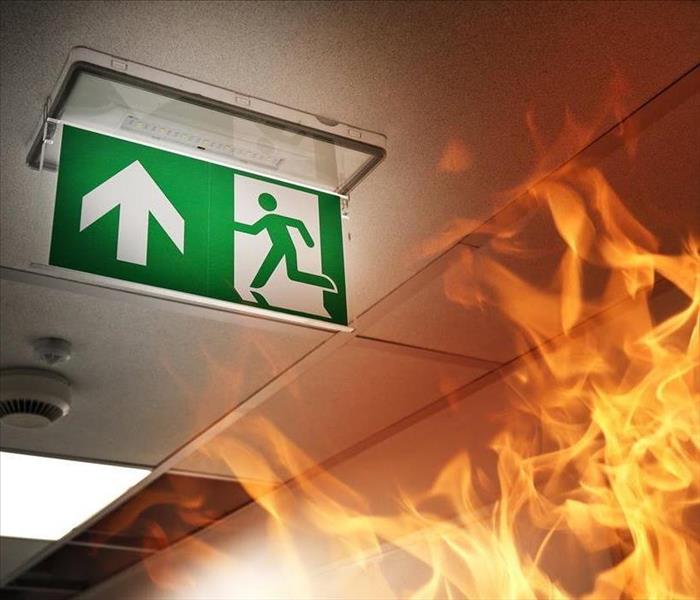 For businesses, using signs and practicing your fire evacuation plan with employees can help ensure their safety in a disaster.
For businesses, using signs and practicing your fire evacuation plan with employees can help ensure their safety in a disaster.
A fire evacuation plan is a written or verbal blueprint for how to remove people from dangerous smoke or fires. Not having a plan can lead to confusion and chaos as well as possible injury or death. Of course, no one ever imagines that a fire will happen at their home or business. However, a small spark can quickly turn into rampant flames, and wildfires can rapidly move into residential areas. Therefore, it is vital that home and business owners prepare to evacuate at a moment’s notice.
The Benefits of Having a Fire Evacuation Plan
As mentioned, it is important to have fire evacuation plans in place in order to protect against injury and loss of life. While this is certainly the most important benefit, it is not the only reason why it is important for you to draft a plan as soon as possible. If you are a homeowner, you should know that fire can spread quickly throughout your residence. In fact, you most likely only have two minutes to get your family members and yourself out of your home after hearing the smoke detector. A plan will help you move quickly without giving in to panic.
As an employer or manager, OSHA most likely requires you to have some type of emergency preparedness plan in place. Your plan will also benefit you by setting up a clear chain of command and by giving employees regular opportunities to practice evacuating. When employees know what to expect, they will be able to move faster while maintaining a sense of order even in the face of danger. It can be difficult to think about danger entering your home or business, but taking the time to craft an evacuation plan significantly improves everyone’s chances of survival.
A Thoughtful Plan for Homeowners
If you are crafting a plan for your family, you must first consider the possible ways to escape from your home. After drawing out these routes, you should let all family members know what they should do in case of a fire. Tell them how they can escape from the home, what they should take with them, where they should go and how they can contact you or another close family member. You may want to set up a safe spot in your neighborhood and include plans for rescuing pets. Write down every part of your plan, and regularly practice evacuating with your family members.
Next, complete your plan by building a disaster kit. This bag should be placed next to the primary emergency exit in your home so that someone can easily grab it while running to the safe spot. Include emergency health information, cash, extra clothing, telephone chargers and other items that will help you connect with each other, maintain your health and rebuild your life following a fire.
A Well-Crafted Plan for Business Owners
Fire evacuation plans for business owners have similar goals but can be more detailed because of the larger size of the building and the number of employees present. The plan should first establish an emergency preparedness team. This team will be responsible for crafting the rest of the plan.
Evacuation routes are vital and should be posted near doors in every room of the building. Evacuation plans should also prepare for certain contingencies, such as blocked stairways. The plan should tell employees what they should do if they spot a fire and where safe evacuation locations are. Finally, the team should schedule regular evacuation drills at least once each year so that employees can memorize their responsibilities.
Restoration Following Fire Damage
Should a fire break out in your home or business, your primary goal is to protect the lives of those under your care. However, once the danger is past, you will quickly recognize a new goal, which is to repair and rebuild what was damaged by the fire. Professional help is vital for repairing damage to walls, floors, and ceilings from smoke, soot, and fire. Plus, you will need to consider addressing the water damage that occurred from firefighting efforts.
At SERVPRO of Winter Park, FL, we can provide quick emergency services for homes and businesses. With plenty of training to respond to any type of fire disaster, our technicians will help you restore what you have lost rather than making you replace all your damaged property. Not only can this ease your financial burden when filing an insurance claim, but also it can let you get back to your life as quickly as possible. If your home or business has sustained fire damage, make sure to give us a call at (407) 678-5391 to get your property back to the way it was.
Is Insulation Salvageable Following Water Damage?
12/11/2019 (Permalink)
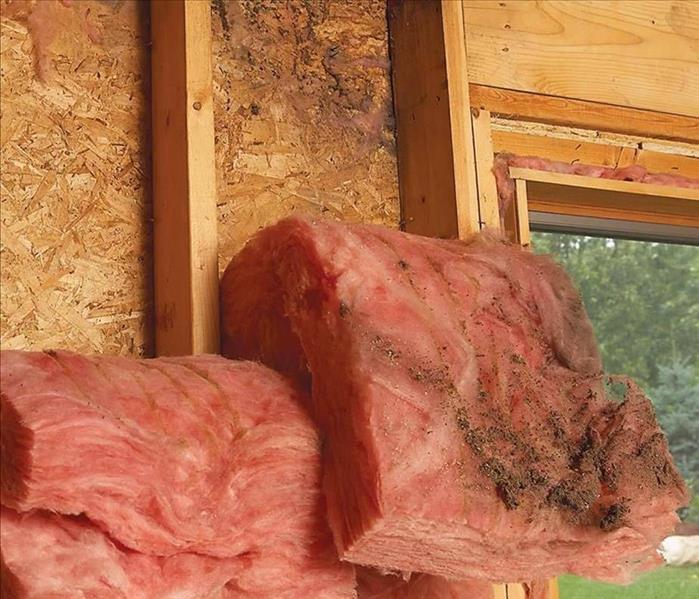 Insulation that is affected by water damage can lead to structural damage from both wood rot and mold growth
Insulation that is affected by water damage can lead to structural damage from both wood rot and mold growth
Homeowners who have experienced water damage from a leaky roof or a burst pipe often ask us if they can salvage the insulation in their attics or walls that have been exposed to large amounts of water. Theoretically, the answer is yes in many cases. Some popular types of insulation include fiberglass blanket, blown-in cellulose, and foam board. Depending on your type of insulation and level of water exposure, it’s possible to dry out wet insulation and put it back in its place. However, doing this takes a lot of time and effort. Here are four good reasons to replace your insulation and not salvage it.
1. Reduction in Insulating Performance
Your home’s original insulation that was installed by your builder has a rating that impacts how hard your HVAC system works to keep your home comfortable. If fiberglass or cellulose insulation products become wet, they lose their insulating properties. While it’s possible to dry fiberglass insulation, cellulose insulation is made of paper fibers and is harder to dry when water damage is widespread.
2. Invitation for Mold Growth
The presence of mold has been linked to various negative health effects. Mold needs moisture, food, and warmth to survive and thrive in your home. Wet insulation in your attic offers the ideal breeding ground for mold spores. Mold spores reproduce rather quickly. By the time that you realize your insulation is wet, these spores have likely already infested your old fiberglass or cellulose insulation. Homeowners who have foam board insulation aren’t entirely free from problems in this area either. While foam boards aren’t attractive to mold, the spores love attaching to the wood frames that surround them. The introduction of mold growth will have a serious impact on the amount you can expect to pay water damage and mold remediation companies to take care of your damage.
3. Encourages Wood Rot
Wet insulation that’s trapped in a wall cavity can weaken your home’s frame. If wet insulation isn’t properly removed or thoroughly dried, it can moisten your home’s wood framing and cause wood rot. This is also true of foam board insulation that doesn’t absorb water but that traps moisture close to surrounding wood frames.
4. Attracts Pests
Termites, carpenter ants and other pests love moistened wood, cellulose, and pulp. A colony of termites usually has over 60,000 members, and they can eat through a foot of a 2x4 in about a year according to industry experts. Termites cost American households millions of dollars in home repair projects each year. You can stop them in their tracks by fixing any leaks and replacing wet fiberglass and cellulose insulation with new insulating materials.
Conclusion
If you have experienced water damage in your property, SERVPRO of Winter Park is your first step towards taking care of your water disaster. We are expertly trained to remove all moisture and non-salvageable materials, such as installation, and get your property completely dried before mold begins to grow. We are also expert remediators should you already have a mold growth situation. Prevent further damage to your property and give the experts a call at (407) 678-5391.
Preventing Mold in Commercial Properties
11/20/2019 (Permalink)
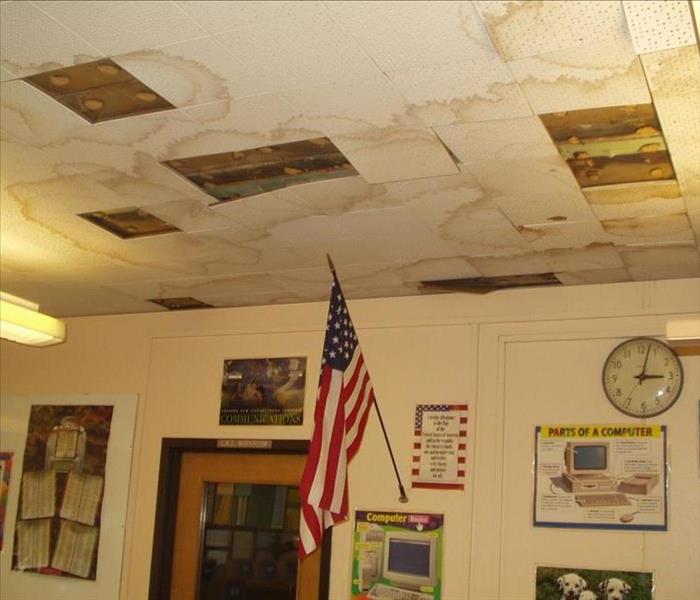 Commercial properties like schools should take precautionary measures to ensure any water damage incidents do not lead to mold growth
Commercial properties like schools should take precautionary measures to ensure any water damage incidents do not lead to mold growth
Mold growth in your commercial property can lead to structural damage to the property itself and health concerns for those exposed to it. There are many factors that can lead to mold growth as well as steps that can be taken as preventative measures. This article will cover both to keep you, the business manager or owner, better informed and prepared to handle a mold situation.
How Mold Can Spread in Commercial Properties
Mold thrives in damp, dark places. So you can find mold just about anywhere that moisture lingers in the air. Mold spores can cling to and grow on a variety of building surfaces including stone, brick, wood, drywall, and metal.
Here are three factors that contribute to the formation and spreading of commercial mold.
1. Moisture Due to Humid Conditions
When outside temperatures fall during the fall and winter seasons, mold often begins to form indoors where the air is warmer and more humid.
You can sometimes see condensation forming on the interior of glass windows and skylights. If this moisture drips down the walls and manages to penetrate into seams and cracks in the walls, it is very likely that mold will begin to grow.
2. Water Leaks From Roof and Plumbing
One of the biggest causes of mold infestations is leaks in the roof or leaky pipes in the walls. These leaks often go undetected for months or even years, allowing massive colonies of mold to fill the spaces in attics and inside walls and ceilings.
This water damage combined with mold can cause tens of thousands of dollars in damage, and it often will require entire facilities to be shut down for mold restoration and remodeling.
3. Condensation forming in an HVAC system
Other troublesome spots where mold forms in commercial buildings are the heating, ventilation, and cooling (HVAC) system. Due to the heating and cooling of the metal ducts and vents, condensation often forms on these surfaces that are hidden away from view. These dark, damp places become a breeding ground for various types of mold.
And the worst part is that the ventilation system then blows mold spores throughout the entire building. Those spores can lie dormant for a very long time. But once they come in contact with moisture, they can begin to grow and spread.
How to Prevent the Spread of Mold in Commercial Properties
Preventing the spread of mold should be a high priority for commercial property managers. Whenever mold or water leaks are discovered, swift action must be taken to prevent further growth and damage. Here are three strategies that need to be implemented consistently.
1. Inspect Moisture-Prone Areas Regularly
As noted above, the HVAC system needs to be routinely inspected for mold and moisture, particularly the evaporator coils and drain pans and pipes. Surfaces should be inspected, cleaned and disinfected once a year or more if necessary.
Roof tiles should also receive a professional inspection annually, and attic spaces should be checked for water damage too.
All kitchen and bath areas should be checked, including in the backs of cabinets and vanities, as mold thrives in dark spaces. And again, all surfaces should be cleaned regularly.
2. Clean and Disinfect All Surfaces Frequently
Routine cleaning cannot be emphasized enough. Not only should areas when mold and moisture are spotted be cleaned thoroughly, but all floors, walls and counter spaces should be disinfected regularly to kill spores that lie dormant.
3. Use Dehumidifiers to Reduce Moisture in the Air
Lastly, some commercial buildings that have routinely humid conditions might benefit from the use of dehumidifiers placed throughout the building or in conjunction with the HVAC system. These remove excess moisture from the air and make it difficult for mold spores to grow.
Fighting commercial mold can be a challenge for business owners and commercial property managers, but by knowing what to look for - and by engaging in consistent and thorough cleaning practices - mold can be kept in check to provide a safe environment for everyone.
Preventing Mold in Your Maintenance Closet
11/18/2019 (Permalink)
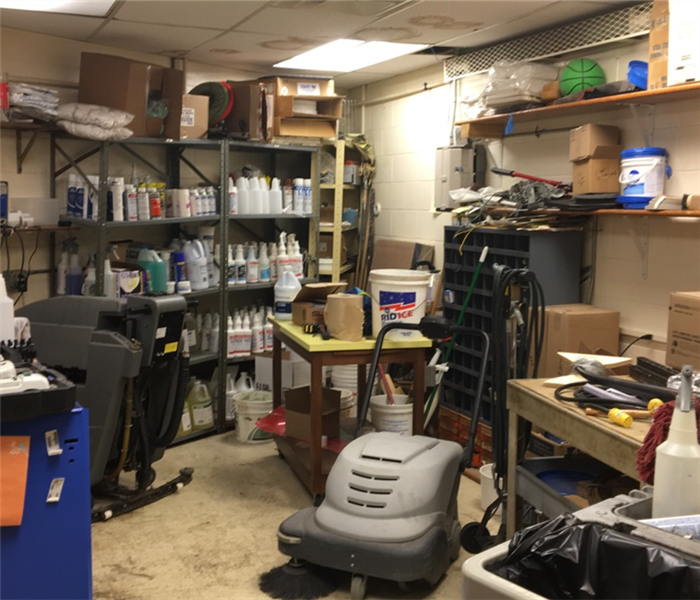 Maintenance closets are one of the most common places where mold growth is found in commercial properties.
Maintenance closets are one of the most common places where mold growth is found in commercial properties.
Lack of Air Circulation
Closets, in general, are a very common hiding place for mold. This is due to the fact that there is usually an absence of ventilation in closets. When you open a closet and then close it shut moist air can easily become trapped within. The moisture will usually lead to condensation on the wall without the chance of evaporation. This provides an excellent environment for mold to thrive in.
How to Prevent
The simplest task you can perform is to routinely check the walls in the closet for condensation. This can help you notice a moisture issue before it becomes a mold issue. However, the best way to prevent the problem is to create an avenue for air to circulate in and out of the closet. Installing air vents on the upper and lower areas of the closet door can help ensure better airflow and prevent moisture from being trapped
Leaking Water Heater
Many times, utility closets will share a space with a water heater. If the equipment has not been maintained, it is common for a leak to occur.
How to Prevent
Be sure to run routine checks on your water heater to make sure it is working efficiently for you and not causing a water damage situation in your closet which could lead to mold growth
Mop Buckets and Cleaning Supplies
Maintenance closets are usually deemed the perfect place for hiding mops, buckets, used towels, and other cleaning supplies. However, these items can lend to the moisture that gets trapped in your closet and leads to mold. This is especially true, for mop bucket spills!
How to Prevent
If possible, keep the items mentioned above away from your storage closet. If you must store them there, make sure that mop buckets are emptied and wiped dry. Mops should be squeezed of excess moisture and towels should only be returned to the closet if dry.
Floor Clutter
Clutter along the floor of your maintenance closet is the perfect opportunity to hide spills, moisture, and mold growth from your line of sight.
How to Prevent
Try to keep clutter to a minimum and put loose items on shelves in your maintenance closet. This makes it much easier to identify moisture on your closet floor or even cleaning after water damage that may have seeped into the closet.
8 Reasons Mold Can Keep Coming Back
10/28/2019 (Permalink)
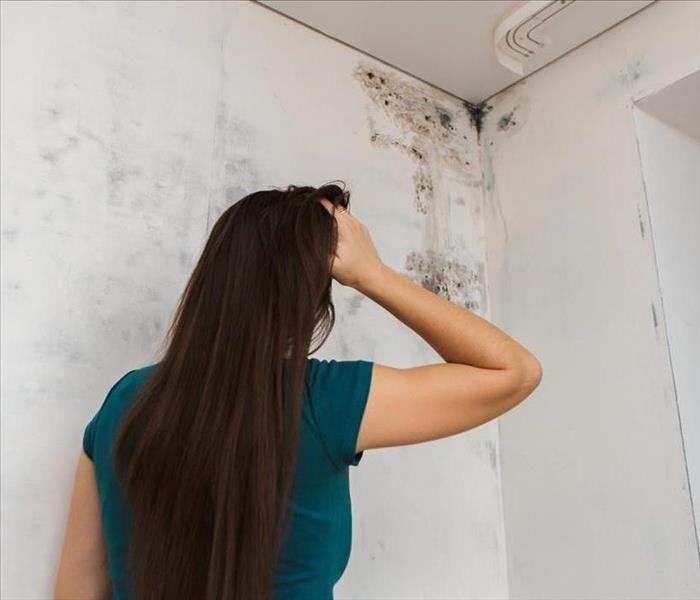 Many DIY solutions for getting rid of mold can be ineffective. Proper testing and remediation by professionals is the best way to prevent its return.
Many DIY solutions for getting rid of mold can be ineffective. Proper testing and remediation by professionals is the best way to prevent its return.
Mold is stubborn. It can spread throughout a property very quickly and even cause a variety of health issues for individuals who occupy the same space. Mold is extremely persistent and has been known to return even after it has been cleaned. Many homeowners and business managers make the choice to handle mold issues themselves and try using ordinary cleaning methods that just are not effective when dealing with this type of problem.
What is Mold Exactly?
Mold is commonly mistaken for and treated as a stain or dirt, however, mold is actually a living organism that grows, especially in damp places. Mold spreads by releasing microscopic spores into the air. In fact, mold spores are naturally in the air all around us. It is actually impossible to completely remove mold spores from the air. Understanding why mold can keep coming back can help ensure that you make the right decisions towards removing it if it becomes your problem to handle. Here are some reasons that mold can return in a property:
1. Neglecting Water Damage
Water damage can occur in numerous ways in properties including roof leaks, overflowing toilets, leaky pipes, faulty dishwashers, etc. Disasters happen. However, making sure that water is cleaned up and any moisture is removed from affected materials quickly can prevent further damage. Water damage that has been neglected or gone unnoticed can lead to mold growth in as quick as 48 hours.
2. Cleaning Porous Materials
DIY cleaning methods can sometimes be effective if the surface being cleaned is non-porous. Most cleaning methods will not work for porous materials, such as wood and drywall, because the mold will avoid the cleaning agent by retreating deeper into the material, only to resurface again later. Cleaning portions of the mold is ineffective if the nucleus is not destroyed. Affected materials should be carefully removed, discarded, and replaced to ensure the mold does not return.
3. Painting Over Mold
It is not uncommon to find that a previous mold problem was simply painted over to hide the temporarily hide the issue from new tenants or homeowners. The mold usually does not take long to eat through the paint and reappear. Not to mention, hiding the mold does nothing to solve the issue of damage spreading behind the wall.
4. Excess Moisture and Ignoring Source
Since mold thrives in damp areas, the first step to removing it is to reduce the moisture levels in a home. Disregarding the source of the mold issue only means that the problem may occur again. Call a professional to fix leaky pipes, broken air conditioning units, roof damage, etc. and use a dehumidifier to get the moisture out of the air. Similarly, it is important that all damp fabric is allowed to completely dry. Hang up towels so that they can fully dry. Kitchens, basements, and bathrooms are common places for mold.
5. Indoor Humidity
Mold is extremely common in Florida due to high humidity levels that allow mold to thrive. Making sure your air conditioning is running correctly and constantly can help prevent high humidity in your property making it more difficult for mold to grow. Indoor humidity that exceeds 60% can become a source for mold all on its own. Also, make sure that every room has proper ventilation so that any excess moisture in the air does not become stagnant and cause an ideal environment for mold to grow in.
6. Generic Cleaning Products
Generic or all-around cleaners will not work on mold. Bleach does not work for all species of mold. It can be effective on certain species of mold but inefficient for others sometimes making the situation worse. Make sure to experiment with natural alternatives and invest in mold-specific cleaners. Be generous as you spray and do not wipe it right away. The cleaner needs to work its magic and kill the living mold at its nucleus. The most effective method is to test for mold and receive a treatment protocol from a licensed mold assessor.
7. Keeping Affected Items
Some items may be permanently affected by mold. If an old couch has a lot of mold on it, you may have to get rid of it instead of trying to save it. Similarly, glass is easy to clean whereas wood is harder and will most likely have to removed and replaced. Wash clothing and discard any items deeply affected by the mold. This can minimize the risk of the mold spreading back to the structural components of your home. To be on the safe side, it is best to hire a professional remediation company with experience in salvaging materials affected by mold.
8. Not Consulting Professionals
If you have dealt with major water damage to your home, it is wise to try and get ahead of mold issues by consulting professionals. Experts know where mold is likely to fester, and they can use the best equipment and techniques to properly remediate the issue. You may not have the expertise to do everything yourself. They know why mold may be returning, and they have the tools to get rid of it for good. Investing in professionals' services protects your home, furniture and family's health. Proper air quality testing by an environmental hygienist can provide accurate insights into the type of mold you have, its source, areas affected, and how to remove it for your specific instance.
Mold is persistent and can grow very quickly. If you have tried to remove it and it returns, know that this is normal. Oftentimes, homeowners can make a mold situation worse, which makes the remediation more costly. For the best results, call in professionals to keep mold from returning. The quicker you act, the better.
Why Post-Remediation Testing is Recommended
10/14/2019 (Permalink)
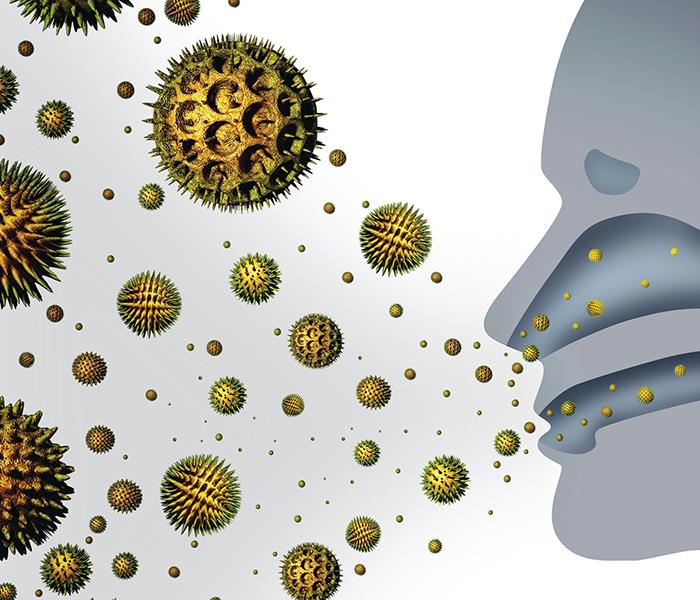 Mold spores are microscopic and when airborne, can help mold spread to unaffected areas of your property and also potentially cause health issues.
Mold spores are microscopic and when airborne, can help mold spread to unaffected areas of your property and also potentially cause health issues.
Mold is not always visible and is capable of hiding away quietly inside of walls and deep under foundations eating away at the crucial structures of your home. It is also very common that complications related to the health of those who come into contact with mold are reported. Mold remediation, the treatment and/or removal of mold, can be costly but not nearly as costly as a failure to address the issue. The longer mold goes unnoticed and unmitigated, the further it can spread and more damage it can cause. If you discover a potential mold problem, you should absolutely have it tested and addressed. However, remediation efforts should always be followed up with a post-remediation mold test. Here's why.
Leading Up to the Final Test
In order to diagnose a mold issue in the first place, mold inspectors will conduct a visual search but even more importantly, they will collect air quality samples. Mold often forms deep under foundations or behind walls where you can't see it but will permeate the air with mold spores. These spores are microscopic and when airborne, can help the mold to spread to unaffected areas of your property and also potentially cause health issues when breathed in.
Once the samples have been tested and it is determined that you have a mold problem, the inspection company will create a written mold remediation protocol that must be followed in order to properly treat or remove the mold issue. The problem, of course, is that once again you cannot see the mold, which means you will have no idea whether proper protocols were followed or if the mold issue was properly attended to. This is where the post-remediation test comes into play.
Why Do I Need the Post-Remediation Test?
A post-remediation test is sometimes referred to as a clearance test. It is essentially the same test that was conducted to find mold in the first place, only this time there should be no high concentrations of mold spores in the samples taken. If the air samples show the number of spores have been reduced to normal levels or below, the problem has been addressed correctly.
If proper protocols are not followed, however, mold will continue to grow without you being aware of it. A post-remediation clearance test is the only true way to determine if your remediation was successful. Ordering the test allows you to either have the peace of mind of knowing your home is mold-free or have the remediation company revisit the remediation to achieve the necessary results.
SERVPRO of Winter Park
Our franchise performs the remediation portion of the mold process and has certified professional mold technicians. We require a mold protocol before remediation and highly recommend performing a clearance test after. If you believe you have a mold issue and are seeking the help of a highly trained professional, give us a call today at (407) 678-5391.
Why a Mold Protocol is Required Before Remediation
9/18/2019 (Permalink)
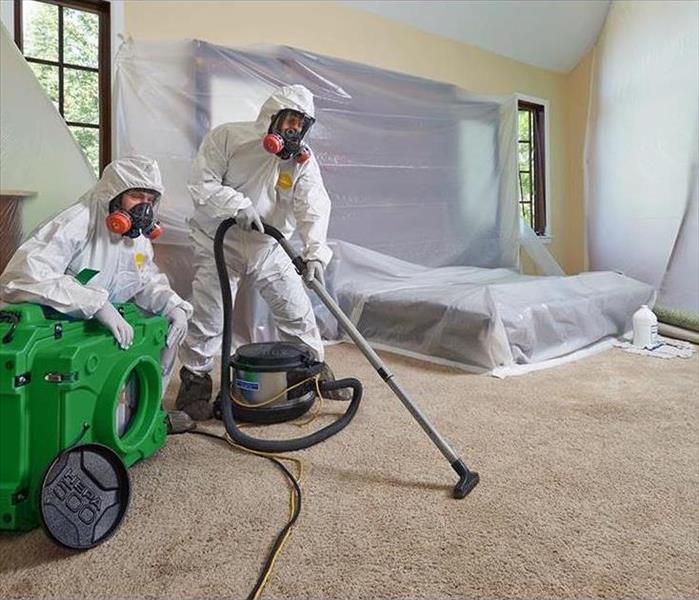 A written protocol outlines the necessary process that a company performing remediation must follow in order to achieve the best results.
A written protocol outlines the necessary process that a company performing remediation must follow in order to achieve the best results.
Mold Remediation Protocol
In the state of Florida, it is typically required that professional remediation organizations such as SERVPRO of Winter Park have a written mold remediation protocol in their possession before conducting any work. The protocol accurately assesses the proper treatment and removal of mold in areas of a building that have been affected by mold. Mold lab results can be combined with the findings of the professional mold inspection and an intimate understanding of the property’s layout. Using all of this knowledge and data, the remediation professionals can devise a plan that is tailored to the specific mold problems impacting a client’s property. Adhering to the protocol’s instructions ensures that the company performing the remediation can complete the process safely and promptly. Among other things, the protocol can specify when carpets, furniture, and other items that have been impacted by mold can still be cleaned and when it’s time for these materials to be removed.
Steps of the Protocol
The following are the steps required during the protocol process.
Interview
The property’s present conditions are surveyed and discussed with a person who is authorized to handle the property’s affairs.
Site Assessment
The areas that were affected are given a physical site assessment. The site assessment accomplishes several functions: the site assessment visually inspects the damage(s), gathers temperature and relative humidity (RH) readings, takes air samples and direct samples for mold (if necessary), and collects room dimensions to draft the required floor and room drawings to specify the location(s) of concern.
Air Sampling
Non-viable spore trap air sampling is designed to get an approximation of the concentration of airborne microbial (fungal) spores. The most commonly used entrance of the property is used to collect at least one outside sample. After the outside sample is taken, air samples are gathered in the property’s areas of concern. If elevated airborne spore concentration levels are detected, this may mean that there is one or more indoor microbial reservoir(s). It may also mean that the microbial remediation plan must include either the cleaning of the HVAC system(s) or of personal effects within the building.
Direct Sampling
Direct sampling is used to pinpoint the type and relative concentration of the microbial spores that have affected tested materials. The direct sampling results are also used as source contamination reference material during the air sampling process.
Florida State Guidelines
There currently are no federal guidelines in place concerning mold remediation and testing procedures. Certain states, including Florida, have qualification regulations in place for licensed Mold Remediators and Mold Assessors. In Florida, companies are not allowed to hold both an assessor and remediation license simultaneously. It is recommended that only Florida licensed Assessors or Remediators are used during both sides of the process.
Why is This Protocol Required?
There are two main reasons for this mold protocol: the potential for conflicts of interest and data that can be gained prior to any removal actions.
Conflict of Interest Potential
Most mold remediators in Florida will not take a remediation assignment without an independent mold assessment and protocol being performed beforehand. Some years ago, the state of Florida implemented licensure procedures for both mold assessors and remediators. The regulators were so convinced of the necessity of both of these services that it forbids a single company from taking on both roles for any given project.
Valuable Pre-Removal Data
The second reason why the protocol is necessary is that the majority of contractors will not start a remediation project without a protocol being conducted. Without the protocol, the contractors will not have reliable data on the extent of the spread of the microscopic spore and the particle varieties of mold contamination. Failing to have this data on hand before remediation can lead to accusations of subpar testing or adherence to procedure between the parties involved in the mold assessment and remediation process.
Benefits of the Protocol
The protocol ensures that mold contaminations are properly assessed to facilitate the remediation process. It protects property owners from having to pay for additional remediation fees. It also provides a safe and healthy environment for visitors, residents, remediation companies, and property owners.
SERVPRO of Winter Park
For properties in need of mold remediation, contact SERVPRO of Winter Park at (407) 678-5391.
Restoration for Commercial Properties
9/9/2019 (Permalink)
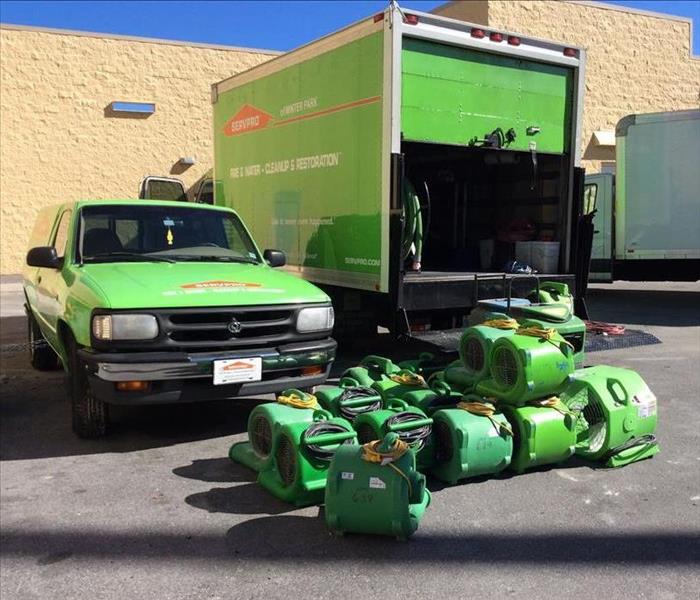 SERVPRO of Winter Park has the equipment needed to handle disasters on a commercial scale.
SERVPRO of Winter Park has the equipment needed to handle disasters on a commercial scale.
Whether you do business in Orlando, FL or someplace else, commercial property damage can be a frustrating experience for any property owner. To address this expensive and stress-inducing concern, commercial restoration services are available to restore your commercial properties as efficiently as possible. These commercial restoration services typically provide an assortment of services that work together to fully restore your commercial property, saving you time and money in the process.
This article will go more in-depth into what commercial restoration services do, why they are important and how they operate.
Types of Damage which Impact Commercial Properties
In terms of damage, residential properties and commercial properties are essentially the same. The most common forms of commercial damage include:
• Mold: Mold is both an eyesore and is unhealthy to be around. Once mold has infested a property, it can rapidly spread as air-borne spores if left unchecked. Mold remediation measures are essential for preventing a property’s mold situation from out of control.
• Fire damage: Fire damage can come from many different sources. A lightning strike, a faulty gas stove or even a neglected, lit cigarette can be sources of fire damage to a commercial property. Fires can cause catastrophic levels of destruction to a commercial property, requiring restoration and cleaning services to return the property to normal.
• Water damage: Water damage can also come from a variety of sources. Severe floods, severe rain, and busted pipes are just a few of the ways that water damage can impact your commercial property. Water damage can create more damage if left untreated, resulting in issues such as contaminated water on surfaces and furniture, eroded materials and mold infestations. Electricity combined with water damage is a particularly deadly and destructive force.
• Wind and storm damage: Severe storms and strong winds can smash windows out, tear off roof tiles and damage unsheltered commercial equipment and other properties.
The Importance of Commercial Restoration Services
If your commercial property has some damage, you must reach out to a commercial restoration service as soon as possible.
Commercial property damage follows the same principle as most other types of damage: when left unchecked and unattended, the damage tends to get worse over time. What started as roof damage can lead to rainwater falling into your property, causing preventable water damage and mold issues. A neglected broken door can easily lead to your business’s valuables being susceptible to vandalism and theft.
Commercial property restoration is very important for another reason. Every day that your commercial business is closed due to damage, your company loses money and potential customers. Commercial businesses deal with a lot of overhead: bills, office and equipment rentals, salaries and services offered in good faith that they will be paid back. Commercial property damages worsen their overhead because the companies cannot earn their money back or turn a profit. Under these conditions, commercial properties will continue to lose money until they can open back up for business. Commercial restoration companies that can provide efficient services are an invaluable benefit to commercial properties under these circumstances.
Operations of Commercial Restoration Services
Commercial properties seeking commercial restoration services should look for companies that provide emergency services 24 hours a day. These types of companies can offer immediate relief whenever they are called, or as soon as emergency services have appropriately handled any potential health issues or risk factors.
Once the commercial restoration services arrive, they will usually start by assessing the damage level of the commercial property. Conducting the assessment will allow the restoration team to plan out a way to handle the damage and to start restoring the building’s functionality. It’s typical for the damage to be more serious than initially presumed. Smoke from a room affected by past fire damage may have seeped into another room. The mold that started in one room could infest another room due to water damage. To determine the extent of the damage, these restoration companies use sensors and other detection devices to accurately determine the extent of the damage to the commercial property.
Afterward, a commercial restoration company will begin any necessary preventative measures to ensure that no further damage will occur. This could mean making repairs to the property’s roof or its pipe system, or it may mean adding temporary equipment or components while the restoration team works.
Whatever isn’t salvageable will be disposed of. Some equipment and objects that normally stay inside of the commercial property may be temporarily moved from their usual places. For water damage, the restoration specialists will clear out water with large pumps and clean affected areas with scrubbers and other equipment. Any damp surfaces will have to be thoroughly dried to stop the potential for mold spreading to other rooms and surfaces. Sanitization measures will also need to be put in place for several health reasons.
Once the commercial property is cleaned and the building is sealed, the commercial restoration teams will repair and remodel its rooms. Numerous furnishings may need to be replaced, and other parts of the building may need to be redone, such as wall paint and carpeting.
These commercial restoration services will restore your commercial property after it suffers various sorts of damage. The restoration process will allow your business to return to normal operations as soon as possible.
Business Owner Tips
Here are a few tips on commercial restoration for companies such as yours:
• Do thorough research on commercial restoration companies near you before any damage happens
• Check for insurance policies that will cover damage from sources such as water and fire.
• Plan for worst-case scenarios and determine ways to keep earning revenue.
• Consider having staff work from home while restoration services are being conducted.
SERVPRO of Winter Park
If your commercial property needs restoration services, contact us, SERVPRO of Winter Park. SERVPRO of Winter Park serves the Orlando, FL area, providing a variety of affordable commercial property restoration services.
The Importance of a Fire Escape Route in Your Property
9/4/2019 (Permalink)
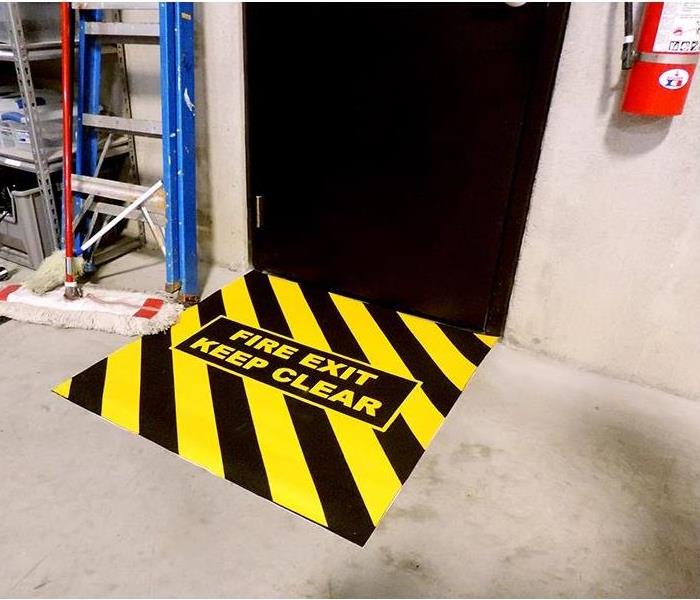 Find the safest exits in your property and educate your household or employees where to go in the event of a fire
Find the safest exits in your property and educate your household or employees where to go in the event of a fire
A fire can happen suddenly and grow quickly. Fire can become deadly and needs to be taken seriously. Is your family or business ready if a fire were to happen in your environment?
For most, the answer to this question is no. The first step to fixing this issue is to make a plan for where everyone is located and how to handle it. The best way to do this is to map it out. Put pen to paper with the layout of your home and/or business, where each individual or group is located, and what route they need to take during an evacuation.
After making a map be sure to mark on that map where all of the smoke alarms are. To be up to standards there should be one on each level, and ideally one in each room. Make sure that these batteries are changed at least every 6 months.
The next step is to establish the exact place where everyone needs to meet. For a family, it may be the giant oak tree across the street. For a business it may be one place or several places if it is a large establishment. It is important to know where this place is, and how many people should be there. When the fire station comes they will ask if everyone is present and accounted for to know how many and who they need to look for.
When you have made it to a safe place you will finally need to call 911. The fire department, ambulance, and police will be dispatched in ordered to get the fire under control and any medical attention taken care of.
When everything is under control give us a call at SERVPRO to help clean everything up and get you back into your home.
Tropical Storm Dorian Gaining Power
8/27/2019 (Permalink)
The latest Tropical Storm Dorian update from the National Hurricane Center features some potentially encouraging news for Floridians.
A still-uncertain long-term track showed the storm near Florida over the weekend, but Hurricane Hunters couldn't find a clear center during their latest flight due to the storm moving across St. Lucia. That disruption and dry air have kept Dorian from intensifying.
The storm's effects are expected to be felt in Puerto Rico by Wednesday afternoon and travel up to Hispaniola that night. Forecasters say Dorian will then head toward the Bahamas Friday and Saturday and reach southeastern Florida by early Sunday.
While uncertainty is high, Florida residents should monitor the progress of Dorian and ensure that they have their hurricane plan in place.
There was a slight adjustment north in the forecast cone Monday night to include Orlando and Daytona Beach. The cone was also tightened up to cross the eastern side of Hispaniola, meaning it is less likely now that the mountains will have a chance to significantly weaken Dorian.
If the storm goes across the Dominican Republic and Haiti, the mountains might weaken it, but if it stays over the ocean, weather officials believe the storm could gain strength as it travels towards Florida.
The U.S. National Hurricane Center said that as of 11 a.m. Tuesday the storm has maximum sustained winds near 50 miles per hour and is forecast to strengthen during the next 48 hours before hitting the U.S. territory. It is currently 60 miles west-northwest of St. Lucia.
We're in the peak of hurricane season
Dorian is the fourth named storm of this hurricane season. Generally, the season reaches a peak in the eight weeks surrounding September 10.
Two-thirds of all the storms produced in a typical season occur during this period.
That's because conditions in the tropics become ideal for storm development. By the end of August, water has typically warmed to the mid-80s in many parts of the region.
Storm Tips 2019
8/21/2019 (Permalink)
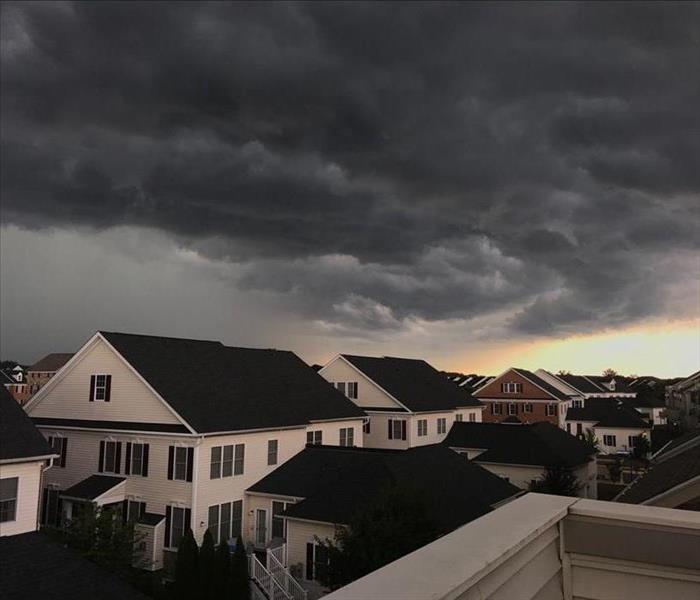 Nail down roof shingles or use adequate adhesive to keep them from blowing off in a violent wind.
Nail down roof shingles or use adequate adhesive to keep them from blowing off in a violent wind.
No matter where you live, you'll encounter storms. Most of the time these are routine, but some cause serious and dangerous problems. Here are tips for preparing for storms, and weathering them safely.
- Always keep a battery-powered radio in your home so that you can tune to radio stations if you lose electricity. Check or change the batteries frequently.
- Keep a flashlight in an easily accessible spot on every floor of your home. Check the batteries monthly, and replace them as needed.
- Keep a supply of candles on hand for power failures.
- As a safety precaution before leaving the house on vacation, unplug all electrical appliances except for those lights connected to automatic timers.
- If you live in a storm-prone area, nail down roof shingles or use adequate adhesive to keep them from blowing off in a violent wind. For roofs with shingles that are not the seal-down type, apply a little dab of roofing cement under each tab.
- A lightning-protection system should offer an easy, direct path for the bolt to follow into the ground and thus prevent injury or damage. Grounding rods (at least two for a house) should be placed at opposite corners of the house.
- Don't go out during a hurricane unless you have to; however, if flooding threatens, seek high ground, and follow the instructions of civil defense personnel.
- When a major storm is imminent, close shutters, board windows, or tape the inside of larger panes with an "X" along the full length of their diagonals. Even a light material like masking tape may give the glass the extra margin of strength it needs to resist cracking.
- When a tornado threatens, leave windows slightly ajar.
- The basement is not good shelter during a tornado -- it's too close to gas pipes, sewer pipes, drains, and cesspools. A better shelter would be underground, far from the house (in case the roof falls) and away from the gas and sewer systems. Let all family members know where the shelter is.
- Keep an eye on large trees -- even healthy ones -- that could damage your house if felled in a storm. Cut them back, if necessary.
We've covered numerous key tips for preparing for storms and getting through them safely. Now you can regard gathering clouds with a little less trepidation.
Fire Safety for Orlando Hotel Managers
7/30/2019 (Permalink)
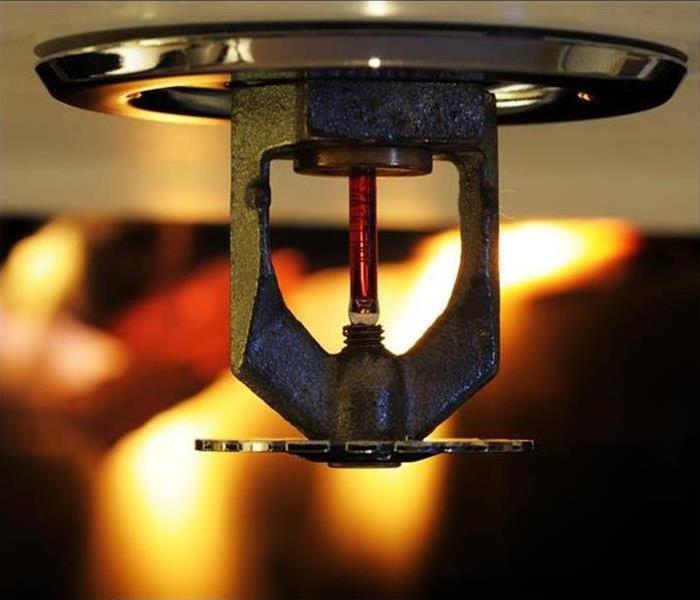 Fire sprinklers are a great way to alert staff and guests of a fire and can help minimize the damage sustained.
Fire sprinklers are a great way to alert staff and guests of a fire and can help minimize the damage sustained.
Introduction
In Orlando, FL, concerns about fire safety is typically the last thing on the minds of your hotel’s guests. Hotel fires can put many people’s lives in jeopardy, particularly sleeping guests and those who live on the higher floors of the hotel building. Fires can also cause large-scale damage to your business.
Policies within the Regulatory Reform (Fire Safety) Order 2005 require hotel management to conduct fire assessments, to apply fire control and prevention initiatives, and to give people the tools and knowledge to evacuate a fire as safely as possible.
Hotel fire can be very deadly, often taking the lives of those who are unaware of the danger and who are unprepared for it. Applying an appropriate amount of safety training and resources for your hotel can prevent the unthinkable.
Fire Safety for Hotels Checklist
The Regulatory Reform establishes a series of fire control responsibilities that must be handled to ensure that your hotel is safe for both guests and your staff. Any hotels who are lacking in fire safety measures can be issued notices requiring the hotels to address these deficiencies. In the most severe cases, the authorities may prevent the business from operating as usual until there is progress on attaining full compliance with the Reform’s standards.
This Fire Safety for Hotels Checklist is divided into these topics:
• Fire Risk Assessment
• Fire Wardens
• Fire Training
• Fire Detection and Fire Alarm Systems
• Maintenance
• Fire Route Plans
• Fire Evacuation Plans
• Informing Guests of Fire Safety
Fire Risk Assessment
A fire risk assessment involves five steps.
• Hazard identification: consider the means by which fires can happen, such as obstructed ventilation and damaged electrical plug sockets. Locate potential sources of kindling as well, such as paper, laundry, chemicals, and furniture.
• At-risk individuals: you must assess who are the most vulnerable people in the event of a fire. Guests should be your main focus. They generally don’t know your building’s layout and could even be soundly sleeping when a fire breaks out. Another important group to consider are those with hearing, seeing or mobility disabilities.
• Fire safety measures: assess ways to establish or improve upon current fire safety practices. This may include better housekeeping procedures, such as periodic checks of electrical appliances and plugs. Constructing disability-minded escape routes on the levels above the ground floor may be another measure.
• Record findings and corrective actions: The Regulatory Reform authorities will inspect your hotel records to ensure that you are actively managing your fire safety risks and hazards. This includes past compliance with their standards. This means that it’s necessary and wise to write down everything that you do and everything that still needs to be accomplished.
• Review: hotel buildings and their appliances do not last forever. This means that new hazards will show up from time to time and past fire control measures will lose their effectiveness. You must periodically reassess risks, reestablish control measures and rerecord fire prevention and control-related information.
Fire Wardens
It will be your responsibility to appoint someone with sufficient competence to serve as the hotel’s fire warden. This person will be responsible for the hotel’s fire safety, prevention, and evacuation guidelines. The fire warden can be someone picked out by you, or you can serve the role yourself. Either way, the designated fire warden must gain both technical and practical training in fire safety procedures so that they are well-versed in preventing and combating fires.
Hotel guests can’t be expected to know the building’s escape routes enough to evacuate efficiently, meaning that they may rely solely on someone who can guide them to safety during a fire. Fire wardens should maintain a guest list for this reason, and they should work with fire rescue personnel in cases when someone on the list cannot be accounted for in the evacuation process.
Some hotels are so large or complex that they need multiple fire wardens. At the bare minimum, there should be one fire warden on each floor, for each shift. Considerations should also be given for holidays and covered shifts for sicknesses or vacations.
Fire Training
You must provide fire training so that employees can respond appropriately to the alarm ringing. This includes situations when an employee should sound the alarm if it doesn’t go off automatically. This training includes fire hazard prevention measures, such as spotting and reporting problems, as good housekeeping practices. Training should also include the different types of fires, fire extinguishers, and how to correctly use them. Hotel training should familiarize the staff of all types with fire escape routes and locations for people to assemble during the evacuation phase. All employees should know who are the appointed fire wardens and when they have to fulfill that role.
Fire Detection and Fire Alarm Systems
A hotel's fire detection and alarm system are legally mandated. It’s your responsibility to ensure that manual call points are installed throughout the building in easy-to-spot locations. If the staff can find these manual call points without any trouble, then they can activate them more efficiently if a fire or fire damage is observed or reported.
Smoke detectors should be inspected monthly at a minimum. Manual call points should be tested weekly during normal business hours. Alarms throughout the hotel should be loud enough to immediately wake up guests and alert hotel staff of the fire hazard. Room alarms close to the head of the bed should ring around 75dB. Hotel guests must immediately wake up and begin evacuation efforts in the event of a fire. This is because guests can suffocate from unsuspectingly inhaling smoke while asleep, even post-evacuation.
Maintenance
A competent employee with technician experience or an external contractor should periodically check equipment and conduct necessary repairs.
Some items that should be inspected include:
• Kitchen appliances
• Fire doors
• Firefighting equipment
• Plug sockets
Make sure to keep maintenance and repair records. They serve as proof that your hotel is in compliance and inform you of upcoming servicing and checks.
Escape Route Plans
Escape routes should be positioned in ways that ensure that anyone can safely reach them even if the fire blocks out a different path.
Escape routes should:
• Be enclosed with smoke- and fire-resistant materials
• Be obstruction-free
• Be accessible for those with disabilities
• Remain closed as much as possible to prevent the spread of smoke and fire
Fire Evacuation Plans
For hotels, one of two evacuation plans are typically used:
• Simultaneous evacuation: small, uncomplicated hotels have alarm systems that warn all rooms and floors to evacuate simultaneously.
• Horizontal/Vertical phased evacuation: for more complex hotel structures, the system is designed to sound alarms and evacuate those who are in immediate danger first.
Your risk assessment and your local fire service can inform you if you need more information.
Informing Guests of Fire Safety
Your hotel guests should be immediately informed of manual call points and escape routes. Fire safety information forms for guests should clarify:
• Steps to take if the guest sees a fire or if the guest hears the alarm.
• The closest fire exit route from their hotel room & a floor plan.
• The closest assembly point location.
SERVPRO of Winter Park
In the event of a hotel fire, reach out to SERVPRO of Winter Park, serving the Orlando, FL area. SERVPRO of Winter Park can manage fire damage restoration projects at commercial levels for hotels or resorts.
How SERVPRO Conventions Benefit the Client
7/10/2019 (Permalink)
 The SERVPRO convention allows trusted vendors to set up booths and sell products and equipment to franchisees.
The SERVPRO convention allows trusted vendors to set up booths and sell products and equipment to franchisees.
SERVPRO is a national business and a leader in the restoration industry. Every year, SERVPRO holds a convention for their many franchises and vendors. Although it may seem like this convention does not provide value for restoration customer from the outside looking in, there are actually multiple ways the client benefits from this gathering.
Equipment
SERVPRO franchises are individually owned and operated. Although they all benefit from being under the corporate powerhouse that is SERVPRO, the fact is that some franchises are bigger and have been around longer than others. At the convention, franchisees are able to purchase the latest equipment from trusted vendors at discounted rates. Better and more equipment translate to your local SERVPRO being better equipped to handle your disaster efficiently.
Vehicles
Aside from equipment, franchisees also have access to discounted vehicles during the convention. Locations short on vehicles get maxed out quicker and tend to give jobs away to other locations that may not be as close. Adding to their fleet ensures that franchises can cover more ground in their territories and arrive at jobs faster.
Training
A huge part of the convention are the many classes that franchisees and their management staff can take part in. These classes range in topic and include training to improve the efficiency of office staff and customer service. A business that is run better is a business that is more successful in pleasing its customers.
Fire and Water Damage in Hotels and Resorts
7/9/2019 (Permalink)
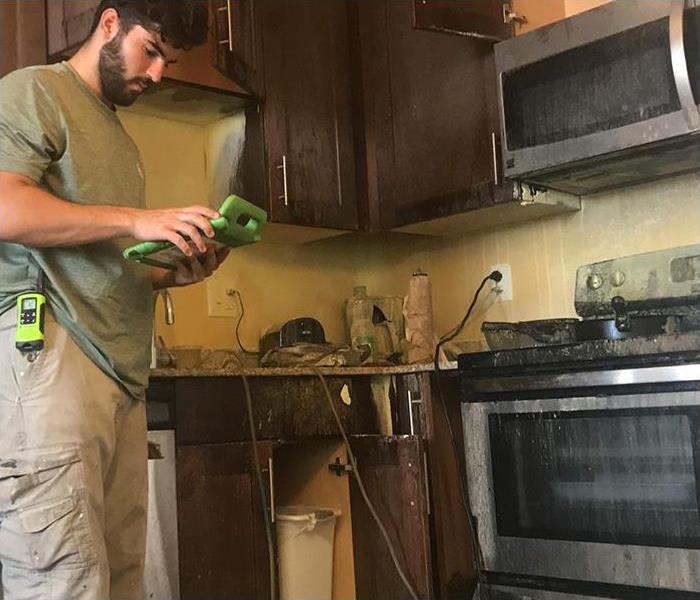 SERVPRO of Winter Park is trained to get you fast estimates with the best calculations to get you a clear idea of what repair costs may be.
SERVPRO of Winter Park is trained to get you fast estimates with the best calculations to get you a clear idea of what repair costs may be.
Cleaning and restoring your hotel, resort, convention center, or other hospitality business following a fire or water damage event can be a daunting prospect. Luckily, the experts at SERVPRO are here to help. We'll work with your management and staff to make sure any inconvenience to your guests is minimized as we isolate and fully restore the damaged areas.
Fire and Water Damage
Ruined flooring is perhaps the most obvious result of a water damage event. Water can destroy tile, vinyl, and wood flooring. It can also compromise the wooden sub-flooring beneath carpeting. Ceilings may also be affected as water leaking from one floor finds its way to the one beneath. Often times walls (or the bottom portions of them at least) will need to be replaced also, as they're made of porous materials that absorb water.
Soot, smoke damage, and water damage can destroy furniture, artwork, and other hotel property. Customer and client property may be damaged also, adding to your already considerable financial burden.
As costly as a fire or water damage event can be, the costs of not having the cleanup done correctly can be far greater. Improper or incomplete cleaning and restoration can lead to the growth of off-putting and potentially dangerous mold. Mold growth affects air-quality and is malodorous. Few things will damage the carefully maintained reputation of your resort, hotel or convention center quite so quickly as this toxic invader.
Why SERVPRO of Winter Park?
At SERVPRO of Winter Park, we understand that response time is critical when dealing with a fire or water damage event. A fast response can limit damage and potentially reduce costs. We stand ready twenty-four hours a day, seven days a week to serve Central Florida's many resorts, hotels, and convention centers.
No job is too big or too small for SERVPRO. We scale our response teams and equipment to best suit any given situation and, should the need arise we'll mobilize one of our Commercial Large Loss teams.
Whether you run a hotel, resort, school, or convention center, SERVPRO knows that you'll need to continue operating as cleanup and restoration are performed. We'll coordinate with your management to allow for normal operations to continue around the safely isolated cleanup area.
SERVPRO of Winter Park provides a host of other restoration services too. In SERVPRO's fifty-years experience, we've become experts in dealing with mold removal, vandalism cleanup, document recovery, and even the isolation and cleanup of biohazards.
There's no way to know when disaster will strike, costing you money in damages and disrupted operations. When and if catastrophe finds your hospitality business, you'll be glad to have the peace of mind that comes with knowing the experts at SERVPRO of Winter Park have your back.
If you've experienced a fire, or water damage event, visit our website to learn exactly how our many services may be applied to the quick and efficient restoration of your establishment. Or even better, call SERVPRO now at 407-678-5391.
How to Avoid Claim Denials for Water Damage
7/5/2019 (Permalink)
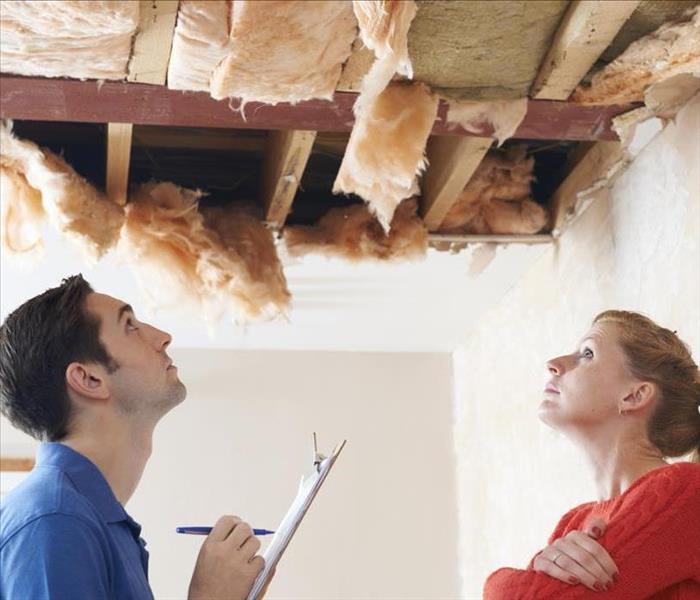 Asking your insurance adjuster if you're more likely to be approved or denied when they're on-site is an opportunity to get answers to concerns.
Asking your insurance adjuster if you're more likely to be approved or denied when they're on-site is an opportunity to get answers to concerns.
Home insurance claims stemming from water damage are among the most frequent of insurance claims around. We will cover water damage types, what damage is covered and what claims are typically made by homeowners. We will also cover why home insurance companies deny certain claims and how to avoid these denials.
Types of Water Damage
There are many kinds of water damage. Different homeowner’s insurance policies will cover different types of damages and situations. Some of the more common sorts of water damage that will show up on a policy as either covered or excluded from coverage include:
• Water damage caused by heavy storms
• Flood damage
• Water backup or sewer backup
• Accidental or sudden discharge
• Overflow
Home Insurance Claims for Water Damage
Homeowners usually want to know what sorts of water damage will be covered by their policies. Common types of water damage inquiries are for leaks, such as from leaky roofs, toilets or pipes around the house that distribute water. Coverage for water damages will be determined by the damage’s origin, the policy that the homeowner signed up for and if the claimed damage is both sudden and accidental or if the damage was gradual.
Gradual Damage
Gradual damage is water damage deemed to occur slowly over a long period of time. Some forms of gradual damage will be hard to spot until it is too late, such as when the damage is occurring within the interior walls of a home. Though these sorts of issues can lead to structural damage down the road, most of these damage claims would be denied since they didn’t occur both accidentally and suddenly.
Homeowners frequently make claims ultimately caused by gradual damage such as the following:
• Leaky pipes, plumbing, and faucets damaging walls, floors, and ceilings.
• Watering seeping in from foundation weaknesses or from holes around the home’s exterior.
• Worn down tiles, flashing or other roofing materials that are allowing water to enter the home.
• Damage due to corroded, moldy or rotting materials.
• Electrical wiring that has become worn and less effective.
• Sub-standard home repairs or non-repairs.
Though not always, insurance companies may cover the “resulting damage” of issues or parts that originally wouldn’t have been covered by the present policy.
If a homeowner wants to know the finer details of what is covered and not covered in their policies, then it’s best to consult the insurance company or their insurance broker or advisor. They can go over the exclusions and details of a homeowner’s insurance policy for complete coverage details.
Reasons that Claims can be Denied
Homeowner’s insurance claims can be denied for a variety of reasons. Gradual damage, coverage lapses or miscommunications are just a few reasons for claim denials. No matter the reason, the homeowner should request a complete explanation of why the claim is not being granted. This includes an elaboration of which part of the wording within the policy doesn’t apply to what the homeowner is seeking compensation for.
Keep in mind that many people represent the home insurance organization during the claims process, so it’s a good idea to determine from whom the denial is coming from. Was it the contractor, an insurance agent or a claims adjuster? Each person has a different role within the organization, opening different paths for reviewing or negotiating through the process.
One reason for the claim being denied was that it was for an issue that the homeowner had to specifically request or endorse beforehand. It’s one of the homeowner’s rights to know what conditions were covered on their policies for present and future reference, including the optional endorsements and features.
How to Avoid Claim Denials
• Keep records of home repairs, including the names of the professionals hired for the home’s maintenance.
• Maintain an accurate account of the homeowner’s responsibilities and of the policies and exclusions of the insurance coverage package.
• Implement periodic home maintenance, at least every spring and fall to mitigate and prevent damage.
• Select the best insurance package for the specific needs of the home and look into extra features that can provide added value.
The Dangers of Stagnant Water
6/19/2019 (Permalink)
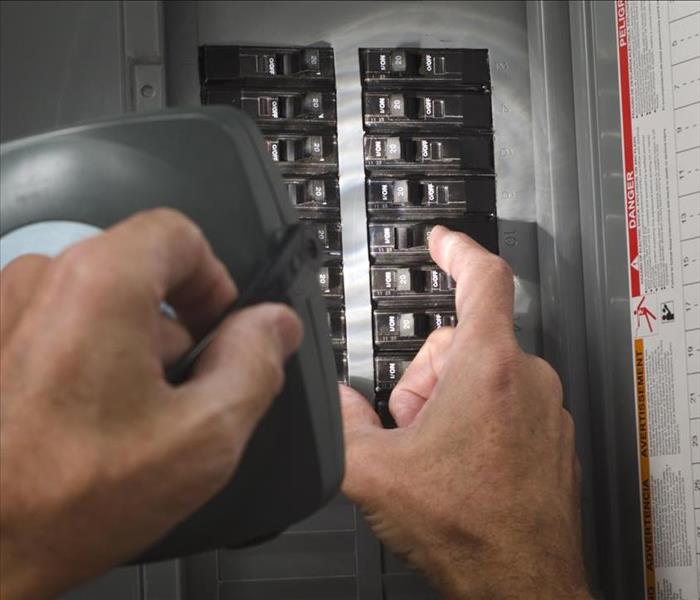 The greatest danger of a water damage situation is electricity. Be sure to shut down power to affected areas before work begins.
The greatest danger of a water damage situation is electricity. Be sure to shut down power to affected areas before work begins.
Standing water in your home can affect your property in ways that can be financially prohibitive to address as well as creating severe health issues. Any time there is flooding of any kind, water extraction needs to happen as quickly as possible. Water simply getting into your home in any way creates a serious issue but the longer water is allowed to stagnate, the more serious of a problem it creates. Here are four dangers associated with stagnant water.
1. Bacteria
Some of the most common health issues related to stagnant water are malaria, Legionnaires’ disease, and dengue. When water is clean, such as from a burst or leaky pipe, it doesn't start off containing bacteria but bacteria breed quickly, which means it can quickly become contaminated. Flooding that occurs as the result of storms or sewage overflows will generally already contain bacteria. The longer it sits, the more prevalent the bacteria become, creating a major health hazard. The longer water stands in your home, the more likely you are to contract a serious disease from it.
2. Mold and Mildew
Mold and mildew both have the potential to create a variety of health issues. Mildew generally has a strong odor, but mold will often be odorless so you may not even be aware of its presence. Mold spores are highly toxic, however, so if you have mold or mildew in your home, you will still feel the effects of it even if you can't see or smell it. One of the biggest dangers of stagnant water is that it allows mold and mildew to develop deep inside furniture or carpet padding or even inside your walls.
3. Risk of Injury
Waiting to have standing water extracted can pose a serious risk to those in the property. If circuit breakers are not turned off, there is the potential of being electrocuted. If the water is murky and can't be seen clearly through, there is also the risk of injuring yourself on unseen objects.
4. Structural Damage
Drywall works essentially the same way as a sponge does and is vulnerable to a process known as wicking. This is where the lower edges of the drywall will absorb water and transport it high up into the wall. Once it is there, it is generally hidden by the paint and even feels dry to the touch, so you may have no idea there is water in your walls. As the water dries, it will warp the drywall or even make its way into the wooden beams that form the support structure for your entire house. Once water works its way into the support beams of your home, it can wreak all kinds of havoc that can be very costly to fix.
5. Dry Rot
Dry rot is actually a fungus that produces spores which travel through the air. The fungus feeds off of the cellulose and hemicellulose in wood, which are the components which give the wood its strength. The mold spores need three things to grow into a fungus: heat (ideally between 70 and 77 degrees), moisture and a source of food (wood). When flooding occurs inside your home, it creates the ideal environment for the fungus that causes dry rot to develop. It is important to remember once again, that the entire support structure of your home is made of wood, which is largely hidden behind drywall.
Any time you have a flood, it is imperative that water extraction takes place as quickly as possible. Once the majority of the water has been extracted, however, it can still leave furniture, floors and even walls overly damp. This is why it is important to work with a professional restoration company. The moisture you can't see is generally what will do the most damage. A professional restoration company will not only take care of the water you can see but also the moisture you can't.
Avoiding Hurricane Insurance Scams in 2019
6/10/2019 (Permalink)
 Scams have become more frequent with each passing year and present an additional possibility for a disaster following a hurricane.
Scams have become more frequent with each passing year and present an additional possibility for a disaster following a hurricane.
Hurricane season always brings the potential for significant property damage, which is often covered under homeowner's insurance policies. Unfortunately, the insurance industry as a whole collects more than $1 trillion a year in premiums, which makes it a prime target for a wide range of fraud, including hurricane scams. While homeowners themselves may be innocent of any wrongdoing, they can also become the unwitting victims of insurance fraud or even unwitting participants. Insurance fraud costs the average American family anywhere from $500 to $700 per year in added premiums. Here are four ways to protect yourself from hurricane scams during the 2019 Atlantic Hurricane Season.
1. Be Wary of Anyone Knocking On Your Door Offering Unsolicited Repairs
For the most part, reputable contractors and repair services will more than have their hands full in the wake of a hurricane. In fact, the long waiting list for estimates and repairs is what creates a prime environment for scam artists. While reputable companies may send out door knockers offering estimates, they will never perform repairs right there on-the-spot.
2. Always Get at Least Three Estimates
You will want to get at least three estimates before deciding on a contractor and check each one carefully to see what work they are recommending. In some cases, unscrupulous contractors may charge for services that should be free and in other cases, they may try and charge for work that doesn't actually need to be performed. When you get estimates, you don't want to just look at the price but also at all the work recommended. If an estimate recommends significantly more or less work than the others, that might be a red flag. In the case of too little work, they may try and bill you more for additional work later and in the case of too much work, they may charge you for services they don't actually perform.
3. Check the Contractor's Credentials Carefully
Any natural disaster brings a flood of impostor contractors, so be sure and check their credentials carefully. In some cases, reputable contractors may come in from nearby areas to help cover the overflow of work, but you should still be able to check their credentials, no matter where they come from. Most states require contractors to carry worker's compensation, property damage, and liability insurance and may even need to be licensed. Ask for a copy of their license and insurance and then contact your local or state licensing agencies to ensure their credentials are in good standing and they meet all the requirements. You will also want to contact their insurance company to ensure their insurance is in good standing and their policy has not lapsed. Last, but not least, you will want to check with reputable agencies like the Better Business Bureau or Angie's List. Your insurance company may even be able to recommend a number of pre-vetted contractors.
4. Get a Clear, Written Contract and Read It Carefully
Before the contractor begins work, you need to ensure you have a clear, written, detailed contract that clearly defines everything the contractor is being contracted to do. This should include prices for labor, materials, clean-up procedures and estimated start and finish dates. Also, make sure there are no blank spaces on the contract that can be filled in at a later date and that you read the contract carefully before signing. One of the biggest scams plaguing the insurance industry is Assignment of Benefit or AOB scams. This is when the homeowner simply signs away their benefits, leaving any negotiations between the contractor and the insurance company. While this may seem like a good deal and alleviate a lot of paperwork, in truth, it opens homeowners up to repairs not being completed and insurance companies being billed for services never performed.
Cleaning Clothing After A Fire in Orlando
6/7/2019 (Permalink)
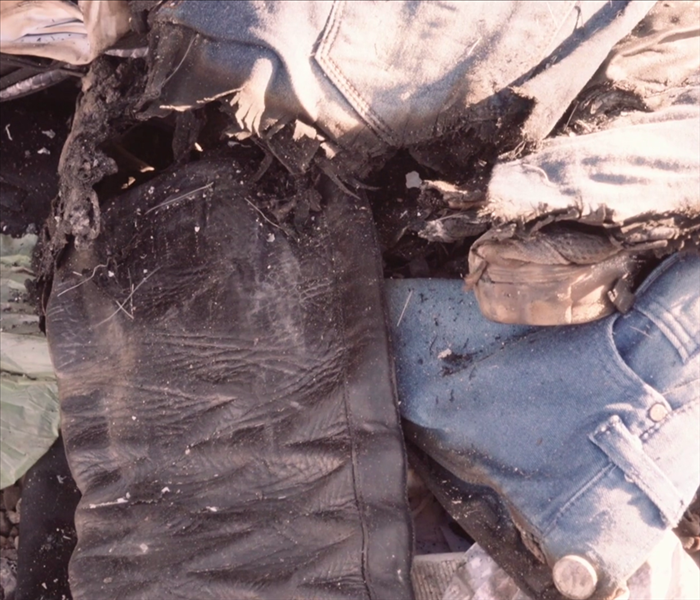 Sort through clothing carefully to make sure you only attempt to wash items that are salvageable. Discard items that have been burned and have holes.
Sort through clothing carefully to make sure you only attempt to wash items that are salvageable. Discard items that have been burned and have holes.
Recovering from a fire in Orlando can be a long, time-consuming process, even if there was little to any physical or structural damage. Just the smoke from fire alone can create a significant amount of damage, which can be difficult to mitigate. Clothing, furniture, and upholstery can all reek of smoke, even if they are far from the flames and in some cases can even be stained with soot. In most cases, you will likely need to hire a professional remediation company to restore furniture and upholstery, but you may be able to restore clothing on your own. Here are four steps to cleaning clothing after a fire.
1. Inspect Clothing Carefully to See What Can Be Salvaged
Some clothing may have burn holes or be stained or damaged beyond your ability to salvage it. Because clothing restoration is a time-consuming process, you want to focus on only what can be salvaged. Your fire insurance will most likely cover the cost of replacing clothing that cannot be salvaged.
2. Deodorize
Before clothing can be cleaned it will need to first be deodorized through a process called an ozone treatment. Ozone treatment is an oxidation process that cleans your clothing similar to the way rain cleans the air. Before you attempt to clean your clothes, it is extremely important to have them professionally deodorized with this unique treatment. Using ordinary fabric deodorizers will merely mask the smell temporarily, but eventually, the perfume of the deodorizer will evaporate, leaving your clothing once again reeking of smoke. The smell will also permeate any new clothing you purchase, so it is vitally important to have them professionally deodorized. In some cases, a fire restorer will use an ozone generator and in other cases, they will deodorize them in an ozone room.
3. Sort Remaining Clothing According to Type
Some types of fabric will be more difficult to get the smoke smell, soot stains or other stains out of, so you want to sort clothing by recommended care (found on the label), color (Light/ medium/ dark) and degree of soil (light/ medium/ heavy). You may end up with several small loads of clothing, but you want to keep them separate rather than combine them into larger loads. You will almost invariably have to wash each item several times, so it is more important to sort them by care label than you might with a single wash. Some clothing will need to be taken to an Orlando dry cleaning facility, but they may need to be professionally wet cleaned in spite of the dry clean only label.
4. Choose the Right Detergent
Different detergents will be more effective at removing scents, stains, soot and soil from different fabrics. The majority of clothing items will most likely be cotton, polyester, or poly/cotton blends. The effectiveness of cleaning will depend largely on the type of fabric and the type of detergent used. In tests, 100% polyester has the least likelihood of being returned to its original color and state. Pure cotton and poly/cotton blends are most effectively treated by washing in warm water anywhere from one to four times with either a liquid detergent or a low phosphate powder detergent and a liquid chlorine bleach. Because bleach will damage some fabrics and is not generally safe to use on darker clothing, it is better to use liquid detergent on darker clothing. Lighter clothing and whites will generally fair better with chlorine bleach. Powder detergent on its own is only partially effective at returning clothing to its original state. Dry cleaning is also the least effective method, so some dry-clean-only clothing may not ever return to its original condition.
Mold In Commercial Buildings and Schools
6/4/2019 (Permalink)
 Mold can grow unseen in hidden areas such as in the ceiling above a classroom posing a danger to students.
Mold can grow unseen in hidden areas such as in the ceiling above a classroom posing a danger to students.
With each passing year, concern over indoor exposure to mold increases. The public has become increasingly aware of the potential dangers linked to mold exposure. In addition to personal properties and residences, property managers and those responsible for the maintenance of commercial buildings, hotels, and schools should be aware of hidden dangers and acquire some knowledge of mold growth to protect the health of building occupants. With some basic knowledge of the subject, even inexperienced and untrained individuals can be capable of making reasonable judgments as to whether a situation can be handled in-house or requires the help of trained professionals.
Molds Can Be Found Almost Anywhere
They can grow on virtually any organic substance, as long as moisture and oxygen are present. There are molds that can grow on wood, paper, carpet, foods, and insulation. When excessive moisture accumulates in buildings or on building materials, mold growth will often occur, particularly if the moisture problem remains undiscovered or unaddressed.
It is Impossible to Eliminate All Mold
This also holds true for mold spores in the indoor environment. However, mold growth can be controlled indoors by controlling moisture indoors. Molds reproduce by making spores that usually cannot be seen without magnification. Mold spores waft through the indoor and outdoor air continually. When mold spores land on a damp spot indoors, they may begin growing and digesting whatever they are growing on in order to survive. Molds gradually destroy the things they grow on.
Mold Can Have Various Effects on Health
Molds can produce allergens that can trigger health issues to inhabitants. Health issues can vary between individuals. Others are known to produce potent toxins and/or irritants. Potential health concerns are an important reason to prevent mold growth and to remediate/clean up any existing indoor mold growth. Since mold requires water to grow, it is important to prevent moisture problems in buildings. Moisture problems can have many causes, including uncontrolled humidity. Some moisture problems in buildings have been linked to changes in building construction practices during the 1970s, 80s, and 90s. Some of these changes have resulted in buildings that are tightly sealed but may lack adequate ventilation, potentially leading to moisture buildup. Building materials, such as drywall, may not allow moisture to escape easily. Moisture problems may include:
- Roof Leaks
- Landscaping or gutters that direct water into or under the building
- Unvented combustion appliances
- Delayed maintenance or insufficient maintenance are also associated with moisture problems in schools and large buildings
Moisture problems in portable classrooms and other temporary structures have frequently been associated with mold problems. When mold growth occurs in buildings, adverse health problems may be reported by some building occupants, particularly those with allergies or respiratory problems. Remediators should avoid exposing themselves and others to mold-laden dust as they conduct their cleanup activities. Caution should be used to prevent mold and mold spores from being dispersed throughout the air where they can be inhaled by building occupants.
Causes of Residential Water Damage in Orlando
5/30/2019 (Permalink)
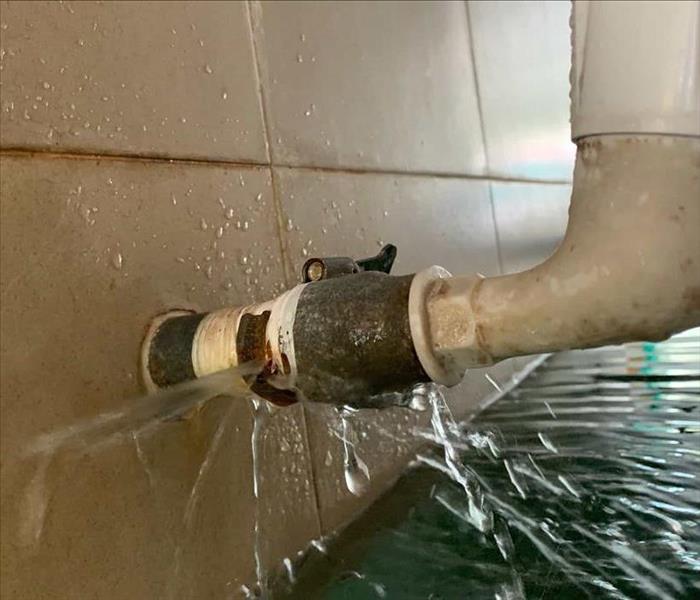 Pipe bursts and fixture leaks are a common cause of water damage in both residential and commercial properties.
Pipe bursts and fixture leaks are a common cause of water damage in both residential and commercial properties.
Water damage is a terrible event that can have devastating consequences for your home in Orlando if it is not properly and quickly addressed. This happens as excessive amounts of water start pooling up where it does not belong. There are a number of factors that can cause excessive water build up and resulting damage. They include the following:
- Plumbing system problems
- Leaking or burst pipes
- Water buildup in spaces that tend to gather water like residential attics, crawl spaces, and basements
- Issues with your HVAC systems (heating and air conditioning)
- Malfunctioning or defective appliances
- Natural disasters and ugly weather created problems
Once you are aware of the likely suspects causing this damage, you can take proper steps to head off floods and leaks before they get out of hand. The faster you recognize the issue, the less work the water extraction process will require. It will save you a great amount of damage restoration work and repairs as well.
Plumbing System Problems
It is true that occasional plumbing issues will happen behind the walls. You can not detect these when they occur. Many other issues start when pipe joints or hoses are not correctly attached. By taking an occasional look under your sink, you should be able to head off most serious plumbing issues. Clogged drains are another common cause of overflowing sinks, toilets, and bathtubs leading to water damage.
Leaking or Burst Pipes
Leaking pipes (or those which burst) are all too common causes of damage by water. Toilets and drains can back up, which causes a blockage. This leads to excess pressures on the pipes that respond by either leaking or bursting altogether. Improperly functioning garbage disposals are another frequent reason for why pipes can burst. Roots growing into sewer lines are yet another. Finally, if your pipes are rusty or simply old, this can cause them to leak over time.
Water Buildup in Spaces that Tend to Gather Water
Some places that lie hidden in your home have a greater tendency to suffer from accumulating water and resulting damage. This includes basements, crawl spaces, and attics. Crawl spaces themselves are built under houses so that workers can gain access to install electrical wiring and pipes.
The problem with this is that such damp and dark crawl spaces encourage mold to thrive. This leads to structural damage. Moisture that drips down through concrete foundations leads to basement leaks. Air getting in between the house and the attic causes condensation on the roof underside. This can create mold growth and rot. You should check around your house from time to time, especially accessible pipes.
Issues with HVAC Systems
HVAC systems include heating, air conditioning, and ventilating systems. They commonly cause water-related damage. If air conditioners are not routinely serviced, then this leads to a buildup of moisture. The cooling moisture encourages mold to grow in the ducts of the air conditioning system.
Malfunctioning or Defective Appliances
Appliances age with time, causing the piping to rust and the hoses to weaken. This includes refrigerators, washing machines, dishwashers, and water heaters that can all be subject to deterioration. You should closely watch machines that are older. Hot water heaters and washing machines are generally the two appliances that create this kind of damage in a house.
Natural Disasters and Ugly Weather Created Problems
You can not control natural disaster borne water issues. But you might undertake all necessary preventative safety measures before they strike to mitigate their impacts on your house. Hurricanes, flash floods, and unexpected storms all lead to damaging water buildup. Clogged rain gutters, roof damage, and cracks in the foundation are common causes of water damage during bad weather.
The Water Removal Process
Fortunately, there is a process of water extraction that can remove nearly all of the water in your Orlando home. Professionals like our staff at SERVPRO Winter Park can decrease the drying time to stop mold or additional water damage from occurring. We utilize truck mounted vacuums and potent pumps in order to rapidly take away from hundreds to thousands of gallons in excess water.
Step One: Pack Out
Should your house require an extensive cleanup and restoration job, our professionals will efficiently move you out to save your belongings from suffering from additional damage.
Step Two: Emergency Water Removal
Expertly trained water removal techs will start removing water almost right away. They could utilize submersible pumps along with industrial grade wet/dry vacs. This crucial step will reduce the amount of time needed to dry the house and aid in heading off secondary water damage and mold before it begins.
Inspect Carpets and Carpet Pad
Our pros will investigate the damage to the carpet and its pads to learn if they need to be taken out to save the sub-floor. We use such detection equipment as hygrometers, moisture detectors, and meters to ascertain the moisture saturation levels. We could utilize infrared cameras to locate that hidden water lurking behind ceilings and walls. Gas powered and submersible pumps do this job of constantly pumping away high levels of water. Our portable and truck-mounted extraction units will ensure effective water removal.
Dehumidifying and Drying
It is possible that once the water has been removed, your residential walls and floors may appear dry but still feel wet when touched. This is because, unfortunately, the majority of building materials (including wood and drywall) retain large amounts of water. This will warp, break down, or swell the material and lead to mold damage as well. It is where the dehumidifying process begins.
Our Orlando experts will manipulate humidity and temperature levels to dry the remaining moisture. We utilize particular equipment ideally suited for this, such as dehumidifiers and air movers. This will get out that water that has been retained. The high-speed air movers will cause an airflow over carpets and pads, furniture, and walls to evaporate the moisture. Our Orlando experts will closely monitor the progress by utilizing moisture meters to determine the point where all materials have reached necessary drying levels.
Which Restoration Companies are Best for Commercial Jobs?
5/24/2019 (Permalink)
 Commercial water losses at places such as hotels with multiple floors and units affected requires more equipment than most small companies have.
Commercial water losses at places such as hotels with multiple floors and units affected requires more equipment than most small companies have.
Sure, just about any restoration company you come across will tell you they can handle your disaster. The truth is, restoration has become an increasingly competitive market and many companies will make claims that they are unable to fulfill. Although many of these companies can certainly handle a residential loss, there are many additional factors to be considered when taking on water damage, fire damage, and mold remediation on a commercial scale. If you have a large commercial property and seek the help of a restoration company, here are a few things you may want to consider before making your choice.
1. How Long Has the Company Been in Business?
Find out how long the company you are considering has been in business. Less established companies may say yes to a commercial job and become overwhelmed before it is completed. A restoration company that has been in business for years is more likely to be experienced with the process and needs of handling a commercial sized job. They will be able to provide more accurate estimates and accommodate your operations to make sure further damage to your business is kept to a minimum.
2. Business Location VS. Home Office
There are many smaller restoration companies online that appear to be larger than they actually are. This can be accredited to good marketing most of the time. Many of these companies will run their operations from a home address. Because of the huge decrease in business overhead, they are able to undercut industry standard rates and offer to complete jobs at a lower cost. As is the case with most things, cheaper does not necessarily mean better. While this can seem appealing to most consumers, the fact is that the companies that do this oftentimes are unequipped to handle jobs at a larger scale. This can also cause smaller companies to band together to complete a larger job. The major downside to this is a decrease in the quality of work you are receiving by having multiple companies with different teams, standards, and levels of communication working on the same loss.
3. Equipment and Vehicles
Commercial jobs usually mean a larger amount of manpower, equipment, and vehicles. For example, a flooded bathroom and hallway in someone’s home will not require extraction on the same level as a pipe burst in a hotel or resort that has affected multiple units and floors. In this case, you want to avoid using a company that is only equipped with small portable water extractors and go with a bigger company that has truck mounts and is able to extract water at high volumes quickly. Also, a company that uses its own equipment and has a large stock will be able to get the drying process done much quicker than a company that has to rent equipment for your disaster.
TSP Products for Smoke Odor Cleanup and Removal
5/21/2019 (Permalink)
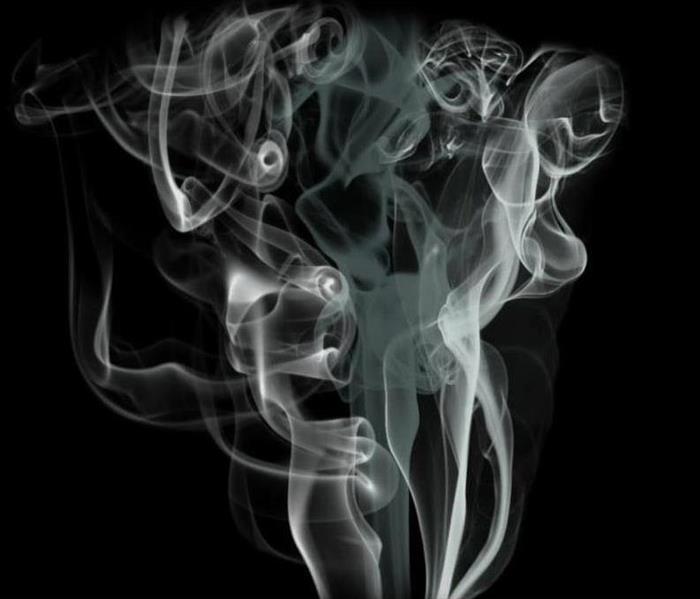 Aside from cleaning soot and residue, odor from smoke can be extremely difficult to get rid of.
Aside from cleaning soot and residue, odor from smoke can be extremely difficult to get rid of.
TSP on Garments
Products containing tri-sodium phosphate (TSP) can reduce odors in fabrics. TSP is caustic so be careful! Read the label for directions and safety instructions.
Test garments before using any treatment, and follow the manufacturer's instructions. Smoke odor and soot can sometimes be washed from clothing that can be bleached. Measure 4 to 6 tbsp. Tri-Sodium Phosphate and 1 cup household cleaner or chlorine bleach for every gallon of warm water you will use. Alternatively, consider washing clothes in cold water with your usual household laundry detergent, and adding one tablespoon of pure vanilla extract.
TSP on Walls, Furniture, and Floors
To remove soot and smoke from walls, furniture and floors, use a mild soap or detergent or mix together 4 to 6 tbsp. tri-sodium phosphate and 1 cup household cleaner or chlorine bleach to every gallon of warm water. Wear rubber gloves. Be sure to rinse surfaces with clear warm water and dry thoroughly.
Wash walls one small area at a time, working from the floor up to prevent streaking. Rinse with clear water immediately. Ceilings should be washed last. Do not repaint until walls and ceilings are completely dry. Reduce the chances of growth of mold and mildew by wiping down all surfaces that had gotten wet with a solution of one cup of liquid household bleach to a gallon of water. (Test surfaces to ensure that the bleach solution will not discolor these surfaces. To conduct this test, wipe a small area of the surface with the bleach solution, and allow it to dry at least 24 hours.)
Washable wallpaper can be cleaned like painted walls, but do not wet through the paper. Use a commercial paste to repaste any loose edges or sections.
Lightning Safety: What You Need to Know
5/13/2019 (Permalink)
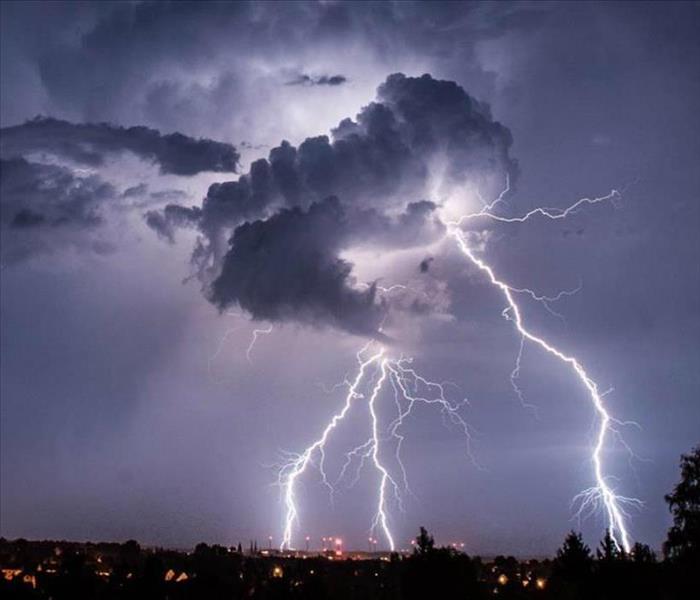 Tall thunderstorm clouds are more likely to produce lightning strikes.
Tall thunderstorm clouds are more likely to produce lightning strikes.
The chances of being killed or injured by lightning are slim to none. However, that does not mean it can’t happen or that you should not exercise caution during a storm. The most important tip for being safe during a lightning strike is actually quite simple. Avoid being in the wrong place at the wrong time. Lightning is generated on a scale that is too large to be influenced by small objects on the ground, so if you are struck by lightning it is because you were in the spot that the lightning was already going to strike. Victims of lightning strikes in the past were struck regardless of the metal items that were or were not around them at the time.
Instead of thinking about the items that are around you, you would be better suited to focus on where you are. Avoid the areas where lightning can strike which is, essentially, anywhere outdoors.
Stay Indoors
Staying indoors during a storm is the number one way to keep safe from a lightning strike. If lightning strikes a house or a building directly, it will tend to follow the available paths to ground, including the electrical wiring, plumbing, cable or telephone lines, antennas and/or steel framework. Structures like bus shelters, outhouses, lean-to shelters, or any small non-metal structure do not provide any lightning protection. Although most homes serve as a safe shelter from lightning strikes there are still safety measures you can take inside to minimize danger such as:
- Don't use any wired appliance or device. Wireless appliances (cordless phones, razors, etc) are safe to use.
- Stay away from water pipes and faucets. (No baths, showers, etc.)
- Don't stand on a basement floor or patio slab, or anywhere where standing water or excessive moisture is present. These areas are 'ground current' danger zones.
- Stay away from walls where electrical wiring is present. Lightning will occasionally jump through the air inside a house or building to reach a better grounding path, such as from electrical wires to a water pipe.
Go to Your Car
If there is no other option for shelter, you are safer in your vehicle than out in the open. This is only true for hard-topped vehicles and does not apply to convertibles or open vehicles such as golf carts. While inside the vehicle keep your windows closed and make sure to avoid touching metal parts of the car. The current from a direct hit from a lightning strike will usually travel through the frame of the car and through the tires before hitting the ground. After a strike, make sure to check the vehicle to make sure fuel was not ignited which can lead to an explosion.
Does Clothing Matter?
Clothing and accessories you are wearing do not influence your chances of being struck by lightning. That being said, if you are struck, metal items you wear can act as conductors for the electrical current. These items can become vaporized, leaving burn marks on your body.
Lightning Warning Signs
In addition to the obvious warning of an ominously darkening sky, there are certain conditions that can alert you to a lightning danger before the strikes threaten. You are in a 'danger zone' and need to seek immediate shelter if you experience any of the following:
- Rain and hail can signal the presence of a thunderstorm cloud overhead especially if the rain is heavy. In fact, larger raindrops can occur when a thunderstorm cloud is tall and more likely to produce a lightning strike.
- If you can hear thunder or see flashes from lightning strikes, you are in the range of the next strike.
- AM Radio static, crackling, and popping noises can occur when lightning strikes are present.
- Doppler weather radar will show thunderstorms as red, orange and/or yellow blobs. There are many resources online that you can utilize to see this radar including mobile applications. The Weather Channel also shows Doppler radar periodically.
Early Predictions for 2019 Hurricane Season
5/1/2019 (Permalink)
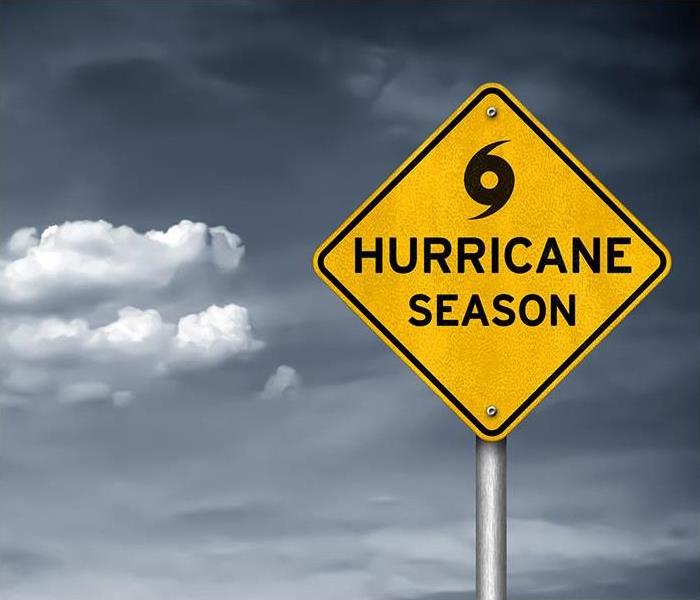 Early hurricane season predictions help us know what to expect, however, we should always prepare for the worse as they have been wrong in the past.
Early hurricane season predictions help us know what to expect, however, we should always prepare for the worse as they have been wrong in the past.
Even though the severe weather from last year's tropical season only ended four months ago, it is just another month until the upcoming 2019 Atlantic hurricane season kicks off on June 1st. The season extends through November 30th, with approximately 95 percent of all the major storms happening after August 1st in the so-called peak season. Earlier in April, Colorado State University's highly respected hurricane predictions research team unveiled its early tropical predictions for 2019. With more than 35 years under their belts, this year they are calling for a slightly less active than usual hurricane season.
Early Hurricane Predictions For 2019 Hurricanes Season
Colorado State University is predicting for 2019 hurricanes 13 named storms, with five of them becoming hurricanes and two evolving into major hurricanes. This is close to the usual quantity of predicted storms. The good news is that overall tropical activity (measured based on the storms' intensity and total energy rather than the number of named storms) has been forecast at a little below the average season. In the typical tropical season, there are 12 named storms, 6 hurricanes, and 3 major hurricanes sweeping through the Atlantic Ocean or the Caribbean Sea.
How These Predictions Are Made and Compare to the 2018 Season
The Colorado State University team contemplates the present day state of El Nino and the Atlantic Ocean temperatures in coming up with its highly anticipated tropical outlook. The two important elements are showing the season will be less active than usual.
In 2018's tropical season, the number of storms proved to be 15 named, 8 hurricanes, and 2 major hurricanes. The two major storms were Hurricanes Michael and Florence. Hurricane Michael landed in Mexico Beach, Florida with stunning total winds of 155 miles per hour on October 10th at almost Category 5 power. This proved to be among the most potent hurricanes to ever make landfall in the United States. For its central barometric pressure, this was the third most powerful storm in history to land in the U.S. No landfalling storm since Hurricane Andrew (smashing into south Florida in August of 1992 and leveling everything in its landing) boasted the winds of Michael. Michael's economic impact is estimated by economists to run $25 billion.
Hurricane Florence landed in North and South Carolina back in September of 2018. The storm poured out over 30 inches worth of rain, causing severe flooding for many days. Over a dozen individual rivers reached major flood levels, causing forced evacuations and devastating property damage. Both Hurricanes Matthew (2016) and Floyd (1999) had their flood records destroyed by Florence. It caused an estimated approximately $25 billion in damage as well.
Colorado State University's team is not the only one making hurricane season forecasts. AccuWeather the private service has predicted a greater number of storms for the season, with from five to seven full hurricanes. AccuWeather was quick to remind that seasons with fewer storms than average have still produced devastating hurricanes.
Predictions Have Sometimes Been Far Off In The Past
In the last several years, the initial forecasts from Colorado State University have been pretty accurate. In 2018 they called for seven hurricanes and eight occurred. For 2016, they predicted six when seven hurricanes actually formed.
Yet they missed the outcome of season 2017 pretty significantly, as did the other hurricane forecasting outfits. While they predicted four hurricanes in 2017, the season produced 10. Among these were the hugely destructive Irma, Harvey, and Maria. This once again goes to show you that even a low number of predicted hurricanes for a season can still lead to hugely destructive hurricanes in the end. Because of this possibility, it is always important to prepare for a hurricane regardless of early predictions.
5 Tips to Prepare You in Case of a Fire
4/24/2019 (Permalink)
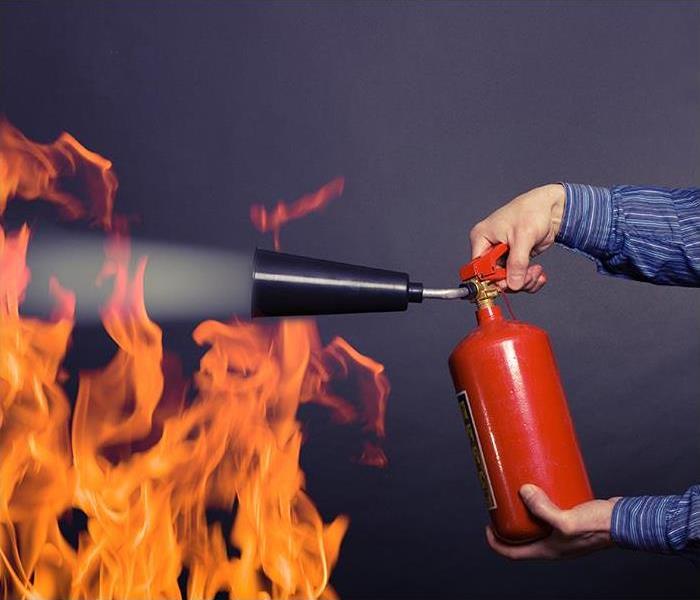 Check fire extinguishers regularly to ensure they are working properly in the event of a fire.
Check fire extinguishers regularly to ensure they are working properly in the event of a fire.
A house fire is a disaster that is easily preventable. Every homeowner and family member should take the time to do the following to ensure fire safety.
1. Install Smoke Detectors Throughout the Home
The first step for preventing a residential fire is properly installing enough smoke detectors throughout your home. Smoke detectors should be installed on every floor of your home and close to any bedrooms. To make sure that the detectors are always in working order, you'll want to test them out once a month. Batteries in smoke detectors should be replaced once a year. Smoke detector manufacturers suggest that they should be completely replaced every 10 years. Do not disable any smoke detectors while cooking, as this can potentially result in tragedy.
2. Install Fire Extinguishers
Once you've got the smoke detectors installed, it's time to make sure that you have fire extinguishers readily available throughout your residence. These will come in handy should you experience a small fire. Using a fire extinguisher will prevent you and your family from having to battle a bigger fire. Fire extinguishers should be kept in the kitchen, garage, and any workshop areas of your home. Similar to smoke detectors, fire extinguishers should be checked regularly to ensure they are working properly.
If you are not sure about how to use a fire extinguisher, consider contacting your local fire department on training information to get you started. You'll be able to learn how to properly use and maintain it. It is also important to know that there are different types of fires and different types of extinguishers used to put them out.
3. Teach Kids About the Dangers of Fire
Let's face it, kids are curious. This is a good and bad thing, but when it comes to something life-threatening like fire, curiosity can quickly turn into danger. Over 100,000 fires are set every year by kids under 5 years old playing with lighters or matches. To avoid this from happening, it's essential to educate children about the potentially deadly consequences of playing with fire. Inform them to STOP, DROP, and ROLL if their clothes catch on fire in an emergency. Also, teach them about what firefighters do, and to not hide from them when they are in sight.
4. Create a Plan for Escape
Having a well-thought-out and organized plan is very important. Think about it. The last thing you want to do during a fire is to try and think rationally about what to do next to survive. Developing a plan for escape in advance will spare you some time (which is a huge deal during a fire).
Not only should you create a plan, but you will also want to discuss it with your family members in detail so that everyone is on the same page should a fire take place. The escape plan should include at least two escape routes from every bedroom. Everyone living at home should be familiar with basic home fire safety procedures. This includes checking doors for heat before opening them, staying low on the ground to stay out of the smoke, and knowing the closest way out. These little things can go a long way in saving lives during a blaze! Make digital copies of any valuable documents and records like birth certificates, and keep them in a safe place easily retrievable in the event a fire takes place.
In addition to creating a plan and talking about it, practice it. Fire drills are not only for grade school students. They're a good reminder for everyone of all ages.
On top of having a solid escape plan in place for yourself and your family, it's also crucial to make sure that everything at home is in working order. For example, windows should not be stuck, and if you have any window screens, they should be easily removed if need be. Use security bars? Make sure they can be opened properly.
5. Have a Family Communications Plan Set
Got the escape plan out of the way? Now it's time to plan out your family communication methods. Firstly, make sure that everyone knows how to call 9-1-1. In an emergency, it's important to ensure that everyone at home knows who to contact if they are not able to locate one another, or in any other instance. Spend some time to speak with family members about who to call and where to meet in such cases, to be extra prepared.
Tips for Water Damaged Furniture
4/17/2019 (Permalink)
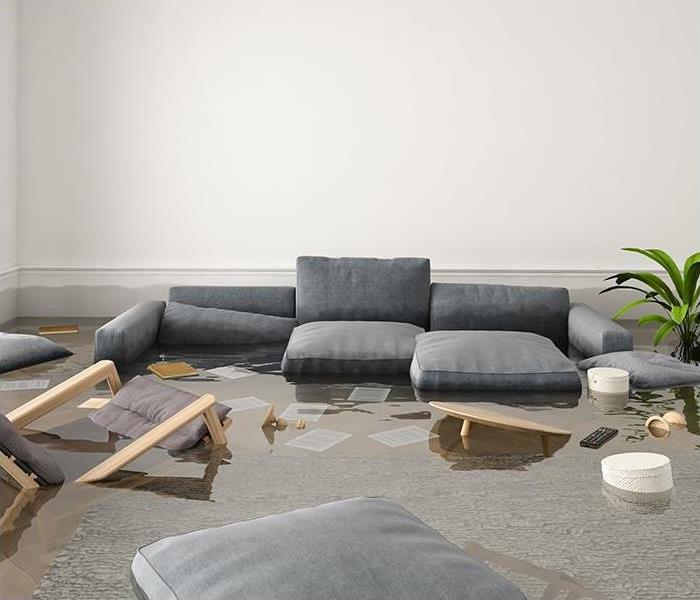 Flood water is considered to be black water. Because of dangerous toxins and materials, it is recommended to throw these affected items away.
Flood water is considered to be black water. Because of dangerous toxins and materials, it is recommended to throw these affected items away.
Furniture that gets wet is not a pretty picture. Important questions that arise when you suffer from such a disaster in your home include: Can you save the furniture and how can you save it? The first critical step with any form of water damage involves determining the levels of risk factors in the contaminating water. This refers to the amount and types of pathogens that are found in the water. It is critical to make sure that a disease will not be contracted from exposure to the water.
The 3 Types of Contaminating Water
The first step is learning from which type of water your furniture has suffered damage. There are three types of water that can cause damage to your furniture. These are as follows:
- Category 1 - Clean Water - the drinkable water that comes from the regular pipes in your home. You could drink this, and it poses no threat to your family's health
- Category 2 - Grey Water - there are some contaminants found in greywater from either biological or chemical agents. These could be from the leakage of a water heater, an overturned fish aquarium, or an overflowing washing machine. While it will not kill you, you would not want to drink the water or get it in your eyes, which could easily burn on contact.
- Category 3 - Black Water - this is really nasty water including sewage or runoff from a river. It could make your family terribly ill. You should neither come into contact with it or even breathe the air surrounding the water.
How Furniture Items Can Be Cleaned
It is important to determine the water category to learn the proper path for cleaning the water damaged furniture. There are many cost-effective methods for treating the first and second categories of water damage. When black water has infected the furniture it usually cannot be saved. Methods of treating furniture vary according to whether it is wood or upholstered.
Wood Furniture
Wood suffers from water damage very quickly. When it is on a large scale it becomes more serious as wood furniture is tricky to fix. If you allowed the furniture to sit in water for several days, it is likely completely ruined and should be discarded. For one thing, the bindings or glue that hold it together may be irreparably damaged.
Yet even still it might be saved. You can take pieces apart to clean and dry them before putting them back together. The furniture will generally require re-stripping, bleaching, cleaning, drying out, and refinishing. This will be both a labor and time-intensive process. It is wise to get a cost estimate done before you start the project to ascertain if it makes more sense to restore an original piece or replace the furniture entirely.
Upholstered Furniture
Upholstered couches and chairs are sometimes tricky to dry and clean. The items may be pressure treated in a special way. Extremely high-temperature water will first kill off pathogens such as bacteria. After the furniture has dried properly it will be put in a room with a dehumidifier and air movers set up.
Such air movers will be strategically placed to move dry, hot air through and over the furniture. The moisture will evaporate, and the industrial dehumidifier will gather in the moisture. It will finally be released outside of the house.
There are circumstances where the upholstery has to be removed. These include when the water has soaked into the furniture over a long period of time. Cleaning, then a treating and drying process will reach the places that are hard to get to which have become water damaged.
When Items Should Be Disposed Of Finally
It is critical to realize that you can not hope to clean out water damaged furniture which has been soaked by the black category 1 water damage. There are cases where it could be sensible to try if the piece was very expensive (like with a Persian rug). The costs of trying to do this generally are far greater than simply replacing the items. This is true for most any kind of porous-surfaced furniture. The best plan is to take the black water damaged item and simply throw it away.
For furniture that is upholstered and heavily damaged by other categories of water, there are limited options. Fabric that has become watermarked or stained is difficult to completely restore. It is possible that after a few hours of soaking in water, silt and mud can penetrate the padding and fabric as well.
Padding also still holds in water even when the rest of the furniture appears dry. This is when mildew forms outside and inside. Wood that is finished will turn cloudy. The wood can mildew if the flood water manages to penetrate the finish. Joints within wood frames can also become loose. If the furniture was sewage-contaminated or has industrial chemicals or pesticides from the flood water within it, this is the time to throw away the upholstered or wood furniture and start over with new pieces.
Water Heater Leak Cleanup in Winter Park
4/15/2019 (Permalink)
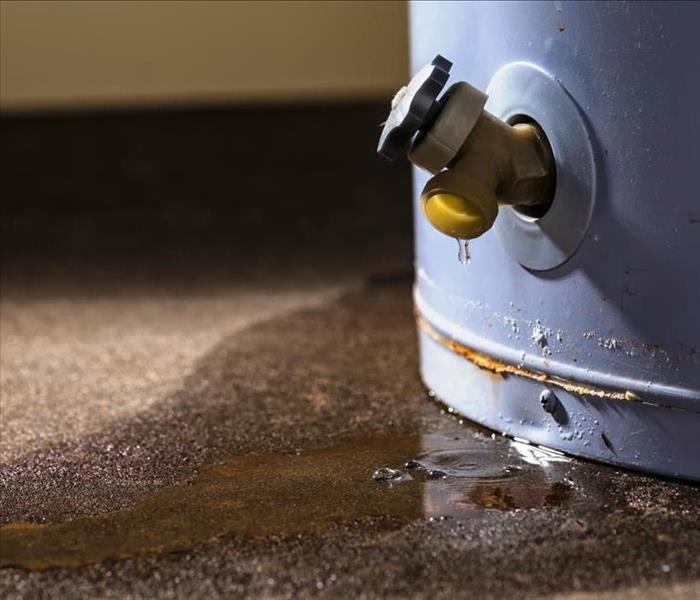 Make sure to clean up and dry as much water as possible to prevent further damage.
Make sure to clean up and dry as much water as possible to prevent further damage.
If you have recently experienced a water heater leak, there are several simple steps you can take to clean up the leak and minimize safety risks. Try to limit the extent of the leak as soon as you notice a leaking water heater. Contact a plumber to fix a broken water heater or replace a failed water heater, and then determine the extent of the water damage. Follow these four steps to address the leak. For complete peace of mind, especially with a larger leak, you should contact a company that provides water damage restoration in Winter Park.
Electrical Appliances
Unplug electrical appliances in the affected area. You don't want to risk electrocution or other appliances being adversely affected by a leak.
Removable Items
Remove soaked carpets and moveable items from the area surrounding the leaking water heater. You may be able to dry out some items, but carpet may not be salvageable.
Drying the Area
Dry the floor as soon as possible. You can use a mop, towels, or a wet-dry shop vacuum to remove excess water. You can also use a desiccant such as silica gel near soaked floors or walls.
Circulate air and dehumidify. This will speed the drying process and limit the extent of the water damage while making the environment less conducive to mold growth.
If you notice a leaking water heater in your home while the leak is still small, you may be able to limit the extent of the water damage by taking immediate action. If the leak is larger or has gone unnoticed for more than 24 hours, you should contact a residential restoration service in Winter Park, FL. Either you or damage restoration experts will need to clean up and dry all the water to prevent mold. Make sure to also have a plumber replace a failed or broken water heater to prevent another leak.
2019 Atlantic Hurricane Season Tips
4/5/2019 (Permalink)
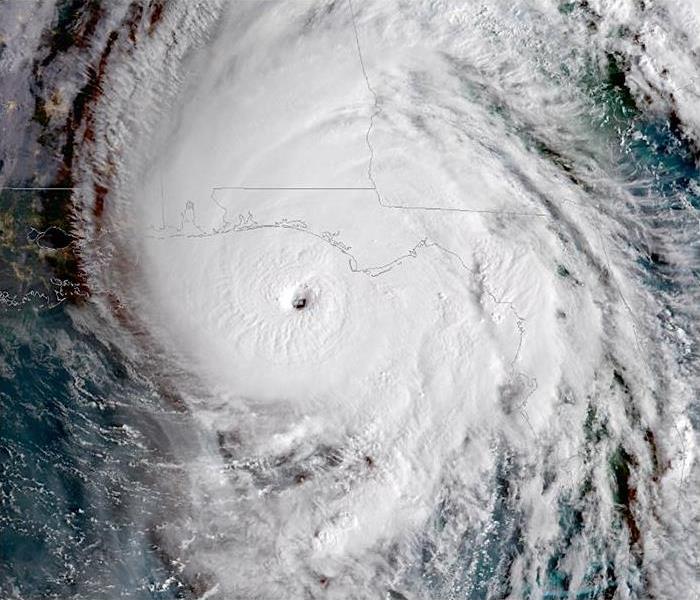 Florida has a long history of dealing with hurricane seasons. Make sure you are prepared over the next 2 months before the 2019 season begins!
Florida has a long history of dealing with hurricane seasons. Make sure you are prepared over the next 2 months before the 2019 season begins!
The 2019 Atlantic hurricane season begins in just two months. Many Floridians are already accustomed to what that means and the possible dangers that come along with it while others may be newer to Florida. Whether you are accustomed to hurricane seasons or not, being a resident in Florida means that the threat of hurricanes is very real and having the knowledge of what to do before, during, and after a storm can make all the difference. Stopping a tropical storm or hurricane from happening is not an option. However, taking the appropriate steps to make sure you and your family are both safe and prepared in the event of a hurricane is. Below are a few helpful tips and reminders for the upcoming season.
Preparations Before A Storm
Emergency Supplies
- Emergency water supply
- Have at least 5 gallons of water per person (which should be enough to last 3 to 5 days)
- Gather clean containers for water.
- Get supplies to make your drinking water safe (like iodine tablets or chlorine bleach).
- Emergency food and medicine supply
- Put together a 3 to 5 day supply of food that doesn’t go bad (like canned food)
- Make sure to have enough baby food or formula (if needed).
- Gather any prescription medicines.
- Safety items
- First aid kit and instructions
- Fire extinguisher
- Battery-powered radio
- Flashlights
- Extra batteries
- Sleeping bags or extra blankets
- Personal care products
- Hand sanitizer
- Wet cleaning cloths (like baby wipes) in case you don’t have clean water
- Soap
- Toothpaste
- Tampons and pads
- Diapers
Disaster Plan
- Write down emergency phone numbers and keep them near every phone in your house or on the refrigerator. Program them into your cell phone, too.
- Buy a fire extinguisher and make sure your family knows where to find it and how to use it.
- Find out where the nearest shelter is and the different routes you can take to get there if you have to leave your home.
- Make sure that everyone in your family knows what the warning sirens in your area sound like and what to do if they go off.
Damage Prevention
Stock up on materials to help prevent unnecessary damage to your home in the event of a hurricane. Have tools and wood ready to board up windows. You can also purchase sandbags to block water from coming in via entrances such as doorways and garage doors.
If you can afford to, have a roof inspection done and repair any old or broken materials to help prevent against water entry. Also, make sure all rain gutters are cleaned out to allow water to flow away from your property as intended.
For more tips click here
Property Insurance
Get familiar with your current homeowner’s policy and make sure you understand what you are and what you are not covered for if a storm damages your home. Add any additional coverage for flooding to save yourself from having to come out of pocket completely if the worst happens.
What to Do During A Storm
Put your plan into action. The most important thing to understand is that the safety of you and your family is always the priority and any decisions made should reflect that. If you have properly prepared, stay indoors and wait out the storm. If you do not feel you are completely prepared to do so, head to the nearest shelter with plenty of time to spare before the hurricane approaches your area.
Additionally:
- Use a portable radio to listen to important storm updates, information and instructions.
- Stay inside and keep away from all windows, skylights and glass doors. Go to a safe area, such as an interior room, closet or downstairs bathroom.
- Never go outside the protection of your home or shelter before there is confirmation that the storm has passed the area. The eye of the storm could create a temporary and deceptive lull, with high winds still approaching.
- If power is lost, keep the refrigerator closed to keep cold air trapped and delay spoilage of perishable food.
- If you use a portable generator, follow all the manufacturer’s instructions. Generators should be properly grounded to prevent electrical shock and should never be operated indoors, in garages, basements or outdoors near any windows, doors or vents. Because generators produce carbon monoxide (CO), make sure you have a working CO detector in your home.
What to Do After A Storm
Insurance
If you have sustained damage to your property, file a claim as quickly as possible. Insurance companies will be overwhelmed with calls of damage so the sooner you can file a claim, the sooner you can expect compensation. Make sure to document any damage as thoroughly as possible to speed up the process for your insurance adjuster and the entire process overall.
Property Damage
After filing a claim, working with a trusted restoration company is best for getting your property back to pre-hurricane conditions. A national brand such as SERVPRO has the manpower and equipment to remove large amounts of water from your home, dry out affected structures quickly, repair and restore property damage, and even remediate mold if it becomes an issue in your property.
Safety Tips Include:
- Stay tuned to local news organizations, such as a radio or television station, for important announcements, bulletin, and instructions concerning the storm area, medical aid and other forms of assistance, such as food, water, and shelter.
- Remember that you may not have immediate access to your home. Emergency rescue crews, power crews, and other personnel may be attending to special needs. Roads could be blocked, power lines could be down and people may be trapped and in need of assistance.
- Make sure that you have current identification. You may have to pass through identification checkpoints before being allowed access to your home/neighborhood.
- Avoid driving as roads may be blocked.
- Avoid sight-seeing or entering a storm-ravaged area unnecessarily. You could be mistaken for a looter.
- Avoid downed power lines even if they look harmless.
- Avoid metal fences and other metal objects near downed lines.
- DO NOT use matches in a storm-ravaged area until all gas lines are checked for leaks (keep flashlights and plenty of batteries at hand).
- Avoid turning the power on at your home if there is flooding present. Have a professional conduct a thorough inspection first.
- Consider having professionals/licensed contractors inspect your home for damage and help in repairs. This includes electricians, as well as professionals to inspect gas lines, remove uprooted trees and check the plumbing.
- Remember that downed or damaged trees can contain power lines that can be a hazard.
- Use a camera or camcorder to record thoroughly any damage done to your home before any repairs are attempted.
- In certain areas, the flooding rains that accompany a storm can create pest problems. Be aware of potential pest problems in your area, such as mice, rats, insects or snakes that may have "come with the storm".
- Telephone lines will likely be busy in the area; use a phone only for emergencies.
- Flooding brings with it the risk of waterborne bacterial contaminations.
- You should assume that the water is not safe and use properly stored water or boil your tap water.
Fire and Smoke Damage Insurance Claims
4/3/2019 (Permalink)
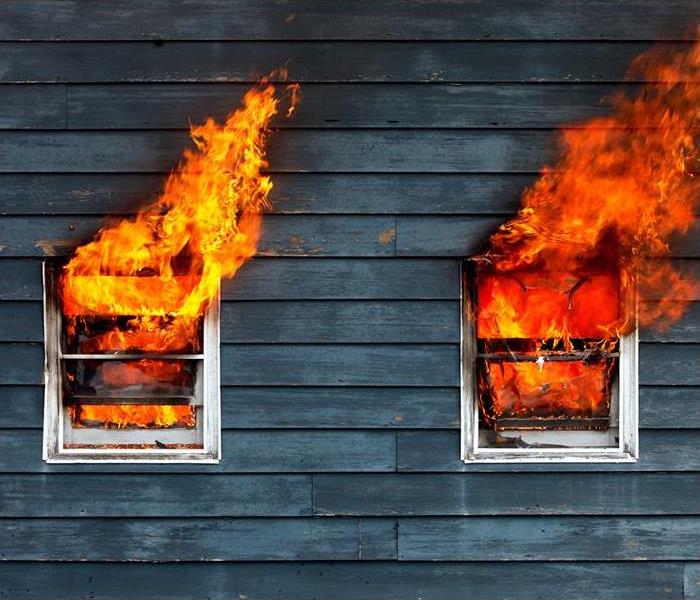 Dealing with insurance after a fire can be just as stressful as the fire itself. Make sure you know what your policy covers and prepare beforehand.
Dealing with insurance after a fire can be just as stressful as the fire itself. Make sure you know what your policy covers and prepare beforehand.
Your biggest concern after a fire is probably getting things back to normal at your home. You may not have the funds to make the repairs yourself. Most homeowners insurance policies cover fire and smoke damage though. You won’t need separate fire damage insurance. With careful planning, you can make filing your insurance claim easier by following a few simple steps after the fire.
What a Standard Homeowners Policy Covers
Fire is one of the perils that a standard homeowners policy covers. It reimburses you for damage to your home’s structure and its contents. “Contents” refers to clothes, furniture, personal items like jewelry, sports equipment, and other items. The contents coverage usually equals 50 to 70 percent of the insurance coverage on the structure.
Stay Prepared
Before anything happens to your home, conduct a home inventory. Make a list of all of the major items you’d need to replace if a peril occurred and the cost to replace them. Store this list offsite at your office or in a safe deposit box.
Documenting the Damage
If a fire does occur, document the damages from smoke and fire. Also, document the losses of contents items. Use the home inventory you created to provide exact descriptions including serial numbers of items and the amount they cost.
Your insurance company will need specific information to file your claim. This information includes:
- the fire’s time and date,
- the type of loss,
- the damage location – address and rooms damaged,
- photos of the damage,
- any injuries that occurred,
- involved parties,
- the home’s condition,
- the specific damaged items with descriptions,
- necessary repairs, whether temporary or permanent,
- the police and fire reports.
Do this as quickly as possible so that you do not miss the claim filing deadline. Your insurer will likely respond, requesting more information. It will want estimates of the fire damage cost to repair before funding the work. This means you will need to obtain cleaning and repair estimates from a company like SERVPRO and share these with the insurance company to document the fire damage repair costs.
Keep Accurate and Complete Records
You and your insurance company will exchange many emails, letters, and documents during the claims process. Start a binder or folder that contains only items related to this.
Your homeowner's insurance should cover the damage to your home and its contents. Careful documentation makes it easier to obtain your reimbursement for the damages. If the insurance adjuster declares your home a total loss, then your policy should cover your home’s reconstruction. In most cases, your homeowner's policy is all the fire damage insurance you will need. If your insurance denies your claim, try hiring a public adjuster to obtain a second opinion on the fire damage cost that you can use to appeal the insurance company’s decision.
Water Extraction Company
4/1/2019 (Permalink)
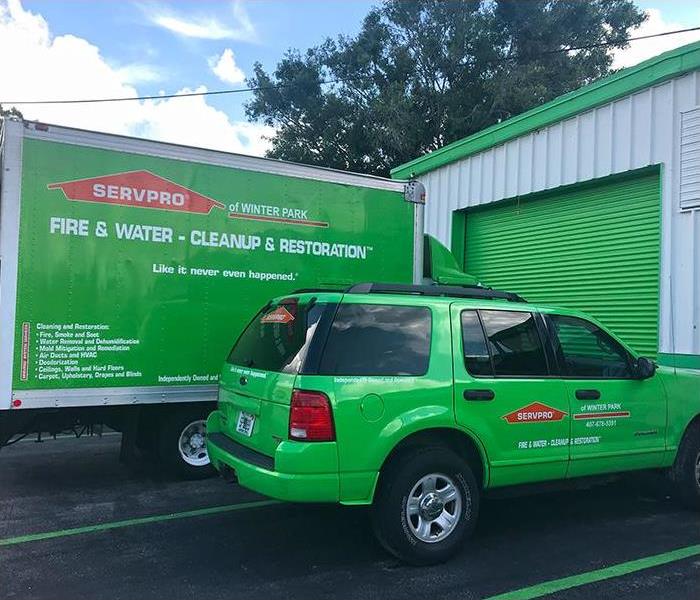 We are conveniently located in Winter Park just north of Downtown Orlando and can mobilize quickly to start extracting water!
We are conveniently located in Winter Park just north of Downtown Orlando and can mobilize quickly to start extracting water!
It can be hard to believe that water is the most powerful and destructive element in an indoor environment. Yet flooding and excessive moisture can easily lead to structural damage and destruction of personal property as well. Such issues can become very serious indeed if the water clean up is not done quickly and the water becomes unsanitary.
The Importance of Having Water Quickly Removed
Reducing the harmful side effects of indoor water can be done through efficient and quick intervention. The first 24 to 48 hours are crucial. Water damage may look hopeless to fix, but quick response cleanup, drying, and restoration can yield simply incredible results.
The good news is that a water extraction process will remove this damaging water from your home or office. When you trust our water extraction company professionals at SERVPRO of Winter Park, you will have your drying time decreased to stop secondary water damage and mold from taking over. Our professionals utilize truck mounted vacuums and powerful pumps to rapidly pull out large amounts of water from your property.
The Negative Effects of Leaving Water Damage Unattended
There are various negative side effects that your property will suffer from if you do not quickly address the results of water damage indoors. One of the most severe is the formation of potentially toxic mold. Mold is a terrible problem that you have to stop before it gets started in earnest.
There is not much time to stop the growth of mold. This is generally a matter of only hours, never days or weeks. In order to stop mold from developing, you have to count on a rapid response from a water damage and restoration contractor that is professional and quick. While it is true that seriously perilous molds do not form every day, any such mold can create health problems. This is why effective mold removal should be done as soon as possible.
Restoring your property is more science than art. We look at three crucial criteria to determine if your personal property needs to be replaced or can be instead restored. These are the following:
- The quantity of damage to your property
- Contamination degree of the property
- Restoration costs versus replacement costs involved
Not dealing with this critical water damage upfront can also lead to serious interruptions in business for commercial properties, possible negative health risks, and increased financial burdens later.
How Our Water Extraction Process and Methods Work
The water extraction process starts with you making emergency contact with our company. SERVPRO of Winter Park will send out an inspection team of highly trained technicians. They utilize equipment including hygrometers and moisture detectors with other meters in order to determine the extent of the saturation. The team may also utilize infrared cameras so that they can locate any water (that is not obvious) behind ceilings and walls.
They go straight into the third step of water removal practically immediately. The amount of work involved and the process varies according to how much water is on your property. In cases where there is a lot of water, they might utilize potent submersible pumps to suck up excess water before turning to standard industrial wet and dry vacuums. These gas powered pumps will allow water to be constantly pumped out at a rapid rate and level. Units can be portable and truck mounted. In both cases, they efficiently deliver water removal fast. This way, we are able to decrease the amount of drying time so that you can avoid secondary water damage and stop mold from forming in the first place.
After the fourth step of drying is completed, we move on to step five sanitizing and cleaning. The final step six centers on the actual restoration work.
Using SERVPRO Over Smaller Water Damage Companies
There are a variety of reasons why you would want to work with a trusted bigger brand name company like us at SERVPRO rather than one of the smaller water damage firms. This starts with our ability to immediately respond and begin the water removal work. You simply can not afford any delays from when you call the contractor to when they respond, or you will have more problems and potentially greater damage. All water restoration companies may claim to be emergency providers, but few can deliver on that pledge. Our company will generally respond in an hour or less.
A bigger company like ours also has enough manpower and equipment available to not only quickly begin, but also to rapidly finish the job. We specialize in delivering such rapid water removal services so that we can get your property entirely dry quickly.
Another advantage of a larger and better-established company is that we can offer fast and accurate estimates and insurance company billing. Not only are our estimates quick and easy to get, but our project manager and inspection team will come out as fast as possible to put together a complete work proposal so that you know our price quote in advance of beginning the water removal and cleanup.
If you are covered in a flood or water damage insurance policy, then this will help you with the costs. Rather than have to pay upfront and wait for a claim to be reimbursed, we are able to dispatch the bill straight over to the insurance company. This saves you from having to pay upfront to begin the work. It removes the hassles from upfront billing and the later reimbursement paperwork and process.
Finally, a larger, more reputable firm like SERVPRO will offer completely guaranteed services. There are any number of poor quality contractors in this business. It is easier for them to keep operating as their services are usually paid for by insurance, not the customer. It leads to greater instances of poor quality workmanship, unfortunately.
Making sure that you get the best service possible, we offer an upfront guarantee. You will be 100 percent satisfied with our work when we complete the water cleanup services. Our job is not completely done until you are fully satisfied.
Prevent Commercial Water Damage for your Business
4/1/2019 (Permalink)
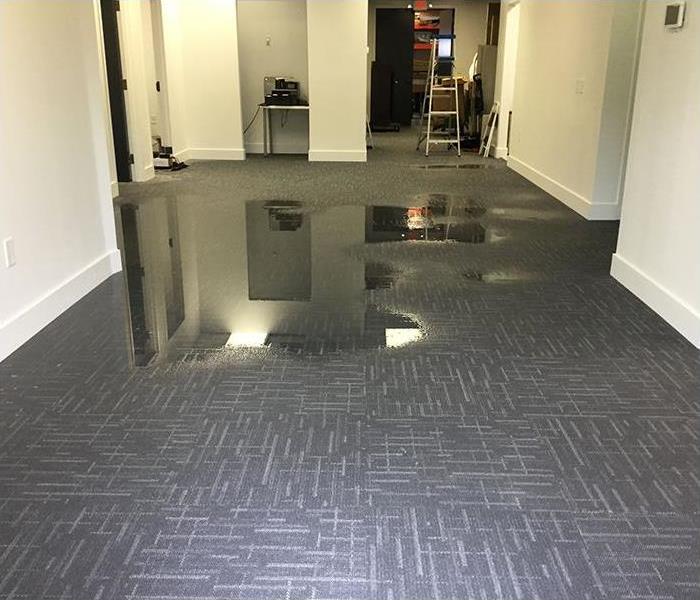 Water Damage can put your business operations on standby. Have a plan in place to minimize the possible delay.
Water Damage can put your business operations on standby. Have a plan in place to minimize the possible delay.
There’s nothing like the look and feel of a new business space, the machines all ready to run, furniture set up, and even the smell of the new carpet. Your mind is miles away from thinking about water damage. Hopefully, you’ll be lucky and nothing bad will happen. Or, heaven forbid you do have a flood, and the hard-taught lesson is learned. Either way, it’s always good to have some tricks and fixes up your sleeve so you can avoid commercial water damage and big headaches.
It has been said that commercial water damage is the most expensive problem you can have in a business with so many things that could be damaged and require repair or replacement. The damage may even cause further problems in the future. But there are several steps you can take to avoid the problems that could be thrown your way. It’s just a matter of keeping track of your office surroundings and acting to keep the status quo.
Here are a few tips to keep in mind when thinking about the prevention of commercial water damage in your business:
Make a Plan
- First, make a list of things that could happen to the items in your office. Come up with as many bad scenarios you can think of so you can realize the things to be taken care of.
- Find and store good contacts for services you may need in case of flooding, mold issues, or a fire.
- Make sure that you have an emergency space available to you in the unforeseen event that you need to have extensive renovations done on your office space.
- Also have a contact list of employees, vendors, and anyone else you may need to reach if things go awry.
- Have a good record of your belongings and find a place where you could take them for repair if necessary.
Put your plan into action
- Have an inspector come to check your building’s plumbing, pipes, roof, and the building structure itself.
- Be sure to follow instructions from your inspector regarding the issues he finds. Coordinate with the building’s owner to be sure you’re on the same page.
- Schedule yearly inspections so you know what needs to be repaired.
- Take a good look at any gutters that are adjacent to your office space. Clogged gutters can cause a great deal of trouble. It’s an easy fix in advance to keep a schedule and clean those gutters periodically.
- Parts and pipes age and need to be kept up to avoid leak problems.
Water damage in your business space is not only costly but traumatic. It can feel like you’ve taken one giant step backward in your goals and peace of mind. Understanding your potential pitfalls and knowing what you need to do to keep the status quo are your best options. But if you do have any kind of water damage, you can get great recommendations on the internet-they can help you through the process to ease your way.
Preventing Orlando Water Damage in Your Commercial Building
3/21/2019 (Permalink)
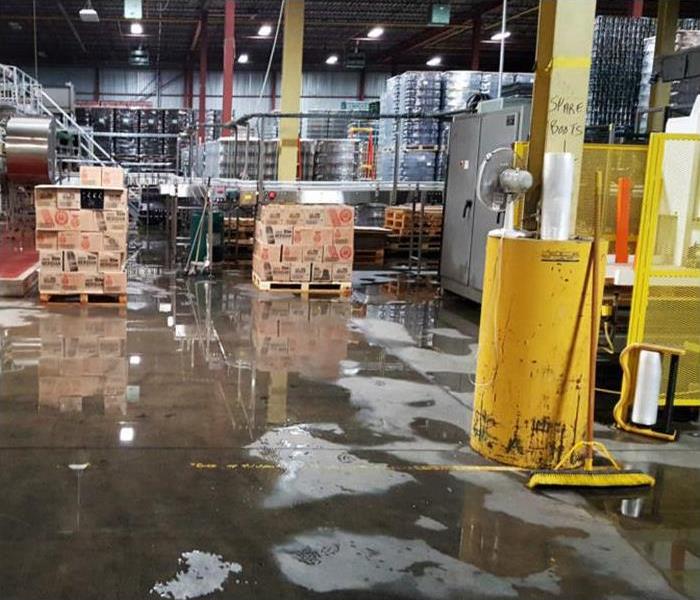 Water Damage can halt your commercial business operations and cost you a lot of money if you don't take precautionary measures.
Water Damage can halt your commercial business operations and cost you a lot of money if you don't take precautionary measures.
Making sure your Orlando business is able to run and function smoothly should always be a priority for business owners. Orlando water damage to commercial properties poses a serious threat to your operations. If not taken care of immediately, even a minor water issue can lead to extensive damage in a building such as mold growth and structural damage. Mold has the potential to make the damage increasingly worse, heighten repair costs, and affect the health of your employees. There are cases where water damage just cannot be avoided, such as natural disasters. However, most cases of water damage can absolutely be avoided and can be if commercial property owners take the proper precautionary measures to do so.
Because commercial spaces are typically larger than residential ones and are frequented by more people, they usually use up a larger amount of water. The costs for water are already higher but your utility and repair bills can increase dramatically with the presence of water leaks. To ensure your business is able to run without interruption, follow the tips below and prevent water leaks in your commercial property.
Schedule Routine Inspections
Paying attention to the property that your business is in is just as important as paying mind to the business itself. Make sure to routinely inspect the building’s pipes, plumbing, fire sprinklers, structure, and roof to make sure everything is as it should be or catch potential issues before they worsen. Wear and tear are completely normal and common in any building but should be addressed by a professional when noticed.
Seek Professional Assistance
An untrained eye can miss many issues. On top of looking for issues yourself, it is always best to seek the assistance of a trained professional in order to find and solve any problems you may have missed as well as conduct regular maintenance.
The more often you have regular maintenance to your property, the lesser chance you have for issues arising. It is important to know that just because you don’t notice any alarming concerns it does not mean that everything is ok. Leaks and damage can occur in hidden areas and can cause water damage to your Orlando property that is also unnoticeable. A professional can find these hidden issues and make sure they are properly taken care of.
Check and Clean Your Rain Gutters
Rain gutters are designed to redirect excess water away from your property when it rains. When they are not cleaned regularly they get clogged with leaves and other debris. The blockage makes it so that excess water is not able to escape and accumulates until it leaks into your building either through the foundation or the roof. Water damage that occurs this way can oftentimes extend from your roofing all the way through your insulation, walls, flooring, and foundation. Keeping your gutters clean and free for water to pass through can prevent a major disaster from happening.
Upgrades and Repairs
Water fixtures can wear out pretty quickly in a commercial establishment due to a large number of people using them. Many times, older pipes and fixtures are not able to handle the high-volume usage that comes along with the business. This can lead to leaks as well. Consider upgrading your fixtures and pipes to make sure they are able to handle the usage and do not wear out. An inspection by a professional will help to determine what should be upgraded in your building. You need to act fast though because the longer Orlando water damage goes unaddressed, the more the damage will spread, worsen, and will likely lead to mold growth.
If You Come Across Water Damage
In the event that you or a professional comes across water damage in your commercial building, you should take steps to prioritize your safety first and contact a water damage restoration company as quickly as possible. SERVPRO of Winter Park has a convenient location near downtown Orlando and the manpower and equipment to handle water disasters of all sizes. We have the fastest mobilization around and our phones are open 24/7 to assist with water extraction, structural drying, damage repair and more. If you need assistance, give us a call today at (407) 678-5391!
Water Damage Repair Winter Park
1/11/2019 (Permalink)
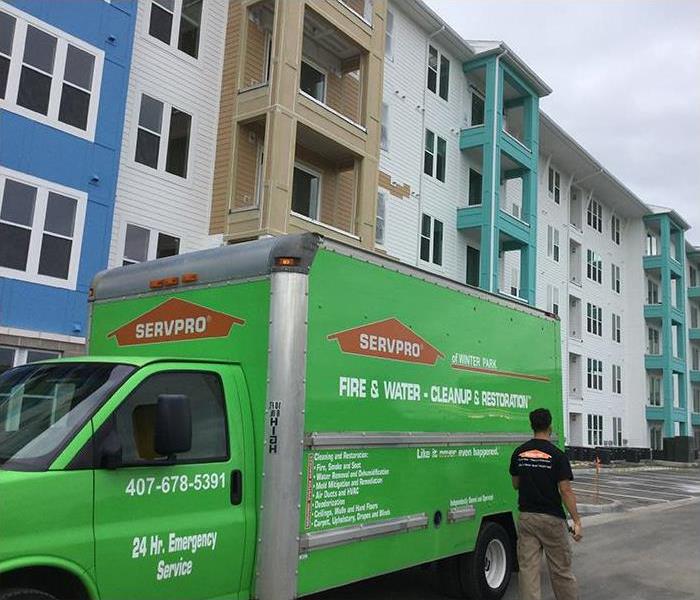 We have the fastest response time and service both Commercial and Residential clients.
We have the fastest response time and service both Commercial and Residential clients.
SERVPRO of Winter Park is the number one restoration company when it comes to performing water damage repair in Winter Park. Our independently operated and family-owned franchise is conveniently located right off of Fairbanks Avenue and has been servicing our locals since 2011. We take great pride in making a difference for homeowners and commercial property owners who experience water damage disasters. Here is what you can expect from choosing us as your local restoration service provider:
- 24/7 Emergency Water Damage Services
- 1-Hour Response Time or Less
- Most Knowledgeable Technicians in Winter Park
- IICRC Trained Office and Production Staff
- Fast and Fair Estimates Provided
- Large Vehicle Fleet and Fast Mobilization
- Large Equipment Inventory
- Warehouse Storage Availability
- Continuous Client Support and Communication
Water Damage Repair Process
Our Staff at SERVPRO of Winter Park is knowledgeable and experienced with water damage repairs and can expertly guide you through the process from beginning to end. Our IICRC certified professionals help to ensure that our services are provided professionally and all structures are completely dried in a timely fashion to stop chances for mold growth and further structural damage to the property.
Residential Water Damage
We work directly with homeowners to relieve as much stress as possible during their water damage disasters. For insured homeowners, we provide our knowledge of how the insurance process works during restoration and even communicate with insurance providers directly to make the process easier for our clients. We also work with self-pay clients and keep them informed of costs throughout the entire process.
Our team is trained to treat each home with the individual care it deserves and takes into account any unique structural designs to provide the best service as possible catered to your specific property. We are trained to extract water and dry multiple types of flooring including carpet, tile, laminate, and hardwood floors. Our approach is always to put our clients on-course to restoring their home to the way it was before sustaining water damage.
Commercial Water Damage
Our specific franchise has extensive experience in handling commercial water damage projects with a high degree of efficiency and professionalism. Our location is equipped to handle large scale water damage emergencies effectively. We also understand that not every business has the option of shutting down for repairs and do our best to provide you with great service while catering to your specific business needs during the process. In the past, we have been successful at closing off work areas while providing easily accessible pathways and work areas for our clients to continue running their business. We also specialize in handling water damage services for clients with high privacy needs who must keep their clients and customers unaware of the disaster. Our Operations Manager will work directly with your management to ensure that all specific needs are included in our approach.
Do You Need Water Damage Repair in Winter Park?
There are plenty of options to choose from when considering a restoration service provider in Winter Park. Our SERVPRO location is backed by the nation’s leading restoration company and has the resources and customer service to get the job done right across the board. Choose a company that is located right here in Winter Park with the fastest response time around. Our customers love us and share their experiences with online reviews that can be seen on Google, Facebook, and Yelp. If you have a water damage emergency, contact our office at any time or day at (407) 678-5391!
8 Fire Safety Tips for Deep-Fried Thanksgiving Turkey
11/21/2018 (Permalink)
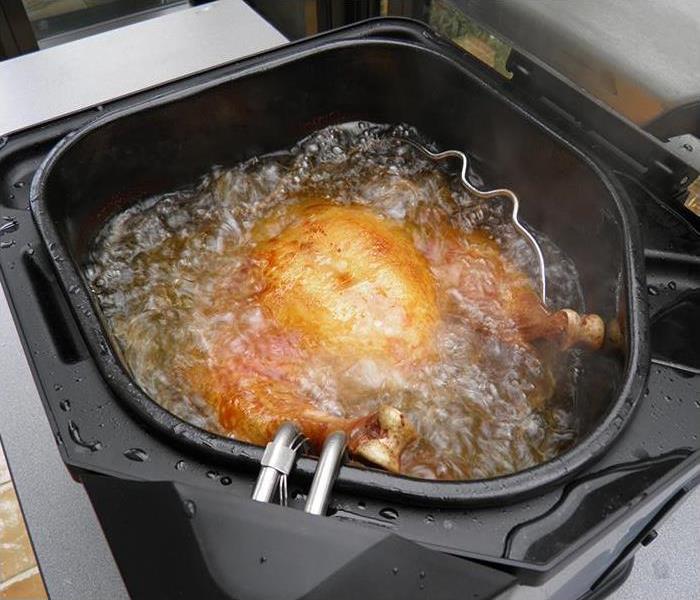 Thawing a turkey before frying it can prevent hot oil from coming into contact with water which can easily cause a rapidly spreading fire.
Thawing a turkey before frying it can prevent hot oil from coming into contact with water which can easily cause a rapidly spreading fire.
With each Thanksgiving that passes, deep-fried turkeys become increasingly popular in Florida. Deep-frying a turkey can be dangerous, though, and the process causes numerous fires each year. Make safety your priority when deep-frying turkey and follow these eight tips or you may find yourself calling a SERVPRO near you for fire restoration services.
1. Choose a Safe Location
To drastically decrease the likelihood of a fire in your property, set your deep fryer on level ground a safe distance away from your house, garage and shed. Avoid using the fryer on wooden decks, near piles of wood or under trees. A safe bet for a location is the center of your driveway with no cars present.
2. Completely Thaw Your Turkey
Water and oil do not mix. Make sure your turkey is completely thawed before you bring it anywhere near the fryer. Otherwise, when the ice hits the hot oil, it could cause the oil to rapidly boil over, causing a large and quick-spreading fire.
3. Keep a Fire Extinguisher Nearby
Because of the potential for fire, you will want to have a fire extinguisher within arm’s reach at all times. Fires can start and spread quickly, and you will not have time to run inside to retrieve one.
4. Do Not Overfill the Oil
A good way to know how much oil you will need is to place the turkey in a cold and empty fryer, then fill the fryer with water. Remove the turkey and note the water line. The oil should be filled no higher than that line to ensure that it does not spill over when you add the turkey.
5. Place Turkey in the Oil Slowly
Be careful handling the turkey, which will likely be slippery. If you slip and accidentally drop the turkey in the oil too quickly, the oil could overflow or splash, burning you and creating greater potential for fire. Lower the bird in slowly and gently.
6. Wear Safety Gear
Hot oil has a tendency to splatter, causing burns, blisters and ruined clothing. Make sure you wear goggles, gloves and an apron, and do not stand closer to the fryer than you need to.
7. Use a Thermometer
A thermometer is a great tool to use throughout the entire cooking process. Make sure the oil is hot enough before you begin, but watch that it does not become too hot. Cook the turkey only until it reaches the correct temperature then remove it and turn off the fryer immediately.
8. Never Leave the Fryer Unattended
Under no circumstances should you ever leave the fryer unattended. Bring everything you need outside before you begin cooking and ask someone else to retrieve anything you forgot. Fires can start in an instant and you will need to be there to act quickly.
In Case of a Fire
If you experience a fire this Thanksgiving Holiday, make sure to dial 911 immediately and inform your local fire department. If your property is damaged by the fire, call SERVPRO for the fastest response time and professional fire restoration services. SERVPRO of Winter Park specializes in cleaning smoke and soot left by smoke, extracting and drying water left by firefighters, and can help make sure your property is completely restored to the way it was before your disaster. Our phone lines are open 24/7 for emergency fire and water services at (407)-678-5391.
Mold Testing in Orlando and Winter Park
10/23/2018 (Permalink)
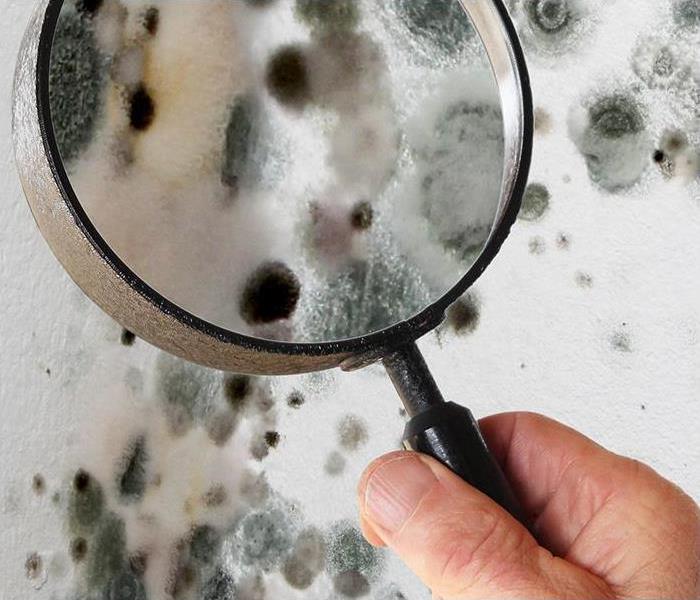 Even if mold is visible, it is important to conduct an air quality test to determine how far it may have spread.
Even if mold is visible, it is important to conduct an air quality test to determine how far it may have spread.
If you suspect you may have mold in your home or you are certain that you have mold in an area that is larger than ten square feet, you should absolutely be seeking a professional hygienist to perform mold testing. Many of our initial conversations with clients consist of explaining the mold remediation process and guiding them towards taking the correct actions. In this article, we will explain what it means to have mold testing done in your home, why it is important, and what you can do to get the process going correctly.
Does SERVPRO Test for Mold?
Most of our callers assume that testing for mold and removing it are the same service. However, while SERVPRO of Winter Park is licensed to remediate and remove mold, we are not actually licensed to test for mold or determine whether you have a mold issue at all. Here’s why.
In the state of Florida, there are laws in place that protect businesses and homeowners by not allowing any particular business to simultaneously hold a remediator license and a testing license at any given time. The licenses are separated to ensure that you, as the homeowner, are safe from conducting business with any company that may wish to perform testing on your property, inflate estimates for remediation, and overcharge you for services performed.
If SERVPRO Can’t Test, Who Can?
The decision of who to call to schedule mold testing services is entirely up to you unless your insurance company specifies otherwise. There are many testing companies available in Central Florida but it is important to know what you should expect from your company of choice. Be wary of companies that offer to perform remediation as well or companies that do not provide full documentation after tests are completed. While SERVPRO of Winter Park does not provide this service, we understand how confusing the search for a trustworthy mold inspection company can be, which is why we provide our callers with recommendations for mold testers that have proven to be efficient and thorough.
What Should I Expect from The Mold Tester’s I Choose?
Multiple Tests
Solid mold testing companies in Orlando and the surrounding areas will actually perform more than one test in your home. Taking surface samples from your home can determine the type of mold you are dealing with, however, doing this type of testing alone is insufficient in determining the extent to which your home is affected or the actions that must be completed to successfully remediate and ensure the problem is gone.
Air quality samples should also be taken from multiple areas throughout your home. Mold is a living organism that releases spores that become airborne and can travel throughout hour home and ventilation, affecting other areas as well. Air quality tests will determine how much of your home is affected and to what extent.
Comprehensive Reports and Protocols
A professional mold assessor will provide you with the full details of your testing results and their findings. You should expect a report that contains a variety of information such as the type of mold species that was found, how many areas are affected, and which areas contain the highest concentration of spores.
Just as important, you should make sure to receive a written protocol from the mold testers that details what actions are needed in order to successfully remediate the mold so that the problem does not worsen and will not come back.
Will SERVPRO Remediate Without Testing?
SERVPRO of Winter Park will NOT perform services for any client that cannot provide a written protocol for proper remediation. As an IICRC licensed remediation company, we follow strict guidelines to ensure quality work and services are provided to our client’s.
The only exception to this rule is in the case of clients who have a mold problem that is only affecting an area that is less than ten square feet. While we still recommend proper testing is performed, areas smaller than ten square feet do not require testing and be removed of mold or mildew, treated, and sanitized.
How to Get Mold Testing Started
Once again, finding your own mold testing company is your choice. Be sure to do as much research into the company you choose as possible and remember the key points made in this article. If you need assistance, direction, or recommendations for trustworthy mold inspection companies, call our office at (407) 678-5391 and we will be more than happy to assist you!
Mold Damage on Clothing in Orlando
9/6/2018 (Permalink)
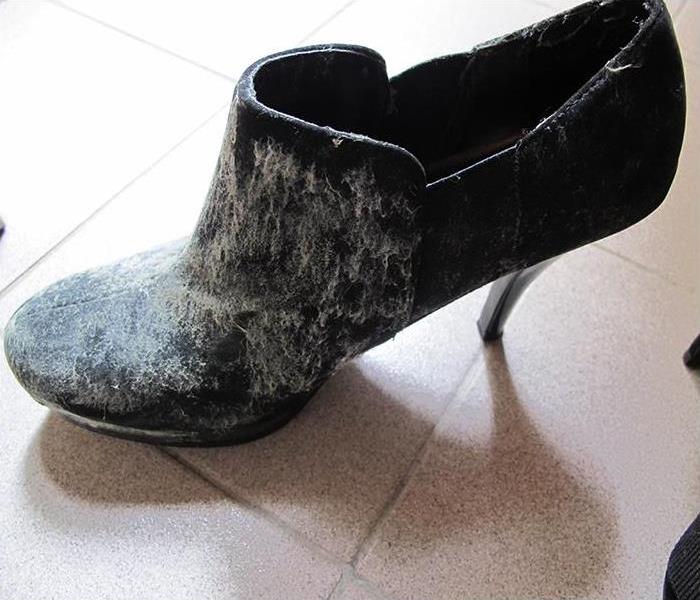 Most types of clothing are extremely susceptible to mold growth as their porous materials provide the perfect habitat for the organism to thrive in.
Most types of clothing are extremely susceptible to mold growth as their porous materials provide the perfect habitat for the organism to thrive in.
SERVPRO Can Help You Determine Which Items are Salvageable
Mold in the house is something every homeowner in the Orlando area fears. Mold problems usually mean that you have water or moisture coming from somewhere. Therefore, your first priority should be to address this source, whether it is a hole in the roof or a leaky basement. When correcting the root of the mold problem, it is important to remove any mold that has managed to grow on any of the surfaces. This includes furniture, walls, and sadly, even your clothing.
Mold damage on your favorite clothing can be heartbreaking. One of the main ways mold may develop on clothes is if they have been in storage for too long. Perhaps you stored your winter pullovers in boxes in the attic where there is a hidden moisture problem, or you accidentally tossed wet clothes into a storage bag before they had a chance to dry completely.
What Type of Clothes Does Mold Grow On?
Clothes made from natural fibers like silk, wool, rayon, jute, ramie, linen, and cotton are more susceptible to mold damage than those made with synthetic fibers. SERVPRO of Winter Park offers mold remediation services. Our technicians can help you sort out those that are salvageable with mold remediation techniques. When mold develops on clothes, it produces enzymes that break down the protein or cellulose to compounds that the mold uses for food.
What Signs Should You Look For?
Often, the initial sign of mold damage on clothes is a distinct musty smell in the closet. After careful examination, SERVPRO technicians can detect stains with visible mold growth or visible pigmentation. Mold on clothes can appear in the form of spores, which are easy to clean up using simple mold control techniques.
In case of severe mold damage, it is best to get rid of the item. Even then, such clothes should be handled with caution because certain species of mold may cause health effects. Here is some more information on restoring contents.
6 Fire Restoration Do's and Don'ts for Maitland Homeowners
9/6/2018 (Permalink)
 Some cleaning after a fire can be done yourself but the only way to ensure proper removal of soot is to contact a professional restoration company.
Some cleaning after a fire can be done yourself but the only way to ensure proper removal of soot is to contact a professional restoration company.
It is extremely common for Maitland homeowners to panic even after a fire making countless mistakes that can both put their safety at risk or make restoration more difficult and costly. Knowing what to do and what not to do beforehand can make you better prepared to handle the situation at hand and save you money and keep you safe as well. Here are some examples of what you should and should not do after a fire.
6 Fire Restoration Do's
1. Avoid soot particles from being embedded into your home's carpets and tracked throughout the rest of the property by limiting movement through your home.
2. Avoid soiling your home's upholstery, walls, and woodwork keeping your hands completely clean at all times. To make this easier, use disposable gloves and change them out multiple times throughout your cleaning process.
3. Prevent additional foul odors by removing your fridge from its electrical source and propping the refrigerator and freezer doors open. Also, remove perishable items from the refrigerator.
4. Wipe soot from metal surfaces and fixtures such as sink faucets and appliances.
5. Use a damp rag or cloth to remove soot from household plants.
6. Change HVAC filter, but leave system off until a trained professional can check the system.
6 Fire Restoration Don'ts
1. Don't attempt to wash any walls or painted surfaces without first contacting a professional fire restoration company.
2. Don't attempt to shampoo carpet, rugs, or upholstered furniture without first consulting a professional fire restoration company.
3. Don't attempt to clean any electrical appliances (TV sets, radios, etc.) that may have been close to fire, heat, or water without first consulting an authorized repair service.
4. Don't consume any food or beverages that may have been stored close to fire, heat, or water. There is a high probability that these items have been contaminated.
5. Don't turn on any ceiling fixtures if you suspect that your ceiling is wet. Wiring may also be wet or damaged and can cause electrical shock, and air movement may create secondary damage.
6. Don't send garments to the dry cleaner. Improper cleaning may set in smoke odor.
Establishing an ERP Plan for Your Business
9/5/2018 (Permalink)
 An ERP plan ensures that you have a dedicated response team to your disaster that already has an actionable plan to restore things back to normal.
An ERP plan ensures that you have a dedicated response team to your disaster that already has an actionable plan to restore things back to normal.
There is no way to predict when a disaster can strike your business, but there are ways to be prepared for it when it does happen. Why is it important to be prepared? Well, a disaster occurring in your business has the potential to bring your operation to a screeching halt, which means your business could lose more money than it would if you had a plan in place to get things up and running again quickly. Some disasters can lead to a long road to recovery that is not only for commercial restoration but also being able to offer services, help your clients and customers, and start bringing money back in.
SERVPRO of Winter Park knows just how important a running business is to its owners and is able to establish a plan for your business called an ERP, or Emergency READY Profile.
- A no-cost assessment of your facility. This means there is no need to allocate funds, giving you a great value at no cost.
- A Profile Document containing only the crucial information you will need in case of an emergency. It doesn’t take very long to complete, but it will save you a lot of time (and from one more headache) if you ever need it.
- A guide to help you get back into your building following a disaster. By having an immediate plan of action, you can help minimize downtime. Here are some of our building services.
- Establishes SERVPRO of Winter Park as your emergency mitigation and restoration provider. You have a provider that is recognized as an industry leader and is located right here for Winter Park and the surrounding area.
- Identifies the line of command for authorizing work to begin. This saves time so that we can begin the work of mitigating the damage immediately, which can save you both time and money.
- Provides important facility details such as priority contact information, priority areas, and shut-off valves. Having a quick reference of what to do, how to do it, and who to call provides solutions in advance of an emergency so that during the emergency you are “Ready for whatever happens.”
Are you ready to set up an Emergency READY Profile for your business or have more questions on what the process is like? Give SERVPRO of Winter Park a call today at (407) 678-5391.
6 Things Your Flood Insurance Will Not Cover
8/28/2018 (Permalink)
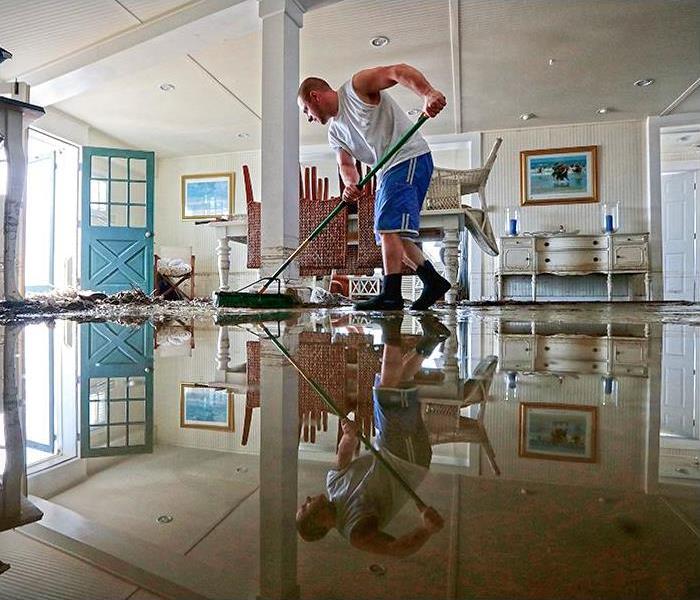 Floods are stressful disasters to deal with. Knowing what your policy does and does not cover will help you be prepared and know what to expect.
Floods are stressful disasters to deal with. Knowing what your policy does and does not cover will help you be prepared and know what to expect.
Flood Insurance Does Not Cover Everything
Flood insurance is extremely important when trying to make sure you are prepared for a worst-case scenario during a large storm or hurricane. While this type of coverage is worth looking into, it is important to know that there are types of damage that are actually not covered by your policy so you are not blindsided if you ever need to make a claim. Knowing the key restrictions and limitations of your flood insurance policy will leave you better prepared.
1. Water Damage from Internal Malfunctions
A flood that is caused by internal malfunctions in your home such as a pipe burst or overflowing toilets is not covered by a flood policy. Damage will only be covered if the source of water that caused the flood is external, such as an overflowing lake or heavy rain during a storm. Make sure that you are covered for floods from internal malfunctions by having a homeowner’s insurance policy as well. Talk to an agent or adjuster from your insurance policy for more information and questions about the kind of water damage your policy will cover.
2. Landscaping and Swimming Pools
Although your swimming pool may be located outside of your actual home, if your home is flooded by your pool it will not be covered by your flood insurance policy. Also, damage to flower beds, gardens, trees, or any other landscaping on your property will not be covered.
3. Damage from Small Floods
Unless the water that causes damage to your property covers at least two acres or has also affected another property, the water will not be considered a flood by your insurance company. Also, if your home sustains damage from mold or mildew that could have been prevented, you will not be covered for the damage under your policy.
4. Living Expenses and Business Interruption
Any living expenses that you incur from the flood, such as renting a hotel room, will not be covered by your flood insurance policy. Also, if you run a home business and your operations are interrupted, financial losses will not be covered.
5. Money and Important Papers
Your policy won't pay for the value of any currency, precious metals, stock certificates, and other valuable papers that get destroyed in a flood.
6. Improvements and Most Contents in Below-Ground Areas
You will not be covered under your flood insurance policy for any improvements made to your basement, such as finished walls or floors. Also, personal property such as clothing, computers and electronic equipment, kitchen and office supplies, furniture, and other items located in your basement or any other areas below the lowest elevated floor of your home will not be covered.
2 Free CE Classes for Insurance Agents & Adjusters
8/23/2018 (Permalink)
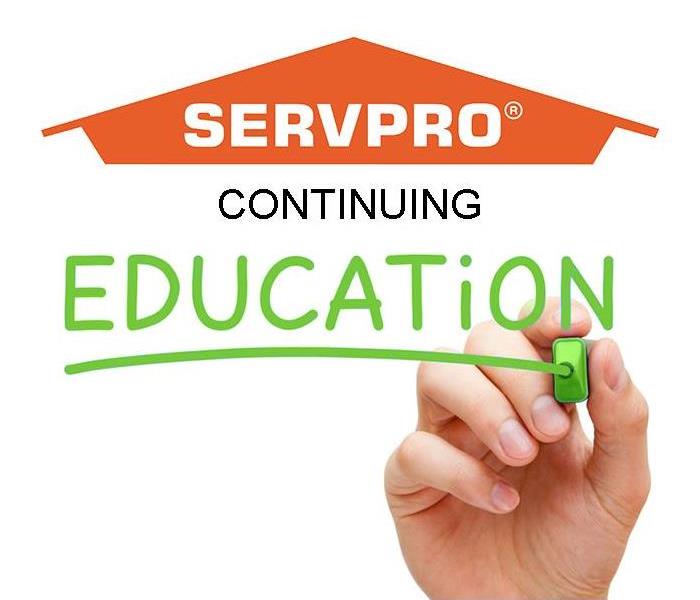 Join us at SERVPRO of Winter Park on September 26th for 2 Free CE Classes!
Join us at SERVPRO of Winter Park on September 26th for 2 Free CE Classes!
SERVPRO Industries, Inc. #292716 will be offering TWO FREE Continuing Education Seminars on:
September 26, 2018
CLASSES WILL BE HELD AT THE FOLLOWING LOCATION:
SERVPRO® of Winter Park
665 Jackson Avenue
Winter Park, FL 32789
For reservations contact:
SERVPRO® of Winter Park
407-246-9713
kristin@SERVPROwinterpark.com
- Breakfast and Lunch will be provided
- Class Size is Limited
- Please Confirm Guests Attending
The subjects will be:
Restorative Drying for Water Damage
This course has been approved by the Florida Department of Financial Services for insurance continuing education credit.
Course Credit: 4 hours
Course # 97654 agt./97655 adj.
Registration Time: 8:00 a.m.
Course Time: 8:30 a.m.-12:30 p.m.
*INTERMEDIATE LEVEL – This course has been designated by the Florida Department of Financial Services as INTERMEDIATE level. It is intended for the student who has a basic knowledge of the subject matter or who has limited experience with the subject matter.
100% Attendance is REQUIRED in order to receive CE Credit for this course.
Understanding Mold in the Restoration Industry
This course has been approved by the Florida Department of Financial Services for insurance continuing education credit.
Course Credit: 2 hours
Course # 98756 agt./98757 adj.
Registration Time: 12:45 p.m.
Course Time: 1:00 p.m.-3:00 p.m.
*INTERMEDIATE LEVEL – This course has been designated by the Florida Department of Financial Services as INTERMEDIATE level. It is intended for the student who has a basic knowledge of the subject matter or who has limited experience with the subject matter.
100% Attendance is REQUIRED in order to receive CE Credit for this course.
Flood Insurance Policies for Florida Homeowners
8/22/2018 (Permalink)
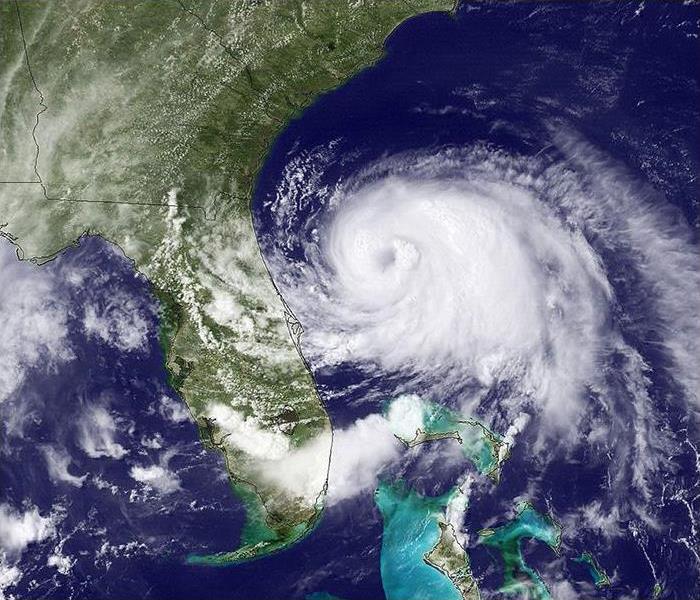 Make sure to get a flood insurance policy 30 days or more prior to hurricanes to ensure that damage is covered!
Make sure to get a flood insurance policy 30 days or more prior to hurricanes to ensure that damage is covered!
A common mistake that many Florida homeowners make each hurricane season is the assumption that their homeowner’s insurance will cover property damage that is caused by floods and hurricanes. If your property is in an area with a high risk for damage, such as near a lake, then you may want to consider purchasing a separate policy to make sure your home and its contents are covered.
How Do You Get Flood Insurance?
Flood insurance is managed by the Federal Emergency Management Agency (FEMA) but can be purchased through your insurance agent or broker through the National Flood Insurance Program (NFIP). Availability for these policies is open to NFIP-participating communities that have agreed to pass and enforce specific stormwater and floodplain management laws. To reach an agent, contact the NFIP at 888-379-9531.
How Much Coverage Can You Get?
NFIP flood insurance policies can provide a maximum coverage of $250,000 and $100,000 for contents. These types of coverage must be purchased individually but can be a part of the same policy. According to the NFIP, the average cost for a policy typically runs around $700 annually. Additional coverage may also be purchased through private insurers.
Do You Really Need this Policy?
When purchasing a home in a designated high-risk flood zone and receiving a mortgage loan from a federally regulated or insured lender, you are required to purchase flood insurance.
If you live in a zone that has been designated as a moderate or low-risk flood zone, you are not required to purchase a policy. However, though you are not required to purchase the policy, you may want to consider doing so anyway to protect yourself from paying out of pocket in case of an emergency. According to FEMA, approximately twenty-five percent of flood insurance claims come from areas. That still makes up a large portion of recorded home damage due to hurricane and flood-related disasters!
The good news is that if you do live in a low-to-moderate flood risk zone, you may be eligible for a much lower insurance rate. Some premiums of flood insurance policies for these homeowners have been seen to be as low as $137 per year for both property and contents coverage.
Are Payouts for Contents and Property Different?
Yes, there is a difference in the way insurance companies will pay out for different types of coverage.
- Contents - Flood insurance will pay a cash value for the cost to replace lost or damaged contents. The amount paid out also factors in the depreciated value of used goods.
- Property - If receiving insurance for a single-family home as your primary residence, you can opt for the replacement of damaged or lost property with new property, regardless of depreciation. The amount of coverage for your property is set in advance and is typically either eighty percent of the full replacement cost for your property or the maximum amount available under the NFIP.
Why You Should Act Now
Flood insurance works a bit differently than other types of insurance policies. With a few exceptions, your coverage does not typically kick in until you have had your active policy for 30 days. If a disaster, such as a hurricane, occurs within this time frame, your insurance policy will not cover the costs of damage.
Also, there are other benefits to activating your policy early. Aside from hurricane damage, a flood insurance policy will also cover you for damage resulting from heavy or prolonged rainstorms, coastal storm surges, clogged storm drainage systems, and mudslides!
After Receiving Flood or Hurricane Damage
After hurricane damage or flood damage has occurred, you should call your insurance provider and establish a claim. Once your adjuster has been notified, calling a professional restoration company can ensure that your damage is attended to properly and your home gets back to the way it was. SERVPRO is the largest nationally recognized name in restoration and is recommended and trusted by many of the largest insurance providers. SERVPRO of Winter Park is available around the clock for emergency storm damage services and have the fastest response times to begin extracting water from your home and drying the property out. If you receive flood damage, give our office a call at 407-678-5391.
10 Orlando Fire Damage Facts for Homeowners
8/1/2018 (Permalink)
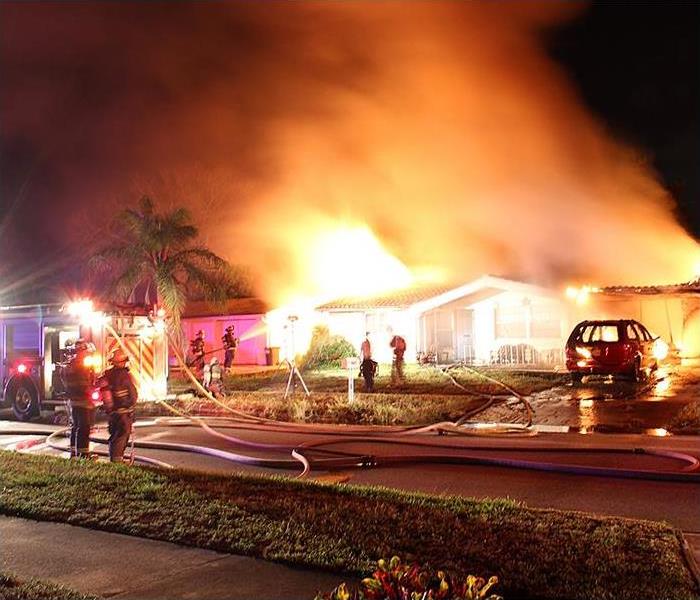 Aside from flames and soot, additional damage in a fire disaster can also occur from firefighters cutting ventilation holes and spraying water.
Aside from flames and soot, additional damage in a fire disaster can also occur from firefighters cutting ventilation holes and spraying water.
While flames can cause the most visible damage to your Orlando property during a fire, smoke and soot are silent and sometimes invisible hazards that could cost lives. Water is also a reason for damage after a fire. Even firefighters themselves may cause some damage before they can completely put out a fire. Here are 10 important things to know about fires.
Fire Dangers
1. Most deaths in fire disasters are a result of smoke being inhaled, not from contact with the flames themselves. When avoiding flames from a fire, make sure to remove yourself from any areas with smoke as well.
2. Soot is a coating of fine, black dust created when wood, coal, or oil-based substances are burned. These carbon particles float into the air and settle anywhere. Inhaling soot can cause severe lung deficiencies or even death.
3. Other effects of soot inhalation that can occur are cancer and serious defects in newborns. Soot produces polycyclic aromatic hydrocarbons. These hydrocarbons are responsible for gene mutation for particular groups of genes.
Water’s Effect on Fire Damage
4. Certain types of fires can be successfully put out using water. It is important to make sure that after a fire is extinguished, all wet components of your home or business are completely dried. If moisture is allowed to remain, mold, mildew, and other consequences can grow and lead to further damage and loss. This is why SERVPRO of Winter Park provides industrial dehumidifiers and air movers to dry saturated carpets, padding, furniture, and any other wet items.
5. Orlando and the rest of Central Florida are known for high levels of humidity. Because of this, mold colonies can begin to grow just 48 hours after water damage occurs. The combination of fire, water, and mold damage to your commercial property or home could result in a complete loss if not handled properly. See more about mold remediation here.
Firefighters Break Windows And Cut Holes
6. Firefighters often must break windows and cut holes in the roof of buildings on fire. As a fire burns, the fire moves up and down and across, growing very fast. Firefighters break windows and cut holes in roofs to provide ventilation that slows the fire’s growth. Ventilation also helps get rid of dark smoke that makes it hard for firefighters to see where they’re going. The holes and broken windows help firefighters fight the fire more quickly. The bottom line is that breaking windows and cutting holes in roofs help save lives and property. Damage caused by these techniques should be repaired quickly and properly to avoid additional damage.
7. Firefighters will also cut holes in walls at times. This is not done for the purpose of ventilation. It’s done so the fire department is sure that the fire is completely out. Fire departments don’t want to risk leaving a fire that’s not visible but is still active inside the walls or in other hidden places.
8. If you have a fire, get a copy of the fire report. In most areas, a fire report is a public document. Ask for it at the fire department or fire marshal’s office. The fire report will help you with information that your insurance company and other official offices may request.
Fire Damage Restoration
9. If soot contaminates items in your home or business, an Orlando fire damage restoration service provider like SERVPRO of Winter Park must assess the damage to see if restoration is possible. A professional company can properly assess the damage, provide closer estimates for the cost of repairs, work closely with your insurance company, and ensure that damage is restored properly.
10. Use caution if you decide to do some of the cleanups after a fire. Never start your cleaning process until you’ve attained the proper safety attire. Wear heavy-duty gloves, safety goggles, and a face mask. Carefully cover your nose and make sure your safety glasses have no place for dust or soot to get into your eyes.
Here To Help
Our team has specialized training and experience in fire restoration services and natural disaster cleanup in Orlando and the surrounding areas.
Call SERVPRO of Winter Park at (407) 678-5391 anytime, 24/7.
How Water Damage Affects Carpeting in Your Orlando Home
7/27/2018 (Permalink)
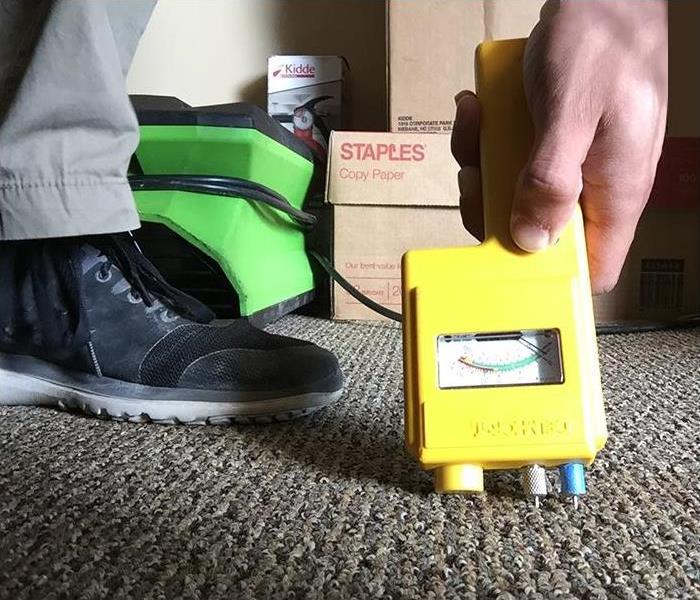 Our before and after tests determine the amount of moisture in your carpet and ensure it is completely dried when we are finished.
Our before and after tests determine the amount of moisture in your carpet and ensure it is completely dried when we are finished.
When a pipe bursts or water enters your Orlando home through faulty roofing, the water will follow gravity as it flows into your home. If your home has carpeting, it is important to know how water damage can occur in the event of a water disaster. Carpet fibers are porous so water can soak into the material and hold moisture. If carpeting gets saturated, glues can weaken causing the backing to peel away from the fibers.
Padding and Subfloors Can Also Be Affected
Carpet can also hold in moisture causing microbes to develop on the surface of the subfloor underneath. When mitigating water damage in Orlando, our SERVPRO technicians take extra measures to save carpeting materials. When the padding underneath the carpet gets wet, it can disintegrate and fall apart. Pad often gets removed and replaced since it is typically inexpensive to install.
How Moisture is Removed
We follow a water repair process that is proven to work and do not cut corners to save time at your expense. The first step in removing moisture from carpet is to extract it using specialized equipment. Either a portable or truck-mounted extractor gets used to pull water into a disposal tank. Industrial strength wands are applied to the wet carpet and are connected to the water extraction equipment. Extracted water travels from the extractor to the truck mounts where it is kept until properly drained elsewhere,
After extraction is completed, drying equipment gets set up to dry out the carpet inside your apartment. Air movers push air in a circular motion speeding up the evaporation process. Dehumidifiers then get utilized to pull moisture out of the environment and lower the property's relative humidity.
In some cases, the carpet gets extremely wet and the subfloor underneath also gets affected by moisture. In situations like these, our SERVPRO water damage restoration technicians pull up the carpet and place an air mover underneath it to float the flooring material drying the floor covering from underneath while drying the wooden subfloor at the same time. Once moisture levels in both affected elements return to what they were before the loss occurred, the air movers get removed.
Professional Water Damage Services
Before we finalize the project we use carpet tools to put the material back into the same condition, it was before drying procedures took place. The last step usually involves cleaning the carpeting with disinfectant solutions. If you ever need help dealing with wet floors, call SERVPRO of Winter Park at (407) 678-5391 24 hours a day.
Choosing Professional Restoration For Your Water Damaged Orlando Retail Store
7/16/2018 (Permalink)
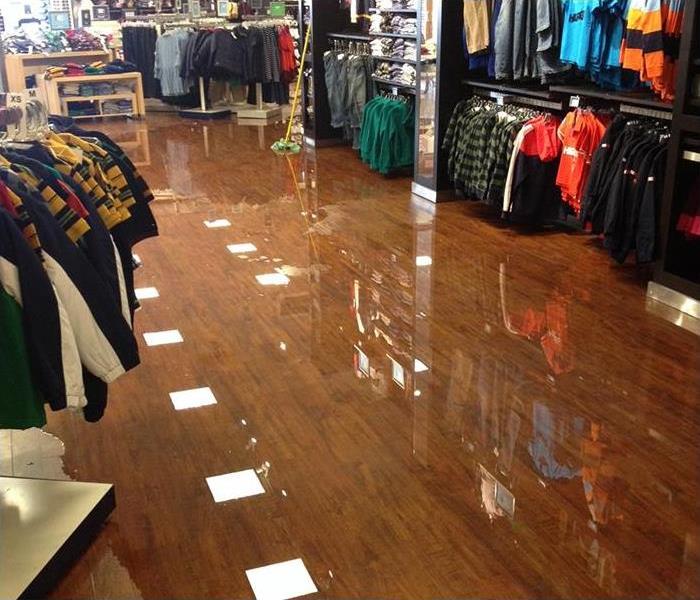 Choosing a professional restoration company is the fastest way of getting your retail store running again!
Choosing a professional restoration company is the fastest way of getting your retail store running again!
Running your own business comes with a handful of challenges that you seemingly regularly work to overcome. Natural disasters and unforeseen events occurring within the building of your business pose another threat that you cannot ever adequately prepare for, leaving you contending with varying degrees of damage to your Orlando retail store. In cases of even low-end water loss incidents, choosing the right professional assistance can make the process run much more smoothly.
The Advantage of Professional Restoration
Regardless of the cause of the water damage to your retail store, you instantly get preoccupied with how to restore the damage and get your store back to the way it was. Fortunately, when you choose the right professional restorers, this does not have to be the daunting task that it could have been.
As a business owner, you often get fixated on the cost of the work that needs to get done and how these unfortunate circumstances are going to affect profits in the months to come. While in many instances of water damage your doors have to be closed for a period to allow for restoration work to occur, the time it takes to do it yourself vs. professional restoration is rarely close. In fact, with the experience and equipment available to our SERVPRO professionals, restoration work often takes much less time than it could have for a business owner to work on the damage themselves.
Another critical thing to consider when choosing SERVPRO over any of the alternatives at your disposal is the quality of the work that we do. In instances of water damage throughout your retail store, lingering moisture and dampness from improper cleaning can allow for much more severe occurrences like mold and fungal growth in your store.
Choosing the Right Company
When water damage threatens your business, it does not just stop with the structure itself. All of the stock and contents of your business are at the mercy of this moisture and wetness, causing irreparable damages that can cost you even more. Trust in our SERVPRO of Winter Park technicians to respond rapidly and get right to work on correcting the situation you face. Give us a call anytime you require assistance at (407) 678-5391.
When is DIY Mold Removal an Option in Winter Park?
7/10/2018 (Permalink)
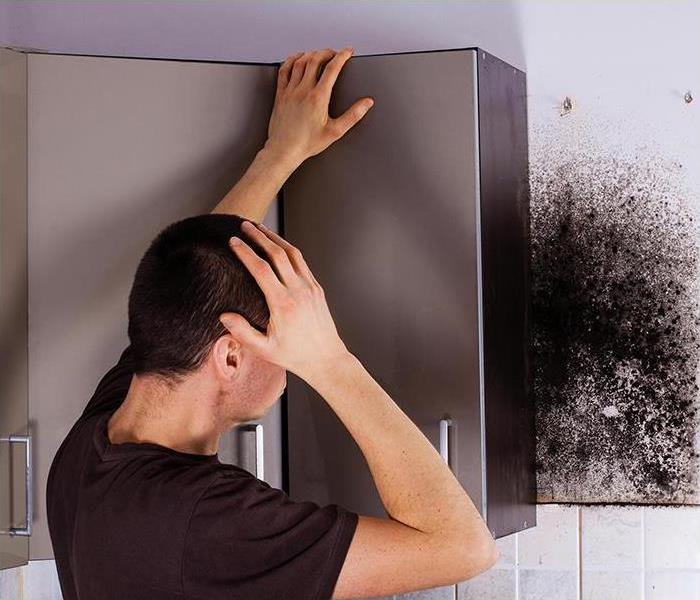 You should not attempt to remove mold if you are experiencing health problems of any sort.
You should not attempt to remove mold if you are experiencing health problems of any sort.
Many homeowners are interested in DIY (Do-It-Yourself) mold removal. They want to know how to clean mold themselves because they want to save money. Some also like the satisfaction of doing a job themselves. In some cases, it makes sense to handle a household mold problem yourself. Sometimes, though, it’s necessary to call in a professional that knows how to clean mold, like SERVPRO of Winter Park
When Is DIY Mold Removal a Good Idea?
Cleaning up mold yourself may be a good idea if:
- The mold only covers a small area.
- The mold is growing on easy-to-clean surfaces like glass, metal, tile, tubs, or sinks.
- The mold is growing on hard-to-clean materials, like carpet, that are easy to remove and replace and you know how to do it properly.
- You don’t have any health problems likely to be made worse by increased exposure to mold (check with your doctor if you’re not sure if it’s safe for you to clean up a mold problem yourself).
Of course, you always have the option of hiring a professional mold remediation company for the job if you don’t want to do it yourself or simply don’t have the time or energy for what can be a time-consuming process.
When Is DIY Mold Removal Not a Good Idea?
In some situations, it’s better to call in a mold remediation professional for assistance. Cleaning up mold yourself is probably not such a good idea if:
- The mold covers a large area (greater than three feet by three feet, according to the Environmental Protection Agency).
- Mold develops after flooding with water that might be contaminated with sewage or other potentially hazardous substances.
- There is mold in your heating, ventilation, and air conditioning system (most homeowners have neither the knowledge nor the equipment needed to properly remove mold from their HVAC systems).
- You aren’t sure how to do all parts of the job correctly (if, for instance, there is mold inside your walls and you don’t know how to remove and replace drywall) or you don’t have all the tools required to do the job (such as a drywall saw, if you need to remove moldy drywall).
- You have moldy wood that cannot be removed and replaced, so the moldy area needs to be sanded and encapsulated instead (it’s recommended that only mold remediation professionals sand moldy wood since it significantly increases one’s exposure to mold, which can lead to potentially serious illnesses).
- You have a medical condition that might be made worse by increased exposure to mold (check with your doctor if you’re not sure if increased exposure to mold may exacerbate your medical condition).
Expert Mold Removal Services and Advice
If you need help with mold removal, or if you’d just like some professional advice before beginning DIY mold removal, we suggest consulting with a mold remediation specialist in Winter Park. You can schedule an in-home consultation with a professional that knows how to clean mold. You can use our expert advice to determine whether or not it’s a job you’re prepared to tackle yourself.
If you suspect mold that you cannot handle or need advice, contact SERVPRO of Winter Park at 407-678-5391.
Water Damage Timeline Following a Disaster
6/20/2018 (Permalink)
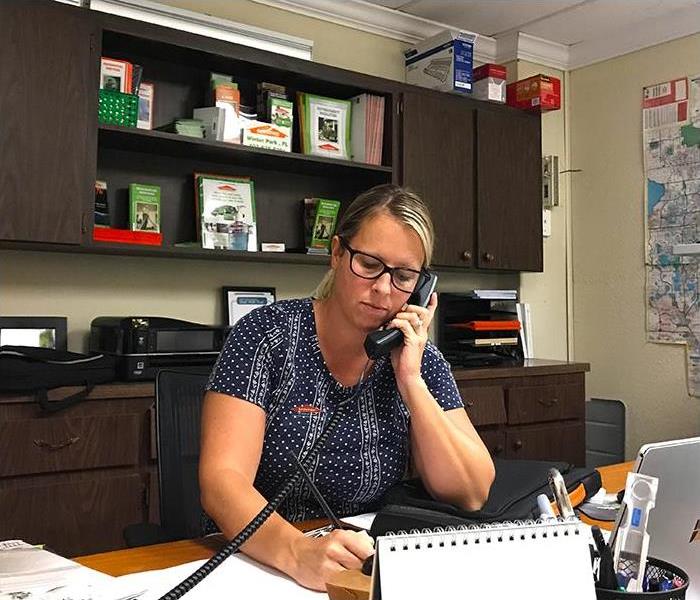 SERVPRO is available 24 hours a day and 7 days a week to take your emergency water damage call!
SERVPRO is available 24 hours a day and 7 days a week to take your emergency water damage call!
Flooding and water damage can occur for a number of reasons and can happen very quickly with very little notice. SERVPRO of Winter Park arrives quickly and starts the water extraction process for your property almost immediately. This prompt response helps to minimize the damage and the cleaning and restoration costs.
Within Minutes:
- Water quickly spreads throughout the property, saturating everything in its path.
- Water is absorbed into walls, floors, upholstery, and belongings.
- Furniture finishes may bleed, causing permanent staining on carpets.
- Photographs, books, and other paper goods start to swell and warp.
Hours 1 - 24:
- Drywall begins to swell and break down.
- Metal surfaces begin to tarnish.
- Furniture begins to swell and crack.
- Dyes and inks from cloth and paper goods spread and stain.
- A musty odor appears.
48 Hours to 1 Week:
- Mold and mildew may grow and spread.
- Doors, windows, and studs swell and warp.
- Metal begins to rust and corrode.
- Furniture warps and shows signs of mold.
- Paint begins to blister.
- Wood flooring swells and warps.
- Serious biohazard contamination is possible.
More Than 1 Week:
- Restoration time and cost may increase dramatically; replacing contaminated materials and structural rebuilding may be extensive.
- Structural safety, mold growth, and biohazard contaminants pose serious risks to occupants.
About SERVPRO of Winter Park
SERVPRO of Winter Park specializes in the cleanup and restoration of residential and commercial property after a fire, smoke or water damage event. Our staff is highly trained in property damage restoration. Give us a call if you have any questions (407) 678-5391!
Cleaning Different Types of Smoke and Soot in Winter Park
6/15/2018 (Permalink)
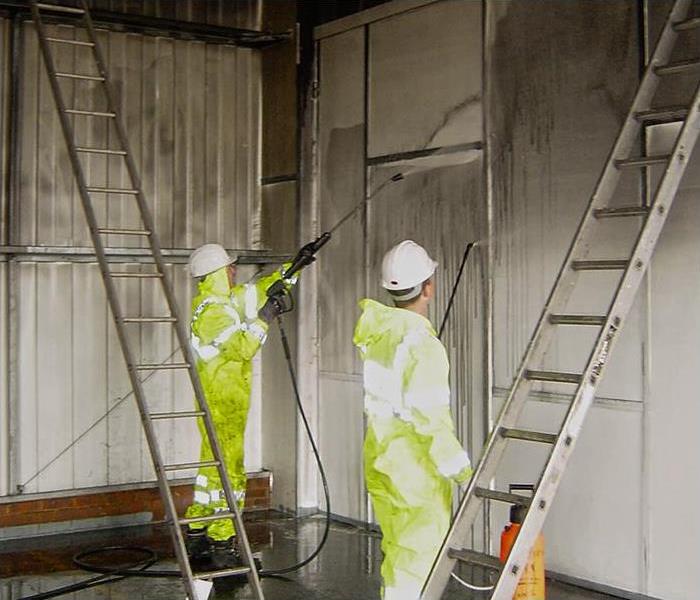 Soot caused by dry smoke can be removed with dry sponges and cleaned with water-based chemicals.
Soot caused by dry smoke can be removed with dry sponges and cleaned with water-based chemicals.
When a fire occurs in your Winter Park home, the heat and flames are not the only fire damage causing problems to be concerned about. Smoke generated from the blaze burning structural materials and other components can travel throughout an entire home and ruin its contents. Residue from the smoke can permanently stain contents and building materials requiring them to be replaced. In some cases, it is possible to salvage contents and materials by cleaning and removing soot residues. The level of difficulty for doing so is contingent on the type of soot that is present in the property following the fire.
Wet Smoke Versus Dry Smoke
The length of time and overall cleanability of soot strongly depends on how wet or dry the smoke that caused the damage was. Dry smoke is a result of the blaze burning natural materials quickly and with a significant supply of oxygen. Wet moke occurs when a fire burns synthetic materials at a slow pace with very little oxygen. It is extremely common for a fire to create both types of smoke while burning.
The easiest soot to clean is caused by dry smoke. SERVPRO of Winter Park uses dry sponges to wipe dry soot off and also can clean it using water-based chemicals. As an additional step, it is very helpful to vacuum carpets and fabrics to remove loose soot and debris. Removing soot from smoke that is too wet, requires much more aggressive cleaning methods that can be extremely difficult or even impossible in some cases.
Smoke Damage from Protein Fires
A large percentage of kitchen fires have a protein fuel source. Protein types of fuels that are commonly burned as a source include meat, poultry, and fish. These proteins produce smoke that leaves behind a residue, which is usually yellow or amber in color. These residues create a foul odor and must be fully cleaned in order for the smell to be removed. Some of this residue cannot be seen but will still cause a foul odor. Therefore, it is necessary to clean the property thoroughly in order to remove the odor completely.
Smoke Damage Cleaning and Odor Removal Services
If you have experienced a fire in your property, SERVPRO of Winter Park is a professional fire restoration company that can help you restore your property, clean soot, and remove odor caused by smoke. We work closely with you and your insurance adjuster to make this stressful situation as smooth as possible. Give us a call 24/7 at 407-678-5391 to get started!
Creating the Right Mold Remediation Plan
6/13/2018 (Permalink)
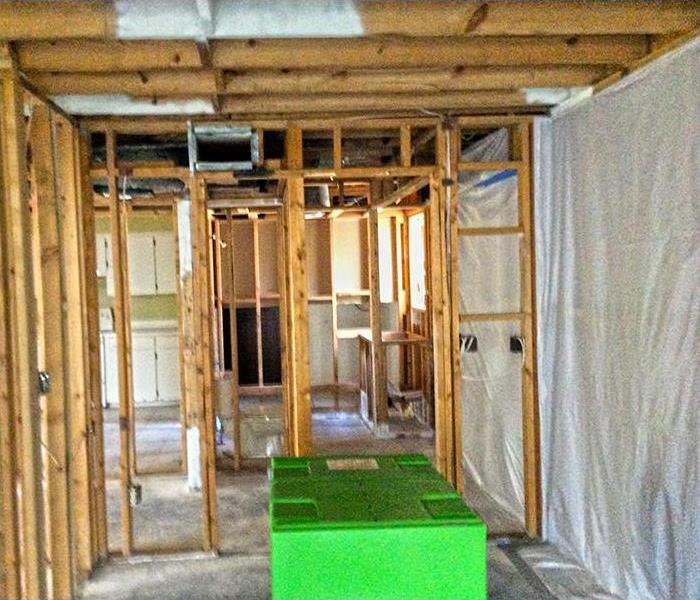 The extent of remediation and work that must be done will be outlined in your written protocol, which is used to build our remediation plan.
The extent of remediation and work that must be done will be outlined in your written protocol, which is used to build our remediation plan.
Mold Remediation is a process that both removes materials damaged by mold and identifies and corrects the conditions that allowed for the mold growth to begin in a safe and effective manner. Every property with mold damage should have its own custom plan created in order to properly address the issue.
Air Quality Test and Written Protocol
In the state of Florida, the same company that performs mold testing on a property is not allowed to perform its remediation as well. SERVPRO of Winter Park performs the actual remediation side of the process, however, we have a network of trusted companies that can perform an air quality test and provide you with a written protocol. This is an essential step in the overall process for a number of reasons. In addition to providing information such as the type, cause, and severity of your mold problem, a written protocol by a professional mold assessment company will also provide you with an outline for remediation. The next part of the process can begin after this protocol has been sent to us.
Creating a Mold Remediation Plan
After receiving the written protocol, SERVPRO of Winter Park will schedule a day and time to have a mold professional visit your property to take pictures and measurements. This, along with the contents and outline of the written protocol, will allow us to build an estimate for the cost of remediation and finalize a remediation plan that is catered to your specific mold problem.
The final remediation plan should include steps to correct the source of moisture that led to the mold growth. The plan should also detail other aspects of the process such as the use of personal protective equipment and steps for carefully containing the mold and affected building materials so that further contamination is prevented. The length of your remediation plan will be based on the size and complexity of the job and can vary greatly from other remediation plans. It is also important to know that new discoveries or changing circumstances during the remediation process can result in a revision of your plan to ensure that the remediation is thorough.
Most importantly, the foundation of your remediation plan should be the safety of all inhabitants of the property and the remediators performing work as well. Your remediator should avoid exposing themselves and others to mold-laden dust while performing work. If your HVAC system is contaminated with mold, or mold is present near the intake of the system, you should not run your air conditioning unit. Doing so can spread the contamination to the other areas of your home. In properties that are highly contaminated with certain specific types of mold, it is common for your remediator to recommend that all inhabitants be temporarily relocated for their safety until the property is remediated and cleared by a post-remediation air quality test.
Professional Mold Remediation Company
If you suspect mold in your property, give SERVPRO of Winter Park a call at (407) 678-5391. We offer knowledgeable and professional mold remediation services and can even refer you to a trustworthy mold testing company to get the process started for your property.
4 Must Do's After Hurricane Damage to Your Home
6/11/2018 (Permalink)
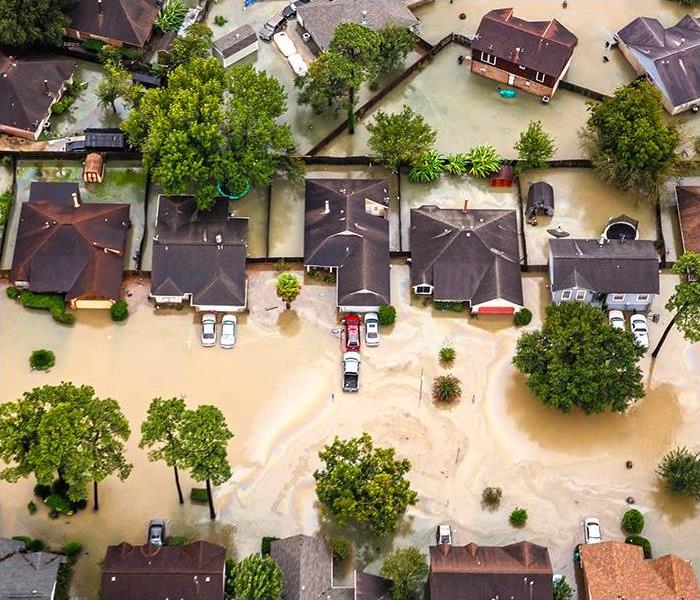 SERVPRO emergency water damage services are available 24/7 help prevent further damage to your home.
SERVPRO emergency water damage services are available 24/7 help prevent further damage to your home.
Hurricanes have devastated countless families and homes in Florida in the past. Storm damage to a home from a hurricane is a stressful experience for a homeowner in many ways and can even be worse when they are not sure what steps to take afterward. In the event of your home becoming damaged by a storm, take the following steps:
1. Take Photos and Document the Damage
It is important that all storm damage to your home is well documented to make your insurance claims process much easier. Take as many photos of all areas affected and make sure to compile a list of all damaged items as well.
2. Perform Emergency Repairs
After sustaining damage, prioritize the repairs that have to be made to the property. Your focus in doing so should be to ensure that additional damage does not occur. Some examples of these emergency repairs include covering broken windows with plastic or securing tarps to your roof to prevent rainwater from entering. Any permanent repairs should be placed on hold until your insurance claims adjuster is able to review the damage. Until your adjuster is aware of the full extent of the damage and has all materials accounted for, you should refrain from throwing out any damaged items.
3. File a Claim Quickly
It is important to know that insurance companies sometimes work on a first-come, first-serve basis, especially if overwhelmed by many claims during a hurricane season. Because of this, you should work to get the process started and file a claim as soon as you are aware of the damage. After contacting your insurance provider, provide your claims adjuster with photos, an inventory of affected items, and fill them in on the extent of the damage. Your adjuster will come to your property, further assess the damage, and work to determine the payout amount your insurance will cover.
4. Secure Safe Lodging
Safety should be the number one priority at all times for you and all inhabitants of the home. If the home is uninhabitable, or unsafe for any reason, we strongly recommend finding a safe place to stay while repairs are being made to the home. Keep in mind that if your damage is part of a covered claim, the loss of use coverage in a standard insurance policy will typically help pay for your family's lodging. Ask your claims adjuster if you are covered by your policy.
Further Information
SERVPRO of Winter Park is a professional storm damage company that specializes in water damage, fire damage, and mold damage. Our emergency services are available 24/7 to assist you at 407-837-8990. Click the following links for more information on our services or general hurricane information.
5 Things Your Commercial Carpet May Be Hiding
6/5/2018 (Permalink)
 Vacuuming is helpful, however, it does not get rid of all problem-causing things hidden in your carpet.
Vacuuming is helpful, however, it does not get rid of all problem-causing things hidden in your carpet.
Let’s be honest, when there are no visible messes or stains on your carpet, hiring a professional carpet cleaning company is probably not on the top of your agenda. Most property managers or business owners will pass a vacuum quickly and call it a day. However, just because a large mess or stain is not seen, it does not necessarily mean that your carpet is clean or that it does not have potential underlying issues.
To show how important it is to have a professional carpet cleaning every so often, here are some of the problem-causing things that could potentially be lurking in your carpet:
Dirt and Dust
The average home in the U.S. builds up to 40 lbs. of dust per year, with potentially more in a commercial setting like an office. Dirt, dust, and sand typically gets stuck to the bottom of shoes and is spread throughout carpeting. Passing a vacuum eliminates approximately 85% of dirt and dust from a carpet, leaving a significant amount behind.
Food and Drinks
Many employees eat lunch and snacks while at their office desk. Stains and food accumulating on a carpet can be noticeable, however, a larger concern is the potential for bacteria growth and carpet odor as well.
Mold, Mildew, and Other Germs
Mold can easily go unnoticed and thrive while hidden under a carpet in a moist environment. A spill that was not dried quickly enough can lead to this hidden issue. Mold remediation can become a large expense if not covered by the right insurance policy. The best way to prevent these problems from happening is keeping your carpet clean and dry.
Skin Flakes
The average person sheds approximately 1 million skin flakes a day. When you think of how many employees work in your business, the duration of their shifts, and where those skin flakes go once shed, it’s easy to consider the amount that ends up in your carpet.
Bugs
Some bugs are easy to spot while others are not. Oftentimes, a carpet will serve as the perfect environment for microscopic bugs such as flees and dust mites. Many of these bugs actually feed on the skin flakes mentioned above and can be attracted by them. Another concern is allergies that can be caused by some of these bugs.
Professional Carpet Cleaning
We are not saying that vacuum should not be done in your commercial office setting, or that is not a great start. However, the problems mentioned above are common and can be more easily avoided by having your carpet deep cleaned at least once per year by a professional. If you would like to schedule a carpet cleaning for your commercial establishment, give SERVPRO of Winter Park a call at 407-678-5391!
7 Orlando Water Damage Restoration Tips
5/31/2018 (Permalink)
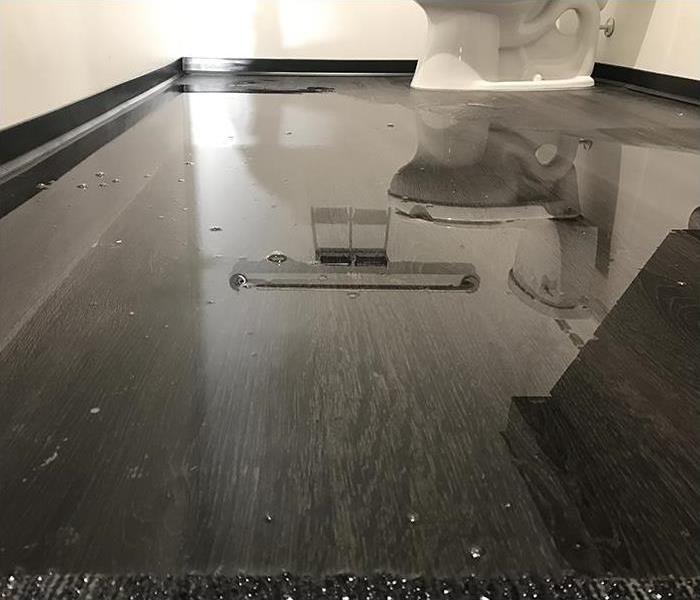 You can speed up the overall Orlando water damage restoration process by using a mop or towel to remove standing water from the affected area
You can speed up the overall Orlando water damage restoration process by using a mop or towel to remove standing water from the affected area
Experiencing water damage in your home or commercial business is a stressful situation. If you have made the choice to contact SERVPRO of Winter Park, a professional Orlando water damage restoration company, then rest assured knowing you have made the smart and right choice. The professionals know exactly what to do to correct a water damage situation and prevent further damages, however, there are steps you can take to minimize damage even further while you wait for your technician to arrive. Here are some ways you can help the process.
1. Safety
Keeping yourself and other inhabitants safe during a water damage is the absolute best way you can help yourself and your restoration company. It is very common for slips, falls, and electric shocks to occur during these situations. Also, be wary when attempting to lift objects, as soaked contents tend to weigh much more and can even cause bodily injury. Safety should be your first thought when handling any tasks so that a bad situation does not become a worse situation.
2. Water Source
Our team is fully capable of extracting large amounts of standing water upon arrival, however, the duration of this process can be much shorter the sooner the water source is shut off. Doing so promptly can also minimize the extent to which your property and contents are affected. In most cases, the water shut-off valve is located either in your garage, utility room or outside your home near the water meter.
3. Electrical
To avoid possible electrical shock, it is always a best practice to shut off the source of electricity to the affected areas of the property. Locate the breakers and read the manual, usually attached to the inside of the breaker panel, to shut off power to the correct areas. Also, if possible, refrain from using anything electrically powered near the affected areas as wires and other components may be wet as well.
4. Air Conditioning
Mold growth in Orlando is extremely common and oftentimes occurs at an accelerated rate due to the humidity of Central Florida. Part of our water damage restoration process is to make sure all components get dried out so there is no moisture. You can also help prevent mold growth, by keeping your air conditioner running until help arrives to keep humidity down and even help contents to begin drying.
5. Floors and Carpeting
While help is on the way to your property in Orlando, you can expedite the process by removing as much standing water as possible. Using a mop or towels can help bring down the amount of water. Be careful not to spread the water to other areas while doing so. If the affected area is a soaked carpet, you may also remove soaked Oriental rugs from the area and blot the soaked wall to wall carpet with towels.
6. Fabrics and Clothing
Remove any fabrics and clothes from the area and transfer them to a dry area. Also, make sure that drapes and curtains do not stay in contact with your wet floor or carpet.
7. Furniture
To avoid more damage, remove any light pieces of furniture from the area and dry them to the best of your ability. Discuss these contents with your technician when they arrive so they can check them for moisture as well. If possible, try to elevate any furniture that can not be removed. If elevating furniture is not an option, another trick is to place plastic bags or plastic wrap under the legs of heavy furniture to limit their contact with the water.
Need Water Damage Restoration in Orlando?
SERVPRO of Winter Park is an Orlando water damage restoration company that has years of experience with situations like yours. We pride ourselves on providing fast, reliable, and trustworthy water restoration services to our community. If you have a water disaster, make sure to choose the restoration company you can trust. Our phones lines at 407-837-8990 are open 24/7 to assist you with your emergency. Give us a call today!
Water Damage in Orlando Hotels and Resorts
5/26/2018 (Permalink)
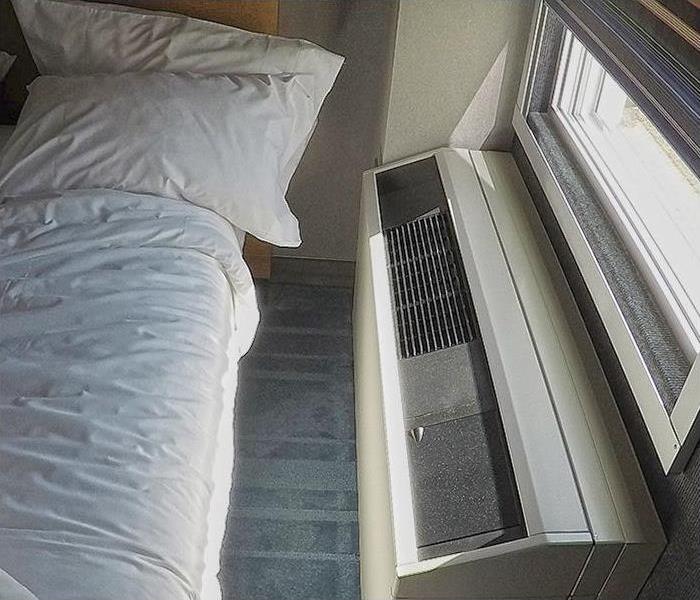 Many tourists cannot bear the Orlando heat and rely heavily on air conditioning units that can malfunction and lead to water damage.
Many tourists cannot bear the Orlando heat and rely heavily on air conditioning units that can malfunction and lead to water damage.
Orlando is one of the busiest tourist destinations in the world, making it prime real estate for many hotels and resorts. All year round, the city serves as the anchor for tourists going to various events, theme parks, and beaches. Therefore, it is crucial to ensure that your hotel or resort business consistently runs at its optimal levels. For many of your guests, the heat and humidity of Central Florida can be nearly impossible to bear so a room with air conditioning is extremely relied upon. It is common for these units to fail and unload a considerable amount of water. When this type of situation is not dealt with quickly and efficiently, it can cause a significant amount of damage.
Making a Bad Situation Worse
One mistake often made by management in these situations, is the assumption that a temporarily unrentable room is the extent of the problem. However, in most hotel or resort facilities, there are adjoining rooms and areas below the room that have a high chance of damage spreading and affecting even more guests. Delays in the proper removal of water and drying of all affected areas can quickly make the problem worse by introducing mold growth into the situation.
Commercial Water Restoration
In order to lessen the severity of your profit loss and prevent adjoining rooms and areas from being damaged, it is important to act quickly and find a professional restoration company that can have technicians onsite promptly. SERVPRO of Winter Park offers 24/7 emergency services and can help resolve your commercial water damage issues. We restore the damage by using water extraction equipment to remove all standing water and the majority of water that is soaked into carpeting. Afterward, the affected area is completely dried by strategically placed powerful air movers. Tests are also performed to determine the extent of the damage, how much restoration is necessary, and ensure that no moisture is left behind to prevent mold growth in your business and additional issues.
Trusted Restoration Company
Peak season or not, we strongly advise that water damage issues be taken care of quickly when they arise. If you have air conditioners in your Orlando hotel or resort that lead to water damage, give SERVPRO of Winter Park a call. We can be reached anytime at (407) 678-5391.
Working with Insurance Adjusters After a Fire
5/22/2018 (Permalink)
 Taking photos of the damage during an inspection helps for building an estimate and even providing documentation to your adjuster.
Taking photos of the damage during an inspection helps for building an estimate and even providing documentation to your adjuster.
Experiencing a fire in your Winter Park home is a possibility that no homeowner wants to consider, however, it is a possibility that occurs more frequently than you may think. There are many causes of fires and they can occur any day, without warning, and cause an overwhelming amount of damage and prolonged effects on your property. Aside from the stress of dealing with a fire itself, the aftermath and process of restoring your property can be equally stressful as well.
The Process with Your Insurance Adjuster
SERVPRO of Winter Park knows how stressful these situations can be and works to make the fire damage restoration process as smooth as possible. Not only do we work to communicate clearly and constantly with you throughout the actual restoration process, but we also communicate with your insurance company and adjuster to help determine which areas of your property require professional restoration services and what items are a loss. Our team works closely with you and your adjuster to make the right determinations and provide the necessary information to get your claim going as quickly as possible.
Fast and Comprehensive Estimate
Working quickly and accurately to provide you and your adjuster with an estimate plays a crucial part in expediting the process of your claim. Our team inspects all of the damage to your home, visible and nonvisible, in order to determine the best course of action for restoration and the amount of equipment, personnel, and time needed to complete the project.
Fire Damage Restoration Process
Once your claims are filed and you are covered by your insurance company, our fire restoration team can get started with the fire damage restoration process and work to get your property restored and functional once again. The length of this process can fluctuate based on the severity of the fire and components affected.
Our crew works diligently to make sure the appropriate measures get taken to overcome all of the damage that your home experienced from the recent fire. If you are facing fire damages in your home, you can trust SERVPRO of Winter Park’s professional team to help you get going in the right direction. Give us a call at any time or day at (407) 678-5391.
8 Signs that Can Predict a Falling Tree
5/14/2018 (Permalink)
 Trees that have multiple trunks are a higher risk of splitting and causing damage during a storm.
Trees that have multiple trunks are a higher risk of splitting and causing damage during a storm.
Trees can be the perfect accent to the appearance of your home or property. However, they are also one of the most common sources of roof damage, especially during storms. With storm season among us in Central Florida it is important that homeowners and property managers alike are able to recognize some of the signs of trees that are more likely to fall.
1. Leaning to One Side
A slight lean of your tree should not be a huge concern since most trees do not grow perfectly straight. However, be wary of trees that lean uncomfortably in one direction, especially if in the direction of your roof. Leaning trees that are very close to the point of falling sometimes have exposed roots near the base and cracked soil on the opposite side of the lean. In some cases, the cause of the lean can be a weight distribution issue that can be balanced by pruning branches.
2. Multiple Trunks
If you have a tree with U-shaped multiple trunks, be sure to inspect for deep cracks and other signs of weakness. Mature trees are most at risk for splitting down the middle during heavy rains and stormy weather. To prevent the tree’s splitting, consider hiring a certified arborist who can attach cables between trunks and braces to strengthen their bonds.
The best offense is a good defense when it comes to protecting your roof from falling trees. Take the time to inspect trees on your property and mark ones that match some of the above warning signs. Don’t be afraid to remove unstable trees, though you should call an arborist before attempting to fell the tree yourself.
3. A Hole in the Trunk
A cavity can form in the trunk of a tree when the tree prunes itself by dropping a branch. That can lead to decay inside the tree. This doesn’t always mean danger, though, according to the United States Department of Agriculture Forest Service. If there’s enough sound wood around the cavity, the tree probably won’t fall.
4. Missing Bark or Deep Cracks
An area where tree bark is missing, gashed or indented is called a “canker”. A canker can make a tree more likely to break at that spot, even if the wood looks OK, according to the International Association of Certified Home Inspectors (InterNACHI). Deep cracks in the bark are a bad sign, too.
5. Dead or Falling Branches
When trees start dropping bits of branches or entire branches, it’s a clue that something’s wrong. The tree tries to make itself smaller so there is not as much to feed. Dead branches are a major danger and can come crashing down even on a calm day, according to the USDA Forest Service
6. Losing Leaves from the Outside In
When a tree loses leaves in this pattern often it means something is wrong with the root zone. The root zone is where the tree gets nutrients and water — and it’s what holds the tree up. Without a healthy root system, a tree can fall more easily.
7. Rotten Roots
Root rot can be hard to spot. Look for mushrooms growing around the base of a tree. Fungi growing on the trunk can be another clue that the tree is rotting inside.
8. Tight Branch Growth
When branches grow close together in a V-shape, it’s a bad sign. A strong union will be U-shaped. Elm, maple, oak, yellow poplar and willow trees tend to break at weak forks. When the wind blows, these trees can fall apart. This problem is easiest to spot in winter after the leaves have fallen off.
Risks After Roof Damage From Fallen Trees
The roof is a protector of your home. So, make sure your trees are ready to withstand the stormy weather. A damaged roof may make it easier for your property’s interior to sustain additional damage from water and in many cases mold growth. If you have sustained roof damage, make sure to call a professional roofer to repair the damage. Also, should the roof be damaged during a storm, SERVPRO of Winter Park is available 24/7 at 407-678-5391 to extract water and dry your property to prevent further damage.
5 Mold Remediation Don’ts to Avoid
5/7/2018 (Permalink)
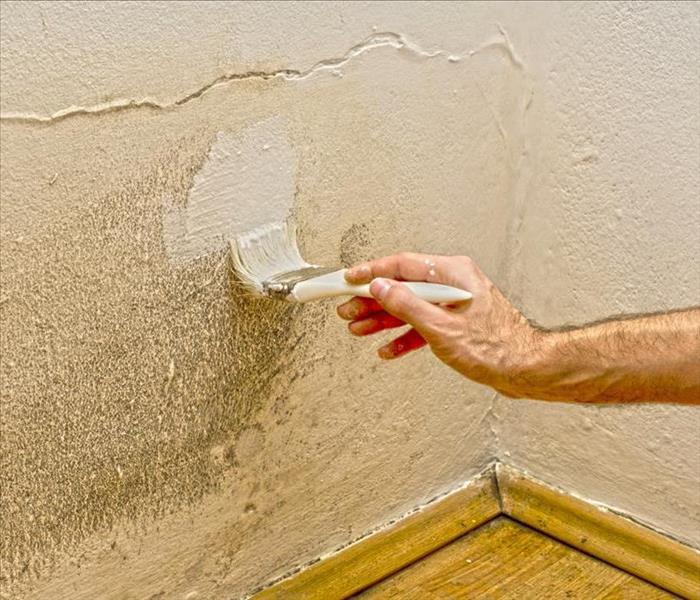 Painting over mold is looked at as the cheapest option for many property manager and homeowners but only limits your ability to visibly notice growth.
Painting over mold is looked at as the cheapest option for many property manager and homeowners but only limits your ability to visibly notice growth.
There are plenty of myths out there in regards to proper mold remediation and what actually works. New discoveries about mold are made all the time, and the recommended processes for treatment improves and adapts along with each discovery made. Because of this, predated information still exists and homeowners and property managers tend to use techniques that either make a mold situation worse or have no effect at all. Here are our top five mold remediation don’ts to avoid.
1. Bleach
The most common don’t when it comes to mold remediation is the use of bleach for the cleaning or removal of mold. While at one point The Occupational Safety and Health Administration (OSHA) recommended the use of chlorine bleach in mold abated, they were the first to retract their recommendation. The Environmental Protection Agency has since retracted their recommendation as well.
The truth when it comes to using chlorine bleach is that it actually CAN kill certain mold types (Aspergillus niger and Trichophyton mentagrophytes) when used on a non-porous surface. The main problems with this are that there are many other types of mold and remediation typically involves disinfecting wood and wood-based building materials, all of which are porous materials. Because the properties of chlorine bleach prevent it from soaking into wood-based materials, the bleach is not able to reach and affect the roots of the mold to stop it at its source. Mold membranes will recognize bleach as a threat, retreat further into the material to avoid it, and in some case, mold can even use the bleach as a fungal food to grow more rapidly. Yes, bleach can potentially make the problem worse! Be wary of any restoration company that recommends the use of bleach as a solution to your mold problems.
2. Vinegar
Another popular household item that is often used to deal with mold is vinegar. Vinegar is mildly acidic and actually can kill about 82% of mold species. However, when treating mold as a homeowner, you must be aware that visible mold growth in your property may not be the only area that is affected. Choosing this option runs the risk of missing additional mold growth within your property, leaving you unknowingly open to an increasingly worse mold situation. Seeking professional mold testing is always the best option for determining how bad your mold situation is, as well as determining the type of mold you are dealing with. In most cases, calling a professional mold remediation company is the best option, especially when the mold is widespread.
3. Scraping Off
One misconception is that you can remove mold by simply scraping it off. This is a big don’t for a few reasons. Mold is a living organism and disturbing it releases spores into the air which can potentially be breathed in. These released spores also cause the mold to contaminate other accessible areas of the property helping the mold to spread throughout. Scraping mold not only means a significantly higher bill for treating and removing it but also poses an increased health risk for all inhabitants of the property.
4. Ignoring Mold
Aside from making the decision to remediate on their own, many homeowners and property managers also make the decision to leave the mold as is. There are an enormous amount of risks involved when ignoring signs of mold. Mold that is exposed and left untreated is at high risk of being disturbed and spreading. Prolonged exposure to mold, visible or otherwise, can have different effects on people’s health. Another issue with leaving mold untreated is the structural damage that it can cause to your property. The longer that mold is ignored, the bigger your problems will be down the line across the board.
5. Painting Over
Due to either a lack of knowledge on mold or in some cases pure negligence, there are plenty of property managers, landlords and/or homeowners that choose to hide mold by painting over it. One of the biggest issues in property managers doing this is that it limits the inhabitants from quickly noticing the mold. Mold can eat through the majority of paints and become exposed again. By the time this happens, the mold growth is usually significantly worse. There are also mold resistant paints that are misconstrued as a viable option for painting over mold. These paints are intended to be used prior to mold growth on a clean surface to prevent the growth from happening. Using these paints will not take care of the issue and will only prevent you from noticing the problem get worse.
Local Mold Remediation Services
If you notice mold growth in your home or property, call the professionals here at SERVPRO of Winter Park. Our phone line 407-837-8990 is open 24/7 to assist you with your mold disaster.
5 Ways a Roof Can Sustain Storm Damage in Orlando
5/1/2018 (Permalink)
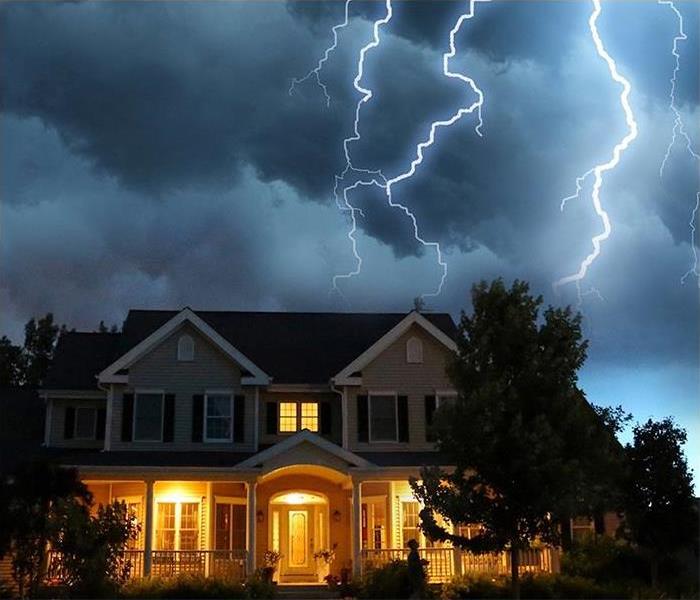 A lightning strike can cause damage all on its own and can lead to water or fire damage as well.
A lightning strike can cause damage all on its own and can lead to water or fire damage as well.
Whether you are a property manager or own a home, storms in Orlando and the surrounding area can be abrupt and severe, potentially causing damage to your property. Initial damage from these storms can occur in multiple ways including from rain, hail, wind, and even fallen trees. Knowing the possibilities of damage can help you prevent or prepare your property for future storms.
1. Damage from Rains
Orlando is no stranger to heavy and abrupt rainstorms. Strong downpours during a storm have the potential of washing away the granular surface on shingles. The rainwater can also travel under missing seal strips and damaged flashing. Damage from downpours can compromise your roofing system and lead to interior leaking and mold growth as well.
2. Damage from Hail
The size of a hailstone can vary but is usually between pea-sized and marble-sized. The force of these stones pounding down on your rooftop can cause tiny indentations in your roof or dents in the metal flashing of your roof. At a quick glance it may not appear so, but after taking a closer look you may possibly find compromises in the roofing membrane. This particular damage can affect your roof’s ability to prevent water from entering your home. Similar to rain, a persistent amount of hail can remove the granular surface of your roof shingles, which removes their ability to protect your home from UV rays and premature aging. This further increases your likelihood of sustaining extensive roof damage in future storms.
3. Damage from Winds
The most obvious wind damage to your roof is when winds are so strong that they blow your shingles off. Additionally, winds can lift or break a shingle’s sealing strips. Without these strips, water can get underneath your shingles. if not fixed immediately, the water that enters can cause mold growth, roof leaks and damage to interior insulation, plywood, and drywall. Undetected compromises in your roof that are exposed to future storms can even lead to a damaged underlayment causing roof rot to your decking.
4. Damage from Fallen Trees
Trees, or even just tree limbs, can cause damage beyond the visible hole they create in your roof. If the damage occurs during a storm, the hole in your roof provides incoming rainwater with access to other areas of your roof. This can weaken your roof structure and also create mold growth. Even if a fallen tree does not create a hole in your roof, cracks in your rafters or punctures in your shingles or other roofing materials can also lead to water damage.
5. Lightning Strikes
Although it is not common, lightning has caused damage to residential and commercial properties in the past. In just a few seconds, your home can go from perfectly sound to severely damaged from one strike of lightning. Roofs often take a major hit, and metal gutters are especially susceptible, too. A bolt of lightning can puncture a roof, sear the surrounding materials, and tear through attics. A powerful enough strike can tear off shingles and gutters, leaving the roof a disaster. In addition to leaving your home exposed to water damage, a lightning strike can also potentially cause a fire, increasing the amount of damage.
Has Your Roof Experienced Storm Damage?
If you have sustained damage to your roof and property after a storm, SERVPRO of Winter Park can assist you with water extraction and drying your property. While your roofing company makes sure to fix the damage to your roof, we make sure you are not sustaining long-term damage in all areas of your property. Give us a call at any hour in Orlando at 407-678-5391!
Types of Fires and How They Are Extinguished
4/25/2018 (Permalink)
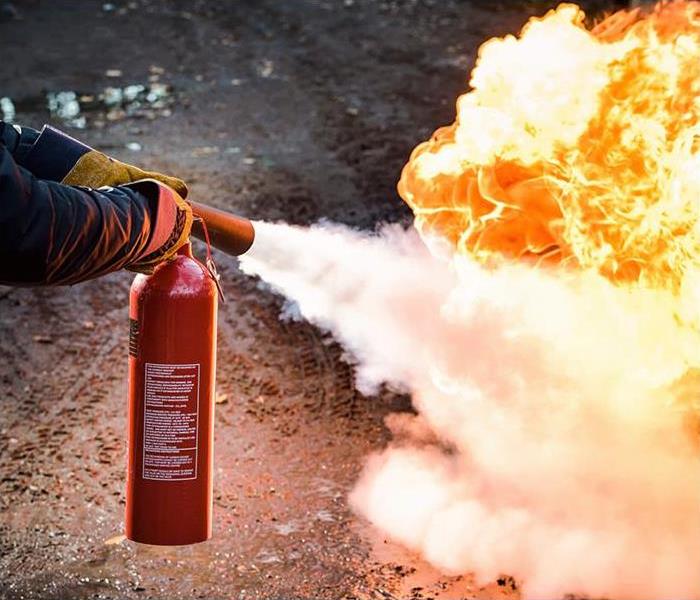 Knowing the type of fire you are trying to extinguish is essential for safely attempting to put it out and can help avoid making the fire worse.
Knowing the type of fire you are trying to extinguish is essential for safely attempting to put it out and can help avoid making the fire worse.
According to the U.S. Fire Administration, there were approximately 1,345,500 fires nationwide in 2015. As a homeowner or property manager, being aware of the different types of fires and how they are extinguished can help you to quickly resolve a fire incident, avoid making it worse, and even determine when the risks are too high for any attempt at extinguishing the flames. In the event of any fire, your safety and health should be your number one priority at all times. If you are concerned about your safety at any point, vacate the property, keep a safe distance, and wait for your local fire department to arrive. The types of fires are generally split into the 5 classes listed below.
Class A - Ordinary Combustible Fires
This common type of fire happens when materials are heated to their ignition temperature. Heat, oxygen, and fuel will allow a combustible fire to continue burning. Rubber, plastic, textiles, wood, paper and organic carbon-based compounds are a few of the materials that can be involved in these types of fires.
Combustible fires are usually the most simple to extinguish since spraying with water will cool the flames and source material. By removing the supply of heat, the fire is left without the essentials needed to burn. A water-based or foam based fire extinguish is recommended for Class A fires.
Class B - Flammable Liquids
Any liquid substance that has an ignition temperature below 100°C is classified as a flammable liquid. These liquids burn easily due to having a low flashpoint ( the temperature of a substance where enough vapor to be ignited is released). If a spark, flame, or any other source of ignition is applied to a flammable liquid, they can burn at any temperature. Types of flammable liquids include, but are not limited to, petrol, kerosene, alcohol, solvents, and paints.
When attempting to extinguish a Class B fire, it is important that you DO NOT use water to put the fire out. Splashing water can cause the flammable liquid to spread, spreading the fire along with it. Instead, smother the flames using a foam extinguisher. It is also important to note that Class B fires produce a thick and black toxic smoke, so avoiding the fire and waiting for the professionals may be the best route.
Class C - Flammable Gases
Butane, propane, and petroleum are a few flammable gases that have the potential for creating explosions if triggered by a spark. These fires are amongst the most dangerous and only need about a 5% concentration of flammable gas in the air to burn.
These fires should always be left to your fire department. Once on scene, they will have to isolate the fire’s gas supply and then use dry powder extinguishers. Most other extinguishers are ineffective against Class C Fires.
Class D - Metal Fires
Metals are good conductors and most require a lot of heat to ignite. Certain types of metals can burn if ignited. Metal shavings and powders pose a higher fire risk than solid masses of metal. Alkali metals such as potassium, magnesium, and sodium can burn when in contact with air and water. Therefore, spraying water or foam onto metal fires will increase the intensity of the flames and can potentially cause explosive reactions sending pieces of burning metal in all directions.
When dealing with a Class D fire, the safest approach is usually to allow the fire to burn out on its own. These type of fires tend to occur in industrial properties with large amounts of burning metal and an increased chance of explosions. Class D fires have a tendency for producing large amounts of ash, which builds up and starves the fire’s supply of oxygen. For metal fires that are spotted early, special type D powder fire extinguishers can be effective. Just make sure to check that they are the specific dry powder type intended for use on metal fires.
Electrical Fires
Electrical fires do not have a class of their own and are designated to Class C in the United States. However, they have their own fire safety requirements and are important to mention. These fires can be caused by short circuits, overloaded switchboards, faulty equipment and damaged wiring.
Before attempting to extinguish an electrical fire, it is important to isolate its electrical supply as quickly as possible. Water and foam are both conductors for electricity, so even after isolation, it is not safe to use them as extinguishers. The only types of extinguishers recommended for safely addressing electrical fires are carbon dioxide and dry powder fire extinguishers.
Class F - Cooking Oil Fires
Fires that involve cooking oil and fats are classified as Class F. These fires are common in homes, businesses and professional kitchens. They pose a very difficult challenge to extinguish, due to the high temperatures involved. Simply trying to cool the fire with water will not work. In fact, using water on a burning pan is likely to cause a rapid spreading out of the flames, making the fire worse and potentially injuring anyone in its vicinity.
For this reason, special fire extinguishers have been developed to address Class F fires. Wet chemical extinguishers contain a formula which cools the fire and then mixes with the oil to seal the surface and prevent re-ignition.
Fire Damage Restoration
SERVPRO of Winter Park does not extinguish fires. In case of a fire emergency, please contact your local emergency services and fire department for assistance. If you have suffered from fire damage to your property, give us a call at 407-678-5391. Our phone lines are open 24 hours to assist you and our skilled technicians can help you assess the extent of the damage to get the fire damage restoration process going.
Orlando Water Damage Companies
4/21/2018 (Permalink)
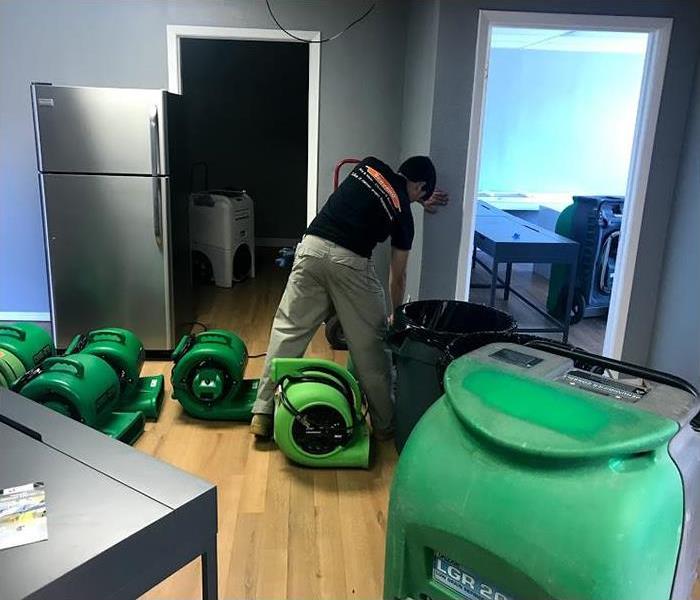 Our technicians are trained to use the best equipment available to restore your property.
Our technicians are trained to use the best equipment available to restore your property.
One of the main disasters affecting residential and commercial properties in the USA is water damage. For the Orlando area, the most common cause of water damage is severe flooding. SERVPRO of Winter Park specializes in incidences like burst water pipes, floodwater, and many other causes.
Any type of water damage encountered in the Orlando, FL area should be immediately seen to by a professional expert in the Orlando water damage restoration industry. At SERVPRO of Winter Park, our team consists of highly trained and experienced staff. Our expert teams go through a proven step by step process for rectifying your problem and getting you back into your property. Our water damage restoration process has been proven effective for many years and results in the fastest turnaround times to get people back into their homes or businesses.
Safety
Safety should not only be a priority for you, but for your restoration company of choice as well. The best Orlando water damage professionals understand the importance of safety and the health risks of everyone involved when safety precautions are not taken. Make sure the services provided are thorough. For example, baseboards should be pulled to ensure there is no excess water trapped behind them that could lead to mold growth. Many times, mold is already present during water extraction jobs where the damage happened a few days or more prior. In these cases, your restoration company should be doing everything possible to prevent mold spores from being disrupted and spread further throughout the property.
Reliability
The SERVPRO brand and reputation has been built over years and all our customers have complimented our reliability. At SERVPRO of Winter Park, we stand by our reputation as a reliable water damage restoration company by setting clear expectations before jobs are started. We communicate with our clients throughout the entire process, keeping our clients informed, answering questions, addressing concerns, and making good on our promises. Returning you and your property to the state it was immediately prior to the flooding occurring is how we ensure full satisfaction in every possible situation.
Distance from Property
It is important to hire a restoration company that is near in proximity and can arrive on scene quickly whether during an initial emergency call or routine visits throughout the process. Our SERVPRO franchise is physically located in Winter Park, however, we service the Orlando area as well and utilize the many access routes to place us on the scene at your property in a timely fashion.
Professional Certifications
As a registered and fully certified company, SERVPRO of Winter Park is always striving for excellence and improvement in processes to ensure that you always enjoy excellent service with our dedicated response teams. We keep up with the evolution of technologies and processes to make sure that we use the newest resources and techniques available to make your restoration job a full success.
Satisfied Customers
No disaster is a fun situation for our clients. During this highly stressful time, we do our best to ensure a smooth process and meet our clients' goals while maintaining high standards. We pride ourselves on making a water disaster “Like it never even happened”. We keep noise to a minimum and try to respect the need for accessible pathways for employees or residents.
A good practice to keep when searching for a restoration company is looking at their public reviews. Let a company’s past clients paint a picture of what your services with them may look like. There is something to say about a client who’s disaster situation was taken care of so well that they took to an online platform like Google or Yelp to let the public know about their experience.
If you are in a situation that requires an Orlando water damage repair company and you want to make sure that your problem is dealt with in the best possible way, then give us a call at (407) 678-5391 any time of day no matter how severe the problem is.
Water Damage and It's Hidden Signs
4/13/2018 (Permalink)
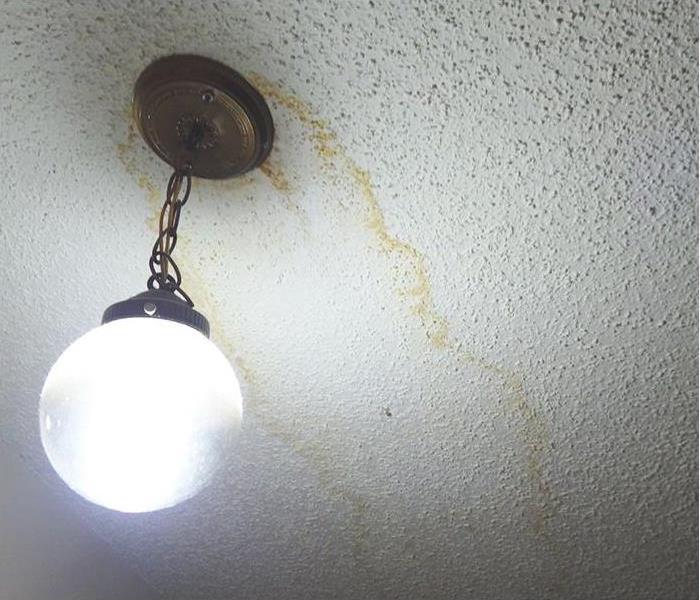 Watermarks and stains are a sign of a previous or existing leak.
Watermarks and stains are a sign of a previous or existing leak.
Water damage is one of the last things any property manager or homeowner wants to deal with. Unfortunately, the weather in Central FL cities such as Winter Park and Orlando is known for its spontaneous rain and storms. Couple this with the fact that any facility, whether residential or commercial, must have a substantial supply of water and a clearer picture of how likely a water disaster can strike is painted.
A few examples of how water damage can occur on a property are sewage overflow, ruptured water pipes, water heater leaks, dishwasher malfunctions, or in many cases flooding from a severe storm or hurricane. Aside from the visible or obvious causes of water damage, what many homeowners and property managers may not notice are slow leaks and/or plumbing issues that can quietly damage a property.
Knowing the signs of hidden water damage will better equip a building or homeowner to detect leaks that can lead to damage or even discover if a property has suffered from water damage in the past.
Signs of Hidden Water Damage
- Wallpaper and Paint - If a wallpaper adhesive is used on the property, check for signs of peeling. In properties with interior paint, a water leak behind a wall may cause raised and wavy lines.
- Baseboards and Trim - Look for baseboards and trims that are separating from the wall. Exposure to water may cause swelling over time, which may push the baseboard from their flush placement against the wall.
- Wooden Furniture - Wooden furniture may swell if exposed to water for a prolonged time.
- Bathroom Tiles - Check the floor tiles around your toilet for darker colored grout. This is a sign of a leaking toilet.
- Unexplained Moisture - If a pipe ruptures in your concrete slab, it can slowly lead to warped floorboards, cracked tile or damp carpet if the right amount of water is soaked up by the under-padding.
- Sweating Walls - Blotches of condensation are a common sign that excessive moisture is festering behind the walls. This can be caused by a leak or a mixture of high humidity, poor ventilation and/or inadequate insulation.
- Mold - Any presence of mold or mildew is a solid sign that an area has been exposed to water and the right amount of humidity for at least 48 hours.
- Watermarks and Stains - Ceiling marks and stains, commonly seen in office buildings, are a sign of a previous or existing leak.
- Swollen Door Casing – Water leaks can cause an exposed door casing to swell and become unaligned. A door that begins to have trouble opening and closing could be a sign of a leak.
Keep these hidden signs of water damage to your property in mind to be better prepared and aware if a water disaster strikes. Should you notice a sign of damage, hidden or visible, SERVPRO of Winter Park’s phone lines are open 24/7. Our experts in the restoration field can perform an in-depth water damage assessment to ensure our restoration services are successful. To speak to a water and mold expert, give us a call at 407-678-5391.
6 Common Causes of Residential Fires
4/6/2018 (Permalink)
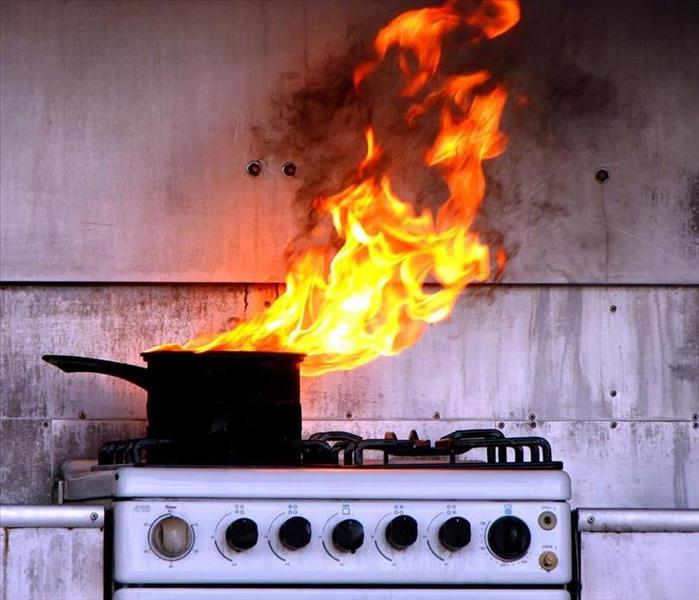 Fires related to cooking make up about 42% of all reported causes of residential fires in the U.S.
Fires related to cooking make up about 42% of all reported causes of residential fires in the U.S.
According to the NFPA (National Fire Protection Association) The United States averages between 350,000 and 400,000 fires every year. That translates to an average of 39 – 46 fires every hour! By knowing the most common ways a fire is started, a majority of these fires can be prevented.
Cooking Incidents
The leading cause of residential fires are incidents related to cooking. Cooking incidents actually make up about 42% of reported house fires in the country! For example, an oven or stove left on and unattended is a disaster waiting to strike.
Electrical
Electrical fires are another common type of home fires. One of the leading culprits is the over-use of extension cords. Extension cords are designed to safely pull a certain amount of amps, so make sure to read labels and know the limitations of the cord you are using. We recommend having an electrical inspection performed by a certified electrician at least once a year.
Unsupervised Children
Teaching children about fire safety is definitely something every parent should consider. It is extremely common for items such as lighter and matches to be left within reach of children who are not aware of the dangers of fire.
Smoking
Smoking is the source of many house fires and leads to almost 1,000 deaths a year. Lit cigarettes that have been left unattended, forgotten about can make contact with flammable items in your home and lead to a fire. Another common occurrence is smokers falling asleep while smoking in their home. We recommend not smoking in your home or quitting altogether, however, if you choose to smoke in your home you should always make sure to extinguish your cigarette.
Candles
Candles should never be left unattended but oftentimes are. When leaving a room with a burning candle make sure to blow it out or take it along with you if necessary. Forgotten candles are very dangerous and can quickly lead to a fire disaster.
Dryers
Dryers are all too often forgotten! It is important to remember to empty out your dryer vents and be certain that they are properly vented. Remember to maintain your dryer by cleaning the vents at least once a year.
When Disaster Strikes
There are many possible causes and contributors to residential fires. Being aware of the causes listed above will go a long way in helping to prevent fire damage or much worse in your home. In case of an emergency, please be sure to dial 911 to reach a local emergency responder. Also, keep in mind that SERVPRO of Winter Park performs excellent fire restoration services and is available 24/7 to take your call!
4 Commercial Water Damage Steps to Take After a Disaster
4/3/2018 (Permalink)
 Protective shoes and gear can protect you from hidden hazards you can not see in the water.
Protective shoes and gear can protect you from hidden hazards you can not see in the water.
Hopefully, you never experience a major commercial water damage disaster in your business. With that being said, it is critical to know how to handle a water damage situation before it happens so you are adequately prepared if it does. Flooding can cause a variety of issues including structural damage. As a business owner, you can avoid additional disasters by ensuring the following steps are taken immediately after water damage occurs.
1. Protect Yourself
The safety of you and your employees should be your first priority. Make sure to never put your hands anywhere you cannot see first. Wearing sturdy shoes when walking in flood waters can protect your feet from hidden debris in the water that can trip or cut you. Flood waters can be contaminated so wearing hip waders is also a good idea. Look out for snakes or other creatures that may have been displaced by the flood.
If you are unsure or concerned about your safety at any point in time, remain outside of the property and wait for your restoration company to arrive. They will know all of the procedures and safety precautions to take in order to keep themselves and others safe.They will also have protective gear to wear as they are assessing the situation.
2. Shut Off Potential Hazards
If it is safe to do so, you will want to make sure that you turn off any electricity to the affected areas. You don’t, however, want them to be turned on before you are ready. Doing so can potentially mix electricity and water or create a gas leak before the flood damage can be corrected.
Your restoration company will have access to special tools that can detect moisture. This is key to ensuring the property is completely dried out and preventing any mold from growing. For example, a digital moisture meter is able to find signs of moisture behind walls
3. Take Plenty of Photos
For insurance purposes, it is a great idea to be as thorough as possible when documenting the water damage in your property. Taking lots of pictures will help you when filing a claim with your insurance company. Get photographic evidence of the damage that was left behind by the water, plus any water that is still there. Document all that you can and then speak with your insurance company as quickly as you can to get the claims process going.
4. Salvage What you Can
Keep in mind that it is extremely common for any property affected by a water disaster to experience mold growth. Mold only needs about twenty-four to forty-eight hours to start growing. Drying out the entire property as fast as possible is essential to preventing it from doing so.
The professional restoration company can assist you in this, but you will need to throw away anything that has been saturated for over forty-eight hours and figure out on a case to case basis what else can be saved or needs to be thrown away. Rugs and padding will always need to be tossed if they are damaged by flood waters.
15 Storm Damage Prevention Tips Every Homeowner Should Know
3/22/2018 (Permalink)
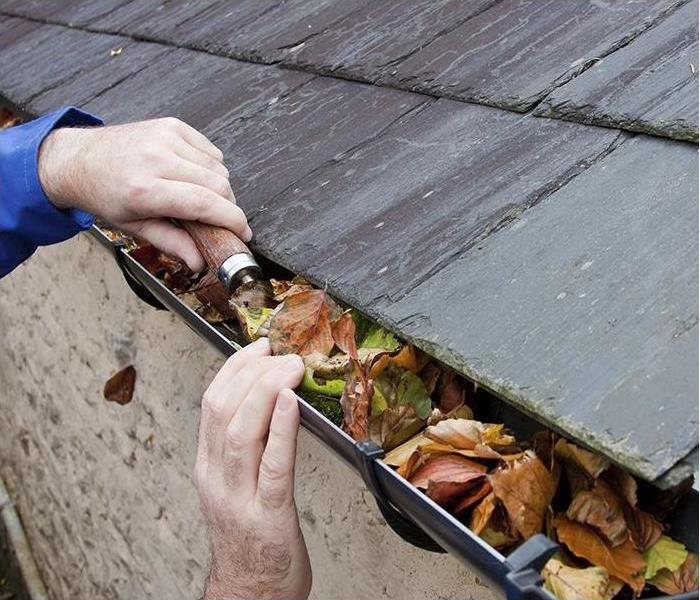 Cleaning your rain gutters regularly can help prevent leaks and water damage to the exterior an interior of your home.
Cleaning your rain gutters regularly can help prevent leaks and water damage to the exterior an interior of your home.
Spring has finally come. Floridians know that aside from a rise in temperature, lots of rain and thunderstorms are on the way. As an industry leader in storm damage, SERVPRO has extensive knowledge of what it takes to both prevent damage as much as possible and thoroughly assess a property for damage once a storm has passed. Here are some tips to help you adequately prepare for the storms to come.
Storm Preparation Tips
Preventing Water Damage
- Perform roof inspections regularly and search for shingles that are loose or curled. This applies to wind damage prevention also.
- Properly grading your lot will help to prevent water from seeping into your property.
- Proper drainage of your gutters is crucial for preventing leaks. Make sure to clear gutters and downspouts of any debris regularly.
- Weather Stripping can be applied around doors and windows for a reduction in air and water leaks.
- Search the property’s foundation walls and basement floor for any cracks and seal them completely.
Preventing Wind Damage
- Minimize potential damage by replacing rock and gravel landscaping materials with shredded mulch.
- Protect windows and glass doors by installing impact-resistant shutters or boarding up.
- Relocate your outdoor items indoors and secure the items that can not be moved.
- Make sure to trim down trees and shrubbery. Weak trees that may fall should be removed completely.
- Park any vehicles away from trees, lampposts, and power lines.
Preventing Hail Damage
- Make sure delicate outdoor items, furniture, and glass are covered and protected from potential hail impact.
- During a hailstorm, keep doors and windows completely closed for the duration of the storm.
- For added protection, install UL 2218 or FM 4473 as Class 3 or 4 roof shingles.
- If you have a garage, keep your vehicles parked inside with the garage door completely closed.
- If you do not have a garage or have more vehicles than your garage can fit, cover your vehicle(s) with a tarp to protect the paint. For added protection against dents and broken windows, try covering your vehicle with a thick blanket prior to tarping.
Local Storm Damage Help
If you follow the tips listed above, you have a higher chance of preventing serious damage to your home and property during a storm. However, disaster can strike at any time, so should you receive damage after a storm, SERVPRO of Winter Park is ready to assist you. Our phone lines are open 24/7 and our highly skilled technicians are available for services like water extraction and water damage restoration. For more details, give us a call at (407) 678-5391.
5 Steps Used for Mold Remediation
3/12/2018 (Permalink)
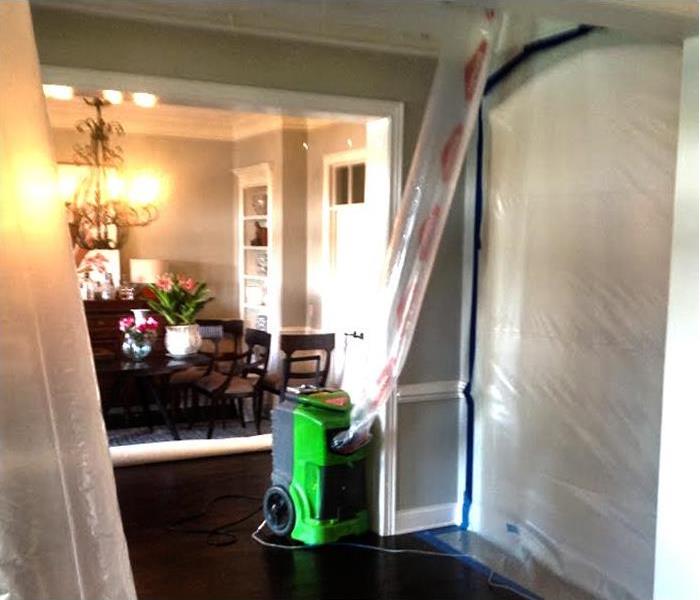 In this instance, water was still present in the affected area, so a dehumidifier forces hot air into the contained environment to continue drying.
In this instance, water was still present in the affected area, so a dehumidifier forces hot air into the contained environment to continue drying.
Mold in your Winter Park home or business can appear without warning and spread rapidly. While size and severity of a mold remediation job can vary, the 5 steps shared below are the foundation of the process we use every time.
Step 1: Mold Inspection
In Florida, the law states that the mold testing company cannot perform the actual remediation. We recommend having a mold assessment company take air quality samples in and outside of your property first. After receiving the test results from the samples and a protocol to perform an inspection, we then send a technician to thoroughly inspect and assess the damage to your property.
Our inspector checks for visible signs of the mold first and then proceeds to identify places where it may be hidden such as cabinets, baseboards, sheetrock, and under carpeting. Prior to remediation in areas over 10 square feet, it is important to have mold samples taken and tested.
Step 2: Mold Containment
The initial step is the most vital when beginning mold remediation. To ensure mold spores do not spread throughout your home, plastic barriers must be placed to separate affected and unaffected areas. We create a contained environment by systematically setting up a barrier and using negative air pressure. Negative air pressure creates a vacuum that forces the surrounding air that may contain mold spores into the contained environment. All entrances and exits of the area are completely sealed to prevent the spores from contaminating the rest of the property.
Step 3: Air Filtration
To achieve successful air filtration, we use powerful HEPA vacuums and air scrubbers. HEPA (High-Efficiency Particulate Air) vacuums work by forcing air through a fine mesh to trap harmful particles. Some of the particles captured by a HEPA filter include pollen, pet dander, dust mites, and tobacco smoke. Our technicians perform this step to capture mold spores that become airborne after removing drywall and similarly affected components of the property.
Step 4: Mold Removal
The mold removal step can vary in difficulty and length of time based on the extent of the damage and size of the affected area. Our technicians use antifungal and antimicrobial treatments such as Benefect, which is a plant-based and safe-to-use treatment. These treatments work to eliminate existing mold colonies and prevent new colonies from growing. In larger mold removal jobs, it is not uncommon for carpet and drywall to be removed as well, especially if they are infected with mold.
Step 5: Restoration
After removal, the next step is to clean and disinfect components of the property that have been affected by mold. Items such as curtains and furniture will be cleaned and deodorized. Repairs such as carpet replacement and painting are also made to restore the area. Because mold is a living organism that thrives inside of drywall, baseboards, cabinets, and clothing, it is necessary to remove them completely to eliminate the problem.
Your Local SERVPRO
SERVPRO of Winter Park is a family-owned business and knows what it takes to help you with your mold disaster. Give us a call to speak with a mold remediation expert and get the process started.
How to Remove a Minor Vomit Mess from Your Carpet
3/5/2018 (Permalink)
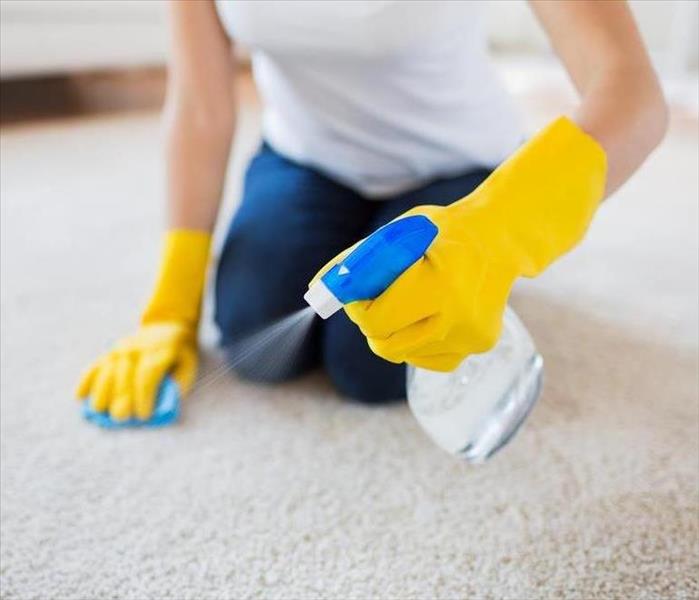 Wearing protective gear is the most important step on any biohazard cleanup.
Wearing protective gear is the most important step on any biohazard cleanup.
Many of us feel that we can handle a typical biohazard cleanup ourselves, such as vomit, in our homes. Perhaps your toddler could not make it to the restroom and vomited on your carpet. These things happen, and although they are not fun, most people assume cleaning vomit only requires some wipes and a disinfectant spray.
Unfortunately, the reality of the situation is that without removal of a porous surface, you can never truly disinfect it. This holds especially true when there are any infectious viruses and diseases present. In the case of biohazard cleanups that you feel are too large or difficult, you should always reach out and call a professional remediation company. If the mess appears to be manageable and you decide to handle it yourself, we have put together a few tips to aid you in properly addressing the situation.
Be Sure to Protect Yourself Before Cleaning
Safety should be your number one priority when attempting to handle a biohazard mess. This means using protective gear such as face masks and plastic gloves. It is important to avoid making any physical contact with the substance you are removing. Always be mindful of your hands and make sure you are not touching your face, eyes, and mouth. Once you have on protective gear, follow the steps below to remove small amounts of vomit.
1. Remove as Much Solid Waste as Possible
It is important that as much of the waste be removed as possible. Use household items such as an old towel or dustpan to remove all solid waste from the floor or carpet. Make sure to keep a trash bag close to dispose of all waste.
2. Use a Blotting Technique for Removing Liquid
Additional household items such as paper towels, rags, or even another old towel may be used for drawing liquid from the surface of the floor or carpet. Use the items to blot the area and go over the spot numerous times until as much liquid has been removed as possible.
3. Apply Baking Soda or Cornstarch
Blotting will remove most of the liquid in your carpet, but to remove more you can coat the area with baking soda or cornstarch. Leave a liberal amount to set for about 15 minutes and soak up the remaining liquid. Afterward, you may vacuum the powder to remove it.
4. Use Enzyme-Based Cleaner for Stains and Odor
As experts in biohazard remediation, we recommend using an enzyme-based cleaner when removing stains and odor. Most registered disinfectant products have a broad spectrum kill claim but enzymatic cleaners have fewer chemicals and can still break down stains and odors.
5. Dispose of all Hazardous Materials
Take care when disposing of the rags or towels you used to clean up the stain or launder them immediately. You do not want to spread the contamination.
When Should You Call a Professional?
The method provided above should only be taken assuming that the vomit is minor and manageable. It is important to remember that although the vomit is removed, there is no way to truly disinfect the area without removing it completely. If a sickness has spread throughout multiple inhabitants of your home, the amount of vomit and other bodily fluids may be too much to handle in your household alone. If you feel that the mess is too large or a serious virus could be the cause, you can call SERVPRO for assistance. We can remove and disinfect the entire affected area properly. We even run tests to ensure that no biological material is left behind.
5 Ways Commercial Restoration is Different from Residential
2/28/2018 (Permalink)
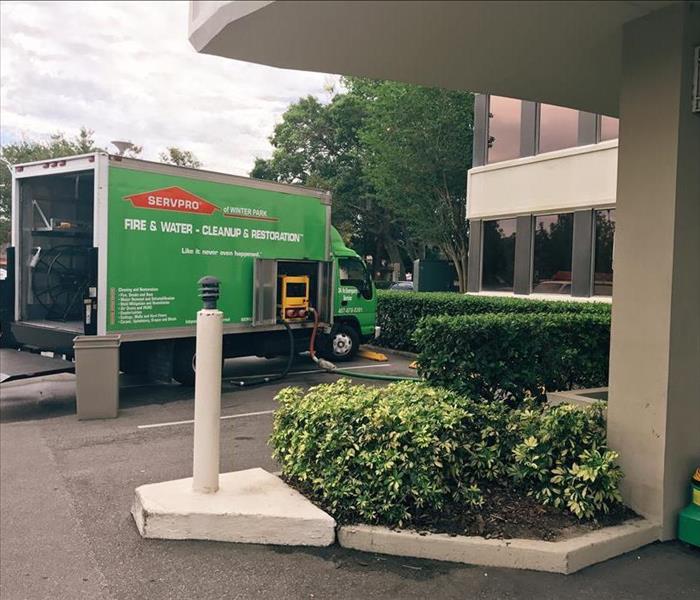 Commercial restoration jobs typically require more equipment on-site due to larger affected areas.
Commercial restoration jobs typically require more equipment on-site due to larger affected areas.
There are many ways that a commercial restoration job can be different from a residential job. Today, we share our five most important differences. Whether the job involves water, fire, or mold, knowing what to expect as a commercial client can go a long way for your restoration process and experience.
1. Size of the Area Requiring Services
The most common difference between a commercial job is the size of the area that requires services. The actual size varies from job-to-job based on several factors. For example, a pipe burst on an upper floor of a building can affect the lower floors and cause damage that may not even be visible. On the other hand, a mold removal job in the ballroom of a hotel would require the entire room being sealed and contained.
2. Additional Furniture and Objects
With larger affected areas, usually comes a higher amount of furniture and objects that must be removed. These objects can include filing cabinets, desks, various types of machinery and more. To properly dry carpets these items should be removed. In cases where objects cannot be moved, the restoration company must work around them, making the process trickier.
3. Different Specifications
Buildings are oftentimes built with different specifications and can cause delays or complications of the restoration process. During the process of cleaning water, additional challenges can include removing excess water and even testing for dryness levels. If a commercial unit has firewalls, drywall could be twice as thick making it more difficult to locate and extract wet insulation.
4. Multiple Insurance Claims
Another difference comes in the form of insurance claims. Aside from the claim itself being larger in most commercial cases, clients such as apartment property managers can have multiple residents and their belongings affected. This can lead to the need for multiple individual insurance claims being filed. More claims mean more claim handlers in need of continual job updates along with the tenants and property manager.
5. Open Business Hours
An important factor to consider in a commercial job is if the business will continue to operate on-site during the restoration process. Many businesses cannot afford to cease operations during this time. In these cases, the restoration company should be mindful of working employees by keeping noise to a minimum and even creating accessible walkways and work areas. For mold removal jobs, all parties must understand the importance of keeping contained areas sealed. Clear communication between the restoration professionals, clients, and their employees can make all the difference in these situations.
Best Commercial Restoration Company
The 5 differences between residential and commercial restoration listed above show just how important it is to choose a company that knows what they are doing and what to expect. SERVPRO of Winter Park is available 24/7 to respond to your emergency restoration call. Our highly trained professionals understand what it takes to get the job done right. We are Faster to Any Size Disaster and even have a warehouse that can store your business’s belongings. Give us a call at 407-678-5391 and get started today!
Water Damage Restoration Process
2/16/2018 (Permalink)
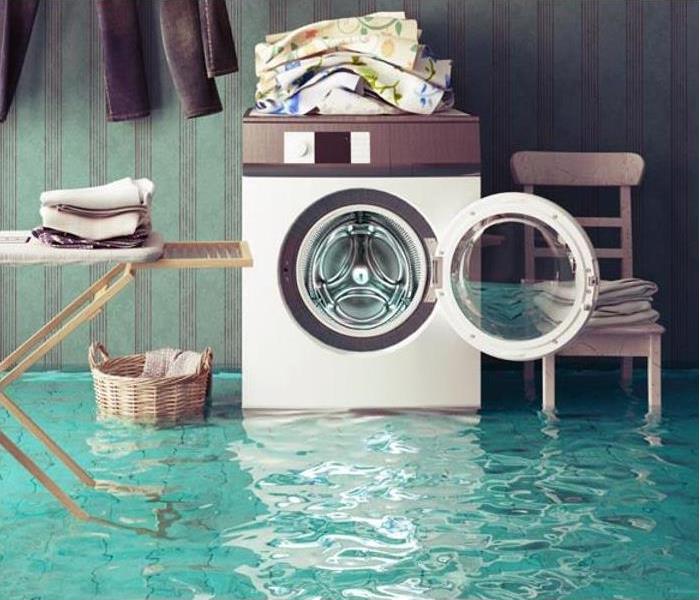 Washing machines are a common cause of water damage.
Washing machines are a common cause of water damage.
Some common causes of water damage in Florida are air conditioning units, excess humidity, and lots of heavy rain showers. AC units typically run on a daily basis for the duration of the year. Other causes include overflowing washing machine units, backed up sewers, hurricanes and storms, and lakes and rivers in close proximity. Quick action following any water damage is important because each of these issues can create the perfect environment for mold and mildew.
Trained Water Damage Specialists
Quick action is also the most important step in your water damage claim. By calling SERVPRO of Winter Park, we can have our water mitigation experts onsite within an hour. Our experts begin the dry-out and repair process to restore your residential or commercial property as fast and efficient as possible. All of our specialists are completely trained and use the most advanced equipment and techniques in the industry.
Our Restoration Process
No two water disasters are the same. Every factor can vary from the amount of water to level of contamination. The steps below show our process for the more common typed of water-related emergencies.
1: Emergency Contact
2: Inspection and Damage Assessment
3: Water Removal/Water Extraction
4: Drying and Dehumidification
5: Cleaning and Repair
6: Restoration
We Are Here to Help
SERVPRO of Winter Park is available 24/7 to respond to your water and mold emergencies. We are Faster to Any Size Disaster! Give us a call at 407-678-5391 to have one of our water mitigation experts assess the damage to your property.
Contained Mold Removal Companies
2/9/2018 (Permalink)
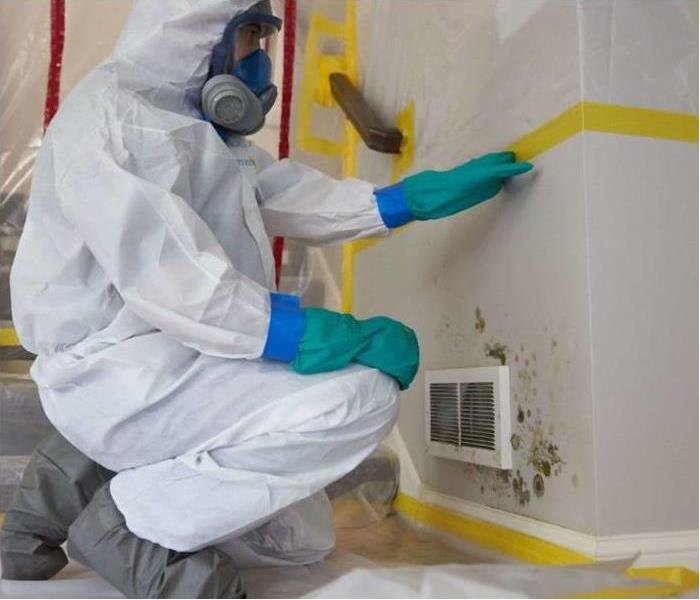 It is important to completely seal off the contaminated area.
It is important to completely seal off the contaminated area.
In a growing industry, options for mold removal companies are numerous. More options create the need for paying closer attention to quality. A major factor in your decision to hire a company should be whether or not the mold is removed in a contained environment. To better understand the importance of a contained environment, it helps to understand exactly how mold can spread.
How Mold Spreads
If left exposed, there are various ways for mold to spread throughout a home or building. Mold releases microscopic spores that can travel through vents, air currents, people or even pets. The spread of these spores is more likely to occur if the environment is not contained before removal.
Containing Mold
When creating a contained environment prior to mold removal, it is crucial to completely seal off the entire area that’s affected. The size of containment can vary based on the size of the contaminated area. Smaller mold issues typically require limited containment and can be sealed with a layer of polyethylene and duct tape. Larger issues require full containment. Full containment involves a sealing process using two layers of polyethylene, a barrier between the contaminated and non-contaminated areas, and an airlock chamber for the entry and exit.
Choosing the Right Professionals
Avoid any company that says containment of your mold issue is not a necessity. Mold can cause health effects so choosing a professional is in the best interest of all occupants of your home or commercial building. If you have a mold problem, you can contact a professional at SERVPRO of Winter Park for fast, reliable, and 24/7 service at (407) 678-5391.
The Aftermath Of A Fire
10/10/2016 (Permalink)
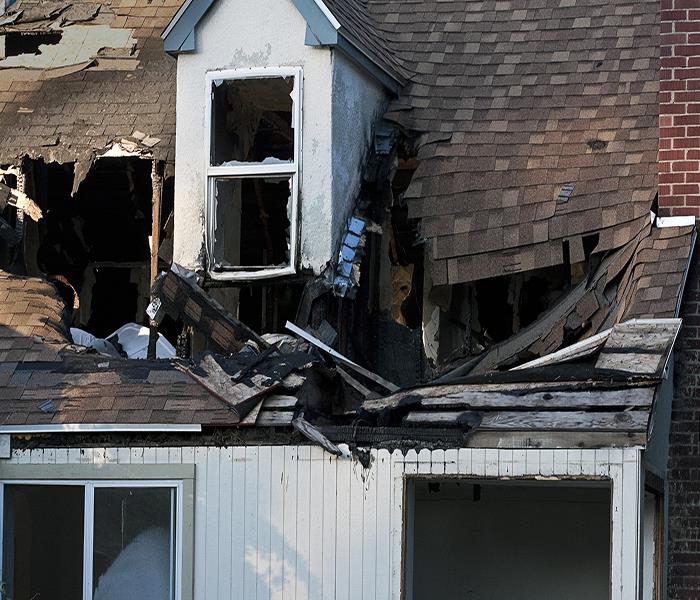 After a fire and after its flames are extinguished, there still exists some safety risks.
After a fire and after its flames are extinguished, there still exists some safety risks.
Fire Damage
After a devastating house fire, you are anxious to enter your home, but do not touch the carpets, draperies, upholstered furniture or clothing. They are likely covered with soot, which is oily, and it stains easily. Soot includes fine black particles, consisting mainly of carbon, as well as acids, chemicals, metals, soils and dust. Its removal should be handled by SERVPRO, professional fire remedial experts.
A common residential fire results in the burning of a variety of materials, from wood, paper, plastics, foams, fabrics, wool, wood products, synthetics and asbestos containing materials. Fire damage to Orlando residential and/or commercial buildings will result in soot contamination. Exposure to soot may occur via the eyes, skin, inhalation and ingestion.
Airborne soot particulates are invisible, thus after a fire you may unknowingly be affected. Soot particles can enter the bloodstream and cause a variety of health issues. Firefighters today are very well-trained in safety, plus they were protective gear, yet they experience a higher incidence of respiratory problems than the public.
After a fire and after its flames are extinguished, there still exists some safety risks. Soot is just one of the secondary fire residue risks, which cause damages. Not all soot residues are the same. There are different types of soot which are easier to clean than other types. SERVPRO professionals will clean any of four different types: dry smoke, wet smoke, protein smoke, and fuel oil smoke residues.
Industry issued safety equipment are essential in reducing possible exposure to dangerous soot conditions, including water related health problems from firefighting efforts. The fire restoration professionals at SERVPRO of Winter Park use IICRC professional tools and industry approved remediation methods. Our knowledge and expertise are at the heart of a thorough and safe fire restoration. Call us at (407) 678-5391 and let us help restore your property back to normal.
Florida State of Emergency: 5 Steps to Prepare Your Home for Hurricane Matthew
10/4/2016 (Permalink)
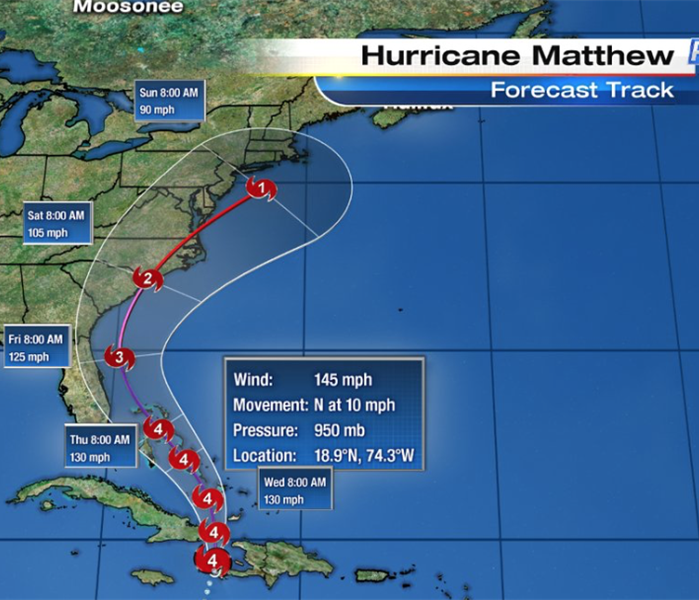 Path of the Hurricane
Path of the Hurricane
Its been 12 years since Central Floridians were socked with 4 devastating hurricanes: Charley, Frances, Ivan and Jeanne. Charley was the first of these storms to hit Orlando, and the worst to hit Florida since Andrew in 1992. When hurricane Charley made landfall as a category 4, winds got up to 150 mph causing $15 billion in damage. Driving wind and rain flooded homes across the state of Florida.
Once again, Florida is in a State of Emergency and SERVPRO of Winter Park is ready. When the storm rolls In, we roll out. Just as we have been getting ready for the tropical cyclone here in our office, its equally important for you to protect your home.
How to Prepare Your Home for Hurricane Matthew:
- Internet may be out. Searching for phone numbers online may not be an option. Before the storm strikes, make sure all of your emergency contact numbers are listed on paper and posted in a visible place where everyone can see. This includes your insurance agency’s phone number, your policy number and your emergency restoration service provider, SERVPRO of Winter Park: 407-678-5391.
- Put together a good first aid kit, including bandages, tape, scissors, antibiotic cream, aspirin and an antiseptic wash in the event that water supplies become tainted. In addition, have any and all prescriptions filled, in the case your pharmacy might be closed for days or weeks.
- Stockpile hurricane supplies such as canned and dried food, bottled water, batteries, flashlights, candles, matches, propane for gas grills and ice.
- Place sandbags around the perimeter of your home, especially if your house is in low lying or flood zone areas.
- Keep heavy duty plastic and tarps handy along with durable tape, nails and a hammer. If any side of your home is exposed to the elements, consider covering windows with plywood.
Once again its time to hunker down, stay inside and stay tuned to your local news station for updates on the hurricane. As always, you can depend on your neighborhood family restoration business, SERVPRO of Winter Park. We are here for you to help make it like it never even happened!
Commercial Water Damage Resolved By SERVPRO
9/29/2016 (Permalink)
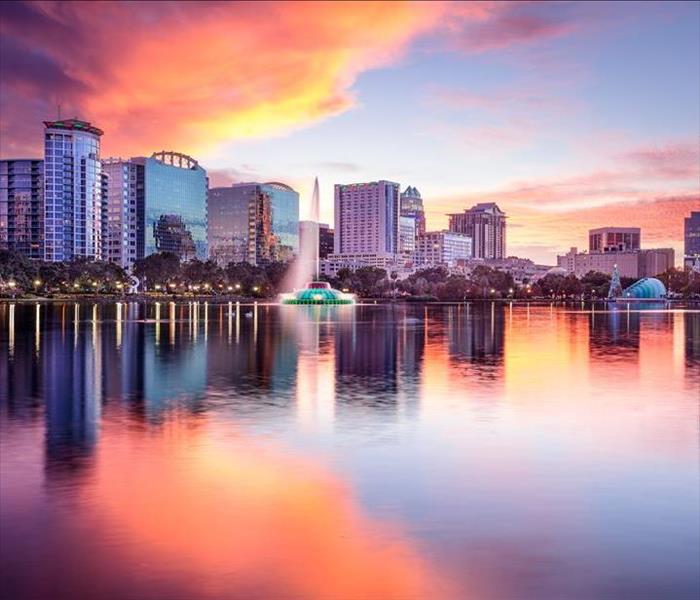 Orlando Water Damage Gets Help from SERVPRO
Orlando Water Damage Gets Help from SERVPRO
With the Help of SERVPRO, Businesses Reopen Faster After Water Damage
After a water emergency strikes in a commercial building, you own your immediate concerns involve both personal losses along with the added stress and responsibility to get all of your tenants back in business or living comfortably in your units again. SERVPRO offers the resources locally and on a national level to rehabilitate even a complex commercial water damage scenario. We exceed your needs both to repair your property and also to restore the trust the companies and individuals have invested in your professional commercial management.
Although burst pipes or a roof leak may start in a confined area of your office building, apartment complex or warehouse space, the resultant flood and seepage of water can spread far from the original breach. Many if not all of the businesses or residents renting from you are in peril of losing personal and professional property as well as their means to make a living if you do not take immediate steps to solve your Orlando commercial water damage. Even if the water overflow can be traced to the negligence of a tenant, you as the owner are charged with the task of protecting your building and fixtures and ensuring that all those who live in or operate a business within your commercial property have the use and quiet enjoyment of their leased premises quickly restored.
SERVPRO understands how important it is to limit the downtime of your and your tenants’ business operations. We make every effort to clean and dry the structure quickly, staging the restoration process with an eye to reestablishing business operations even before the entire remediation is accomplished if appropriate and safe. Preventing secondary damage from contaminated water is a major goal, made more attainable if we are involved as soon as possible in the process. Our services for you and your tenants can also include a pack out and detailed inventory of documents soaked by the water. We follow up with our state of the art procedures for saving and drying paperwork, books, pictures and other crucial work products you and your lessees may have feared would be lost due to the water infiltration.
If your commercial property has suffered water damage, call SERVPRO of Winter Park immediately. We can be reached at (407) 678-5391 24 hours a day every single day of the year, our technicians eager to return you and your renters to business as usual swiftly
Water Damage to Fabrics
9/6/2016 (Permalink)
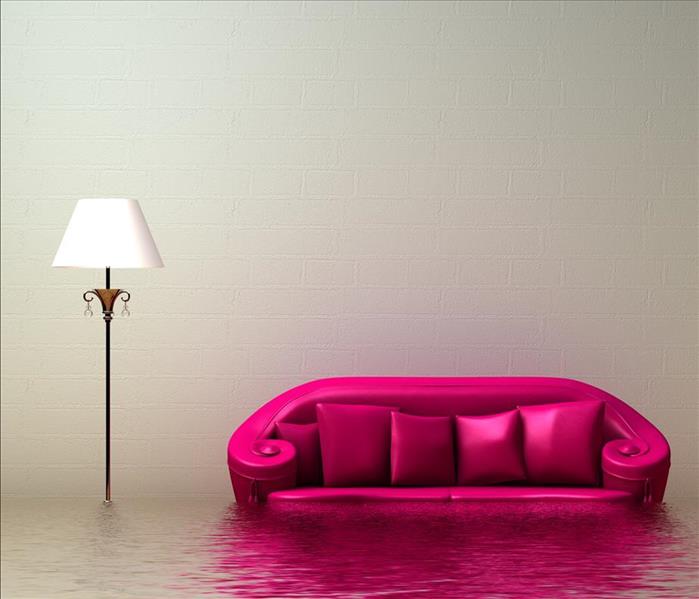 Water Damaged Sofa in Orlando? Let SERVPRO Help.
Water Damaged Sofa in Orlando? Let SERVPRO Help.
SERVPRO Can Salvage Fabrics from Water Damage
Some of the most at-risk objects and materials in a home come in the form of fabrics. Fabric and textiles make up our furniture, our flooring, drapes, our belongings, and sometimes even our walls and appliances, and all of these are highly susceptible to water damage. Thankfully, most types of water damage to fabrics are restorable and treatable in the hands of trained professionals. Depending on the type of fabric and its use, we vary our approach considerably when taking on a job for water damage restoration to fabrics.
Issues in General
Common throughout most types of fabric taking on water damage in Orlando are a few constant problems. For homeowners, the most troubling are often staining and discoloration, which can permanently ruin the appearance of some types of fabric if not treated correctly. Depending on the kind of water damage and fabric, our technicians may be able to remove this staining without replacing anything.
Carpeting
When it absorbs water, carpeting and padding can become heavily warped and misshapen. If not treated quickly, this may lead to a complete replacing of the material. Furthermore, carpeting is often harmed through flooding, which means that the general fabric damages are often most dangerous and prominent here. However, if only a portion of the carpet is too far gone, it can typically be removed and replaced if a successful drying out of the remaining carpet and pad has been accomplished.
Drapes and Window Coverings
Drapes and window treatments can also sustain water damage through flooding, but are also a common casualty after storm damage. If the damage is significant, it can be difficult to fully restore large and heavy drapes, although damage is often light enough to allow for full restoration.
Furniture
Fabric furniture pieces can sustain all of the usual problems, but are also highly susceptible to color bleed. Following a flood or significant water wicking into a piece of furniture, we recommend removing all pillows, sheets, and cushions from the furniture, if possible. This may help to mitigate damage to the non-fabric portions of the furniture.
Clothing
Most articles of clothing can survive light to moderate water damage with a thorough dry cleaning. For heavier damage or flooding, however, it is typically best to replace most items, as they may present a hazard or be too costly to restore.
SERVPRO of Winter Park is an experienced and well-staffed home restoration and cleanup service provider which has helped dozens of local home and business owners to get past even the worst catastrophes. For our services or a quote, call us 24/7 at (407) 678-5391.
What to Do After a Commercial Fire Damage Emergency
8/31/2016 (Permalink)
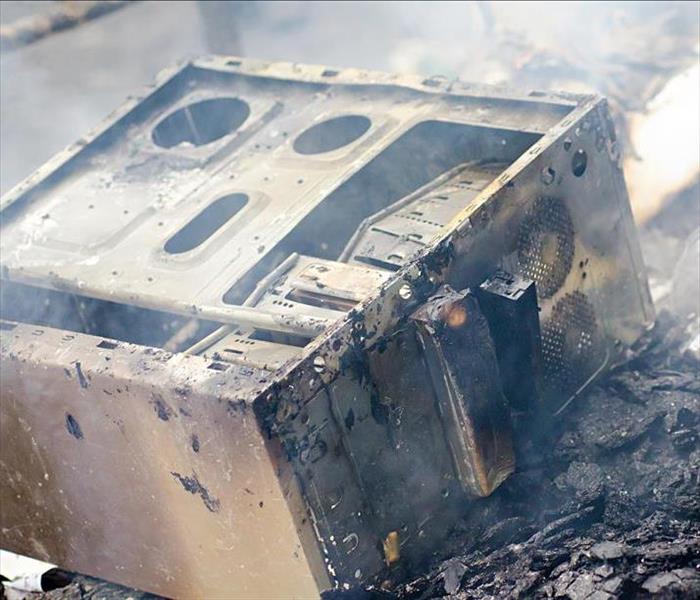 Fire Damage in an Orlando Office Gets Restored by SERVPRO
Fire Damage in an Orlando Office Gets Restored by SERVPRO
After Flames Close Your Business, Call SERVPRO for Fire Damage Restoration
Thousands of businesses are affected by commercial fire damage each year due to a wide range of causes. Whether it's a restaurant that encounters a fire, an office in a building that was affected by a nearby disaster, or a severe storm that sparks flames, such an event is never easy to deal with.
Few proprietors are prepared to grapple with the aftermath of a fire because it's not something that most business owners expect will happen to them. Entrepreneurs who suffer commercial fire damage in Orlando may feel at a loss when it comes to picking up the pieces and resuming business as usual. Here are three key steps you should consider taking after a fire has shut down your business.
1. Get in contact with your insurance company right away.
Not only will this be one of the most relevant steps to getting back open and serving your customers, but also your insurance company will provide the funds needed to make repairs to your business. We know how to navigate the commercial claims process, and any repairs that we complete will meet or exceed your insurance provider's requirements.We do emphasize that we are not an insurance company.
2. Secure the remaining equipment and property in your building.
Unfortunately, commercial fire damage increases the likelihood of vandalism and theft, as your building will be left vulnerable and less secure. Patching up walls, doors, and windows, even temporarily, can go a long way towards preventing further problems. The experts at SERVPRO have the experience and tools needed to secure your business's exterior and interior quickly. As a result, your property will be safeguarded, and any further damage to the building will be minimized.
3. Be mindful of smoke damage.
Even if it appears that your business was only minimally affected by commercial fire damage, the building likely has lingering smoke that will destroy your equipment, documents, and inventory over time. When you call SERVPRO, we'll thoroughly inspect your business for smoke damage and effectively clean it up, eliminate odors and restore satisfactory indoor air quality.
The team at SERVPRO of Winter Park knows how devastating commercial fire damage can be, and we're committed to helping you get your business back up and running. To obtain a quote or get more information about our fire repair and restoration services, call us 24/7 at (407) 678-5391.
Cleaning Up Fire and Soot Damage
8/17/2016 (Permalink)
 Smoke Damage Degrades IAQ in Your Aloma Home
Smoke Damage Degrades IAQ in Your Aloma Home
Fire & Smoke Damage Cleanup is SERVPRO's Cornerstone Expertise
The term fire damage is actually a little inaccurate. The source of most damage to someone's home doesn't come from the fire itself. Most damage and the resulting replacement and restoration costs would come from smoke and soot unless it were a major incendiary event. In areas with large amounts of surrounding vegetation, like ours, the smoke damage to a home can come from blocks away.
Regardless if it comes from the surrounding area or if your home itself is the source of fire damage, an Aloma home can suffer thousands of dollars in damage after just a few minutes. SERVPRO has the equipment and the expertise to put homeowners and renters back into their residence as swiftly as possible.
Once damage does happen, our technicians are fully trained and certified under the guidelines of The Institute of Inspection Cleaning and Restoration Certification (IICRC) to restore your home to its original state. Our technicians also receive corporate and franchise level training. Local teams learn the latest procedures to clean carpets, furniture and surfaces of soot and to remove the smoke odor that can linger for weeks in an untreated home.
Our franchise maintains its set of commercial grade vacuums to remove soot and other residue. Our blowers and exhaust fans can be adapted to work from a large family room to a small laundry closet. We also maintain a very deep shelf of cleaning products specialized for every surface in a home from marble countertop cleaners to soaps and dry sponges that gently remove soot and not the paint underneath. Please note that whatever else you may do before help arrives, there is one thing you must NOT do once damage has happened, especially if you can already see soot. Do not turn on your HVAC unit, even if there is sweltering heat; not even the fan by itself. It's almost overpowering to want to clear the air, but if you do, you will blow even more soot throughout your home, even into areas that might not already be fire and smoke damaged. All filters have to be replaced first, and the registers in each room must be covered to prevent further contamination. We can use HEPA grade filtration systems, air scrubbers, and ozone machines to help improve the IAQ, indoor air quality.
SERVPRO of Winter Park is a locally owned franchise. All of us here are part of the community and have a vested interest in helping our neighbors. You are not just a paycheck to us. If you have fire damage or would like to schedule a free inspection to help prevent future damage, call us today at (407) 678-5391.
Carpet Cleaning Professionals
8/2/2016 (Permalink)
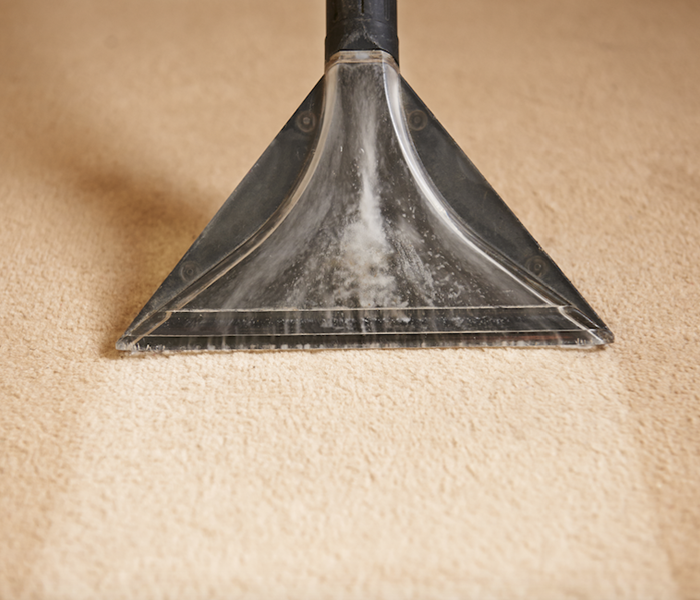 Regular Carpet Cleaning Can Extend the Life of Your Carpet
Regular Carpet Cleaning Can Extend the Life of Your Carpet
SERVPRO Can Get the Deep Dirt Out of Your Carpet
It is suggested by carpeting manufacturers that carpets should be professionally cleaned every 12 months. During the interim, carpets should be cared for with regular maintenance solutions. These steps involve using walk-off mats to lessen the amount of soil tracked onto the carpet; regular vacuuming; removing spots, pilating (or grooming) the carpet to prevent matting and moving furniture to change traffic patterns. As beautiful and aesthetic as carpeting is, it is a natural dirt and soil filter trap. It traps and holds dust, crumbs, dirt, gasses, pet hair, and other soil contaminants.
Our Winter Park carpet cleaning service is designed to keep your indoor air a healthy breathing environment. When you look at your carpeting, you may only see the dirt trapped on the top fibers. The truth is that more dirt, bacteria, and germs are hiding below the surface. The hidden contaminants are causing damage to the life of your carpeting. We offer specialized cleaning methods based on your carpeting material. We provide a premier cleaning system, which also involves bonnet cleaning, hot water extraction, deluxe preconditioning and rinse, as well as a quality dry cleaning.
Let us take the drudgery of carpet cleaning out of your hands. Place this necessary chore into the hands of your local professionals. We offer regular carpet cleaning services that will keep your carpet looking new. Protect your flooring investment by having SERVPRO clean and maintain your carpets. We use safe state-of-the-art equipment and solutions. Our certified and experienced technicians will get the job done right the first time and every time.
SERVPRO of Winter Park is your go-to carpet cleaning service. We are proud to be a part of the community with our locally owned and operated company. Our expert professionals are here to fulfill your office and/or home carpet cleaning needs. When you need your residential and commercial carpet cleaned, don't hesitate, contact us today at (407) 678-5391.
SERVPRO appears on News 6 Storm Prep 2016
6/8/2016 (Permalink)
 Victoria and Vern of SERVPRO of Winter Park participated in the News 6 'Call Our Experts' Storm Prep 2016 broadcast.
Victoria and Vern of SERVPRO of Winter Park participated in the News 6 'Call Our Experts' Storm Prep 2016 broadcast.
SERVPRO of Winter Park representatives Vern Boatman, Lynn Sadowski and Victoria Boatman participated in the News 6 Storm Prep 2016 broadcast. In addition to appearing on News 6 sharing helpful storm tips as Tropical Storm Colin crossed the state, they also manned the phone lines answering questions from Winter Park, Orlando and other local residents.
Helping home and business owners recover from storm- and flood-damaged properties is the cornerstone of our business. Our highly trained team of local professionals use advanced training and specialized equipment to quickly restore your property to pre-storm condition. We’re available 24/7 and dedicated to responding immediately, which helps to minimize secondary damage to your residential or commercial property.
Our team was at the WKMG News 6 Studios to help local residents prepare for the storm season. We shared helpful hints on air as well as through the ‘News 6 Call Our Expert’s’ phone bank. Emphasis was put on the ‘Three S’s’, 1 - Safety, 2 - Salvage and 3 - Service.
You can watch the two News 6 interviews by clicking here and here.
As the local leader in resolving water damage, we have a tremendous amount of hands-on experience. For information on how we can help you prepare for a storm, call us at (407) 678-5391.
What to Do if You Have Downtown Orlando Commercial Water Damage
5/31/2016 (Permalink)
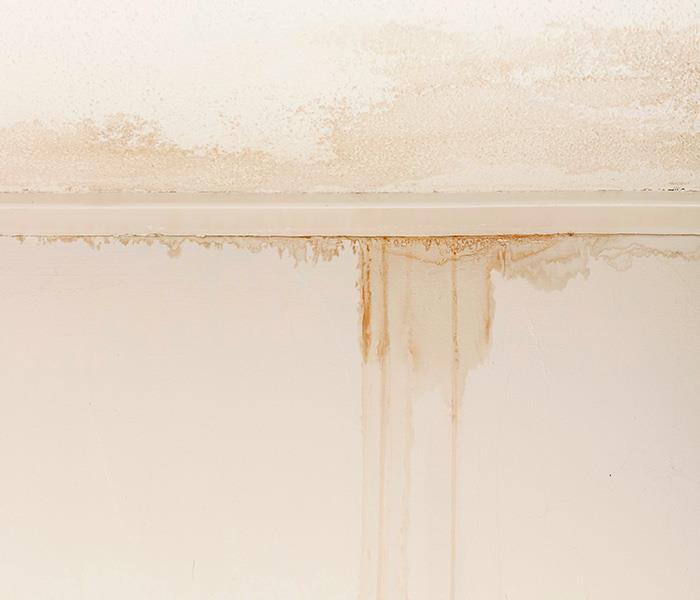 Commercial water damage in downtown Orlando can be devastating for any business owner.
Commercial water damage in downtown Orlando can be devastating for any business owner.
Getting Help With Water Remediation Service in Downtown Orlando
Floods can occur in downtown offices, retail and other commercial spaces for a number of reasons. For example, a flood may develop after a heavy rainstorm, a plumbing issue or for other reasons. If you are dealing with a flood on your property, you may want to restore the property as quickly as possible. Your urgency may be to continue business as usual. If you have downtown Orlando commercial water damage, you may be wondering how to respond to the situation that you are facing.
Turn off the Water Supply
If your downtown Orlando commercial water issue is the result of a plumbing problem, the first step that you should take is to stop the flow of water into the property. You can do this by turning off the main water valve that supplies the broken pipe with water. In some cases, this may be the main water supply to the entire building or a localized valve to a particular section of the plumbing. You can also call a plumber to repair the pipes for you as soon as possible so that you can once again turn the water valves back on.
Remove the Water
Immediately after you take these steps, you will need to begin working on removing the standing water from the property. You should not start the water extraction process yourself but contact a professional downtown Orlando commercial water remediation service. Professionals will use extraction equipment to remove the standing water quickly from the smallest spaces. Keep in mind that it is important to remove the water as soon as possible so that the potential for additional damage is kept to a minimum.
Dry out the Property
You may think that the property is dried out after the standing water has been removed, but this is not necessarily the case. The reality is that the air, drywall, and other surfaces may still be moist. Additional efforts must be taken to return humidity levels to normal and restore the condition of the home as much as possible. Professional remediation services use powerful fans to dry out the air and the surfaces in the home so that they are returned to normal. After this, the property can be restored through construction or other methods.
Call for Professional Assistance
Restoring a property after a flood is not a matter to take lightly, and you may understandably want to restore the property as quickly as possible. SERVPRO of Winter Park is the water extraction and remediation company to call for fast results. We are a local company that is ready to respond to requests for service without delay. You can reach us today for assistance with your property by calling (407) 678-5391.
SERVPRO For Reliable Restoration Services
4/28/2016 (Permalink)
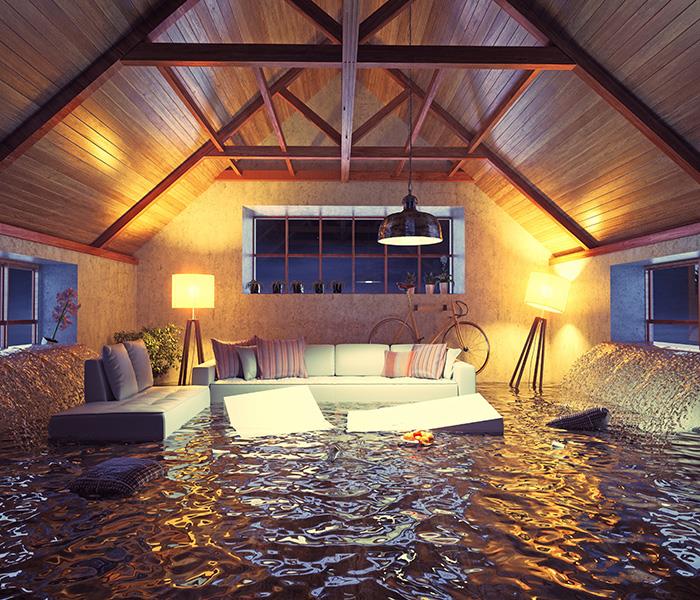 When you are dealing with the aftermath of College Park water damage to your property, you will need to call upon the assistance of professionals.
When you are dealing with the aftermath of College Park water damage to your property, you will need to call upon the assistance of professionals.
Call SERVPRO for Water Damage Cleanup In College Park
Water damage to your College Park property, you will need to call upon the assistance of a professional cleanup and restoration service. Whether the damage is due to a burst water main, sewer system malfunction, or flash flood, it is always best to address the damage and repair it as soon as possible.
A Fast Response to Your Emergency Situation Is Crucial
It is highly important that the professionals hired to take care of the job respond to your emergency in a prompt and professional manner. As soon as they arrive at your property, they will begin an immediate inspection of the damaged areas and then offer you a professional assessment of the work that needs to be performed.
Once the initial examination and evaluation are completed, the primary objective is to clear out all of the remaining water from your property. This process begins with the removal of all of the water that is standing in your house, collecting in pools and causing bacterial and other damage. The method also includes fully vacuuming your home and repairing any cracks and crevices where water can collect unseen and potentially cause further damage months or years down the road.
After all of the water has been removed from your property, they will then proceed to remove all of the debris and other foreign matter that may have collected on your property as a result of the emergency. Once the waste cleanup is complete, the professionals should be able to remove all remaining odors and other residual sources of trouble to make your property completely secure for you and your family to live in again.
SERVPRO of Winter Park Can Help You Deal With College Park Water Damage
When you need a prompt response to your emergency situation, it makes sense to call a local restoration service to get a timely and efficient response. Our team is available to residents in the entire metropolitan area, including College Park, Orlando, Maitland, Thorton Park, Baldwin Park, Oviedo, and Waterford Lakes. You can feel free to contact us at any time with any questions, comments, or concerns you may have regarding our property restoration services. When it comes to dealing with College Park water damage, it pays to call upon a professional provider of property restoration services. When you need a fast, cost effective solution to your water damage crisis, we have the knowledge, skills, and experience to be of service to you. Contact SERVPRO of Winter Park today at (407) 678-5391.
After A Devastating Fire Damage in Orlando - Steps to Take
3/18/2016 (Permalink)
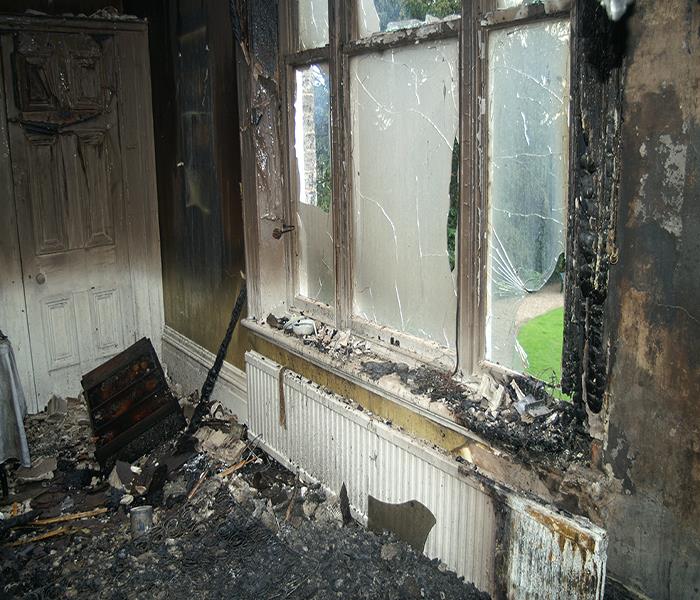 When a fire strikes, call a professional restoration company to help restore your home back to normal.
When a fire strikes, call a professional restoration company to help restore your home back to normal.
Fire Damage - Steps to Take After a Fire
When the devastating fire that ripped through your home is extinguished, and everyone is safe, you want to focus on measures you can take to minimize damage and reduce expenses for restoration. To do that follow these steps:
1. Clean all clothing to remove smoke or fire odors that could cause damage to the fabrics. Not to mention you can make them smell better. Clothes that are severely soiled from A damageing fire should be taken to a professional cleaner.
2. Thoroughly scrub all outside areas of your home with a strong disinfectant. These cleaners can help remove soot and harmful bacteria. Be sure to wear gloves and other safety equipment. Target all areas of your home such as floors, walkways, walls, glass, and screens.
3. Now you can move to the interior of your home. Cleaning inside includes scrubbing and disinfecting walls, cabinets, counters, tables, flooring, tables, chairs, and other areas. Remember to wear the same safety gear for interior projects.
4. Clean all of your fire damaged furniture in Orlando thoroughly. You do not want to damage sensitive material with harsh cleaners. Some furniture may need to be discarded if it is too badly damaged.
5. Next, restore fire damaged draperies and tapestries with an odor neutralizer spray. This spray helps combat the soot and fire damage that has penetrated deep into the fabrics. If your fire damage in Orlando is too much to handle on your own, consult a professional restoration expert.
6. Deodorize carpets and mattresses if possible. Steam cleaning could be considered as an option. Wash or dust all household items.
7. Finally, do not forget the importance of cleaning the ventilation systems in your home. The HVAC cleaning requires calling a fire damage restoration professional in Orlando. Heating/Cooling systems need all vents, ductwork, and filters thoroughly cleaned to ensure soot and smoke particles are not being cycled through the air in your home.
If you suffer fire damage , we respond to your needs day or night. We want to help and serve our community. For more information or an estimate call SERVPRO of Winter Park at (407) 678-5391.
Dont Wast Money Water Damage Requires Immediate Treatment
3/7/2016 (Permalink)
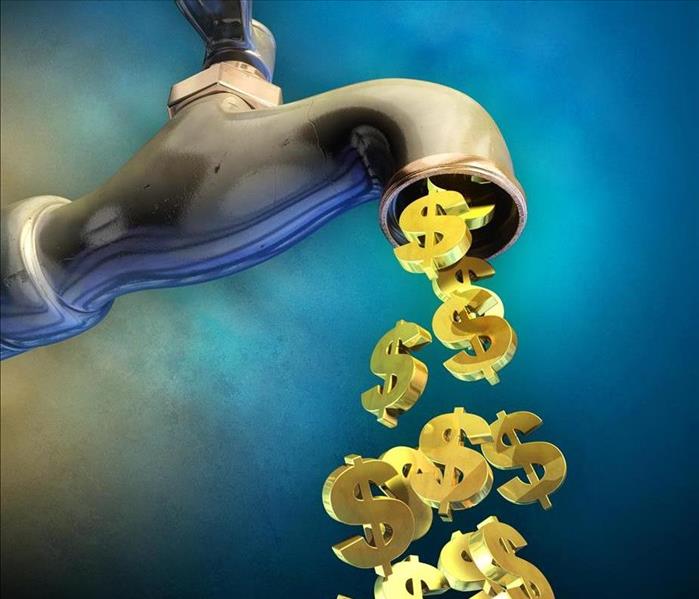 Don't Waste Your Water and Money on a Leak, Call SERVPRO
Don't Waste Your Water and Money on a Leak, Call SERVPRO
SERVPRO Can Restore Your Water Damaged College Park Home
Water damage in College Park results in a frequent service call to SERVPRO of Winter Park. As an area known for its older homes, water damage can be more intrusive to an older structure, making time the most important element of the cleanup process. We take great care in giving our customers the best possible outcome. To ensure this during a water leak, such as a pipe burst, we encourage our clients to contact us as soon as they become aware of the leak. But not all leaks are created equal, and some will come slower than others. If you notice a smell, soft drywall or growth in your home, these could be indicators of a small leak that has built up over time.
The Big Burst
When a pipe in your College Park home decides to break, it can be a very unexpected and shocking experience. To prepare yourself, make sure you know where the water shut-off is in the case of an emergency such as a pipe burst. The City of College Park should be able to assist you in locating your water shut off valve if you are unsure. Knowing how to turn your water off can be a vital element if you experience a pipe burst. It can keep water from affecting additional areas in your home and potentially save you time and money in repairs. If you still haven’t found the water shut off by the time SERVPRO of Winter Park comes to assist you in your emergency water damage, then our experienced technicians will help in any way they can. An essential element for restoring a water damaged home "Like it never even happened" is discovering and stopping the source of the water flow. Then SERVPRO of Winter Park will be able to start the process of removing the water in your College Park home. In these situations, it’s not only critical that we get all the water out but that we prevent additional damage.
Unseen Leaks
Leaks come in all shapes and sizes, but the smaller ones are usually harder to identify. Your College Park home could be experiencing soft drywall or small puddles that keep reappearing. Unlike pipe bursts, these pinhole leaks emit water over time and become more damaging the longer they’re left untreated. If you believe your College Park home has a leak, contact SERVPRO of Winter Park, and we will happily come out to assess the water damage repair. With our state-of-the-art equipment, such as the infrared camera, we can unobtrusively tell if there is moisture in a wall. Our trained professionals will then be able to walk you through the next step to remediate your water damage.
We Use Advanced Drying Equipment and Techniques
Using specialized equipment and products, SERVPRO of Winter Park technicians extract standing water and dry your property quickly and efficiently. We complete the job with professional-grade cleaning, sanitizing, and deodorizing products. Call us 24/7 for emergency fire and water damaging events in College Park, Orlando, and Oviedo. (407) 678-5391
Understanding Water public adjuster in Thorton Park
5/11/2015 (Permalink)
 It is important for property owners to be prepared for all types of potential property damage.
It is important for property owners to be prepared for all types of potential property damage.
Understanding water public adjuster
One of the most common types of damage to property is caused by flooding or other water problems. Homes and businesses can fall victim to such things as leaking pipes, natural disasters, sewage backups and other problems that in turn can leave significant water damage behind. As a result, many insurance companies try to mitigate the costs of such damage in a manner that is not always helpful to the property owner.
Normal insurance policies often provide different coverages for flood insurance and water damage insurance, treating the two differently. It is important for policy holders to understand the terminology contained in their policies and then use the correct terms when reporting a claim.
Many times, damage from water does not show up for several days until the property dries out. At that time, previously unnoticed damage may show through cracking walls. Although an insurance company will send out an adjuster, people often find that hiring an independent water public adjuster is in their best interests. An independent adjuster is more likely to do a thorough job of inspecting the property than is a preferred provider, as the insurance company's adjuster is most likely operating under instructions to minimize costs.
In the event of water damage, people should immediately file a claim with their water damage insurance company. Then, extracting as much water as possible is important, as is drying all salvageable items. Hiring professionals to conduct a careful and thorough inspection can reveal damage hidden by baseboards and trim.
It is important for property owners to be prepared for all types of potential property damage. Water can cause some of the most expensive types of damage. Scheduling an appointment with an insurance agent to go over the insurance policy is vital. Gaps in coverage can thus be discovered and any additional needed policy riders can be added. There may be nothing worse than learning only after an event has occurred that the insurance company will not cover the repairs. By planning ahead and making certain water damage insurance is included, people can protect themselves and their property more effectively.
Residential Services
Whether you home has suffered flood damage or you just want your upholstery cleaned, SERVPRO has 1,650 Franchises in the U.S. and Canada ready to help. SERVPRO of Winter Park technicians are highly trained to properly clean and restore your house so that it feels like home again. You can depend on SERVPRO of Winter Park for these residential services:
 Here you can see the destruction caused by a large commercial fire. With this extent of damage, it is extremely important you hire an expert company.
Here you can see the destruction caused by a large commercial fire. With this extent of damage, it is extremely important you hire an expert company.





 24/7 Emergency Service
24/7 Emergency Service










































































